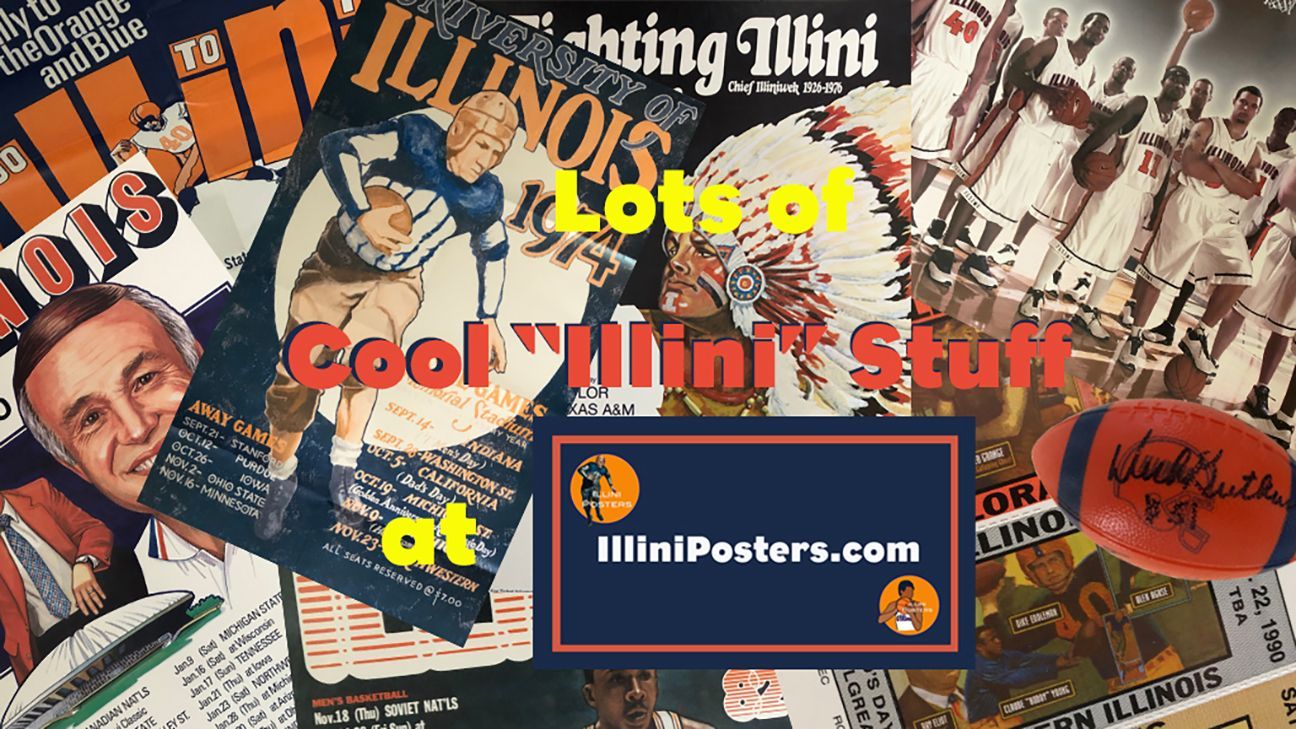Illini Legends, Lists & Lore
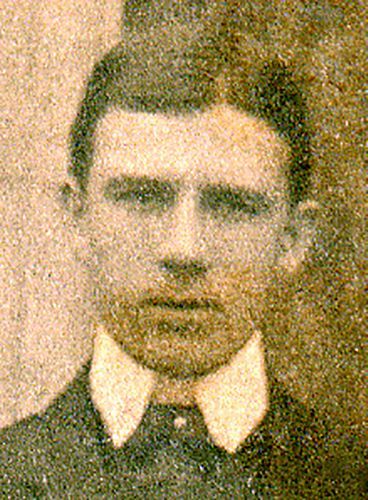
Fred Smith
Fred Smith
Dec. 26, 2025
Christened with one of the world’s most common names, today’s University of Illinois football fans are excused for not recognizing the name of Frederick Smith.
He was hand-picked by George Huff to become the Fighting Illini’s sixth head football coach, but only stayed in Champaign-Urbana for one season before becoming head football and baseball coach at Fordham.
Smith’s 1900 roster included several athletes who would become Illinois legends, including future Illini coach Arthur Hall, future UI Hall of Famers Jake Stahl and Carl Lundgren, and longtime assistant coach Justin Lindgren. Compiling a 7-3-2 overall record, Smith’s squad posted seven consecutive shutouts to begin the campaign. An eighth shutout followed a few weeks later when Illinois battled Indiana to a 0-0 tie in Indianapolis.
A native of New York City, Smith was an exceptional athlete at Princeton University. The 1897 Princeton graduate earned scattered All-America honors for his play as a quarterback for the football team and all-star accolades as a second baseman and catcher for the Tigers’ baseball squad. Major League Baseball’s Boston Red Caps (later known as the Braves) offered him a contract to play, but for unknown reasons he declined to sign.
Following his single year at Illinois, Smith was hired by Fordham University in his hometown to become the Rams head football and baseball coach. In his four seasons with the football team, Fordham had a cumulative record of 17-6-3, while in five seasons as the baseball coach the Rams had a mark of 213-66. One of his Fordham players, Ed Walsh, pitched for the Chicago White Sox for 15 seasons, twice leading the American League in strikeouts. Walsh was inducted into the Baseball Hall of Fame in 1946.
While he was coaching, Smith concurrently served as an engineer for New York City. He died in February of 1923, shortly after his 50th birthday, and is buried in Woodlawn Cemetery in the Bronx.

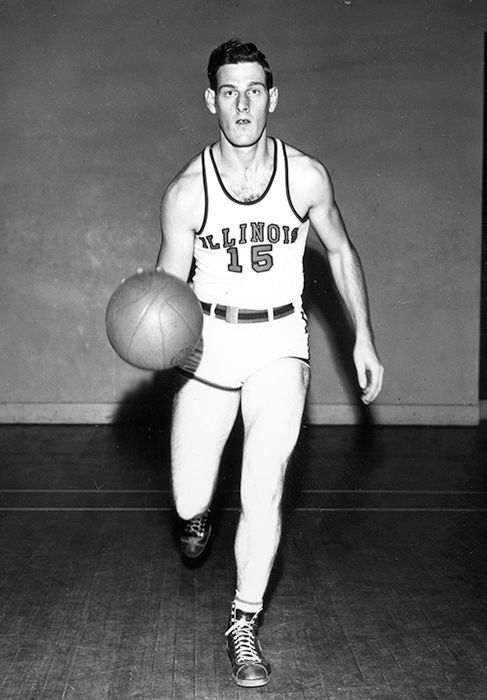
Jack Smiley
Jack Smiley
Dec. 22, 2025
Today marks the 103rd anniversary of the birth of Jack Smiley, a member of the University of Illinois’ iconic “Whiz Kids.”
Born in the tiny village of Waterman, Illinois—located in DeKalb County—Smiley was his town’s most famous resident, leading Waterman High School to two consecutive Little Ten Conference championships. From there, Coach Doug Mills recruited him to play for the Fighting Illini, where he joined forces with four other small-town stars: Gene Vance from Clinton, Ken Menke of Dundee, Andy Phillip from Granite City and Art Mathisen of Dwight.
As a sophomore in 1941-42, Smiley and his teammates won the Big Ten title with a 13-2 record and played two games in the NCAA Tournament. His junior season was even more impressive, winning the Big Ten again and posting an overall record of 17-1. Individually, he was named to the All-Big Ten squad, with his most impressive game being played on Feb. 20, 1943. College superstar John Kotz, averaging more than 20 points per game, brought his defending NCAA champion Wisconsin Badgers to Huff Gym. When the buzzer sounded, Smiley had held Kotz scoreless and limited him to just two shots all night. Just a week later, the Illini defeated Northwestern, 92-25, and were odds-on favorite to win the NCAA Tournament title.
However, following the game, Mathisen, Menke and Smiley were issued their military induction notices and, a month later, were shipped overseas for duty in World War II. Vance and Phillip answered their call to duty a month later. Smiley, an artillery corporal in the Army’s 106th Division, had the daunting mission of fighting in the infamous Battle of the Bulge, manning a Howitzer for infantry support. In an interview after the war, he said that at one point he fired his gun for 96 straight hours. Smiley was fortunate to have been among the 10 percent of his force that didn’t suffer casualties.
Almost miraculously, the war veterans all returned to campus in 1946. But, due to the tolls of wartime duty, they weren’t able to recapture that once magic chemistry. The Illini finished second in the Big Ten standings, with Smiley named Most Valuable Player.
He played professional basketball for two years, but the then meager salary wasn’t enough to support his wife and five children. Smiley came back to Waterman area in 1951, accepting a job as a truck driver for a seed company in DeKalb. He advanced in the seed business and, in 1973, started the X-L Seed Treatment Company in Granger, Iowa.
On July 30, 2000, he died at the age of 77.

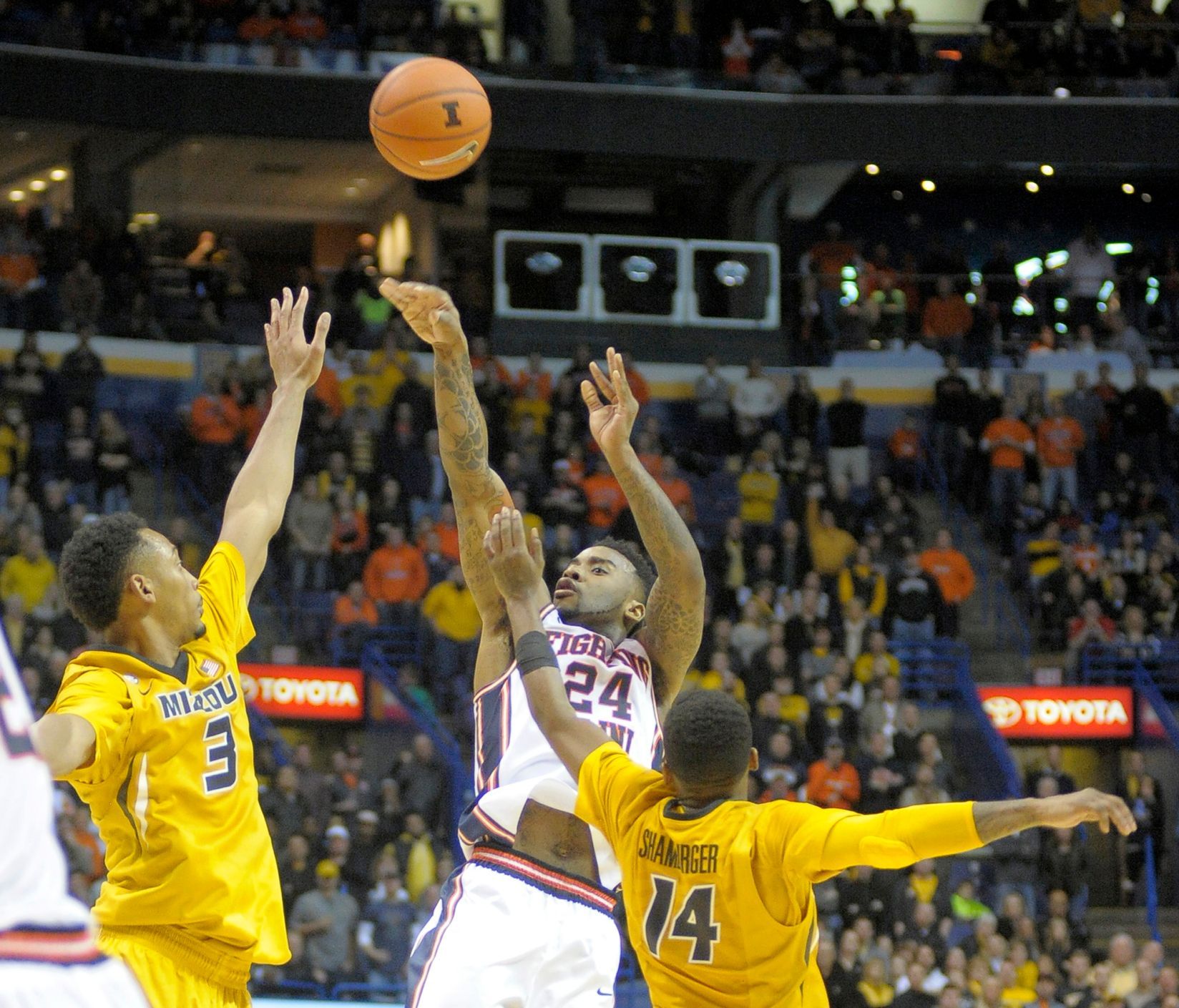
Rayvonte Rice's game-winning shot against Mizzou in 2014
Braggin' Rights Trivia
Dec. 19, 2025
Historically, 1920s and ‘30s Illini coach Craig Ruby is most likely the key individual figure who should be credited with the beginning of the Illinois-Missouri basketball series. Ruby, a 1920 Mizzou grad and a two-time Tiger All-American, coached his alma mater from 1920-22, then took over as Illini coach the following year and continued in that role through UI’s 1935-36 season.
Prior to the schools playing against each other for the very first time on Dec. 21, 1932 in Columbia—a 36-24 Illinois victory—Ruby was honored at a dinner by his former teammates.
Ruby resigned from Illinois after the 1936 season to become personnel manager for Hallmark Cards Inc., working at the Kansas City based company for 10 years, then operating gift shops in that area until his retirement. He died in September of 1980 at the age of 84.
Here are some other things you may have never know about the Illini-Mizzou series:
• In games played in the Gateway City against Missouri, Illinois has 28 and 15 losses. In the Illini’s victories, its average winning margin is 9.6 points. Missouri’s wins have been by an average margin of 8.9 points.
• The very first Illini-Tiger game played in St. Louis took place at the St. Arena, then known as the Checkerdome. New Illini athletic director Neale Stoner and his counterpart at Mizzou, Dave Hart, agreed to try a neutral site game on a trial basis for two years. Tickets sold for $8.50 apiece. The schools did not play in 1982, but renewed the series the following year.
• The only game that wasn’t played in St. Louis, Champaign or Columbia came in 1946 when the contest was competed in Kansas City. Mizzou surprised a highly regarded Illini “Whiz Kids” squad, 55-50, besting a lineup that included Andy Phillip, Ken Menke, Gene Vance and Dike Eddleman.
• Coaches Lou Henson and Norm Stewart agreed to renew a 21-year dormant series in 1976 when Illinois traveled to the Hearnes Center in Columbia for the four-team Show-Me Classic. Mizzou won the game, 76-75.
• The Dec. 19, 1988 game at The Arena is generally regarded to be the most compelling in the rivalry. In that one, fifth-ranked Illinois, battling back from an 18-point first-half deficit, rallied to edge 10th-ranked Missouri, 87-84. Kenny Battle’s 28 points, including what proved to a pair of game-winning free throw with 26 seconds left.
• Five of the 51 Illinois-Missouri games have gone to overtime. Mizzou won the first three extra-session contests, while the Illini have won each of the last two. In 1995, a Missouri state-record 21,901 fans saw Kiwane Garris atone for his most embarrassing game two years earlier (1993) when he missed two free throws at the end of the second of a three-time overtime game. In ‘95, Garris sank 15 of his 16 free throws to end with 23 points, eight rebounds and eight assists. The other Illini overtime victory against Missouri came in 2000, halting the Tigers’ three-game winning streak in the series. Including his jumper with 38 seconds left that sent the game to OT, sophomore Frank Williams fueled the Illini down the stretch, scoring 10 of his 18 points in the last 1:17 of regulation plus the extra five-minute period.
• In 2005, the 25th anniversary of the Braggin’ Rights battles, fans participated in a poll to choose the greatest performers in the series. Chosen No. 5 among Illinois’ best players in the series was Brian Cook, an individual who won three of the four games in which he participated. No. 4 was Kenny Battle who saw his team win both of his Braggin’ Rights games. Frank Williams was ranked No. 3 in the fans’ balloting. He scored 51 points in his three games against Missouri, including 22 in the 2001 contest. Kendall Gill was voted as Illinois’ second-best player in these magical December matchups, winning all four of his Braggin’ Rights games. The top vote getter among Illini players was Dee Brown. Like Gill, he never lost a game against Mizzou.
• While there have been eight games in the series that have been decided by a single point, one of the most memorable buzzer beaters came in 2014. After Mizzou tied the game with 17.8 seconds remaining, Illinois put the ball in the hands of Rayvonte Rice. The Champaign native dribbled for several seconds before stepping up at the key and drilling a fade-away shot over defenders at the horn. Rice watched the shot fall before getting mobbed by teammates.

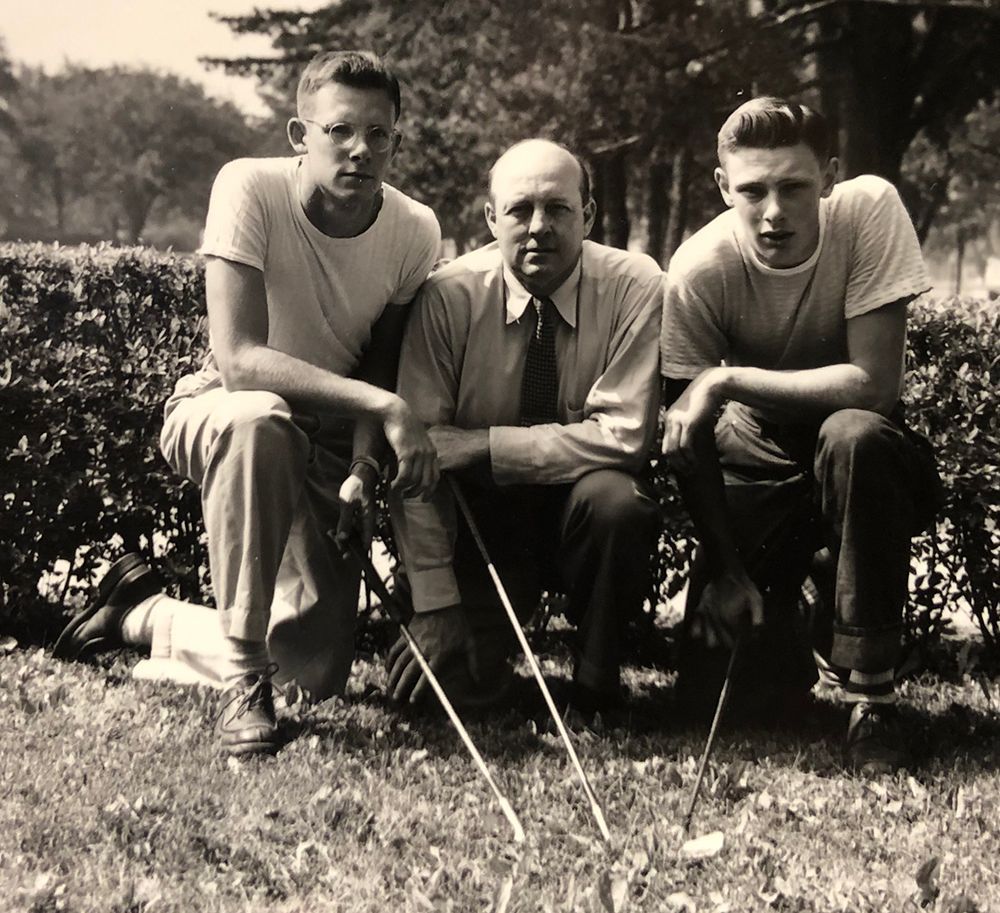
Ralph Fletcher (middle) and his sons Pete and Rod
Ralph Fletcher
Dec. 15, 2025
The University of Illinois’s Fletcher family is legendary in Fighting Illini history and the head of the clan, Ralph Fletcher, assumes as significant a position as anyone in his tribe.
Born 127 years ago today—December 15, 1898—in Morris, Illinois, Fletcher and his younger brother, Bob, played football together for Bob Zuppke from 1918 through 1920.
As a sophomore, the versatile halfback helped the Illini win the Big Ten title. A year later, Fletcher and his Illini teammates captured both the Big Ten and national championships.
One of his most famous games was played against Chicago in 1919 at Illinois Field when he scored a touchdown, converted the point after TD, and kicked a field goal, accounting for all ten points in an Illini shutout. Two games prior to that, Fletcher place-kicked the winning field goal against Iowa in a 9-7 victory. In 1920 as a senior, his kick against Chicago was the only score in a 3-0 win.
Fletcher also lettered as a starter for Coach Ralph Jones’s Illini basketball team in 1918-19, playing in a lineup that included Burt Ingwersen and Tug Wilson.
After graduating from Illinois in 1919, Fletcher served as head football and basketball coach at West Aurora High School from 1920-28, winning three conference championships and losing in the ‘28 basketball state finals to Canton. He then coached at Waukegan for the following two years, and returned to West Aurora in 1930. Fletcher assumed a similar position at Glenbard High School in 1936 before coming back to the U of I as head freshman football coach in 1939.
Fletcher was promoted to varsity backfield coach in 1942 and also served as Illinois’s head golf coach from 1944-66.
Two of Fletcher’s sons became Illini athletes. Rod was a consensus first-team All-American basketball player for Coach Harry Combes in 1952, while his oldest son, Pete, lettered in golf in 1950.
In 1989, Ralph Fletcher was inducted into West Aurora High School Sports Hall of Fame. He died in January of 1967 at the age of 68.


Don Freeman
Don Freeman
Dec. 11, 2025
Sixty years ago today - Dec. 11, 1965 - Illinois’ Don Freeman scored 35 points as the Fighting Illini topped previously undefeated West Virginia, 96-86. Among his points were 15 free throws in 16 attempts.
Freeman, a native of Madison, Ill., wound up his three-year Illini basketball career with a school record 1,449 points, including a single-season record 668 points his senior year (1965-66). That mark stood until Terrence Shannon Jr. broke it in 2023-24 (776 points).
In 72 collegiate games, Freeman averaged 20.1 points per game.
The 6-3 guard played pro ball for eight different teams from 1968-76 and scored more than 12,000 points.
Freeman was inducted into the Fighting Illini Athletics Hall of Fame in 2019.

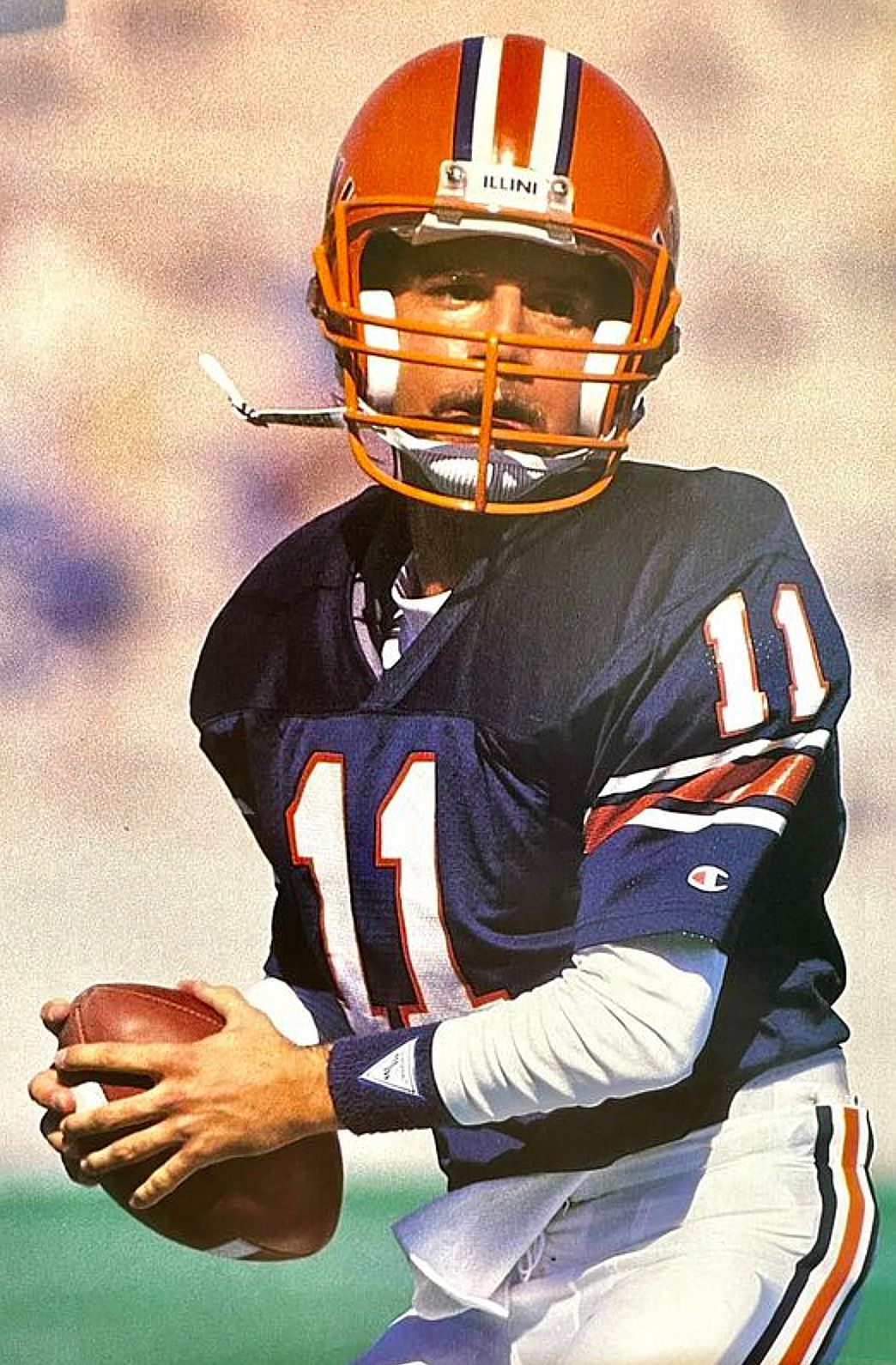
Jeff George
Jeff George: By the Numbers
Dec. 8, 2025
Today marks former Illini all-star quarterback Jeff George’s 58th birthday. He’ll be remembered for leading Illinois to the 1988 All-American Bowl and the 1990 Citrus Bowl, then surviving in the NFL for 15 seasons. George’s career story, by the numbers:
8: Number of NFL teams with which he played – Colts (1990-93), Falcons (1994-96), Raiders (1997-98), Vikings (1999), Redskins (2000-01), Seahawks (2002), Bears (2004) and Buccaneers (2005).
11: His jersey number at Illinois.
78: Total number of NFL No. 1 draft picks in history, of which he’s one.
154: Number of passing touchdowns he threw during his NFL career.
1985: Year he was presented the Dial Award as the national high-school scholar-athlete of the year at Indianapolis’s Warren Central High School.
1987: Year he transferred from Purdue to Illinois.
1990: Year he was the first draft pick of the Indianapolis Colts.
1997: Season he led the NFL in passing yards (3,917).
27,602: Passing yards he accumulated as an NFL quarterback.
50,000,000: Approximately, in dollars, his career salary as an NFL player. He signed the richest rookie contract (at the time) for $15 million with the Colts in 1990

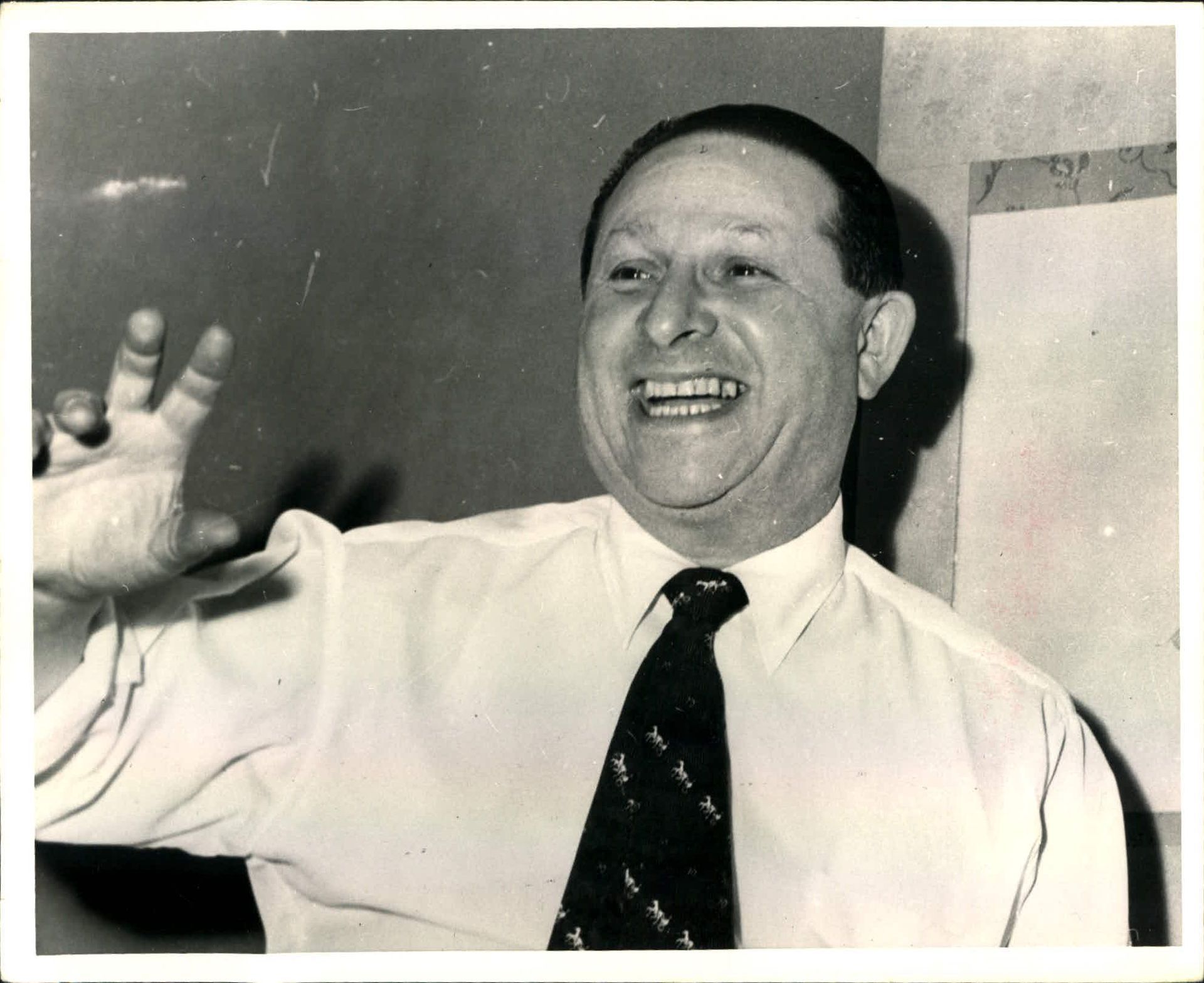
Abe Saperstein
Abe Saperstein & the 3-Pointer
Nov. 27, 2025
Did you know that a former University of Illinois student had a direct connection to instituting the three-point field goal into the game of basketball?
Abe Saperstein, born in England but a nearly lifelong resident of Chicago, was a nine-sport participant at Lake View High School. He originally attended the U of I, but dropped out of school in 1922 to help support his family.
Instead of following in his father’s footsteps of becoming a tailor, Saperstein pursued an administrative career in sports. In the late ‘20s, he formed his own team, the Harlem Globetrotters and his career is most closely associated with them.
Saperstein started the American Basketball League in 1961, but to differentiate his ABL from the more established NBA, he introduced the three-point shot. Though his league only survived for a year-and-a-half, the three-point field goal has endured for more than half a century.

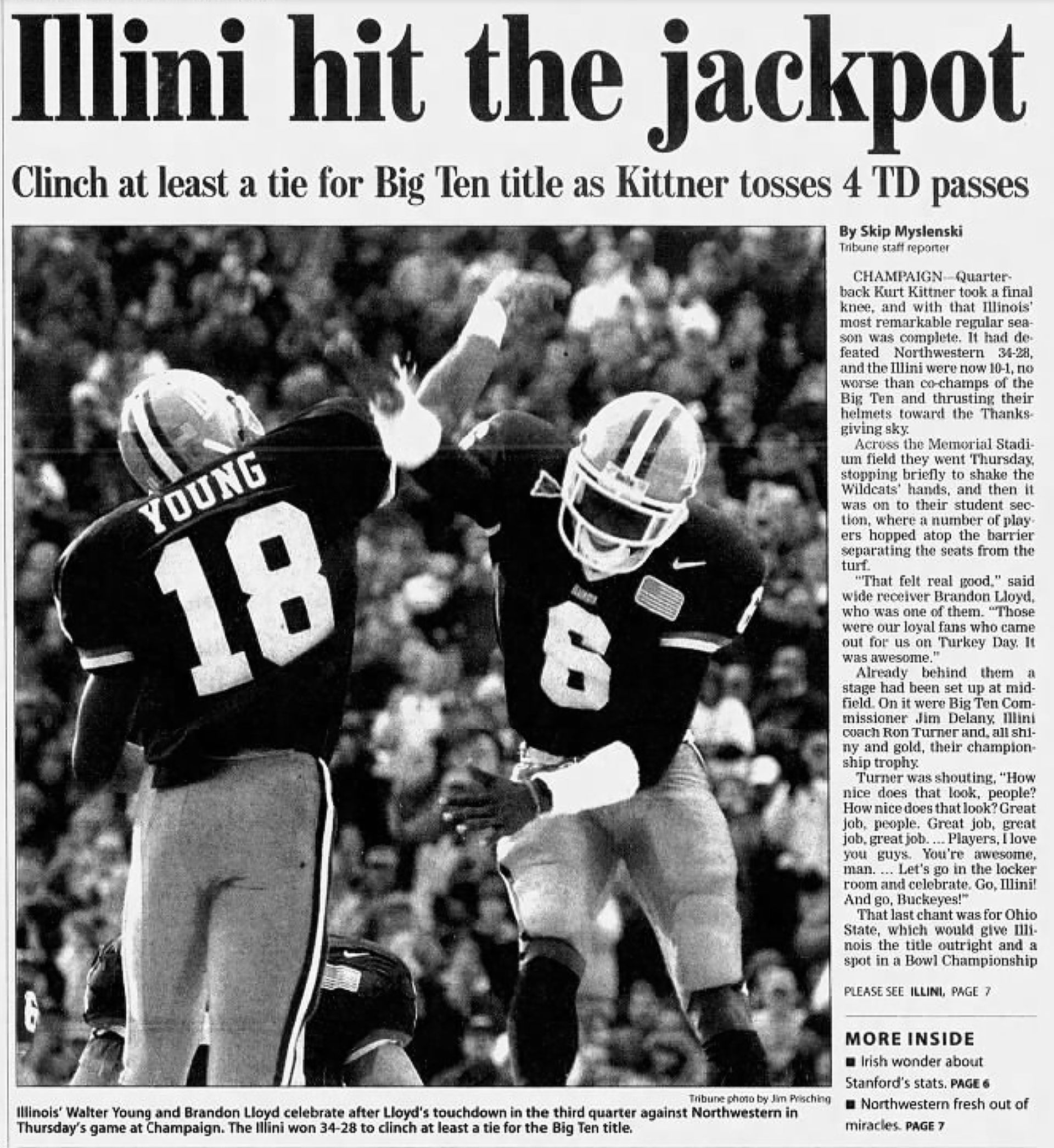
2001 Illini victory over Wildcats
Season Finales vs. Northwestern
Nov. 24, 2025
Thirty-five years ago today, Coach John Mackovic’s Fighting Illini football team beat Northwestern in the regular-season finale, 28-23, to win a share of the Big Ten title with Iowa, Michigan and Michigan State. Howard Griffith established a new Illinois single-game rushing record with 263 yards on 37 carries. After the game, Illinois accepted an invitation to the Hall of Fame Bowl to play Clemson. The Wildcats have been the Illini’s most common opponent in final games. This coming Saturday’s match-up against Northwestern will mark the 60th time the two schools have closed a campaign.
Here are some of the more memorable Illini-Wildcat battles:
Nov. 22, 1941: Bob Zuppke coached his final game at Illinois, losing 27-0 to Northwestern.
Nov. 23, 1946: Illinois’ 20-0 victory over NU clinched its first-ever Rose Bowl bid.
Nov. 25, 1950: Northwestern stopped Illinois at the seven-yard line as time ran out, denying the Illini a trip to the Rose Bowl.
Nov. 24, 1951: Illinois placekicker Sam Rebecca kicked a 16-yard field goal in the second quarter, providing the Illini with a 3-0 victory and a berth in the 1952 Rose Bowl.
Nov. 21, 1953: Illinois won at Evanston, 39-14, to clinching a share of the Big Ten championship with Michigan State. The Spartans, however, got the Rose Bowl bid.
Nov. 23, 1974: Illinois’ 28-14 win vs. Northwestern in the season finale gave UI its first winning season since 1965.
Nov. 25, 1989: Illini quarterback Jeff George led the Orange & Blue to a 63-14 rout over the Wildcats. It was UI’s most points in a Big Ten game since 1908.
Nov. 22, 2001: On Thanksgiving Day at Memorial Stadium, 10th-ranked Illinois defeated Northwestern, 34-28, to win at least a share of its first Big Ten crowd since 1990.

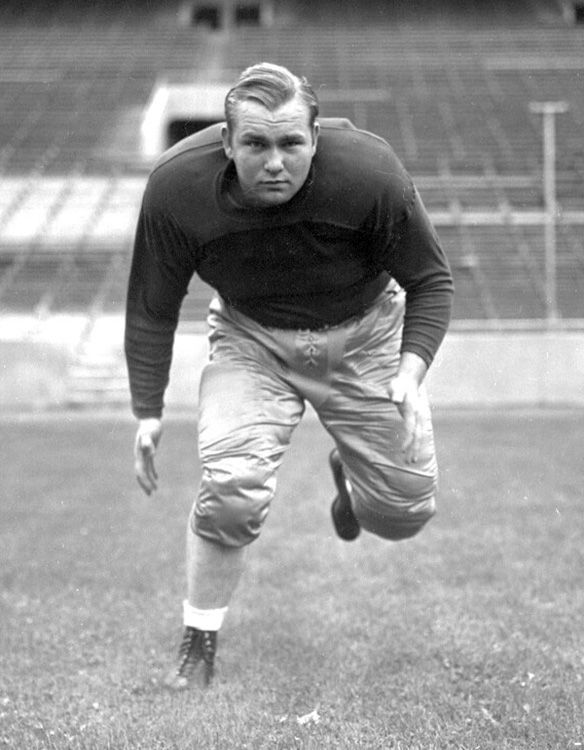
Les Bingaman
Les Bingaman
Nov. 20, 2025
Fifty-five years ago today - Nov. 20, 1970 - former Fighting Illini football star Les Bingaman died in his sleep at the age of 44 of an apparent heart attack.
A native of Tennessee, he was recruited by Coach Ray Eliot after playing prep ball at Gary, Indiana’s Wallace High School. Illinois’ football media guide of 1947 indicated that Bingaman was the team’s heaviest player, varying between 255 to 300 pounds. He and Illini teammates, including team MVPs Buddy Young, Max Wenskunas, Alex Agase and Ike Owens, compiled a cumulative record of 20-15-3 from 1944-47. In 1946, Eliot’s Illini finished fifth in the national rankings with an 8-2 record, including a Rose Bowl victory over UCLA.
The Detroit Lions chose Bingaman in the third round of the NFL Draft. Detroit struggled in 1948 and ’49 and played .500 football in 1950 and ’51. In 1952, Bingaman and the Lions won the NFL championship against Cleveland in 1952, repeated that achievement in ’53, then lost to the Browns in the 1954 title game. Bingaman was a team co-captain and a three-time all-pro with the Lions during his career.
From 1966-69, Bingaman served as defensive coordinator of the Miami Dolphins under Head Coach Bill Arnsparger and died almost a year after collapsing on the sidelines of the Orange Bowl in 1969.
Les Bingaman is rated by NFL historians as one of the premier middle guards of all-time.

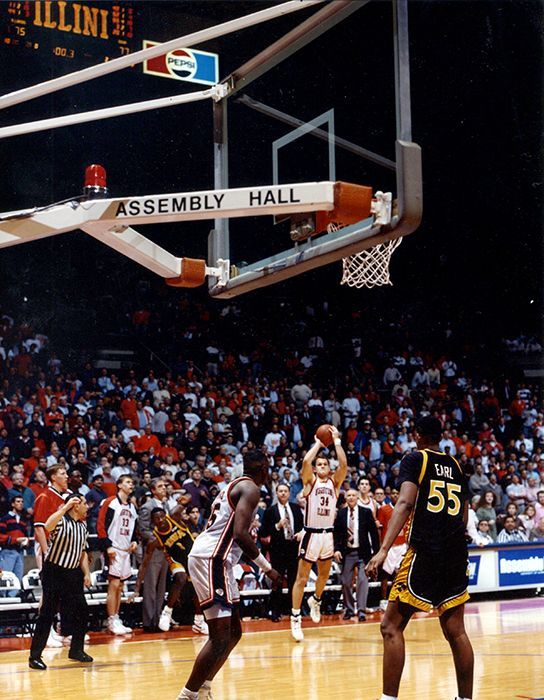
Andy Kaufmann
Andy Kaufmann: By the Numbers
Nov. 17, 2025
Today (Nov. 17) marks Andy Kaufmann’s 56th birthday. He’ll be remembered in Fighting Illini basketball lore for his dramatic, last-second three-pointer that beat Iowa in 1994. However, he initially became a legend in Illinois high school basketball at Jacksonville by leading the state in scoring in both his sophomore and junior seasons. His 3,160 points as a Crimson ranked second only to the 3,358 scored by Charlie Vaughn of Tamms High from 1954-58.
A look at Andy Kaufmann’s career, by the numbers:
1.5: Seconds remaining when he received a three-quarter-court pass from T.J. Wheeler, then hit a game-winning shot to beat No. 9 Iowa.
7: Three-pointers made vs. Missouri on Dec. 19, 1990 (14 attempts).
10: Where he ranks on Illinois’ all-time scoring list with 1,533 points.
14.9: Scoring average during his career at Illinois.
21.3: His team-leading scoring average during the 1990-91 season.
34: His jersey number at Illinois.
46: Points he scored vs. vs. Wisconsin-Milwaukee on Dec. 3, 1990, second-best single-game scoring mark in Illini men’s history.
660: Points he scored for the Illini during the 1990-91 season, just eight shy of Don Freeman’s Illini record in 1965-66.
918: Career number of free throws he attempted during his prep career at Jacksonville High School, a national record.

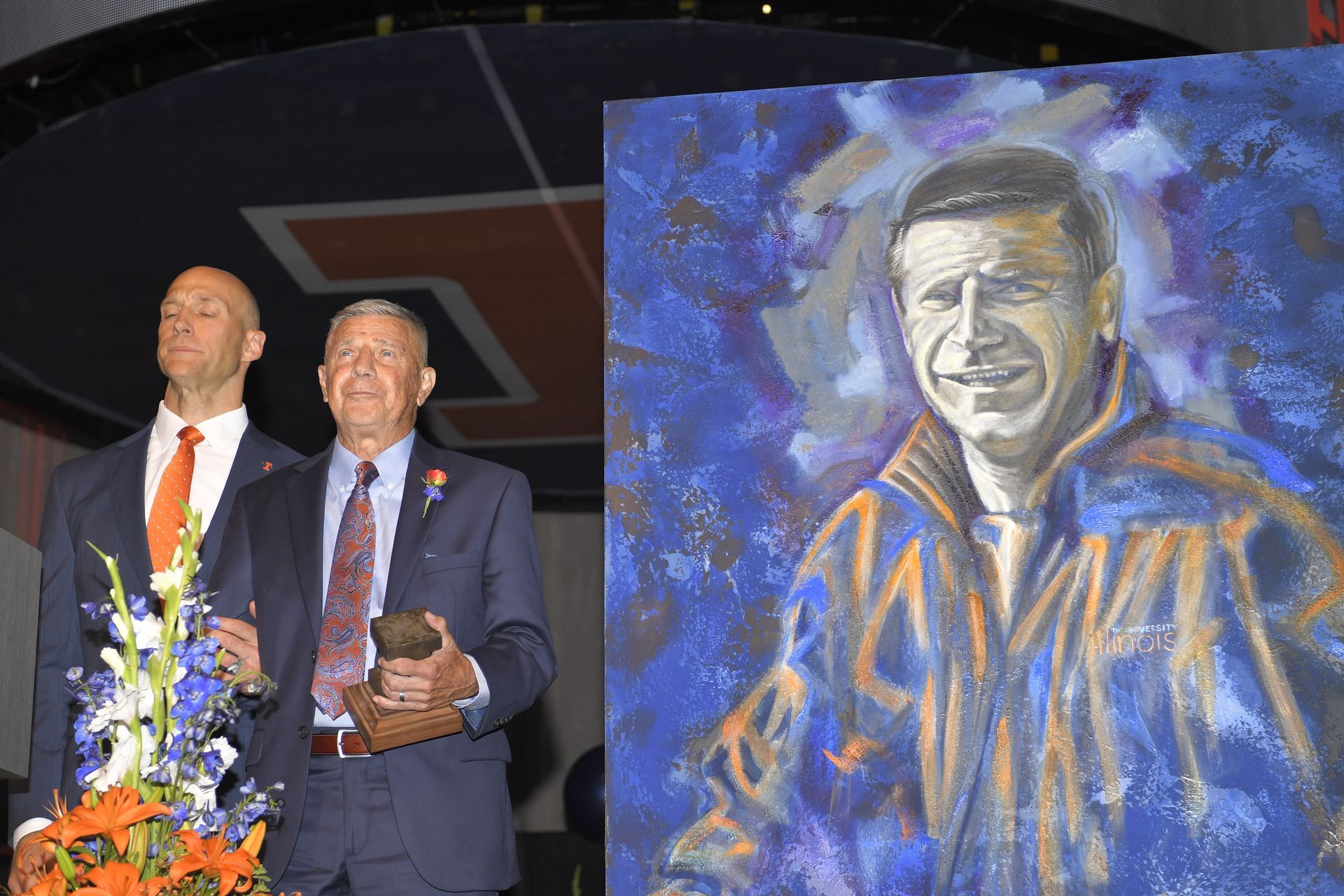
Gary Wieneke
Gary Wieneke
Nov. 13, 2025
Gary Wieneke, a man synonymous with Fighting Illini track and field and cross country, was born 88 years ago today (Nov. 13, 1937). He served as Illinois’ cross country mentor for 36 years and as director of the track and field squad for 29 years, retiring after the 2002-03 season. Wieneke’s 1984 harriers won the Big Ten title, UI’s first conference championship since 1947. Another highlight came in 1988 when Illinois finished as runner-up at the NCAA Indoor Track & Field meet. A four-year letter winner at Augustana College in both sports, Wieneke set the AC record in the 880-yard run and was part of two relay records. After his graduate assistantship at Bowling Green, he coached at three Illinois high schools before accepting Bob Wright’s invitation to become UI’s assistant coach. It was at the Champaign-Urbana campus where he enjoyed his greatest success, tutoring Olympians Craig Virgin, Mike Durkin and Marko Koers. Thirteen other individuals also earned All-America honors. Virgin became the first athlete in Big Ten history to win four consecutive individual titles. Nine times, Wieneke was NCAA District IV Coach of the Year, and three times he was the Big Ten Outdoor Track Coach of the Year. He also was named NCAA National Indoor Track & field Coach of the Year in 1987. Wieneke has also been involved in coaching the U.S. Junior National Team, the USOC National Sports Festival unit, and the World Cup Track and Field squad. He’s been inducted into the Halls of Fame of Illini Athletics, the U.S. Track and Field and Cross Country Coaches Association, the Illinois Track and Cross Country Coaches Association, the Drake Relays and at East Moline High School. He died in July of 2021.

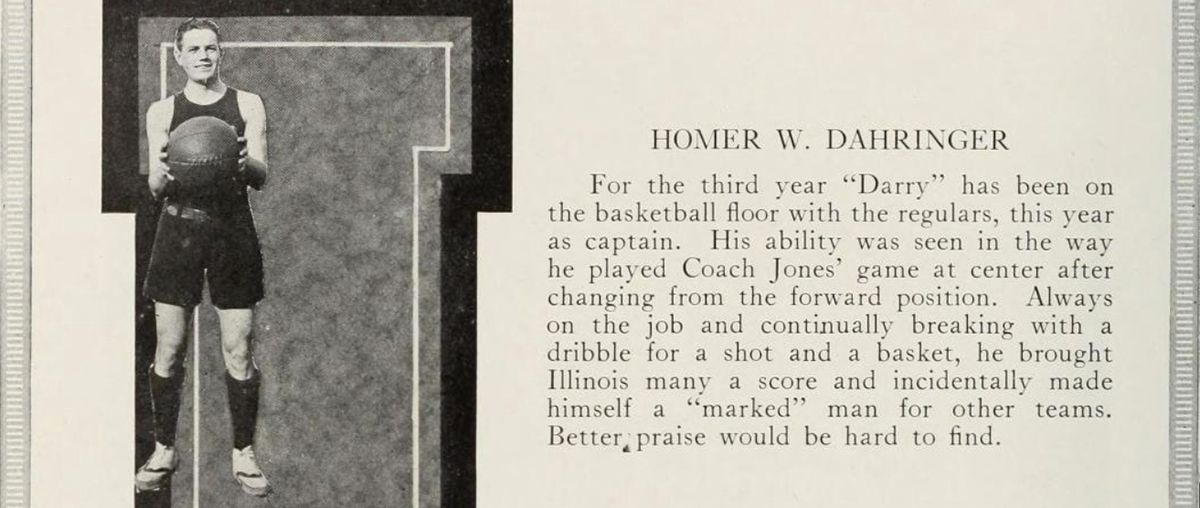
Homer Dahringer
Illini Veterans
Nov. 11, 2025
Observed annually on November 11, Veterans Day (known as Armistice Day until 1954) was initiated by President Woodrow Wilson in 1919, exactly one year after World War I ended at the 11th hour of the 11th day of the 11th month.
Military training has been part of the University of Illinois curriculum for its entire history. Prior to UI instituting its Reserve Officers Training Corps (ROTC) program in 1917, the 1862 Morrill Act obligated land-grant universities to instruct its male students in military tactics.
UI students have faithfully answered the call into the nation’s armed forces. More than 9,000 Illini served in World War I and more than 20,000 entered service in World War II.
Altogether, 1,121 UI students have died in service, including 184 during World War I, 844 during World War II, 22 during the Korean War, 64 during the war in Viet Nam, and seven in other world hostilities.
Hundreds of Illinois’ student-athletes have been in uniform and at least five letter winners have been killed. The list of honored Illini athletes includes:
EDWARD WALLACE: Wallace lettered in baseball in 1911 for Coach George Huff and graduated in 1913. He rose to the rank of First Lieutenant in the Army and served with the 146th Field Artillery Regiment, 41st Division. Wallace died on Sept. 13, 1918, at the age of 28, just two months before the end of World War I. He is buried at Suresnes American Cemetery in France, Plot B, Row 16, Grave 6. His name is on one of the columns at Memorial Stadium.
HOMER WAHLSTON DAHRINGER: A native of Waukegan, Dahringer lettered in basketball in 1912 and ’13, and served in World War I. After taking artillery instruction at Samur, France, Lt. Dahringer was assigned to the First Aero Squadron. While on an observation mission, he died at the age of 28 on Sept. 17, 1918, just four days after Wallace’s death. His name is etched on one of the columns at Memorial Stadium and he is buried at Pineview Memorial Park in Lake County, Illinois.
ROBERT FERN RICHMOND, JR.: A letter winner in 1939 and ’41 for Coach Doug Mills’ Illini basketball team, Richmond was an African invasion veteran for the U.S. Navy, rising to the rank of Lieutenant. On May 16, 1944, he died at the age of 24 in a Navy plane crash in Virginia. Richmond is buried at the Lakeview Cemetery in Johnston City, Ill.
ANTHONY JAMES BUTKOVICH: A star running back for Coach Ray Eliot in 1941 and ’42, he was transferred for military training to Purdue University. In 1943, he led the Boilermakers and the nation in rushing in with 833 yards, scoring a record 16 touchdowns. Butkovich was a first-round selection in the 1944 National Football League Draft, but instead enlisted in the U.S. Marines. As a Corporal with the 6th Marine Division, 29th Regiment, he was killed in action on Apr. 18, 1945 at Okinawa. He is buried at St. Mary’s Cemetery in Canton, Ill.
JOHN BRUCE CAPEL: A three-time letter winner in the 1960s, Capel played on Illinois’s 1963 Big Ten and 1964 Rose Bowl championship team. He enlisted with the Marine Corps at age 23 and was sent to Vietnam in 1966. That year, on May 12, Lt. Capel died in combat when he was leading a 14-man patrol which was ambushed southwest of Da Nang by a large force of Viet Cong. Each year since 1967, the Illini football team recognizes their most courageous player with the Bruce Capel Award. He’s honored on Panel 7E, Line 51, of the Vietnam Veterans Memorial in Washington, DC. The Glen Ellyn native is buried at his hometown’s Forest Hill Cemetery.


2000-01 Illini Basketball Team
25th Anniversary of 2000-01 Hoops
Nov. 7, 2025
It was a basketball season that won’t soon be forgotten by Fighting Illini fans. Twenty-five years ago, Coach Bill Self’s first Illinois hoops team won a Big Ten co-championship, earned No. 1 seeds in both the Big Ten and NCAA Tournaments, advanced to the Elite Eight, and captured the second-most wins in school history (27). Among the 35 games were three contests against Arizona, a victory over Final Four participant Maryland, a one-point loss to eventual national champion Duke in the Big Ten/ACC Challenge, a come-from-behind victory over seventh-ranked Seton Hall, a win in the Braggin’ Rights game over Missouri, and impressive triumphs over Michigan State at the Assembly Hall and against Kansas in the Midwest Regionals.
A look at the unforgettable case of characters from 2000-01:
Head Coach Bill Self: became just the sixth coach in Big Ten history to win a league title in his first season.
Frank Williams: the sophomore guard was the Big Ten Player of the Year, a third-team AP All-American and the team leader in scoring (14.9 ppg), assists (148) and steals (67).
Cory Bradford: junior guard set the NCAA record for consecutive games with a three-point field goal (88 games).
Marcus Griffin: the senior averaged 11.3 points and 6.0 rebounds per game en route to a third-team All-Big Ten selection.
Brian Cook: sophomore forward won second-team All-Big Ten honors and had 25 points in the win over Missouri.
Robert Archibald: the Ballwin, Missouri junior was Illinois’ top bench player, averaging 7.2 points and 4.5 rebounds. Tallied 25 points in the Illini’s NCAA regional final loss to Arizona.
Sergio McClain: the Peoria senior averaged 7.5 points per game and had 102 assists, second only to Williams.
Sean Harrington: the junior guard was the Big Ten’s top three-point field goal shooter (.459), including an Illini record nine in a row during one stretch.
Lucas Johnson: the junior forward led the nation in floor burns and came off the bench to score 15 points in the Sweet Sixteen game against Kansas.
Damir Krupalija: played well off the bench in the NCAA Tournament wins over Northwestern State (12 pts/8 rebounds) and Kansas (7/7).
Brett Melton: the freshman from Mahomet played in 28 games, scoring a season-high eight points against Kansas State.
Joe Cross: played in 17 games for the Illini. Scored a three-pointer in the NCAA Tournament opener vs. Northwestern State.
Nate Mast: the senior from Champaign Central High School appeared in 20 games and made four-of-seven three-point field goals.
Jerrance Howard: the freshman guard appeared in 25 games, highlighted by a two point/three rebound effort in Illinois home-court win over Penn State.

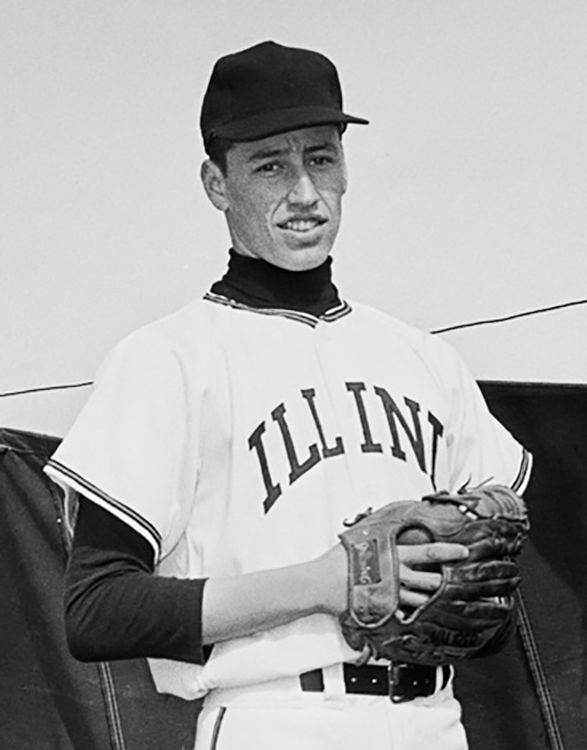
Ken Holtzman
Ken Holtzman: By the Numbers
Nov. 3, 2025
Ken Holtzman, Fighting Illini baseball’s most successful Major League pitcher, was born 80 years ago today - Nov. 3, 1945. During his 15-year career as a professional, he compiled a record of 174-150, including 127 complete games. This is Holtzman’s career story, by the numbers:
1 … Lettered one season (1965) for Coach Lee Eilbract’s Illini.
2 … Number of no-hitters he threw for the Chicago Cubs, vs. Atlanta in 1969 and vs. Cincinnati in 1971.
3 … Number of World Series championship rings he won (1972, ’73 and ’74).
4 … Played for four Major League teams, including the Cubs (1965-71 & 1978-79), Athletics (1972-75), Orioles (1976) and Yankees (1976-78).
6 … Number of post-season pitching victories, including a 4-1 record in World Series play.
21 … Career-high single-season pitching victories in 1973, fourth-best in the American League.
83 … Number of Major League hits, including 15 doubles, 1 triple and 2 home runs.
1,601 … Number of strikeouts he posted in 2,867 1/3 innings.
1963 … Year he graduated from University City High School in St. Louis.
1976 … Year he was traded with Reggie Jackson from the A’s to the Orioles.
2024 ... Holtzman died on Apr. 14, 2024.


Chief Illiniwek's first performance
Chief Illiniwek's First Performance
Oct. 30, 2025
Ninety-nine years ago today—Oct. 30, 1926—Chief Illiniwek made his first appearance at a Fighting Illini athletic event.
Lester Leutwiler, son of University of Illinois professor O.A. Leutwiler, was the individual who performed the role. UI assistant marching band director Ray Dvorak is credited with starting the tradition.
In his recollection of that first performances, Leutwiler wrote, “As the band marched into the formation (spelling out the word “Penn”), the Chief ran from a hiding place north of the Illinois stands and led the band with his frenzied dance. The band stopped in the center of the field and played ‘Hail Pennsylvania’ while the Chief saluted the Penn rooters. William Penn, impersonated by George Adams (the Illinois drum major), came forward and accepted the gesture of friendship. Together, we smoked the peace pipe and walked arm in arm across the field to the Illinois side, amidst a deafening ovation.”
Leutwiler’s performance was so well received that he was asked to continue his performances at Fighting Illini football games, and he did so through the 1928 season.

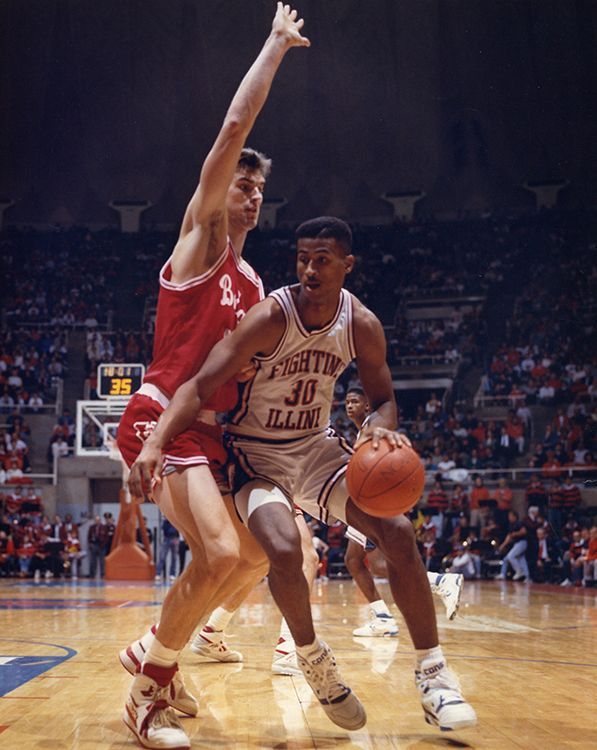
Marcus Liberty
Marcus Liberty: By the Numbers
Oct. 27, 2025
Marcus Liberty, a two-time Fighting Illini letter winner, celebrates his 57th birthday today.
During the two seasons in which he played—1988-89 and 1989-90--Illinois compiled a cumulative overall win-loss record of 52-13, including a 25-11 mark in Big Ten play. Marcus Liberty’s career, by the numbers:
4 Number of foreign countries in which he played (Greece, Turkey, Sweden, Japan)
7.3 His career NBA points per game average (1,942 total points)
30 His jersey number at Illinois
33 Liberty’s career-high scoring game as an Illini (vs. Minnesota, 2/8/90)
267 Number of NBA games in which he appeared (from 1990-91 through 1993-94)
820 Total number of points he scored at Illinois (65 games, 12.6 ppg average)
1987 Year he was named Illinois high school’s “Mr. Basketball”

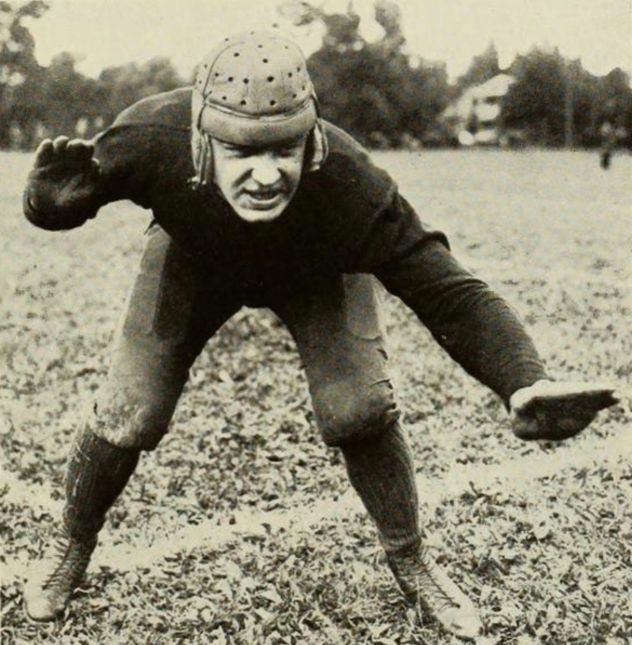
Jim McMillen
Jim McMillen
Oct. 23, 2025
One-hundred-twenty-three years ago today, former University of Illinois football star Jim McMillen was born.
Before Red Grange joined the Illini varsity squad in 1923, McMillen was the team’s star, earning All-America honors the season before. The burly all-star guard from Grayslake attended Libertyville High School before enrolling at the Champaign-Urbana campus.
During his senior season at Illinois in ’23, McMillen created the holes through which Grange ran to fame. Both of the Illini standouts earned consensus All-America honors for Coach Bob Zuppke’s 8-0 national champions.
McMillen also earned two letters in wrestling, graduating from Illinois with a degree in engineering.
He played pro football from 1924 through 1928 with George Halas and the Chicago Bears, who were world champions in McMillen’s rookie season. In 1931, Halas named his standout lineman vice president of the Bears organization.
McMillen was a famous professional wrestler from 1924 through 1950 and could have continued with football, but found that wrestling was more lucrative. One of his most famous matches occurred in 1936 when he defeated wrestling legend “Strangler” Lewis.
McMillen served for the U.S. Navy in World War II as a lieutenant commander. He was an active citizen in Antioch, Illinois, serving as chief engineer for the Lake County Forest Preserve and holding posts at the high school, on the city’s Fire Department, and later as mayor for six years.
McMillen died in January of 1984 at the age of 81.

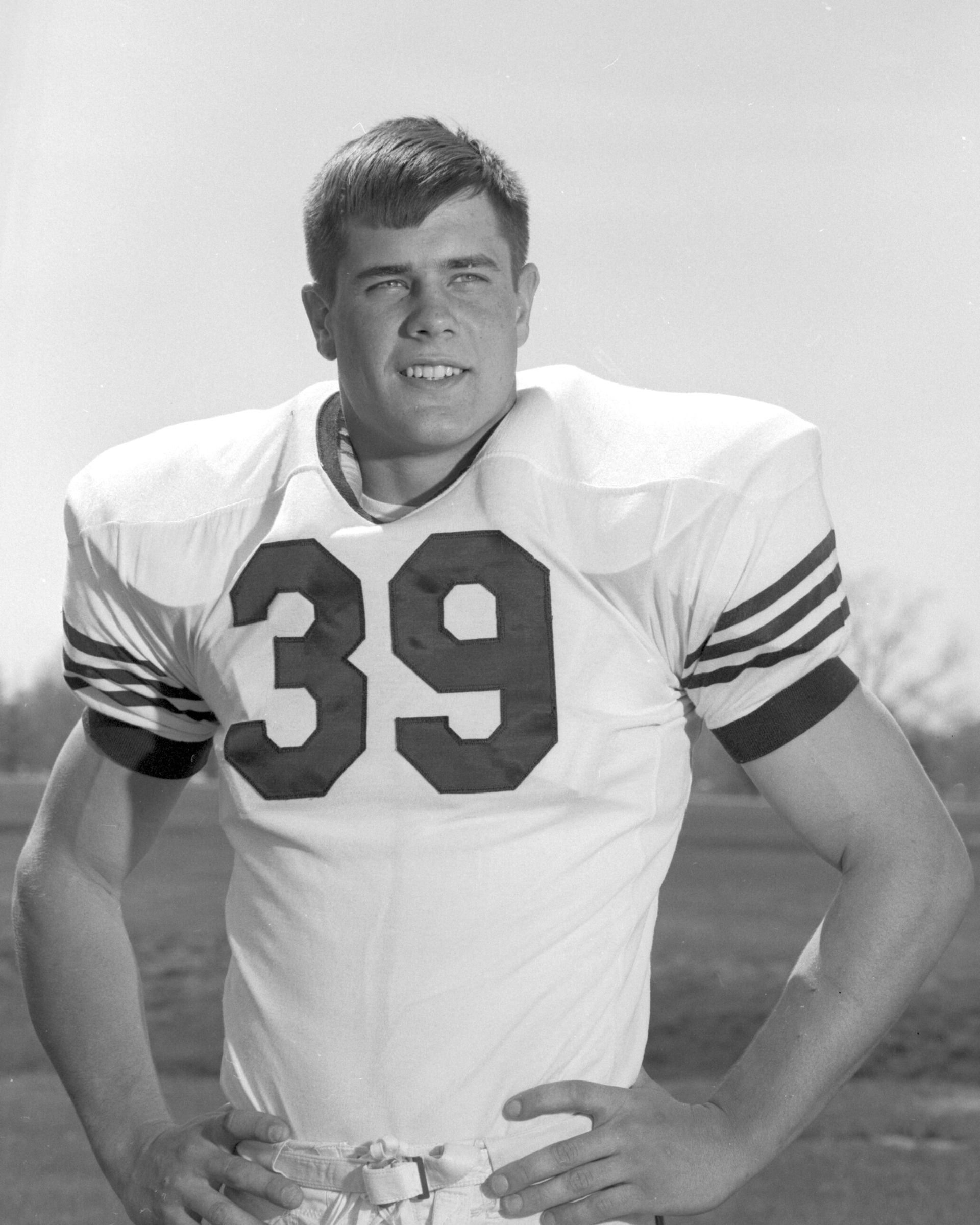
Jeff Trigger
Jeff Trigger
Oct. 20, 2025
There aren’t many folks in Champaign between the ages of 20 and 70 who aren’t familiar with Jeff Trigger. Whether you were a former Central High School football player or swimmer, a Fighting Illini football fan in the 1960s, or just sat in the front seat beside him when you were learning to drive, the personable Champaign native had relationships with a lot of people.
Growing up on Columbia Street, Trigger’s dad (Ken) was an engineering professor at the University of Illinois. As a teenager, young Jeff sold programs at Illini football games in the late 1950s and enjoyed watching all-stars named Burrell, Nitschke and Easterbrook. For Illinois games he didn’t attend, he and older brothers Jim and Tom could hear the roars of Memorial Stadium from their back yard.
Trigger eventually became a standout athlete alongside Bill Huston for Coach Tommy Stewart’s Maroons football team in the early 1960s, playing linebacker and tight end. He also was a standout swimmer at Champaign High with future Illini Kip Pope, and competed in track and field as well. The summer after Trigger graduated, UI coach Pete Elliott offered him a football scholarship to his hometown school. Wearing No. 39 for the Orange and Blue, he lettered as a linebacker for Elliott in 1966, then twice more for head coach Jim Valek in ’67 and ’68.
Trigger’s sophomore season in ’66 was particularly memorable. Illinois’s 6-4 record included a home victory over Ohio State and a road win at Michigan.
Though the 1968 Illini finished with a 1-9 record, Trigger especially remembers a narrow 31-24 loss against eventual national champion Ohio State and a 14-0 victory over an Alex Agase-coached Northwestern team.
Upon his graduation with a degree in physical education, Trigger returned to Champaign High in the fall of 1969 to teach and coach. He became the Maroons’ head swimming coach and continued in that role for 34 years. Assisted by Bob Miller, Champaign’s team finished third in the state in 1997. Among the swimmers Trigger mentored—“so many great kids, I never want to slight any of them”—included Dan Trupin, Tyler McGill, Tommy Lockman, Mark Tomlin, Tom Folts, Bill Werstler, Will Sensenbrenner and Mark Sinder.
On the football field, Trigger initially served as a volunteer coach for Stewart, then served for 14 years with fellow with Rich Wooley on Stewart’s staff.
“I always thought I had the best of both worlds because I got to play for Tommy and later, after I graduated, I got to coach for Tommy,” Trigger said. “He was such a great person and motivator. You just didn’t want to disappoint him. His philosophy was to keep things simple, though he could be very innovative, too. As an assistant coach, he would give me some freedom. It was the best situation I could hope for.”
When Wooley took over as Central’s head coach, Trigger continued as an assistant for five more seasons.
Trigger became CCHS’s head coach in 1989 and stayed in that role for 12 seasons. He was assisted by Lou Due. Trigger stayed one additional year as an assistant when Jeff Hasenstab took over the Maroons in 2001.
Among the hundreds of fine football athletes that Trigger helped tutor include John Levanti, Andy Dixon, Billy and Dennis Stahl, three Anastasia brothers (Derek, Mike and Dana), Ricky Aeilts, Todd Peat, Bill and Paul Hobbs, three Rogers brothers (Alex, Daryl and Elliott), Terrayel Cartmill; Dan O’Neill, John Skillings, Willie Summerville, and J Leman.
Hundreds of Champaign’s young people know Jeff Trigger as a favorite driver’s training instructor, a role he retired from in November of 2018.
Trigger and his wife, the former Carolyn Burch from Urbana, celebrated their 50th anniversary this past summer. Their son, Jeff Jr., resides with his family in Fort Worth, Texas.
Trigger celebrates his 78th birthday on Monday.

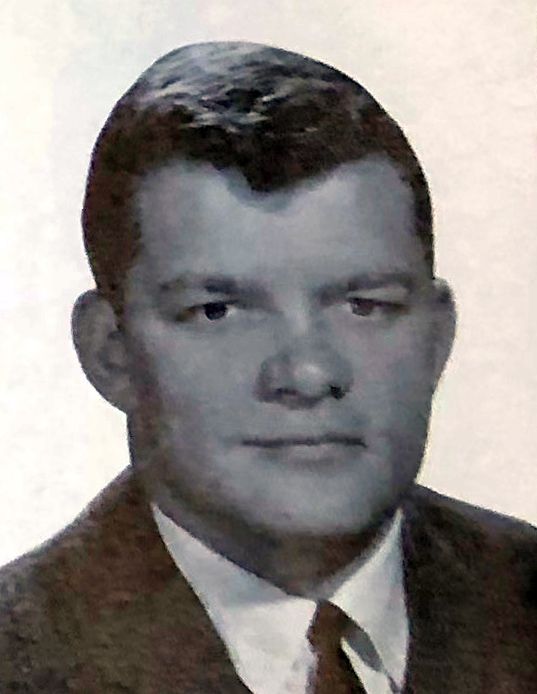
Bill Taylor
Bill Taylor
Oct. 16, 2025
He was Pete Eliot’s right-hand man and nearly became the University of Illinois’ head football coach. Bill Taylor, who celebrates his 94th birthday this coming Sunday (Oct. 21), was slated to be named Elliott’s successor on Dec. 12, 1966. However, the announcement never came forth because, just hours earlier, then assistant athletics director Mel Brewer had walked into UI president David Henry’s office to reveal earth-shaking news about the infamous “Slush Fund”.
“It was that weekend before that Pete and I got the official word about our promotions—me to become head coach and Pete to become the athletic director—so I drove up to Chicago that afternoon on a recruiting trip,” Taylor said. “I checked into my hotel about 5 p.m. and there was a message waiting for me from Pete. He told me about the bad news and, naturally, I was totally devastated.”
The former Nebraska star, Most Valuable Player of the Huskers his senior year, instead joined Coach Tom Landry’s staff with the Dallas Cowboys and stayed there for three seasons.
“I got out of football shortly afterwards and was working for Levi Strauss and Company in San Francisco,” Taylor said. “Pete had become the athletics director at the University of Miami (Fla.) and he wanted me to become head coach, but the timing just wasn’t right.”
Taylor stayed with Levi Strauss for 25 years and retired in 1995. Today, he lives in San Diego, Calif. with his wife of 45 years, Gayle. Taylor’s grandson, Mark Taylor, is currently Director of Development and Vice Chancellor for Institutional Advancement at UIUC.

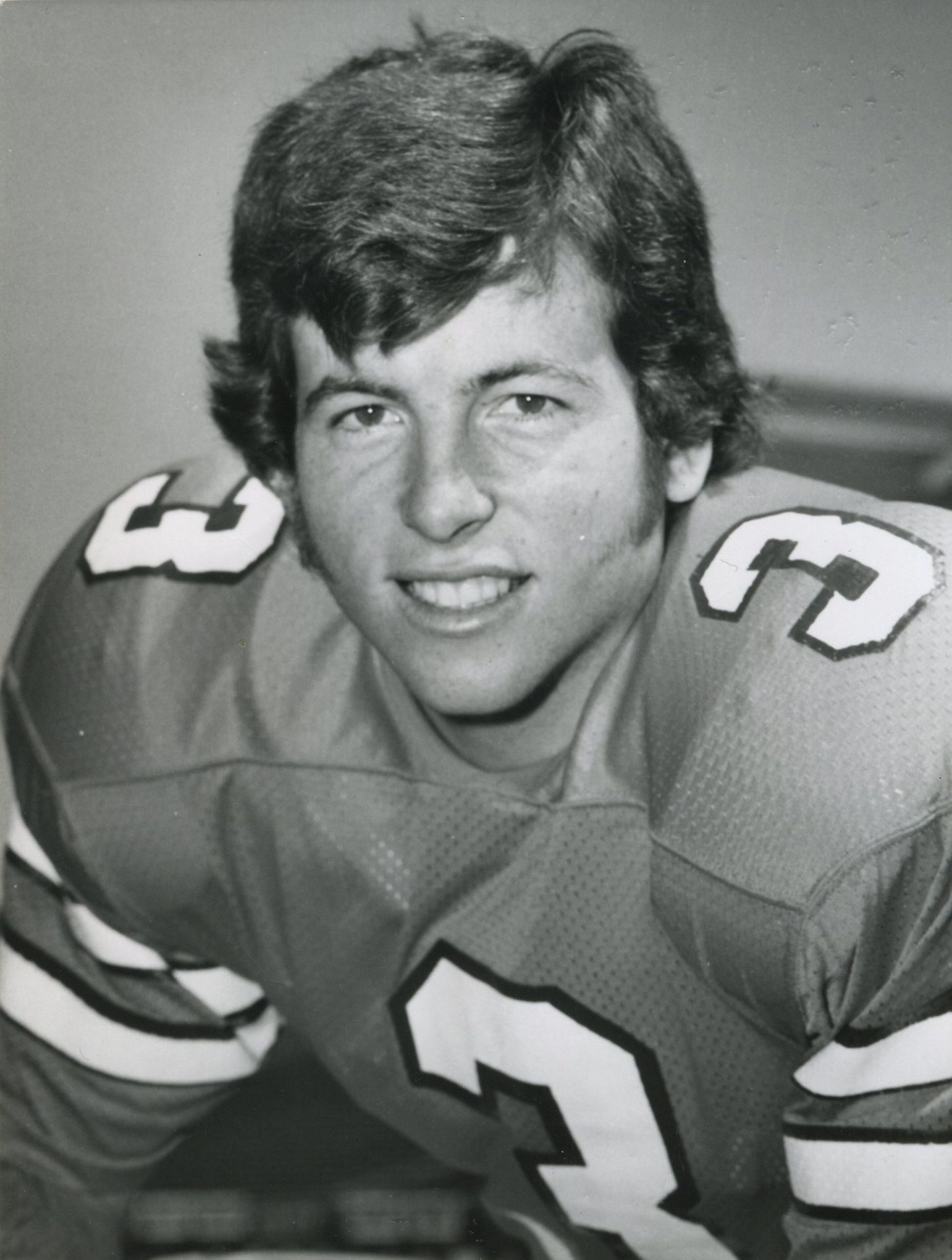
Dan Beaver
Illini Single-Game Field Goals
Oct. 13, 2025
Fifty-two years ago today - Oct. 13, 1973 - Illinois’ Dan Beaver kicked a Big Ten record-tying five field goals in the Illini’s 15-13 win at Memorial Stadium against Purdue. One of those placements, a 52-yarder, tied Lonnie Perrin’s UI record for distance.
Illinois' top single-game field goal kickers in Conference action (chronological order):
5 Dan Beaver, Illinois vs. Purdue, 10/13/73
5 Mike Bass, Illinois at Wisconsin, 10/23/82
5 Chris White, Illinois vs. Wisconsin, 10/6/84
5 Doug Higgins, Illinois vs. Michigan State, 10/20/90
5 David Olano, Illinois vs. Purdue, 10/4/25


Tommy Stewart
Tommy Stewart
Oct. 9, 2025
It’s accurate to say that Thomas C. “Tommy” Stewart had a personal and positive impact on more Champaign youngsters than nearly anyone.
Today (Oct. 9) marks the 100th anniversary of his birth in 1925.
During his 31 years of coaching football at Champaign High School and Central High, the former Fighting Illini star was a consistent standard for honesty and integrity.
Stewart, a native of Gary, Ind., enlisted in the U.S. Navy in 1944, serving two years, primarily at Pearl Harbor. Upon his discharge in 1946, he chose to attend Illinois over Notre Dame and became an outstanding player for Coach Ray Eliot.
Stewart was a freshman defensive back and backup quarterback for the 1946 Big Ten titlists and 1947 Rose Bowl champions. As a junior QB in 1948, he completed 20-of-39 passes for 306 yards and a touchdown. Altogether, Stewart lettered four times for the Illini.
He became Bement High School’s head football coach in 1951, then two seasons later became an assistant to Fred Majors at Champaign High. When Majors was sidelined by health issues midway through the 1953 season, Stewart took over as head coach. Some of the players he coached from 1953-83 included Jeff Trigger, Stu Clark, Billy Stahl, Skip Ohl, Rich Callaghan and scores of others. Including a pair of undefeated teams in 1956 and ’66, Stewart retired as the state’s winningest active coach, compiling 207 victories. He also served as Central head baseball coach for five seasons.
Stewart served a variety of roles at University of Illinois football games, including as the official time keeper. He died in March of 2012 at the age of 86.

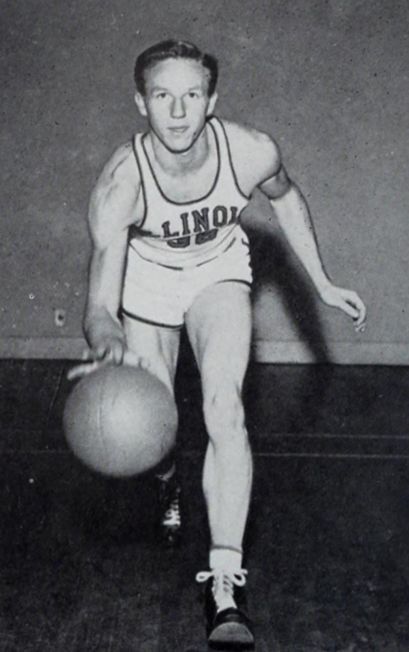
Ken Menke
Ken Menke
Oct. 2, 2025
Today is the 103rd anniversary of the birth of former University of Illinois Whiz Kids star Ken Menke.
Born in East Dundee on Oct. 2, 1922, he was a multi-sport star at Dundee High School. Illini coach Doug Mills lured him to play for the Orange & Blue where the 6-foot-3-inch Menke teamed with Gene Vance, Art Mathisen, Andy Phillip and Jack Smiley to form one of Illinois’ greatest teams. The Whiz Kids won back-to-back Big Ten Conference titles in 1942 and ’43.
As a sophomore in ’42, Menke was second to Phillip in scoring and 10th in the conference, and earned second-team All-Big Ten honors. He was injured midway through the ‘43 season but still finished third in team scoring.
Military service as a field artillery soldier during World War II stalled Menke’s basketball career, but he rejoined his teammates at Illinois for the 1946-47 campaign.
Menke played professionally for Fort Wayne in 1948 and for Waterloo in 1950.
He coached at Galesburg High School for four seasons and helped the Silver Streaks win a regional championship.
Menke joined with his brother and father in the family’s construction business, then later worked as a court bailiff. He died on Sept. 2, 2002, just a month shy of his 80th birthday. Menke is buried at Elgin’s Lakewood Memorial Park.


Ken Menke
Ken Menke
Oct. 2, 2025
Today is the 103rd anniversary of the birth of former University of Illinois Whiz Kids star Ken Menke.
Born in East Dundee on Oct. 2, 1922, he was a multi-sport star at Dundee High School. Illini coach Doug Mills lured him to play for the Orange & Blue where the 6-foot-3-inch Menke teamed with Gene Vance, Art Mathisen, Andy Phillip and Jack Smiley to form one of Illinois’ greatest teams. The Whiz Kids won back-to-back Big Ten Conference titles in 1942 and ’43.
As a sophomore in ’42, Menke was second to Phillip in scoring and 10th in the conference, and earned second-team All-Big Ten honors. He was injured midway through the ‘43 season but still finished third in team scoring.
Military service as a field artillery soldier during World War II stalled Menke’s basketball career, but he rejoined his teammates at Illinois for the 1946-47 campaign.
Menke played professionally for Fort Wayne in 1948 and for Waterloo in 1950.
He coached at Galesburg High School for four seasons and helped the Silver Streaks win a regional championship.
Menke joined with his brother and father in the family’s construction business, then later worked as a court bailiff. He died on Sept. 2, 2002, just a month shy of his 80th birthday. Menke is buried at Elgin’s Lakewood Memorial Park.

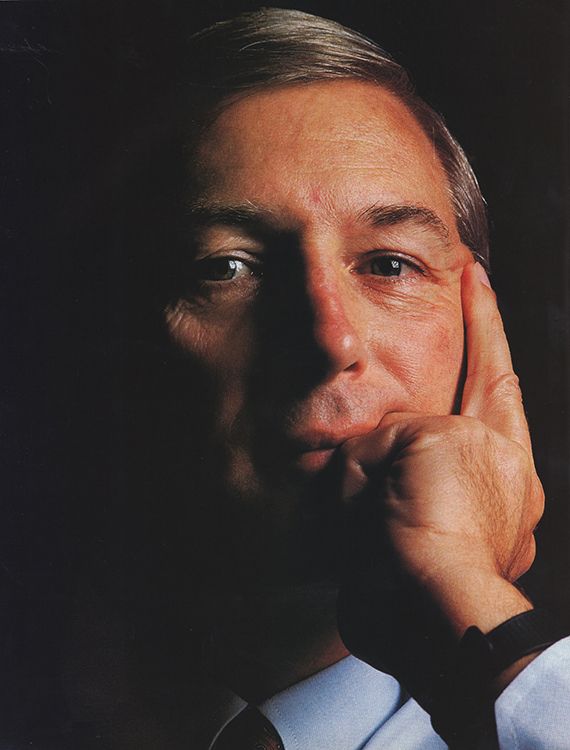
John Mackovic
John Mackovic
Oct. 1, 2025
Happy 82nd Birthday on Oct. 1 to former Fighting Illini football coach and director of athletics John Mackovic. His four Illinois teams won 70 percent of its game in Big Ten play and he’s the only conference coach to post a perfect 4-0 record versus Ohio State during his time in Champaign-Urbana.
Other trivial facts you might not have known about Mackovic and his Illini teams:
• Mackovic was the first man in Big Ten history to win Big Ten Coach of the Year accolades in each of his first two seasons.
• From 1988-91, a total of 10 different players (on 16 occasions) earned first-team All-Big Ten honors during Mackovic’s stint as UI’s head coach.
• Two of Mackovic’s Illini squads finished among the Associated Press Top 25. The 1989 team finished No. 10, while the 1990 club was No. 25.
• Mackovic’s teams were 8-8 against ranked opponents, including a 4-2 record versus non-conference foes.
• Under Mackovic’s tutelage, Illinois led the Big Ten in passing offense twice (262.0 yards per game in 1989, 257.1 in 1990).
• From 1988-91, only Michigan (29-2-1) compiled a better record in Big Ten games than Illinois (22-9-1).
• In 32 games against Big Ten teams, Mackovic’s Illini were shut out only once. Though his teams only averaged nine points per game vs. Michigan in four losses, the Illini averaged 26.1 ppg in the other 28 contests.
• All four of Mackovic’s teams played in post-season bowl games.

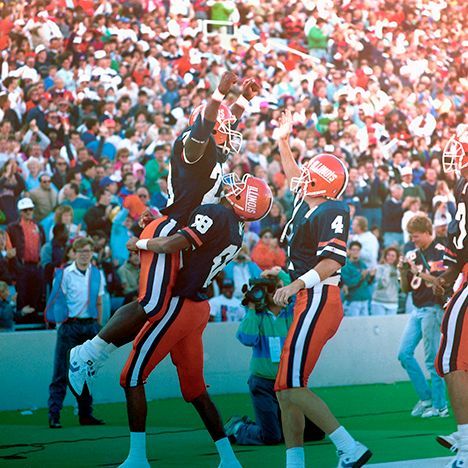
Howard Griffith
Howard Griffith's Record Day
Sept. 22, 2025
September 22, 1990 is a date that is steeped in history for University of Illinois football. It was a day that Howard Griffith penciled his name into the NCAA record book beside those of Red Grange, Jim Brown and Arnold Boykin.
Not only did the illini senior gain 208 yards on 21 attempts, it was a day when an amazing 38 percent of his runs ended up in the end zone.
Surprisingly, after the first quarter, Illinois trailed visiting Southern Illinois, 21-7. That’s when Griffith went into overdrive, scoring three touchdowns in the second quarter and four more in the third period.
His eighth TD came with 1:25 left in the third quarter, breaking two NCAA records. Not only did Griffith snap the national mark for touchdowns in a game—seven, by Mississippi’s Arnold Boykin in 1951—the 48 points he accounted for that day broke the immortal Jim Brown’s record of 43 points scored for Syracuse against Colgate in 1956.
Griffith’s eight touchdowns:
1. 1st quarter – 5-yard run
2. 2nd quarter – 51-yard run
3. 2nd quarter – 7-yard run
4. 2nd quarter – 41-yard run (tied Illinois’ record for first-half TDs)
5. 3rd quarter – 5-yard run
6. 3rd quarter – 18-yard run (broke Red Grange’s UI record for single-game TDs)
7. 3rd quarter – 5-yard run
8. 3rd quarter – 3-yard run (broke the NCAA record for touchdowns by Mississippi’s Arnold Boykin & the NCAA record for total points by Syracuse’s Jim Brown)
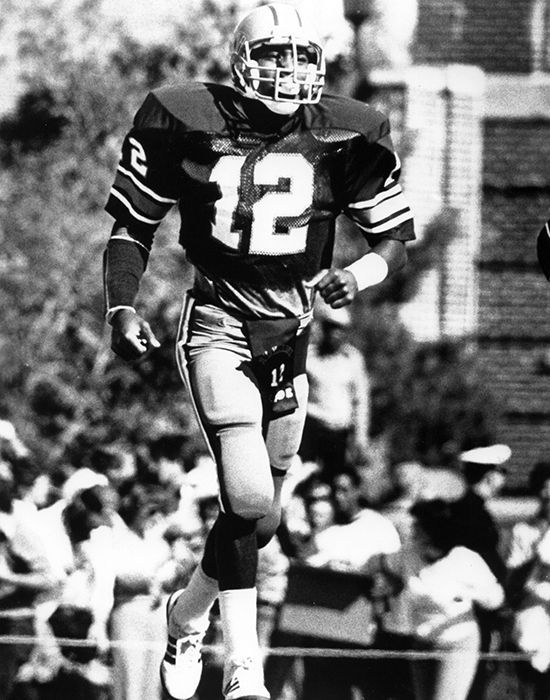
Craig Swoope
Craig Swoope
Sept. 18, 2025
On this date 43 years ago - Sept. 18, 1982 - freshman defensive back Craig Swoope intercepted two passes and quarterback Tony Eason threw for 293 yards to lead Coach Mike White’s Fighting Illini past host Syracuse, 47-10.
SU’s Carrier Dome was the site for Illinois’ first indoor game since the turn of the 20th century. Swoope’s defensive picks came in only his third collegiate game and were two of 12 career interceptions he made for the Illini.
At the conclusion of his career, he ranked fourth in that category behind Al Brosky (29), Mike Gow (19) and teammate Mike Heaven (13). The native of Fort Pierce, Florida had 205 tackles altogether, just shy of placing him among Illinois’ top ten in defensive stops.
Swoope co-captained the Illini as a senior in 1985 with Jack Trudeau and Chris White, earning All-Big Ten honors all four years he played in Champaign.
His college career was marred by a federal indictment on drug charges in 1984, but he eventually was acquitted by a District Court jury. Swoope was a fourth-round pick in the 1986 NFL Draft by the Tampa Bay Buccaneers and also later played for the Indianapolis Colts.
In 2008, Fort Pierce’s Westwood High School retired Swoope’s No. 20 jersey. He now lives in Champaign-Urbana.
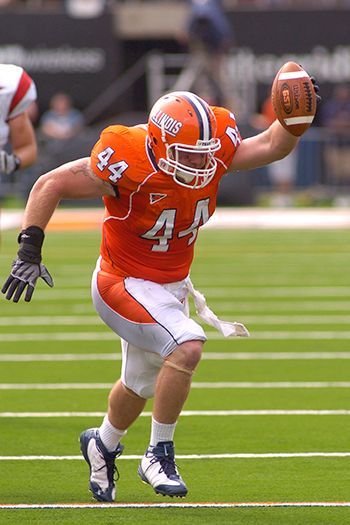
Brit Miller
Brit Miller
Sept. 15, 2025
Happy 39th Birthday to Fighting Illini football alumnus Brit Miller. The former Decatur Eisenhower High School star was a member of Ron Zook’s first recruiting class and eventually became a co-captain for the 2008 squad with Juice Williams, Arrelious Benn and David Lindquist.
Miller started five games at linebacker as a freshman in 2005, ten as a sophomore in ’06, ten as a junior in ’07, then all 12 games as a senior in ’08.
Illinois’s No. 44 had a sensational final campaign, notching 132 tackles, 15.5 tackles for loss, six quarterback sacks, breaking up eight opponent passes, intercepting one pass, forcing three fumbles and returning one of them for 27 yards. In the 2008 Rose Bowl against the USC Trojans, Miller had five solo tackles, three TFLs and a sack. The Big Ten media selected him as a first-team All-Big Ten honoree in 2008.
Career-wise, Miller totaled 33 TFL’s for 116 yards in losses, ninth-best at the time on UI’s all-time list.
Though he was not selected in the 2009 NFL Draft, he was signed as a free agent by the Carolina Panthers. Carolina waived Miller, but the San Francisco 49ers picked him up and switched him to play as a fullback. He played three final seasons with the St. Louis Rams, serving as the special teams captain in 2012.
Today, Miller is president of Beck Tech, a Barbeck Communications, a wireless communications company based in Decatur. His “Leading the Way” foundation helps area athletes with safety equipment, health, and the overall growth of sports in the area.
Miller’s family includes his wife (Emily), a daughter (Macy) and three sons (Cooper, Beau and Presley).
Miller’s memories about Illinois' 2007 victory over top-ranked Ohio State:
“We were in a bad mood after losing at Iowa a couple of weeks before. We knew Ohio State was beatable. Offensively, they had some weapons, but nothing we were really scared of. Our offense had to produce. Juice (Williams) had a phenomenal game and Rashard (Mendenhall) was really starting to come into his own. What I remember best was our kickoff team. We had some guys who were just nuts—myself, Rakheem Smith, Martez Wilson, Joe Morgan. When we ran, there was no slowing down. We wanted guys who were hitters. We’d had a pretty good collision on the first kickoff, so on the second kickoff Jason Reda kicked it deep like he always did, and their wedge is running at me, Rakheem and Martez. About five yards before they got to us, they showed their true colors and slowed down. The hitting game that week was one of the reasons we won that game. After we won, I’m in the stands hugging my mom and my dad. It was eerily quiet. It was just one of those days that just got better. We started that day not knowing what our legacy would be. When you take down the No. 1 and you’re wearing the Orange and Blue, I think you’ve earned the right to be remembered in a pretty positive light.”

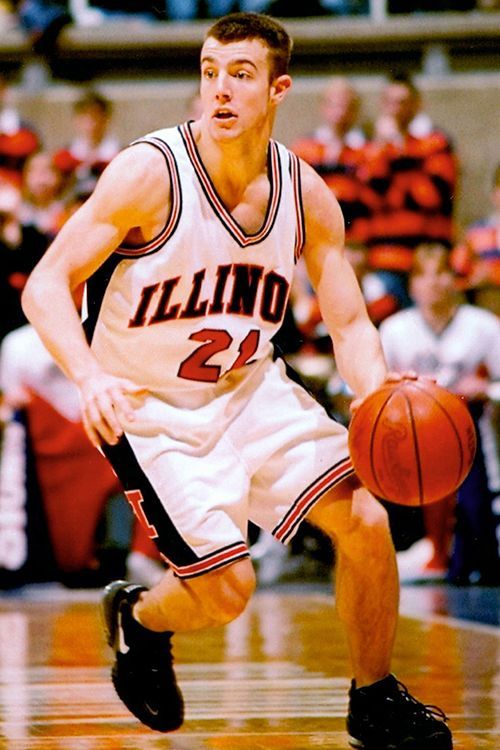
Matt Heldman
Matt Heldman
Sept. 13, 2025
Born on Sept. 13, 1976 was Illini basketball alumnus Matt Heldman.
Heldman was a four-year letter winner at Illinois from 1995-98 and started all 33 games in 1998 when the Illini won a share of the Big Ten Championship. As a senior, he averaged nearly a school-record 36.5 minutes per game. Heldman also contributed 11 points, four assists, three rebounds and two steals per game in his final season.
He lit up the scoreboard at Libertyville High School when he was a basketball star in the early 1990s.
Heldman was known for his incredible hustle and his legend lives today in Illinois’ basketball program in the form of the “Matto” Award. The award is given to the Illini player who accumulates the most "Matto" points (charges taken, steals, deflections, etc.) during the season.
Heldman graduated in 1998 from the University of Illinois with a degree in business and played professionally in Finland.
On October 11, 1999, at the age of 23, he and his father Otis were killed in a two-car, head-on collision in their hometown of Libertyville.

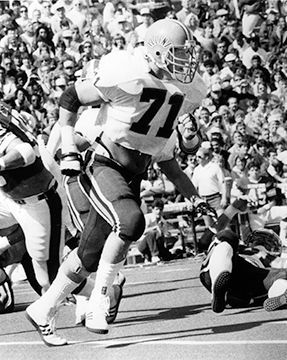
Jim Juriga
Wheaton Illini
Sept. 12, 2025
Jim Juriga, a graduate of Wheaton North High School, celebrates his 61st birthday today. A member of the University of Illinois’ 25-man All-Century Football Team, selected in 1990, Juriga played offensive guard for the Denver Broncos from 1986-91.
Several Fighting Illini players, including Red Grange, the famed “Wheaton Iceman”, have hailed from this talent-laden football community in suburban Chicago.
Here is a complete list of many of the men from Wheaton who have lettered for the Fighting Illini football team:
Name (High School) Position Years Lettered
Denman Bassett (Wheaton North) HB 1947
Jon Beutjer (Warrenville South) QB 2002, ‘03
Kirk Bostrom (Wheaton Central) K 1979, ‘80
Robert Bucklin (Wheaton Central) DE 1969, ’70, ‘71
Keith Burlingame (Wheaton) DT 1978
George Dawson (Wheaton) QB 1922
Steve DeFalco (Wheaton North) LB 1976
Philip Durant (Wheaton) HB 1921
Garland Grange (Wheaton) E 1927
Harold “Red” Grange (Wheaton) HB 1923, ’24, ‘25
Steve Havard (Wheaton North) RB 1995, ’97, ’98, ‘99
Jim Juriga (Wheaton North) OG 1982, ’83, ’84, ‘85
Dick Kee (Wheaton) HB 1963, ’64, ‘65
Steve Kimbell (Wheaton) C 1965
Jeff Kinney (Wheaton North) QB 1990, ’91, ‘92
Eric McGoey (Warrenville South) WR 2000, ’02, ‘03
Jason Schnack (Wheaton North) P 1993
Mike Taliaferro (Wheaton) QB 1962, ‘63
John Wachter (Wheaton North) DL 1986, ’88, ‘90

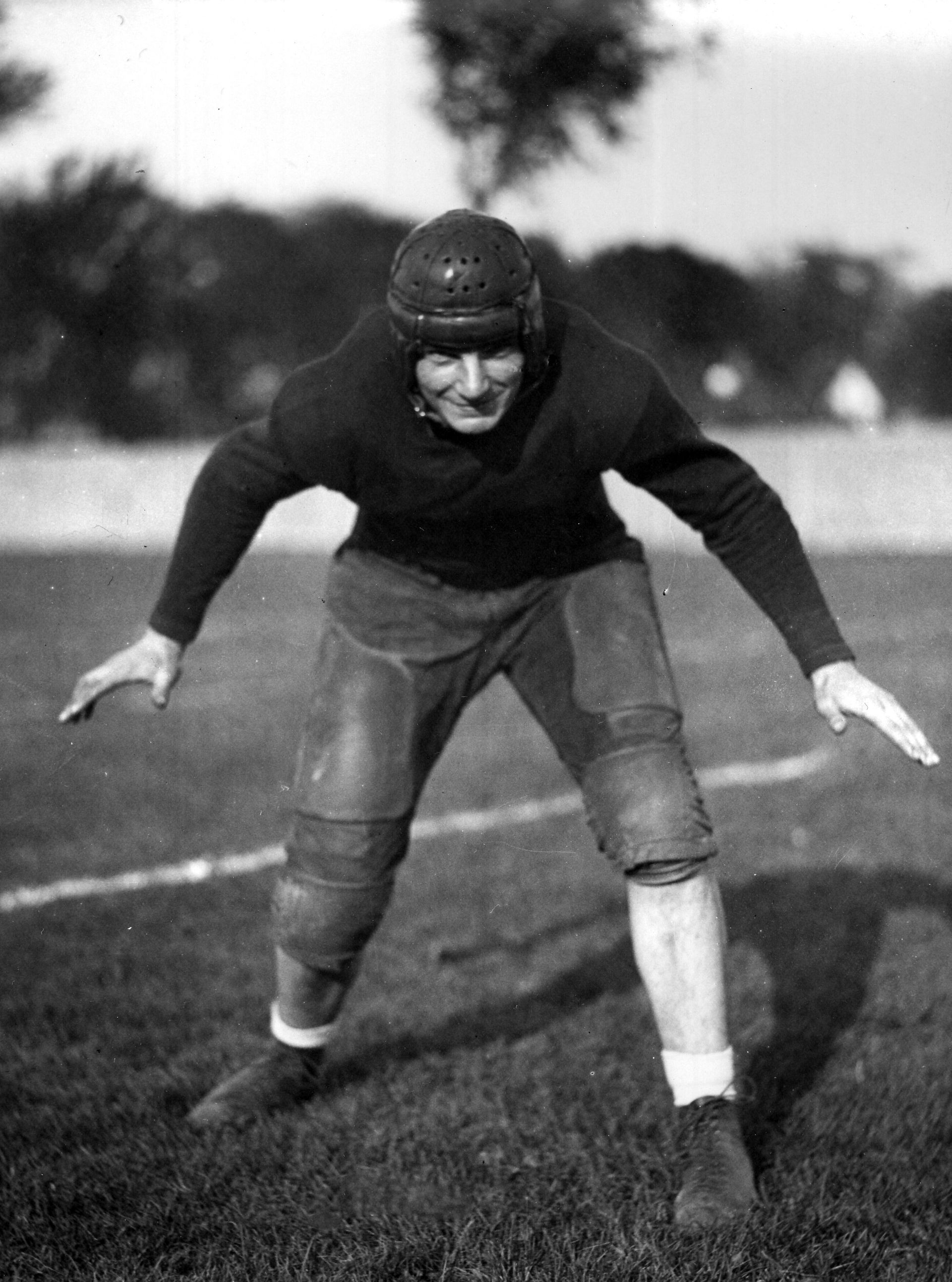
Lloyd Burdick
Lloyd "Tiny"Burdick
Sept. 8, 2025
This marks the 117th anniversary of the birth of former Fighting Illini football and wrestling standout Lloyd “Tiny” Burdick.
A letter winner on the Illinois gridiron from 1927-29, the 6-4, 248-pound product of Morgan Park High School went on to play football with Red Grange for George Halas’s Chicago Bears championship team of 1932. Burdick also played for the now defunct Cincinnati Reds football team.
He also was a top-notch wrestler at Illinois, losing in the 1930 NCAA heavyweight finals.
Burdick coached football at Knox College in 1934, but it was anything but successful as the Galesburg 11 lost eight games without scoring a single point.
He then went into the construction business, serving as a principal inspector of heavy-duty construction equipment on the Alcan and highway projects in the Canadian provinces of British Columbia, the Yukon, the Northwest Territories, as well as Alaska. The Alcan Highway began in Dawson Creek, British Columbia and ran all the way to Delta Junction, Alaska.
Completed in 1942, it was 1,390 miles long. Burdick
died tragically in 1945 at the age of 37. A train on which Burdick was a passenger collided with another in North Dakota. Thirty-one others also were killed in the collision.

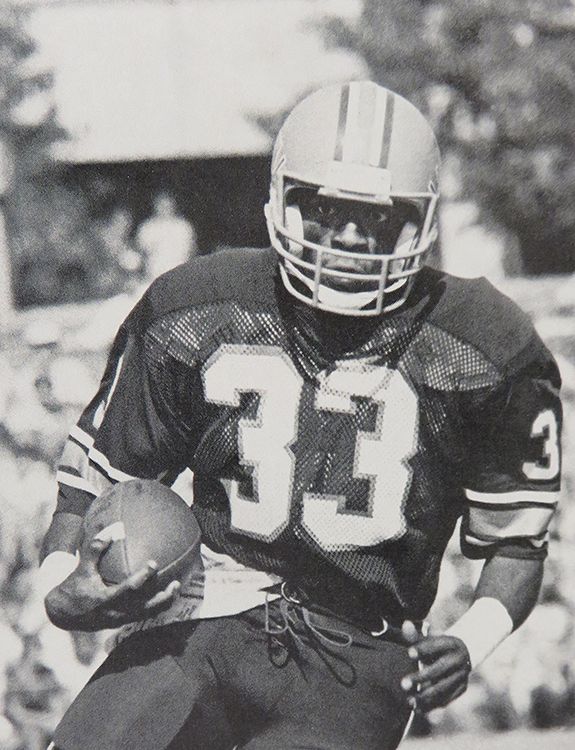
Mitchell Brookins
Mitchell Brookins
Sept. 4, 2025
Forty-three years ago today—Sept. 4, 1982—Illini junior running back Mitchell Brookins scored three touchdowns and led Illinois past Northwestern at Memorial Stadium, 49-13.
Though the former Wendall Phillips High School star was only his team’s fourth-leading rusher against the Wildcats—behind Dwight Beverly, Richard Ryles and Thomas Rooks—nobody reached the end zone more frequently than No. 33 that day. Brookins scored on five-yard runs in both the first and second quarters, then added a third TD early in the fourth quarter on a 15-yard pass from Tony Eason. He tallied seven more touchdowns in 1982.
His best single-game rushing effort was as a freshman in 1980 when Brookins ran for 180 yards in Mike White’s coaching debut. He played his senior season as a wide receiver, averaging a team-best 21.7 yards per catch. At the 1984 NFL Draft, the Buffalo Bills used their fourth-round pick to choose Brookins. He didn’t disappoint his new team that year, catching 18 balls for 318 yards, including a 70-yard TD.
Brookins died in an automobile accident in July of 1993 at the age of 32. He’s buried at Oakridge-Glen Oak Cemetery in Hillside, Ill.

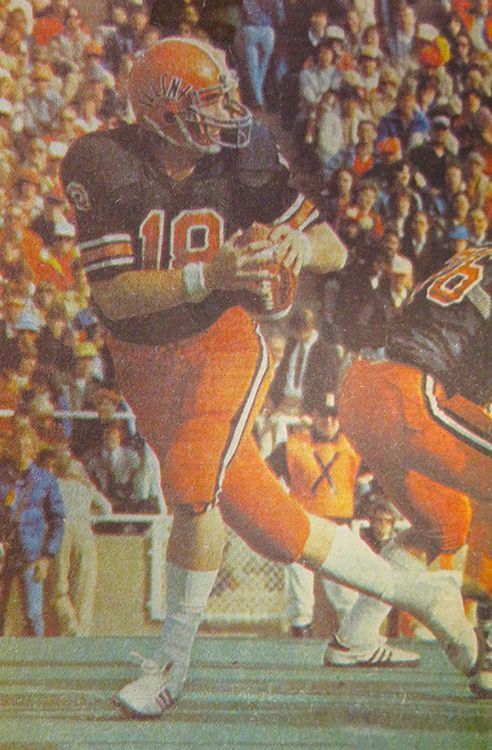
Dave Wilson
This Date in Illini History
Sept. 1, 2025
Forty-two years ago today - Sept. 1, 1983 - the David Wilson case, a bizarre three-and-a-half year eligibility dispute that severely strained relations between the University of Illinois and the Big Ten Conference, ended when attorney Bob Auler received an out-of-court settlement check of more than $100,000.
Other memorable moments on this date in Fighting Illini history:
1922: Champaign’s English Brothers Construction signed a contract to build Illinois’ Memorial Stadium. The stadium opened for business on Nov. 3, 1923, just 429 days afterwards.
1942: After carrying an “interim” tag for nearly 13 months, Doug Mills was named Illinois’ permanent athletic director.
1946: Illini athletic officials declared a sellout at Memorial Stadium for the Sept. 28 game vs. Notre Dame.
1948: Professor Albert Austin Harding, director of University of Illinois Bands, retired after a 43-year career.
1976: Karol Kahrs’ position as assistant director for women’s athletics became a fulltime job.
1984: Illinois topped Northwestern, 24-16, in its earliest football season opener ever. Jack Trudeau passed for 315 yards, including a record 208 yards to David Williams, as the Illini stretched its Big Ten winning streak to 11 in a row.
1994: Sixteen months after Illinois announced it was eliminating men’s varsity programs in swimming and fencing plus men’s and women’s diving, the U.S. Court of Appeals ruled that UI did not violate Title IX or the Equal Protection Clause of the U.S. Constitution when it eliminated the men’s but not the women’s swimming team.
2001: Brandon Lloyd, who was sidelined in 2000 with a broken leg, scored twice on eight catches as Illinois rolled past host California, 44-17.
2012: UI’s defense held Western Michigan to minus six rushing yards as Coach Tim Beckman won his first game as Illini coach.

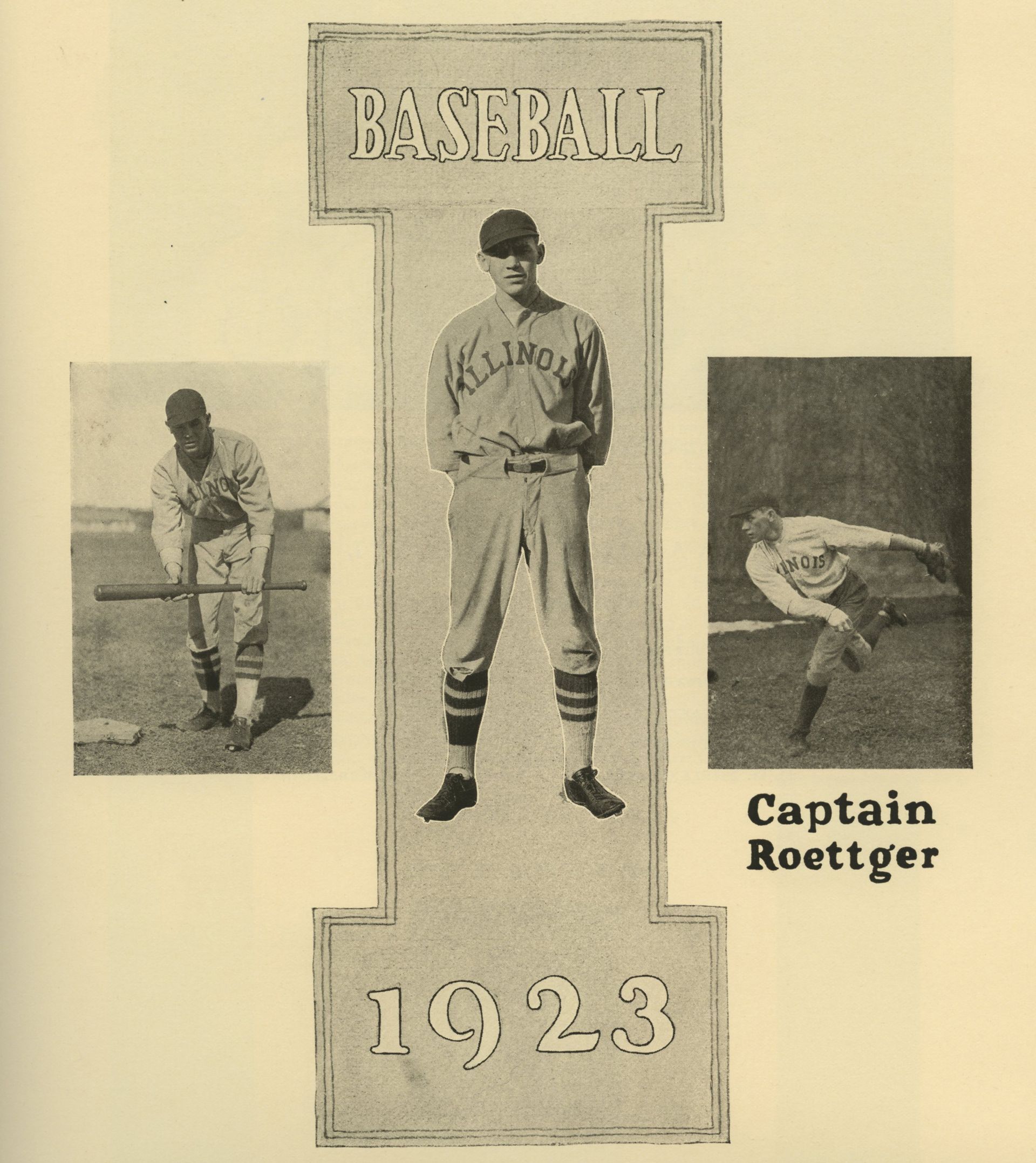
Wally Roettger
Wally Roettger
Aug. 28, 2025
Born 123 years ago today—Aug. 28, 1902—was Wally Roettger, a letter-winning athlete who both played and coached at Illinois, then starred as a Major Leaguer.
Walter Henry Roettger was the son of Gustave and Minnie Roettger of St. Louis. He was an outstanding all-around athlete at Yeatman High School in St. Louis and recruited to the University of Illinois to play baseball for Carl Lundgren and basketball for Frank Winters and Craig Ruby. Roettger went on to become a top-notch student-athlete at Illinois, being awarded the Big Ten Conference Medal of Honor when he graduated in 1924.
Roettger joined older brother, Oscar—a member of the Yankees—in the Major Leagues in 1927, making his debut on May 1 as a 24-year-old outfielder with his hometown Cardinals. Another brother, Harold, was Branch Rickey's executive assistant when Rickey was with the Cardinals, Dodgers and Pirates. Wally had two other siblings as well.
Wally Roettger had a breakout season in 1928 with a .341 batting average in 283 plate appearances. That year he knocked out six homers, four triples and 17 doubles. The ’28 Cardinals won the National League pennant but lost the World Series in four straight games to Babe Ruth and Lou Gehrig’s powerful Yankee club.
Roettger’s average dipped to .253 in 1929 and he was traded to the New York Giants in 1930. There, he started in the outfield with future Hall of Famer Mel Ott. Roettger notched a .283 batting average, including five homers, five triples and 15 doubles. He was sold by the Giants to the Cincinnati Reds shortly after the conclusion of the 1930 season.
In June of 1931, Roettger was dealt back to the Cardinals and helped lead St. Louis to another National League pennant and a seven-game World Series victory over the Philadelphia Athletics. He returned to Cincinnati for the 1932 and ’33 seasons, averaging .248 over that span. Roettger was then traded to the Pittsburgh Pirates for one final big league season in 1934.
During the off-season of his big league years, Roettger served as assistant baseball and basketball coach at Illinois Wesleyan.
In total, over eight Major League seasons, he averaged .285 in nearly 600 games.
Roettger took over as Illinois’ head baseball coach in 1935. Over 17 seasons, the team won or shared four Big Ten titles, finished as the runner-up three times, and placed third on four occasions.
He also served as UI’s assistant basketball coach from 1936-49, first for Doug Mills and then for Harry Combes.
In his later years, Roettger suffered from deteriorating health and vision. In 1951, he took his own life at the age of 49, leaving his wife, Marjorie, and two children. His son, Walter, Jr., had an extensive career in higher education, including a lengthy stint as President at Lyon College (1998-2009) in Batesville, Ark. He and his wife, Margaret (Peggy), currently reside in Oswego, N.Y.

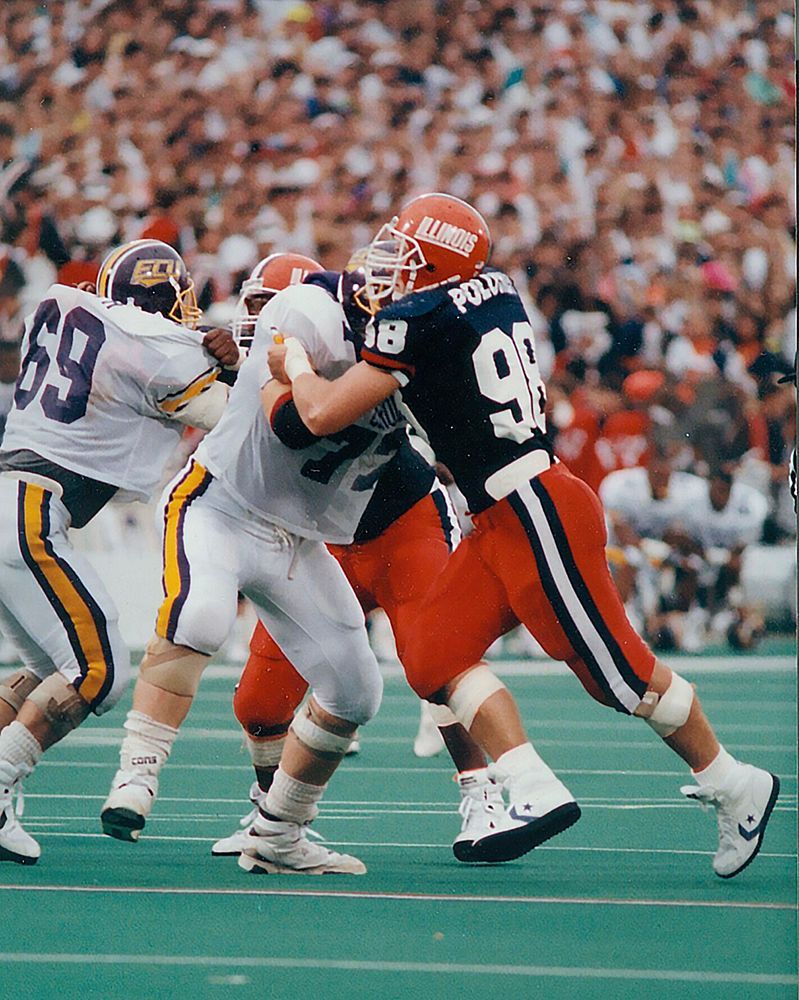
Mike Poloskey
Memorable Opening-Game Plays
Aug. 25, 2025
Nothing helps fans enjoy games more than a memorable play, especially in a season opening contest.
In Illinois’ 2000 opener, a 62-yard run by Rocky Harvey paced the Illini to a convincing 35-6 victory over Middle Tennessee. One season before that, Eugene Wilson’s 65-yard punt return led UI past Arkansas State. And, in Illinois’ 1991 season-opening win vs. East Carolina, Mike Poloskey (pictured) recorded a record-tying four quarterback sacks.
Here are some other big plays by the Illini in recent lid-lifters:
1975: Scott Studwell returned an interception 29 yards for a touchdown as Illinois beat host Iowa, 27-12.
1980: In Mike White’s coaching debut, Illinois took advantage of a 53-yard touchdown run by Mike Holmes to defeat Michigan State.
1984: In the earliest season-opener ever, David Wilson’s first-quarter 33-yard reception from Jack Trudeau gave Illinois a 7-0 lead. The Illini went on to defeat Northwestern, 24-16.
1989: A tipped-pass reception by Shawn Wax resulted in a 53-yard touchdown, beginning Illinois’ comeback victory on national television vs. Southern California.
1994: It wasn’t a victory, but Simeon Rice had one of his best efforts vs. Washington State, sacking Washington State’s quarterbacks five times.
2001: Brandon Lloyd’s 49-yard TD catch in the second quarter helped Illinois destroy host California in the season opener, 44-17.
2005: It was only a two-yard effort, but Pierre Thomas’ overtime touchdown completed Illinois’ come-from-behind victory vs. Rutgers in Ron Zook’s coaching debut.


Mary Pat (Travnik) Connolly
Mary Pat (Travnik) Connolly
Aug. 21, 2025
When Mary Pat (Travnik) Connolly was a young girl, basketball was considered as a “boy’s sport.”
“We even played with a men’s basketball,” she remembered. “We were just happy that the girl’s game was being acknowledged.”
The recruiting process for women’s athletes was in its infancy. Mary Pat’s coach at Lourdes High School, Bob Lenihan, contacted then Illini coach Steve Douglas
to tell him that he had a 6-foot post player who was pretty good. There was no videotape presentation, no in-home recruitment.
In Connolly’s freshman season, she received tuition. The Title IX legislation then kicked in and she was rewarded with a full scholarship for her final seasons in 1977, ’78 and ’79. No. 42 twice led the Illini in rebounding and, as a junior, she paced the team in scoring.
Connolly finished her career No. 1 on UI’s career rebounding list with 564. She was drafted by the Women’s Professional Basketball League’s Chicago Hustle and played for two seasons in the league.
In 1986, she got married and began her family. Connolly decided in 1990 to pursue a career in coaching, first in the high school ranks, then in the college ranks. Marist High School hired her in 2001 to start the girls basketball program and just finished her 14th year at the school located on115th Street in Chicago. Ten of Connolly’s players have gone on to earn either Division I or II basketball scholarships.
She retired as Marist's coach following the 2021-22 season. Her family includes her husband, Mike, and four sons.

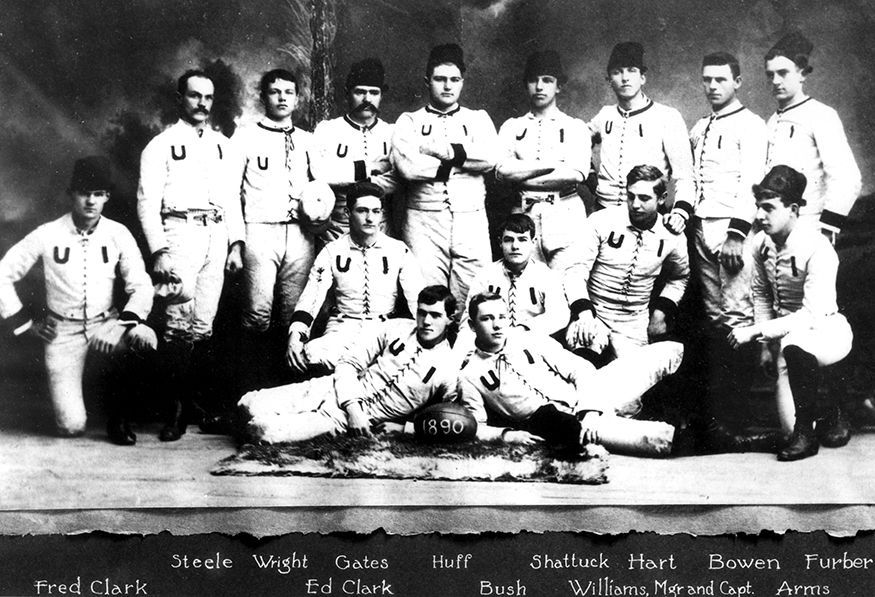
The 1890 Football Team
Illinois' First Football Team
Aug. 18, 2025
The year was 1890. The national population was just shy of 63 million, with Idaho and Wyoming admitted as the 43rd and 44th states.
And, on the University of Illinois campus, Scott Williams was introducing a new sport to the 519 students and 39 faculty members.
In author Linda Young’s book, “Hail to the Orange & Blue”, she wrote about how Williams matriculated to Champaign-Urbana from Normal’s University High School.
“When I inquired about the football team at the university,” Williams recalled, “an upperclassman gruffly replied, ‘there ain’t no such animal.’ Nothing could better illustrate the absolute disorganization of intercollegiate athletics at that time.”
Williams rounded up about a dozen men, including an upperclassmen named George Huff, and lectured them about how the game was played. Shortly afterwards, he arranged a game on Oct. 2, 1890 between Illinois and Wesleyan University in Bloomington.
With Williams serving as coach, captain and quarterback, Illinois’ crew battled valiantly but lost to Wesleyan by a score of 16-0. A month-and-a-half later, Illinois accepted Purdue’s challenge to play football, but the Boilermaker 11 had already been playing the game for three seasons and won decisively, 62-0.
That first season ended on a high note when Illinois hosted Wesleyan on Nov. 27. Nearly 300 spectators gathered at the Champaign County Fairgrounds in Urbana saw Illinois use a few of the tricks that it learned the week before at Purdue and won its very first game by a margin of 12-6.
The game ball from the victory 123 years ago still exists, residing in a trophy case at Memorial Stadium.

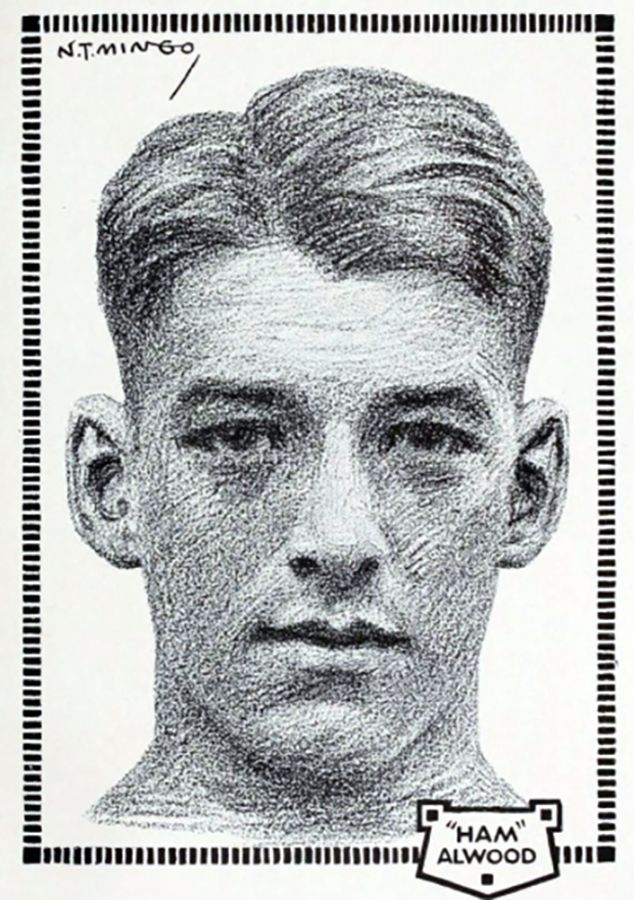
Clyde Alwood
Clyde Alwood
Aug. 14, 2025
Clyde Alwood, the University of Illinois’ third-ever recipient of the Big Ten Conference Medal of Honor for athletic and academic excellence, died on this date in 1954 in his childhood hometown of Clinton, Ill.
The three-time letter-winning Fighting Illini basketball star, whose life ended from a fatal heart attack, was only 59. Alwood was visiting his childhood home to celebrate his mother’s birthday.
The 6-foot-4-inch center was a starter for Coach Ralph Jones’ 1915, ’16 and ’17 teams, units that posted a composite record of 42 victories and only six losses. During Alwood’s sophomore campaign, Illinois’ undefeated team (16-0) not only won the Big Ten title (12-0) but was also declared college basketball’s national champion.
In Alwood’s junior season, Illinois won its first eight games to extend UI’s winning streak to a school-record 28 victories in a row. The 1916 Illini lost only three of their 16 games and finished second in the conference standings.
The club that Alwood captained as a senior regained the conference title by posting a 10-2 record. He played alongside future UI Hall of Famers Ray Woods and George Halas that season.
Academically, Alwood majored in agriculture and upon graduation began operating a small farm near Marshall, Ill. Just two months after he received his UI degree, Bloomington High School hired him as its head basketball coach. That stint lasted only one season. Though he wasn’t sent overseas to fight during World War I, Alwood served in the U.S. Army as a YMCA instructor. Alwood eventually became a civil engineer with the Illinois Central Railroad, then a salesman in Indianapolis, Rockford and Beloit, Wis.

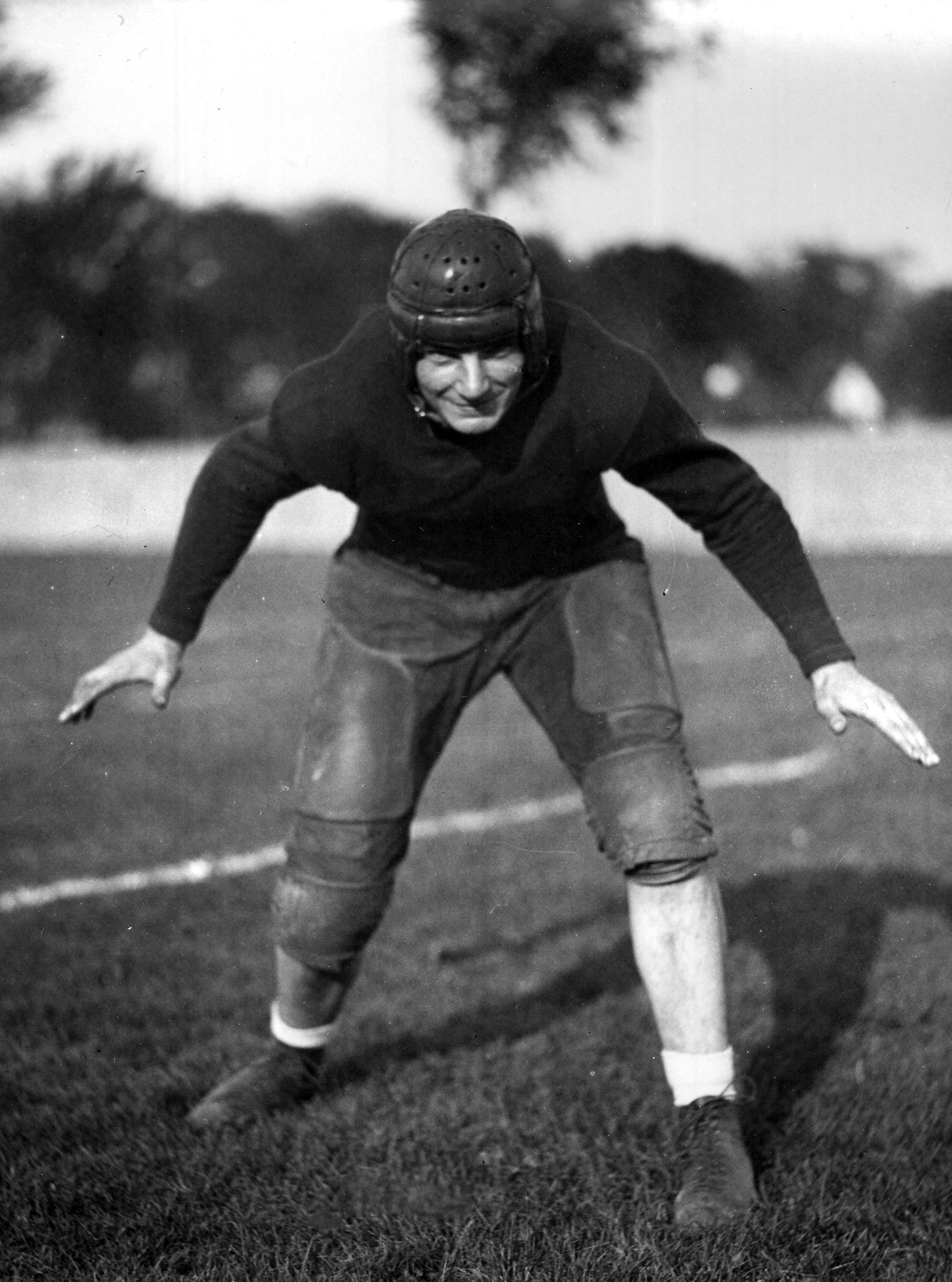
Lloyd Burdick
Lloyd Burdick
Aug. 8, 2025
This marks the 117th anniversary of the birth of former Fighting Illini football and wrestling standout Lloyd “Tiny” Burdick.
A letter winner on the Illinois gridiron from 1927-29, the 6-4, 248-pound product of Morgan Park High School went on to play football with Red Grange for George Halas’s Chicago Bears championship team of 1932. Burdick also played for the now defunct Cincinnati Reds football team.
He also was a top-notch wrestler at Illinois, losing in the 1930 NCAA heavyweight finals.
Burdick coached football at Knox College in 1934, but it was anything but successful as the Galesburg 11 lost eight games without scoring a single point.
He then went into the construction business, serving as a principal inspector of heavy-duty construction equipment on the Alcan and highway projects in the Canadian provinces of British Columbia, the Yukon, the Northwest Territories, as well as Alaska. The Alcan Highway began in Dawson Creek, British Columbia and ran all the way to Delta Junction, Alaska. Completed in 1942, it was 1,390 miles long.
Burdick died tragically in 1945 - one day after his 37th birthday. A train on which Burdick was a passenger collided with another in North Dakota. He and 31 others were killed in the collision.


Perry Moss
Perry Moss
Aug. 4, 2025
August 4th marks the 99th anniversary of the birth of Perry Moss, the starting quarterback for Illinois in the 1947 Rose Bowl.
Moss transferred to Illinois after playing for Tulsa in 1945. Coach Ray Eliot and Tulsa coach Henry Frnka coached together at the 1945 College All-Star Game in Chicago. Since Moss wasn’t in Frnka’s plans at Tulsa, Frnka encouraged the 5-10, 170-pound signal-caller to transfer to UI.
The ’46 Illini started off slowly, settling at 2-2 after four games. The team, led by Moss, Alex Agase, Dike Eddleman, Buddy Young and others, cruised to a 4-1 record thereafter and qualified for the ’47 Rose Bowl vs. UCLA. On the very first play from scrimmage at the New Year’s Day classic in Pasadena, Moss hooked up with Julie Rykovich for a 44-yard gain. Some two-and-a-half hours later, Moss and company had directed the underrated Illini to a resounding 45-14 victory over the Bruins.
Moss was named honorable mention All-Big Ten and was drafted in 1948 by the Green Bay Packers in the 13th round. He lasted just one season in the pros and turned to the coaching profession, beginning as backfield coach and head baseball coach for the Miami Hurricanes. He also spent a season at Wisconsin as an assistant, then was named head football coach and athletic director at Florida State.
Moss was head coach of the Canadian Football League’s Montreal Alouettes from 1960-62, at Marshall in 1968, and was an Arena League mentor for Chicago, Detroit and Orlando, finishing his coaching career in 1990. In 1995, Moss was inducted into the Florida Sports Hall of Fame.
He died on Aug. 7, 2014, three days after his 88th birthday.

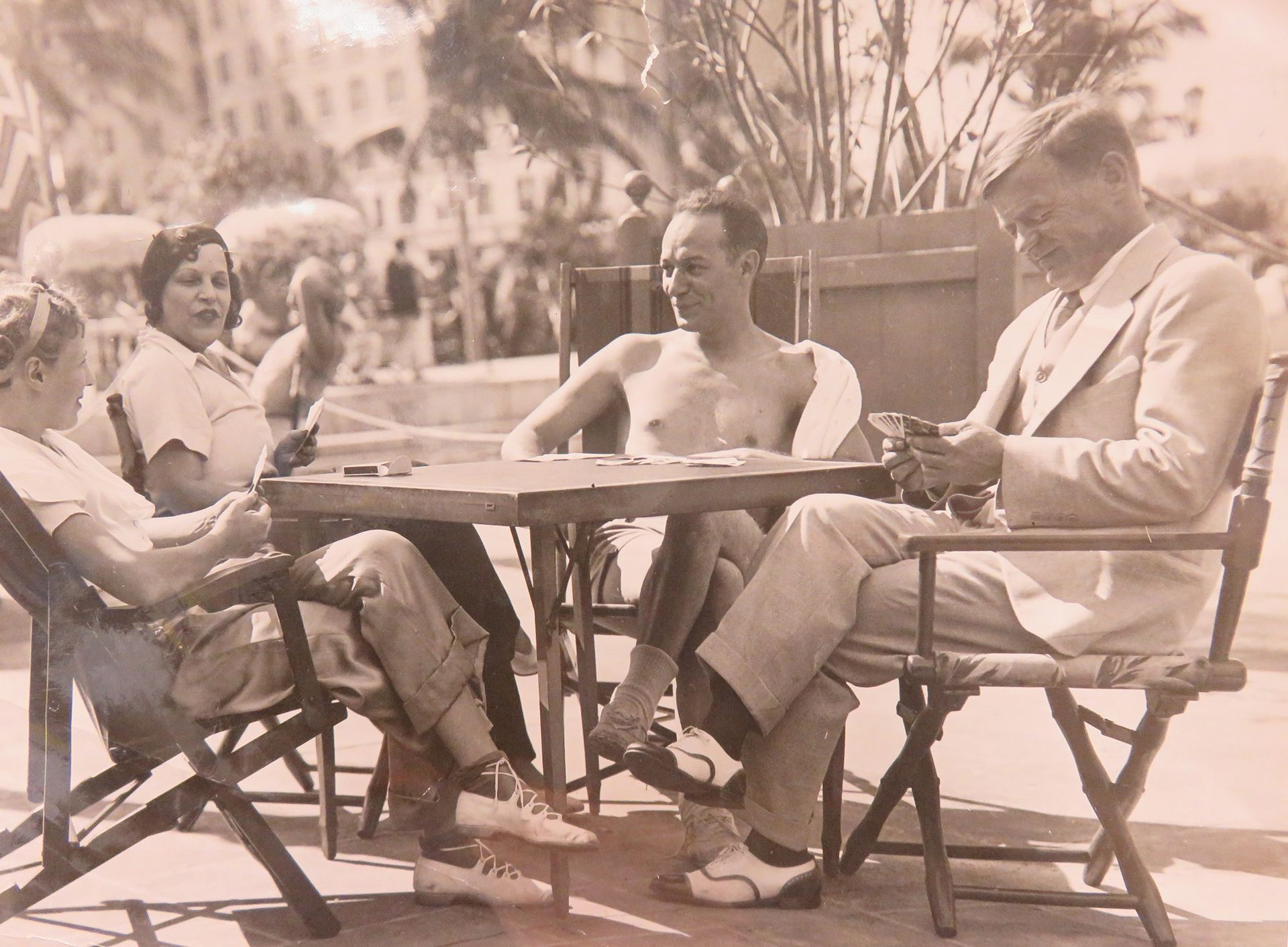
Bob Zuppke (right) and friends with a West Coast game of cards
Build That Stadium!
Aug. 1, 2025
One-hundred-four years ago today - Aug. 1, 1921 - George Huff and Bob Zuppke set out on an historic jaunt through the Western states to raise funds for a new stadium.
In chapter 10 of “Zuppke of Illinois”, a book produced in 1937 by A.L. Glaser Publishers, author Red Grange described how the athletic arena known as Memorial Stadium came to be.
"The vastly increased interest in the football teams turned out by Bob Zuppke made the seating capacity of Old Illinois Field entirely inadequate. When it was estimated that nearly 20,000 persons were unable to obtain seats to the Ohio State game in 1920, sentiment began to crystallize for the building of a Stadium large enough to accommodate the thousands who could not possibly be admitted to the small field that had been in use since 1900. “I haven’t the slightest doubt,” said George Huff, “that we could have sold more than 40,000 tickets and possibly 50,000 for the Ohio State game if we had had the seating facilities. With the growing interest in our athletics, it is no idle guess to prophesy that every one of the 75,000 seats in the new Stadium will be sold for the big games of the next few years.” Robert C. Zuppke, “G” Huff and alumnus Elmer Ekblaw became the “Big Three” in the Stadium Drive. Offices for the campaign were opened in the Old Union Building, and student committees were formed, and the real job—selling the idea to the student body—began in earnest. The propaganda took the form of mass meetings, speeches, parades, contests, pictures and posters. “BUILD THAT STADIUM FOR FIGHTING ILLINI” became the slogan, and “FIGHT ILLINI” the official Stadium song. Zup put his heart, sounds, mind and body back of the drive for funds for the erection of the Memorial Stadium. He is a zealot in anything he undertakes and, as chairman of the $2,000,000 Stadium Drive Committee, he traveled thousands of miles, addressed hundreds of groups of Illini the country over. He loves every grain of concrete in that Stadium. It represents the accomplishment of a practical dream."

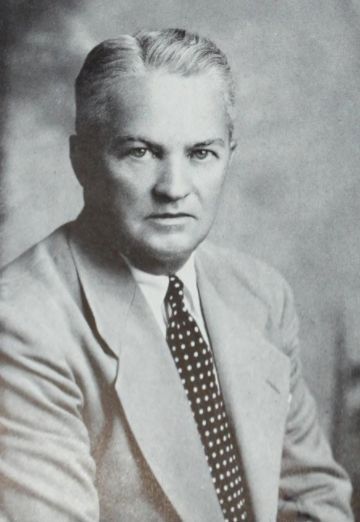
Leo Johnson
Leo Johnson
July 28, 2025
Today represents the 132nd anniversary of the birth of Fighting Illini track and field and football coaching legend Leo Johnson.
The Milliken College athlete and coach led the Big Blue football team to undefeated seasons in both 1928 and ’34. In 1938 Johnson accepted the head coaching job for the Illini track and field squad, staying on the Champaign-Urbana campus for the next 27 seasons.
His 1944 unit, led by Robert Kelley and Marce Gonzalez, defeated runner-up Notre Dame, 79-43, for the NCAA track and field title, the school’s third such championship. In 1946 and ‘47, Bob Richards, Dike Eddleman and Herb McKenley helped Johnson’s team post back-to-back national championships. Both times the Illini edged out Southern California for first place.
Illinois earned NCAA runner-up honors in both 1953 and ’54. Altogether, Johnson’s athletes captured 27 individual NCAA titles and 158 Big Ten crowns.
Near the end of his career, he served as President of the Track & Field Coaches Association (1963-64). Johnson also is a member of the Drake Relays Hall of Fame, the Millikin University Hall of Fame and the Illini Athletics Hall of Fame.
Many are unaware of Johnson’s talents as a football coach, serving as chief scout for Coach Ray Eliot’s Illinois’ football team. Three times during Johnson’s tenure, the Illini football team upset the nation’s top-ranked team: 1950 vs. Ohio State, 1955 vs. Michigan and 1956 vs. Michigan State.
Leo Johnson died in 1982 at the age of 87.

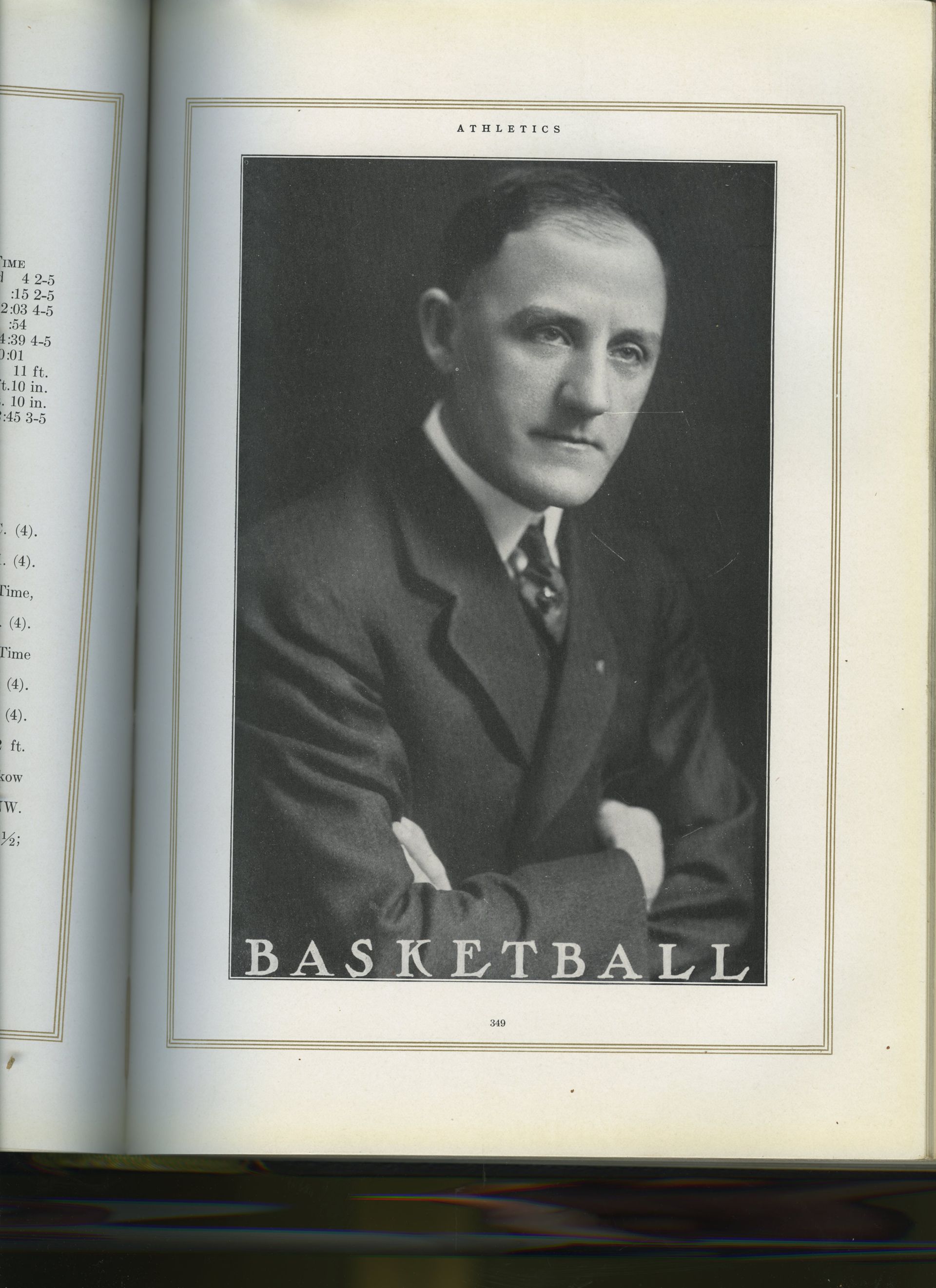
Ralph Jones
Ralph Jones
July 25, 2025
Ralph Jones is the answer to a great trivia question: What former Fighting Illini coach led Illinois to a mythical national title in basketball and led the Chicago Bears to their first NFL championship?
As for Jones’ prowess with the Illini cagers, he will go down in history as the man who led Illinois to a perfect 16-0 record—12-0 in Big Ten play—during the 1914-15 campaign. His Illini rolled through the season, winning by an average of 16 points per game at home in Big Ten play. That was an amazing statistic since UI averaged just 24.7 ppg over its entire conference season. In eight years at the helm of the Illini, Jones led the school to an 85-34 record, a winning percentage of .714.
As for Jones’ success with the Bears, he was hired out of Lake Forest College by the one and only “Papa Bear”, George Halas, a man who basketball played for him at Illinois. When he was hired in 1930, the somewhat cocky Jones promised that the Bears would be champs within three years. He then installed some of his revolutionary ideas for the utilization of the little-used T-formation. Jones’ offensive strategy attacked the defense through deception. His key innovation was putting a man in motion. Oh yes, did we mention that one of Jones’ most prominent players was a fellow named “Red” Grange?
In 1932, the Bears completed the regular season tied for first and then won the title by defeating Portsmouth in the famous "indoor" game, played on an 80-yard field at Chicago Stadium. With that, having made good on his promise of a title in three years, Ralph Jones retired from pro coaching to return to Lake Forest as athletic director.
Today marks the 74th anniversary of Jones' death.

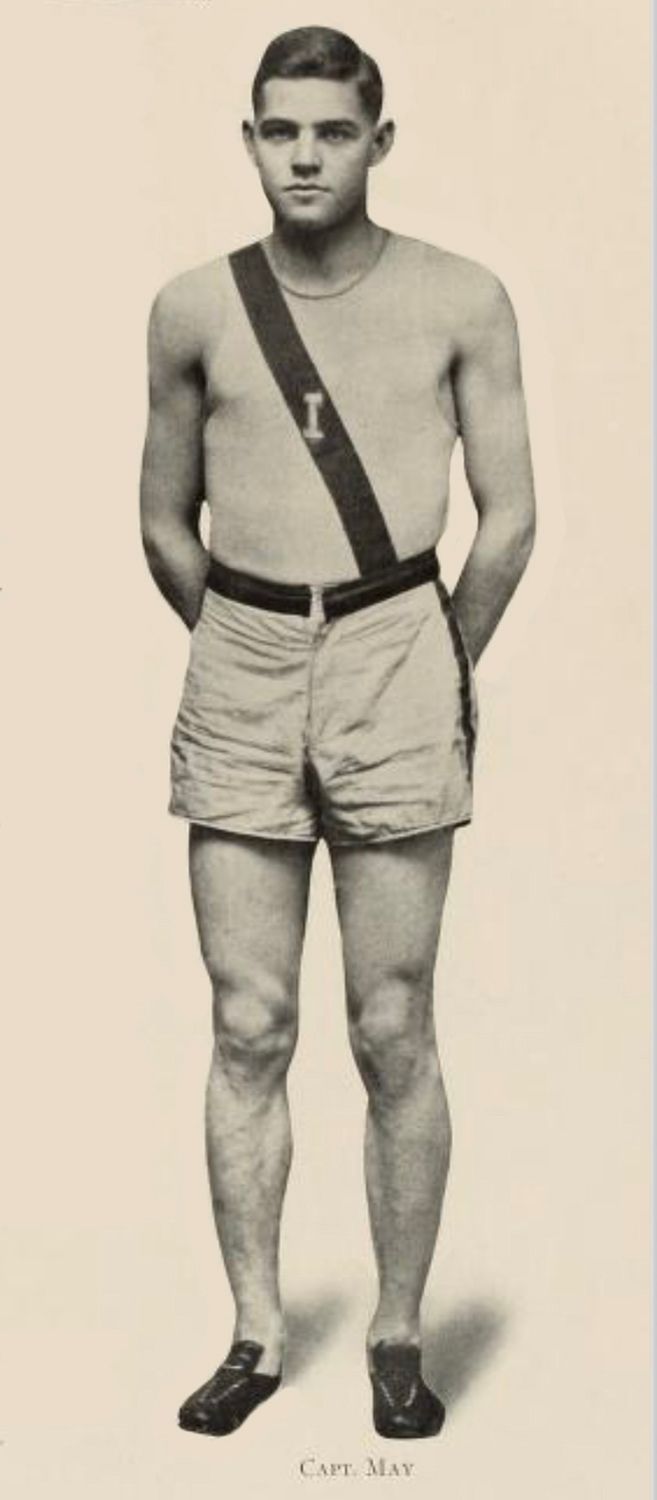
William May
Illinois' First Olympians
July 18, 2025
The names William May and Wilbur Burroughs likely aren’t familiar to fans of the Fighting Illini, but the truth is that they stand alone in their uniqueness. One-hundred-seventeen years ago, this highly anonymous pair was the first with University of Illinois ties that competed in modern Olympic Games.
The 1908 Olympic Games—originally scheduled to be held in Rome but relocated to England following the 1906 eruption of Mount Vesuvius—were held at London’s White City Stadium, a facility with a capacity of 68,000. The events featured more than 2,000 athletes (including 37 women) from 22 National Olympic Committees. Held four years before the appearance of Native American superstar Jim Thorpe, the ’08 competition was dominated by Great Britain’s team which won 146 total medals, including 56 golds and 51 silvers.
Both of the University of Illinois’ 1908 Olympians competed in track and field.
Burroughs, a native of Edwardsville, was a two-sport star for the Illini, lettering in football from 1904-06 and in track and field from 1905-07. His specialty was throwing weights and he was among 12 American athletes who competed in events that included the shot put, discus throw, hammer throw and Greek discus. Burroughs did not earn a medal at the Olympics, but placed eighth in Greek discus, ninth in the shot, and tenth in the discus. He also competed for America’s tug-of-war unit, a fifth-place finisher.
Burroughs studied engineering at the University of Illinois and was a co-founder of UI’s Triangle Engineering fraternity. He eventually became a teacher, coach and principal, first in Moline, then in the Detroit (Mich.) Public Schools system, working for more than 30 years in those capacities. Burroughs also refereed high school and college sports, including Big Ten sanctioned events. He and his wife, Elizabeth, returned to their hometown of Edwardsville in 1947, but tragically died together in an automobile accident on Illinois State Route 111 in 1960. Burroughs was 76 years old when he passed.
May, nicknamed Billy, was born in St. Paul, Ill. in 1887. An outstanding athlete in Rochelle High School, lettered for the Illini track team from 1906-09 as a sprinter and captaining Coach Harry Gill’s squad as a senior. The Illio, UI’s Yearbook, described the 5-foot-8 ½-inch, 161-pound May as “the best piece of sprinting machinery the West has ever produced and one of the most consistent sprinters on the American continent.”
At the Olympic Games, May placed first in his opening 100 meters heat, then second in the seminal round with a time of 11.0 seconds but did not advance to the finals. In the 200, May placed second in heat 11 but did not advance any further.
In 1917, during World War I, May enlisted in the Army, becoming a 1st Lieutenant in light field artillery. He served during a conflict with Mexico, then stayed on as a trainer at Camp Grant. Following his service, the UI graduate in business worked many years as a buyer for Montgomery Ward, a prominent department store. May began his career in Chicago, then finished in New York City. He died in November of 1979 at the age of 92.


William May
Illinois' First Olympians
July 18, 2025
The names William May and Wilbur Burroughs likely aren’t familiar to fans of the Fighting Illini, but the truth is that they stand alone in their uniqueness. One-hundred-seventeen years ago, this highly anonymous pair was the first with University of Illinois ties that competed in modern Olympic Games.
The 1908 Olympic Games—originally scheduled to be held in Rome but relocated to England following the 1906 eruption of Mount Vesuvius—were held at London’s White City Stadium, a facility with a capacity of 68,000. The events featured more than 2,000 athletes (including 37 women) from 22 National Olympic Committees. Held four years before the appearance of Native American superstar Jim Thorpe, the ’08 competition was dominated by Great Britain’s team which won 146 total medals, including 56 golds and 51 silvers.
Both of the University of Illinois’ 1908 Olympians competed in track and field.
Burroughs, a native of Edwardsville, was a two-sport star for the Illini, lettering in football from 1904-06 and in track and field from 1905-07. His specialty was throwing weights and he was among 12 American athletes who competed in events that included the shot put, discus throw, hammer throw and Greek discus. Burroughs did not earn a medal at the Olympics, but placed eighth in Greek discus, ninth in the shot, and tenth in the discus. He also competed for America’s tug-of-war unit, a fifth-place finisher.
Burroughs studied engineering at the University of Illinois and was a co-founder of UI’s Triangle Engineering fraternity. He eventually became a teacher, coach and principal, first in Moline, then in the Detroit (Mich.) Public Schools system, working for more than 30 years in those capacities. Burroughs also refereed high school and college sports, including Big Ten sanctioned events. He and his wife, Elizabeth, returned to their hometown of Edwardsville in 1947, but tragically died together in an automobile accident on Illinois State Route 111 in 1960. Burroughs was 76 years old when he passed.
May, nicknamed Billy, was born in St. Paul, Ill. in 1887. An outstanding athlete in Rochelle High School, lettered for the Illini track team from 1906-09 as a sprinter and captaining Coach Harry Gill’s squad as a senior. The Illio, UI’s Yearbook, described the 5-foot-8 ½-inch, 161-pound May as “the best piece of sprinting machinery the West has ever produced and one of the most consistent sprinters on the American continent.”
At the Olympic Games, May placed first in his opening 100 meters heat, then second in the seminal round with a time of 11.0 seconds but did not advance to the finals. In the 200, May placed second in heat 11 but did not advance any further.
In 1917, during World War I, May enlisted in the Army, becoming a 1st Lieutenant in light field artillery. He served during a conflict with Mexico, then stayed on as a trainer at Camp Grant. Following his service, the UI graduate in business worked many years as a buyer for Montgomery Ward, a prominent department store. May began his career in Chicago, then finished in New York City. He died in November of 1979 at the age of 92.

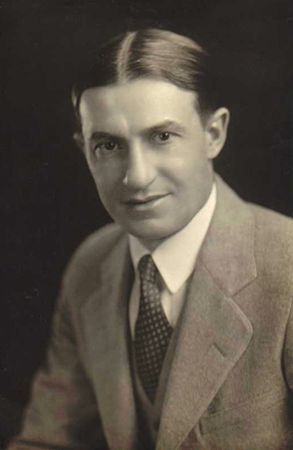
Ed Manley
Ed Manley
July 14, 2025
The man who coached longer at the University of Illinois than any other person died sixty-three years ago today - July 14, 1962 - at the age of 75. Ed Manley, a native St. Louisan, directed Fighting Illini men’s swimming and diving for 37 years after being hired by George Huff in 1912.
As a young man, Manley was an exceptional swimmer and water polo for the Missouri Athletic Club.
His Illini swimming teams captured Western Conference titles his first two years at Illinois and placed among the top five in the league twenty-four times. He also developed twenty conference champions in the sports of water polo, directing those teams to dual-meet victories nearly 75 percent of the time.
Manley called 1930s performer Chuck Flachmann his greatest single swimmer. Other outstanding Illini athletes he coached included Bill Vosburgh, a member of the 1912 Olympic team; John Lichter, John Griffin and Frank Taylor of the 1915-28 era; Bill O’Brien, who won a national diving championship in the 1920s; John Haulenbeeck, the 1947 Illini captain, and Bob Clemons, a 1950s star.
Manley also was the originator of the intramural sports system at the University of Illinois.
After he retired from Illinois in 1952, Manley and his wife, Cecelia, returned to St. Louis where he became the swimming pro at Westwood Country Club. He also coached at the Clayton and University City pools.
The veteran coach was honored posthumously in 1975 when the university named the historic Huff Gym natatorium the Edwin Manley Memorial Pool.

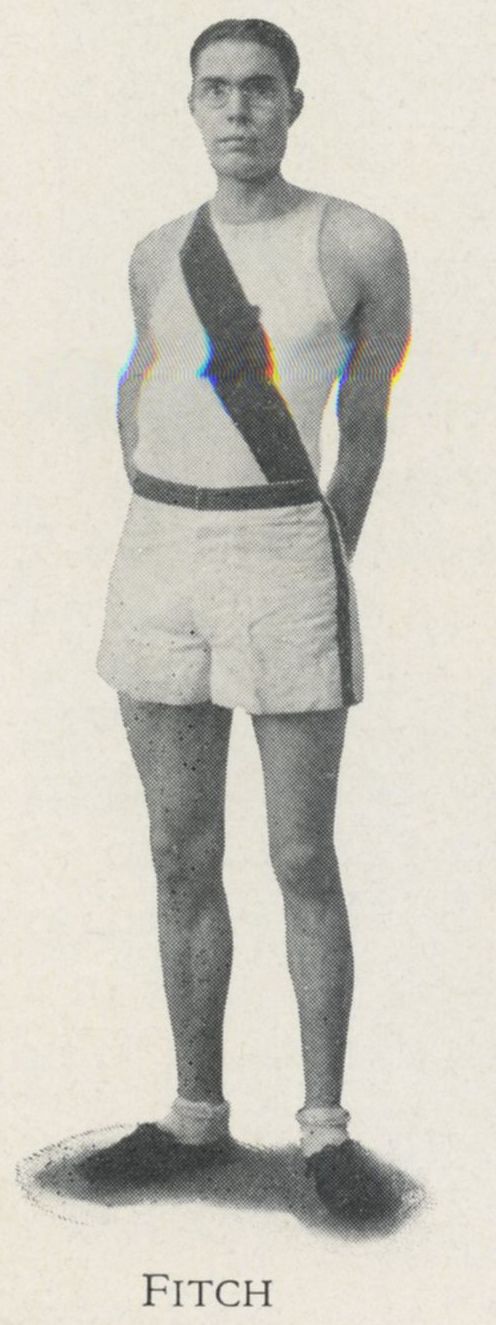
Horatio Fitch
Horatio Fitch
July 11, 2025
One-hundred-one years ago today—July 11, 1924—an event occurred at the Olympic Games in Paris, France that would years later become the basis for the Academy Award-winning movie entitled “Chariots of Fire.”
Few people realize that a Fighting Illini athlete named Horatio Fitch was one of the primary figures in that famous story. Great Britain’s Eric Liddell, whose religious principles cost him what many though would be his greatest chance at Olympic gold in the 100-meter dash, dropped out of that event rather than run on Sunday. Four days later, Liddell competed in the Olympic 400-meter qualifying event, clearly not his strongest race, and he barely qualified.
In the semifinals on July 10, Fitch set a world record in a time of 47.8 seconds, making him a prohibitive favorite to capture the gold in the 400. As the starting gun cracked, Fitch and Liddell burst ahead of their competitors. The pair stayed even with each other the majority of the way around the track, but, at the finish line, Liddell was five meters ahead of Fitch, winning the gold in a record 47.6 seconds.

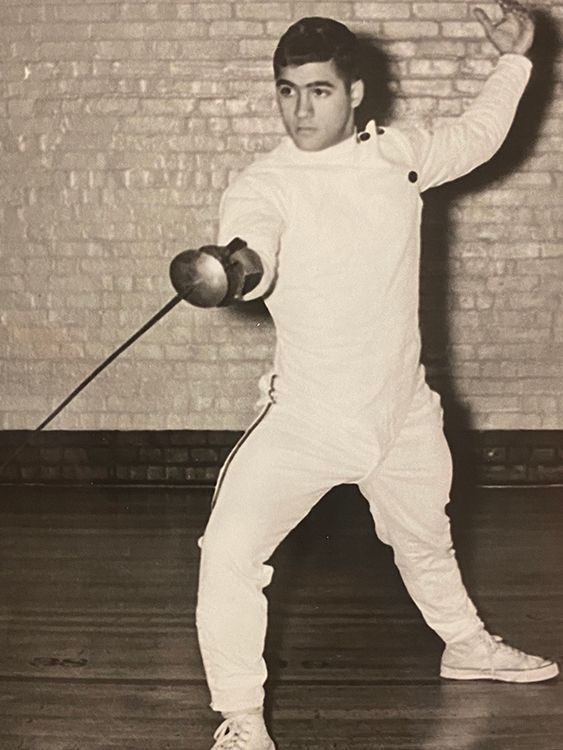
"Pete" Velasco
Herman "Pete" Velasco
July 8, 2025
There were several outstanding Illini athletes during the 1954-55 season—football’s Bobby Mitchell, basketball’s Paul Judson, and track and field’s Willard Thomson to name three—but there was another lesser known star who rose to the very top of his craft in his sport.
At just five-feet-eight and 165 pounds, University of Illinois fencer Herman “Pete” Velasco literally fought his way to the 1955 NCAA foil title. That’s a notable accomplishment for a man who joined Coach Max Garret’s Illini squad as a walk-on.
The son of a Mexican emigrant and a product of Chicago’s Senn High School, Velasco was a four-year member of the north side school’s ROTC program. His exceptional hand-eye coordination, speed and balance made him an ideal candidate to join Senn’s fencing team.
“I thought I was a pretty good baseball player as a 13-14-year-old, but I found out that I wasn’t good enough to play at the high school level,” Velasco said. “Then I discovered fencing. I’ve always like swordsmanship, Zorro and the like. One-on-one sports are those I’m always be drawn to. Team sports are wonderful, but I like to depend on myself.”
Velasco became an exceptional performer for Garret at Illinois. He twice won individual Big Ten foil titles (1954 and ’56), both times helping the Illini to the team championship.
In his junior year of NCAA competition (1955), Velasco defeated 41 other fencers to became foil champ. He had placed third at that meet the year before. As a senior, Velasco placed second. He vividly remembered that final meet at the Naval Academy.
“We had 27 or 28 bouts in the course of 16 hours,” Velasco said.
Following four years in Illinois’ ROTC program and his graduation from the U of I in the Spring of 1956, Velasco received a commission into the United States Army. He went on to 30 years of service in the Army, retiring as a full colonel in 1985.
“I love the military tradition and all that it stands for,” Velasco said.
Following his service, he joined Honeywell International as a chemical salesman. In retirement, he remains active with AARP as a volunteer, helping seniors with their taxes and also teaching driving safety.
In 2024, Velasco was inducted into the Illini Athletics Hall of Fame.
This coming Tuesday (July 8), Velasco will celebrate his 91st birthday with his wife, daughter and grandchildren at his home in North Las Vegas, Nev.


Bob Zuppke
Bob Zuppke
July 2, 2025
One-hundred-forty-six years ago this week - July 2, 1879 - Bob Zuppke was born. A native of Germany and raised in Wisconsin, Zuppke coached Oak Park (Illinois) High School to national championships in 1911 and 1912 before coming to Champaign-Urbana to coach the University of Illinois football squad in 1913.
Bob Zuppke’s career, by the numbers:
• 2 Total number of losses during his first three seasons at U of I (16-2-3 record)
• 4 National championship teams he coached at Illinois (1914, ‘19, ‘23 and ‘27)
• 7 Big Ten titles garnered by Illinois under Zuppke
• 29 Number of seasons he coached football at U of I
• 77 Jersey number of his most famous player, Red Grange
• 78 Zuppke’s age when he died in 1957
• 81 Number of defensive shutouts his Illini teams posted
•131 Total victories, his team’s winning percentage was .611
•1,500 Number of dollars he earned in his first season at Illinois
•1951 Year when Zuppke was elected to the College Football Hall of Fame
•1966 Year when Memorial Stadium’s playing field was named in Zuppke’s honor

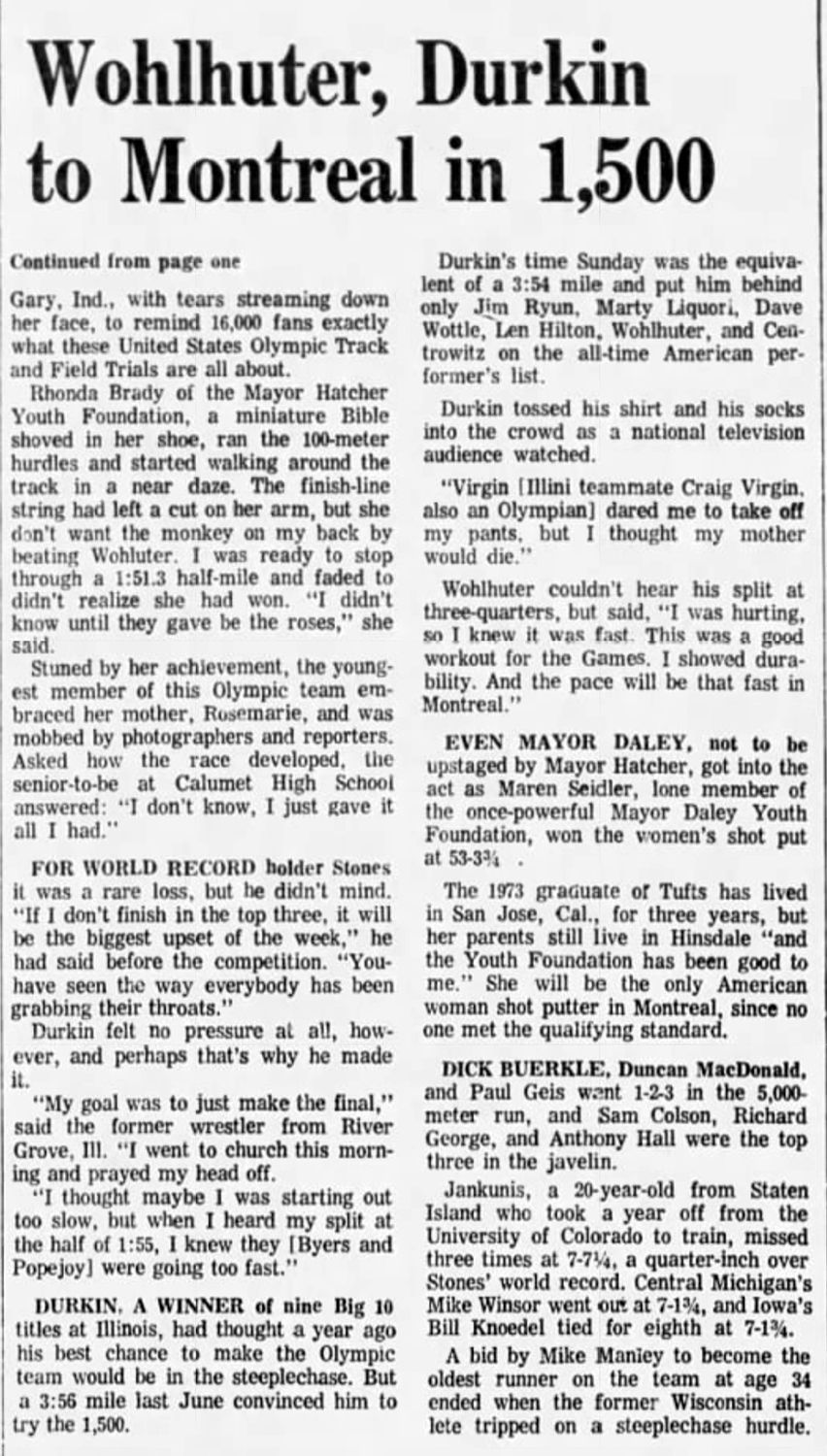
Mike Durkin
Mike Durkin
June 27, 2025
Forty-nine years ago today - June 27, 1976 - former Fighting Illini track and field star Mike Durkin qualified for the 1976 United States Olympic Team by running the fastest 1,500-meter race of his life, finishing third in a time of 3:36.72 to Rick Wohlhuter and Matt Centrowicz.
Durkin’s time bettered his previous best of 3:40.3 and ranked seventh on the all-time American list in the 1,500. His race was equivalent to a 3:54 mile.
Durkin won nine Big Ten titles in five different events: the 880, the 1,000, the mile, the two-mile and the steeplechase. Only Jesse Owens ever won Big Ten titles in as many different events.
On June 26 2025, Durkin was selected as a member of the University of Illinois' Athletics Hall of Fame.

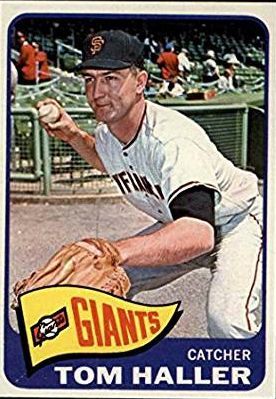
Tom Haller
Tom Haller
June 23, 2025
Today (June 23) would have been former Fighting Illini three-sport athlete and longtime major leaguer Tom Haller 88th birthday. He passed in 2004.
Besides baseball, the former Lockport High School star lettered for Illinois in football and basketball, earning four total varsity monograms.
Haller’s career, by the numbers:
3 Haller’s statistical ranking among Big Ten quarterbacks in 1957
12 Number of seasons he played Major League Baseball
16 Number of Illini basketball game in which Haller played and number of points he scored in 1957
134 Total home runs he hit in majors with San Francisco, Los Angeles and Detroit
.214 Haller’s 1957 UI batting average in conference play
.257 His career batting average through 1,294 big league games
.286 Haller’s 1962 World Series batting average vs. Yankees
542 Yards Haller threw for in UI’s seven conference games in ’57 (3 TDs)
.991 His 1957 fielding percentage as the Illini first baseman (one error in 113 chances)

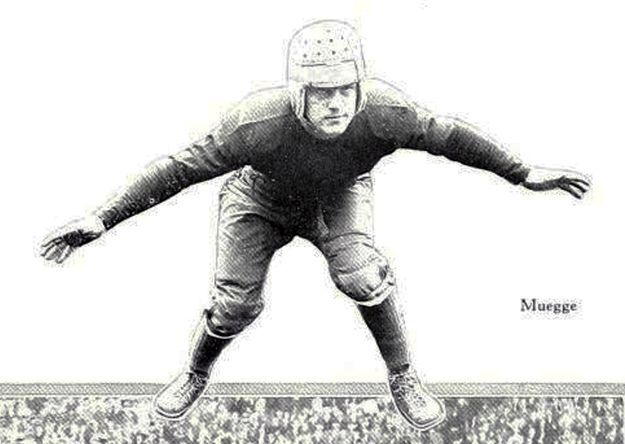
Lou Muegge
Lou Muegge
June 20, 2025
A former football and wrestling letter winner, University of Illinois athlete and graduate Louis Muegge gained his greatest fame as a successful high school in Cape Girardeau, Mo.
Born 121 years ago today in Medford, Wis., Muegge was the son of an Evangelical Lutheran minister named Julius Muegge. Consequently, he spent his childhood in several sites around the Midwest, including Holland, Iowa and Lena, Ill. Louis was a star athlete at Sparta Township High School.
As a sophomore for Coach Bob Zuppke’s 1925 Illini, Muegge played guard and tackle, opening running paths for senior running back Red Grange. He was injured as a junior, but returned in 1927 for his senior year, a season that saw Illinois capture both the Big Ten and National Championships.
Muegge studied in UI’s unique physical education and athletic coaching school, a curriculum established by athletic director George Huff. He was a member of Illinois’ 1928 class.
Muegge was immediately offered the coaching job at Cape Girardeau’s Central High School, tutoring the Tigers for three seasons. His 1929 team was undefeated and unscored on. He departed Missouri to take a job in Pennsylvania for three years, but returned to the Cape and completed 21 more seasons. Muegge eventually became the Tigers’ basketball coach as well, qualifying seven time for the state tournament, winning third place in 1942 and the state title in 1954. He wound up his prep hoops career with a record of 361 victories and 144 losses. Muegge also coached baseball, winning six conference titles and taking first in state play once.
A heart attack claimed Muegge’s life in 1955 at the age of 51. His pall bearers were members of his ’54 Cape Girardeau basketball state champs.
Upon his death, a St. Louis Globe-Democrat tribute called Muegge “one of the finest men in the business.”
“Lou Muegge had the respect and the friendship of every coach and every official with whom he came in contact. His teams, in their performance, not only were always excellent and well coached but showed the good sportsmanship that only a Lou Muegge could teach.”
Lou Muegge Field at Cape Girardeau’s Junior High School is named in his honor.

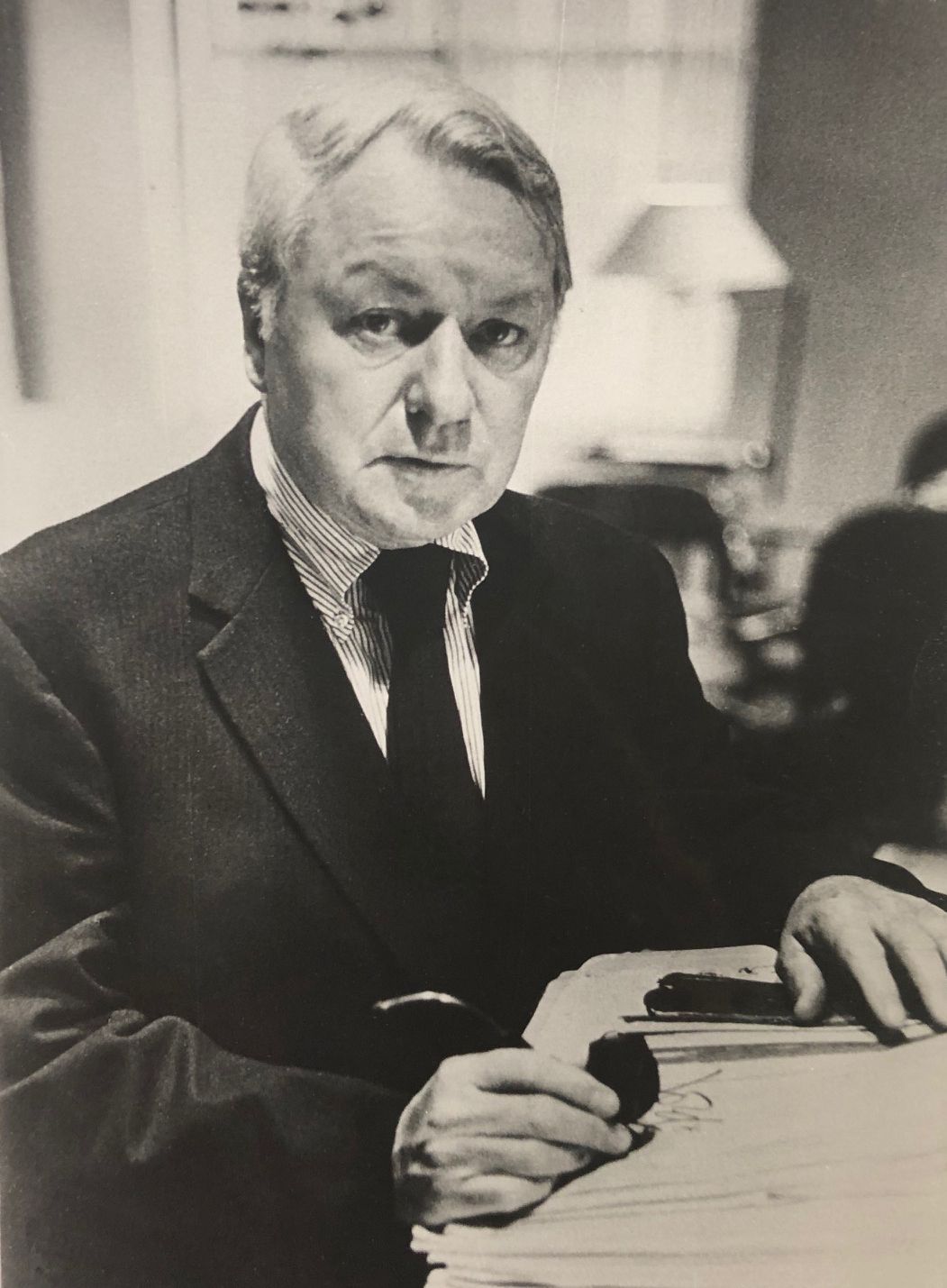
James "Scotty" Reston
James "Scotty" Reston
June 16, 2025
Pulitzer Prize-winning journalist James B. “Scotty” Reston is arguably one of the University of Illinois’s most influential alumni (1932), but it’s largely unknown that he was a two-sport letter winner for the Fighting Illini.
Born in Scotland, Reston’s family immigrated to the United States when he was 10 years old. The family soon settled in Dayton, Ohio, and Reston became a talented golfer, winning medalist honors at the Ohio state high school championship meet. He played both varsity golf and soccer as a student-athlete at the University of Illinois, winning five total monograms, and served as a student assistant in UI’s sports information office and as a golf correspondent for the Champaign News-Gazette.
Following brief stints in public relations with Ohio State University and the Cincinnati Reds, Reston began his legendary career as a journalist.
A chronological history of Reston’s life:
• November 3, 1909: James Barrett Reston was born in Clydebank Scotland.
• September 28, 1920: On board the SS Mobile, he, his mother and his sister arrived at Ellis Island in New York City, eventually joining his father in Dayton.
• 1929: Reston earned his initial varsity letter in soccer for the Illini. He’d also letter in that sport in 1930 and ’31.
• 1932: He served as captain of UI’s golf team, also lettering in ’31. After graduating, Reston began his career as a reporter for the Springfield (Ohio) Daily News.
• 1933: He became sports publicity director at Ohio State University.
• 1934: Following a brief term as press agent for the Cincinnati Reds, Reston began a five-year stint as a reporter for the Associated Press.
• December 24, 1935: He married fellow UI alum Sally Fulton.
• 1939: Joined the staff of the New York Times, first as a sports reporter, then covered England’s war with Germany from the London bureau.
• 1942: Reston established the U.S. Office of War Information in London, rejoining the Times in 1945.
• 1945: He won his first of two Pulitzer Prizes for a series that detailed the establishment of the United Nations.
• 1953: He was assigned to Washington D.C. as the Times national correspondent.
• 1957: A second Pulitzer was awarded to Reston for his coverage of Dwight Eisenhower’s presidential campaign.
• 1968: He became executive editor of the New York Times and later served as a vice president.
• 1970: Reston helped create journalism’s first Op-Ed page.
• 1986: He won both the Medal of Liberty and the Presidential Medal of Freedom.
• August 2, 1987: He wrote his final column for the Times.
• 1991: Reston authored his fifth book, a memoir entitled “Deadline”.
• 1992: He was scheduled to give UI’s Commencement address, but later declined because of health issues.
• December 6, 1995: Reston died at the age of 86 following a long bout with cancer.

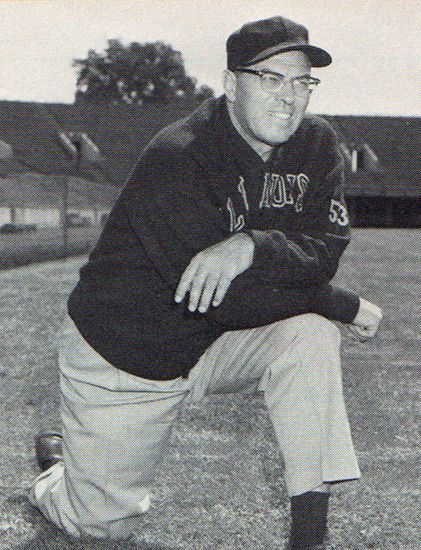
Ray Eliot
Ray Eliot
June 13, 2025
Two of the most legendary Fighting Illini of all-time - Red Grange (1903) and Ray Eliot 1905 - were born on this date, June 6th.
Eliot, affectionately known as “Mr. Illini”, replaced Grange’s coach--Bob Zuppke--as head of the Illinois football program. Born as Raymond Nusspickle, Eliot coached the Illini from 1942-59, compiling an overall record of 83 wins, 73 losses and 11 ties.
Other Ray Eliot facts:
• Only Zuppke, who coached the Illini for 29 years, served longer among UI head football coaches than Eliot (18 years).
• Eliot produced Big Ten championships in 1946, 1951 and 1953. His teams claimed Rose Bowl victories in 1947 (over UCLA, 45-14) and in 1952 (over Stanford, 40-7). Michigan State, the Big Ten co-champion with Illinois, in 1953, was chosen to represent the Conference in the ‘54 Rose Bowl.
• Eliot coached the University of Illinois’ ice hockey team from 1938-39.
• He served as UI’s associate athletic director from 1960 until his retirement in 1973, and, for a short time in 1979, was called upon to serve as the school’s interim athletic director.
• Eliot was a dynamic speaker who was best known for his inspiring speech “The Proper State of Mind.” His motto was “Anything you think you can do, you can do.”
• He died on February 24, 1980, at the age of 75.


Al Brosky
Amazing Illini Records led by Brosky
June 9, 2025
Perhaps the most incredible record in Fighting Illini sports history belongs to a man that was born 97 years ago today. What Al Brosky achieved as a defensive back in the 1950s is one that has no comparison. His NCAA record of notching a pass interception in fifteen consecutive games is significantly more impressive in that opposing quarterbacks purposely threw their passes away from him. In twenty-eight collegiate games, Brosky picked off a national-record thirty interceptions, a mark that still stands 73 years later.
Other amazing Illini records, in chronological order:
• Coach Arthur Hall’s 1910 Illinois football team recorded a perfect 7-0 record. More amazingly, that squad outscored its seven opponents, 89-0. It’s a feat duplicated by only nineteen others teams in the history of college football.
• George Huff’s 1910 Illini baseball squad had a perfect 14-0 record. John Buzick, the team’s premier pitcher, completed all ten of the games he started.
• From February 21, 1914, through February 9, 1916, UI’s basketball team won twenty-five games in a row, including seventeen consecutive conference victories. The average score during this span of games was Illinois 27.5, opponents 13.8.
• On November 5, 1916, Illinois handed Minnesota’s so-called “perfect team” its only loss of the season, 14-9. In the Gophers’ other six games that year, UM outscored its foes, 339-14.
• In the dedication game of Illinois’s Memorial Stadium—October 18, 1924—Bob Zuppke’s Illini defeated mighty Michigan, 39-14. UI’s superstar running back, Red Grange, scored touchdowns the first four times he touched the ball, tallying on runs of ninety-five, sixty-seven, fifty-six and forty-four yards.
• Athletic Director Doug Mills’ teams dominated Big Ten championships from the 1950-51 season through the 1953-54 campaign, winning twenty-three of the conference’s forty-eight titles.
• On Nov. 8, 1980, Illini quarterback Dave Wilson carved up Ohio State’s vaunted pass defense, completing 43-of-69 passes, tossing for 621 yards, and completing six touchdown passes. Thirty-nine years later, Wilson’s 621-yard day remains as the Big Ten single-game record.
• As a junior in 1987, Illini baseball’s Darrin Fletcher batted a stunning .497. His slugging percentage that season was .913. Both are all-time Illinois records.
• On September 22, 1990, Illinois’s Howard Griffith became the first player in NCAA Division IA football to score eight touchdowns in a single game. Griffith scored three touchdowns [51, 7, 41] on consecutive carries and scored four touchdowns in the third quarter.
• Beginning with a season-opening win against Ball State on January 26, 2003, and continuing through an NCAA quarterfinal match versus Vanderbilt on March 25, 2004, Illinois tennis assembled sixty-four consecutive dual-meet victories.
• Illinois’ 2004-05 men’s basketball squad began the season with a perfect 29-0 record. Included among the highlights were victories over seven nationally ranked opponents, including No. 1 Wake Forest.
• Including Adrien Dumont De Chassart in 2019, Illinois men’s golfers won nine consecutive medalist awards at the Big Ten Championship from 2011 to '19.

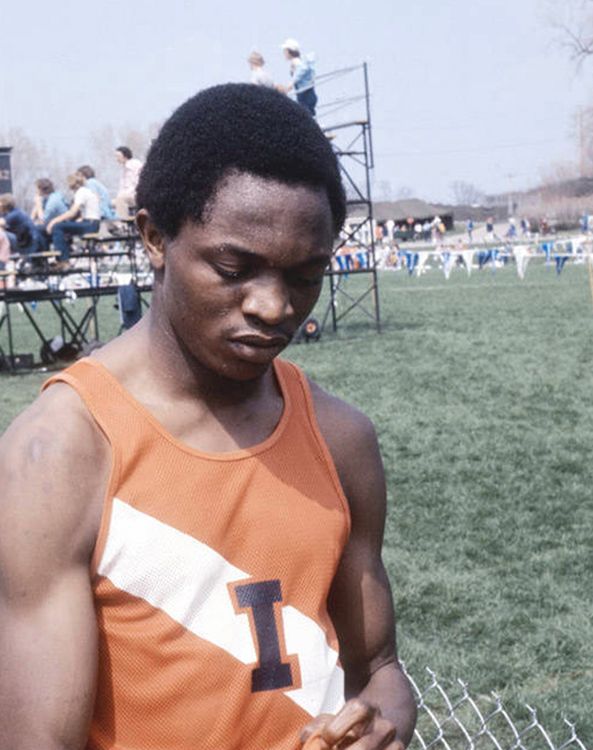
Charlton Ehizuelen
Ehizuelen captures NCAA title
June 6, 2025
Fifty years ago today - June 6, 1975 - University of Illinois long jumper Charlton Ehizuelen captured the individual title at the NCAA Outdoor Track and Field Championships in Provo, Utah. The Fighting Illini sophomore from Nigeria leaped a meet record 26 feet, 11 inches. He became the first UI long jumper since Henry Aihara in 1945 to win the NCAA title in that event.
A list of Big Ten long jumpers who preceded Ehizuelen in capturing an NCAA outdoor title:
Athlete, School, Title-Winning Year(s)
Gaylord Stinchcomb, Ohio State, 1921
DeHart Hubbard, Michigan, 1923, ‘25
Edward Gordon, Iowa, 1929, ‘30, ‘31
John Brooks, Chicago, 1933
Jesse Owens, Ohio State, 1935, ‘36
Dallas Dupre, Ohio State, 1942
Ralph Tyler, Ohio State, 1944
Henry Aihara, Illinois, 1945
Fred Johnson, Michigan State, 1949
Greg Bell, Indiana, 1956, ‘57
Charlton Ehizuelen, Illinois, 1975

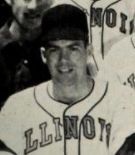
Max Hooper
Max Hooper
May 30, 2025
Seventy-three years ago today - May 30, 1952 - Illinois’ Max Hooper drove in the winning run in the last half of the 11th inning as the Fighting Illini baseball team downed Ohio University, 5-4. A second victory over the Bobcats the next day sent the Illini to a District 4 series against Western Michigan, eventually won by the Broncos.
As a child, Hooper dreamed of being a major league pitcher. At six-feet-five-inches tall, was a hard-throwing right-hander for Mount Vernon High School, good enough to be offered a $500 contract from the New York Giants as a prep junior.
Instead, Hooper opted to attend the University of Illinois, despite intense recruiting by Kentucky’s legendary Adolph Rupp. A day with Cleveland Indians player-manager Lou Boudreau at Comiskey Park in June of 1950 persuaded him to come to Champaign-Urbana.
Hooper was also a talented basketball player, leading the Rams to a pair of state titles, leading all players in scoring. At the U of I, Hooper was a starter for the 1953 and ’54 hoopsters, playing alongside teammates Johnny “Red” Kerr, Clive Follmer, Irv Bemoras, Paul Judson, Jim Wright and others. During those two seasons, the Illini compiled a cumulative record of 35 victories in 44 games, ranking 13th nationally in 1953 and 19th in ’54.
Hooper died in 2020 at the age of 88.

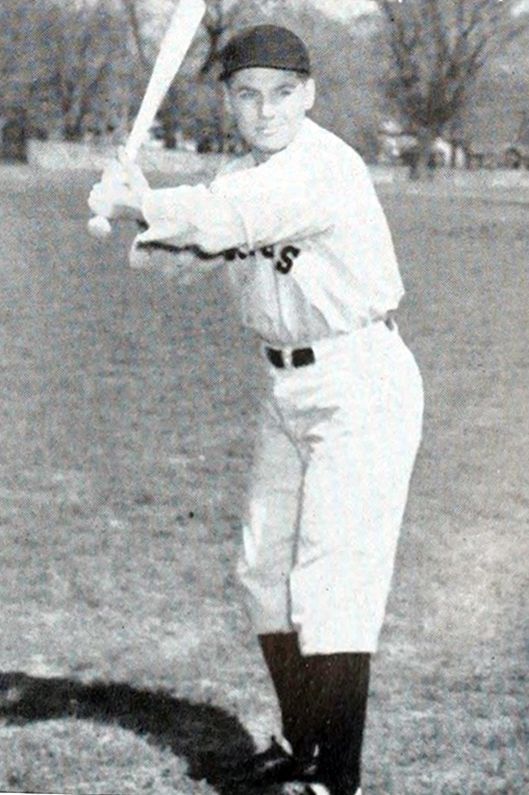
Lee Eilbracht
Lee Eilbracht
May 26, 2025
Seventy-three years ago today - May 26, 2002 - Lee Eilbracht was named permanent baseball coach by the University of Illinois’ Board of Trustees. This came on the heels of the Fighting Illini’s Big Ten co-championship with Michigan. Eilbracht’s career, by the numbers:
2 Number of times Eilbracht was named Illinois’ MVP as a player (1946 & 1947)
3 Number of Eilbracht’s Illini baseball players who earned UI’s Athlete of the Year (Clive Follmer in 1953, Em Lindbeck in 1956, and Doug Mills in 1962)
4 Number of Big Ten championships (1952, ’53, ’62, ’63)
12 First-team All-Big Ten selections who played for Eilbracht
27 Number of years Eilbracht served as Illinois’ head coach
.330 Eilbracht’s career batting average for the Illini
.484 His batting average in Big Ten play during the 1946 season
519 Total victories in 27 seasons as skipper

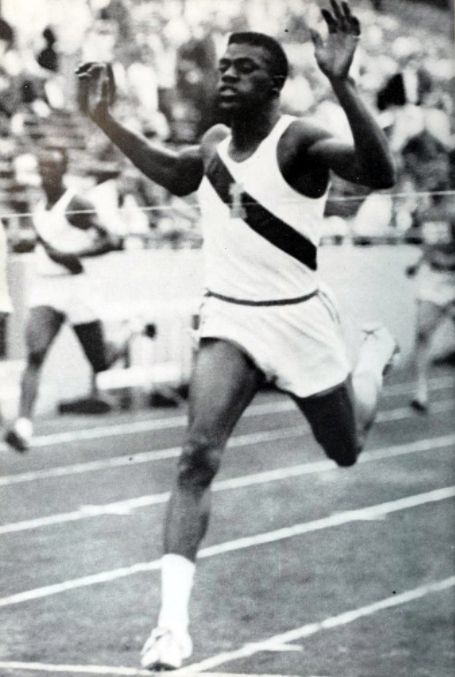
George Kerr
George Kerr
May 23, 2025
Sixty-six years ago today - May 23, 1959 - Fighting Illini sprinter George Kerr set a conference record in the 880-yard run (1:50.1) at the 59th annual Big Ten Outdoor Track and Field Championships in Ann Arbor.
Kerr’s mile relay quartet, including John Lattimore, Ted Beastall and Del Coleman, helped Illinois wrap up the team title.
One year later at the 1960 NCAA Championships, Kerr set a meet record of 1:46.1 in the 800-meter race.
A two-time Olympian, he competed for the British West Indies at the 1960 Games in Rome where he won the 800-meters bronze medal, then anchored the gold-medal-winning 4x400 relay team.
Representing Jamaica at the 1964 Olympic Games in Tokyo, Kerr finished fourth at 800 meters and with the 4x400 relay squad. Just a day earlier, he broke the 800 meters Olympic record with his fastest-ever time (1:45.9).
He also competed at two Commonwealth Games, winning gold, silver and bronze medals.
George Ezekial Kerr, born October 16, 1937, stood five-feet-11-inches and weighed 154 pounds. A main street in Portmore, Jamaica was named in his honor in October, 2008. He died on June 15, 2012.

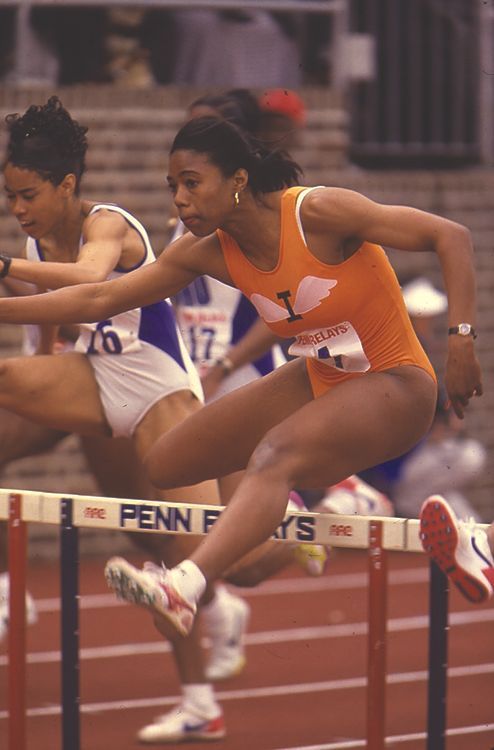
Tonja Buford
This Date in Illini History
May 19, 2025
Ten years ago today - May 19, 2015 - the Fighting Illini swept Big Ten baseball’s top three individual awards as the Conference named its 2015 honors. Dan Hartleb, who led Illinois to its first Big Ten regular-season championship since 2011, was named Coach of the Year. Senior first baseman David Kerian and junior left-hander Tyler Jay were respective honorees as Player and Pitcher of the Year. Besides Kerian and Jay, catcher Jason Goldstein, shortstop Adam Walton and outfielder Casey Fletcher earned first-team All-Big Ten acclaim.
Other memorable moments on this date in Illinois athletics history:
May 19, 1923: Clifford “Stonewall” Jackson scattered three hits on the mound and slammed a home run in his final Illini appearance at home as Illinois topped Wisconsin, 7-1.
May 19, 1934: John Duffner clouted a home run over the left-field fence with two outs in the ninth inning, giving Illinois a 7-6 victory over Michigan in Urbana. Duffner also tripled and singled twice.
May 19, 1951: Mount Vernon all-stater Walter Moore announced that he would attend Illinois, thus becoming the first African-American player in Illini basketball history.
May 19, 1962: Senior golfer Mike Toliuszis fired rounds of 75, 69, 71 and 73 and earned medalist honors at the 43rd annual Big Ten Championships in Champaign.
May 19, 1985: The 4x100-meter relay team of Darryl Usher, Steve Tyson, Tim Simon and Lester Washington established UI and Big Ten records with a :39.65 time at the Big Ten meet in Evanston.
May 19, 1990: Mark Dalesandro was named Big Ten baseball’s Player of the Year. He finished his Illini career that season with a .326 batting average.
May 19, 1991: Sophomore Tonja Buford (pictured) successfully defended her Big Ten outdoor titles in the 100 hurdles and 4x100 and 4x400 relay events. She also added a first-place finish in the 400 hurdles and placed second in the 100 dash.
May 19, 1995: Illinois middle-distance star Marko Koers was named Athlete of the Championships at the Big Ten meet, winning at both 800 and 1,500 meters.

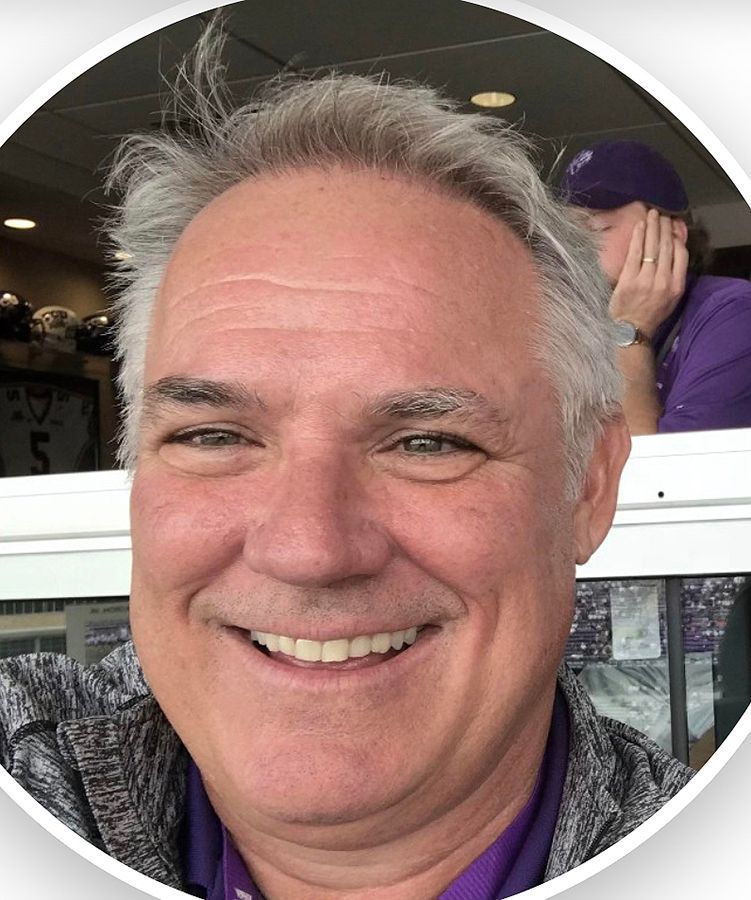
Mike Giddings
Mike Giddings
May 16, 2025
Mike Giddings, a former Illini football player who served as 1980’s placekicker Chris White’s holder, celebrates his 63rd birthday on Friday (May 16). The two-time Illinois letter winner’s life story in football has blossomed well beyond those moments of taking the snap and placing the ball down for his childhood friend’s placekicks.
As the owner and President at Proscout Inc., Giddings now holds a position of influence as one of NFL teams’ key resources for choosing draft picks.
Giddings played sparingly at Illinois, first as a wide receiver, then as a defensive back. He finally settled into his senior-season role as the holder for the kicking unit, highlighted by Chris White’s game-winning field goal against Ohio State in 1985.
After graduating in the Spring of 1986, then Illini coach Mike White, a longtime close friend of Giddings’ father, Mike Sr., hired Mike Jr. as the team’s assistant recruiting coordinator. Working under Rick George, they helped the Illini coaching staff bring in a highly talented 1986 freshman class that included future standouts Mel Agee, Moe Gardner, Chris Green, Frank Hartley, Henry Jones, Curt Lovelace, Quintin Parker and Shawn Wax.
Meanwhile, as young Mike was contemplating which direction to take his career, his dad was building Proscout back in his home state of California, a player evaluation business he originated in 1977.
“Growing up as a coach’s kid, I knew I didn’t want to be a coach,” Giddings said. “That was not the lifestyle I wanted. I had opportunities. I’ve even said no to GM (general manager) jobs in the NFL. That’s just not what I want to do.”
Upon departing Illinois in 1987, Mike Jr. finally fulfilled his father’s wishes and joined the family business.
Giddings Sr. devised the color code grading system that’s now commonplace among NFL clubs.
“Our company started out as evaluating the NFL players and upgrading the bottom of their rosters, Mike Jr. explained. “Blue and Red players are those who will win for you. Purple are players you can win with. There’s a big difference.”
Orange, Green and Yellow tags are Giddings’ lesser rankings, i.e. back-up and special teams players.
Giddings rarely conducts any in-person evaluations.
“The eye in the sky doesn’t lie,” he said. “You need the tape.”
Over the years, Giddings has developed a data-based formula called Axiom 1.
“If a team fills six of its top eight off-season needs, has ten or more Blue players, and has a strike-to-Blue ratio of two-to-one, I guarantee the team will make the playoffs,” he explained. “That’s my sales pitch. A strike is an analytical formula dealing with production, age and injury.”
Giddings digs deep into injuries, production and age, and says that his Axiom 1 formula proves itself to be accurate time after time.
“Our injury grade is like a school report card,” Giddings began. “Everyone comes into the league as a ‘C’ player. If you play 16 games and don’t miss any games due to injury or suspension for two years, you go to ‘B’; three years in a row you go to ‘A’. If you miss one game in a season, we take you to ‘C minus‘. If you miss two or more games in a season, we take you to ‘D’. Missing two or more games for two years in a row takes you to ‘D minus’. And missing two games or more for three straight seasons takes you to a failing grade, an ‘F’.
“If a player rates ‘F’ in our injury category, what are the odds that he’s going to rate Purple or better? My studies say that it’s less than three percent. When you look at ‘F’ injury in free agency for the last five years, there’s been nearly three-quarters of a billion dollars spent on guaranteed money on ‘F’ injury players who haven’t graded Blue, Red or Purple.
“So besides evaluation, you have to understand the money aspect,” he said. “Because, in the NFL, you don’t get fired for what you call on third-and-six, you get fired for mis-spending the owner’s money.
“So, instead of just saying ‘I think this guy can play’, I factor in value and why I think he can play or why I don’t think he plays if he’s got one of those strikes.”
After the season is over, Giddings develops each team’s needs, identifies the players with strikes, goes through free agency to fill its needs, uses the draft to develop the team’s Blue-rated players, then employs his Axiom 1 formula.
Over the years, Giddings has worked with 33 Super Bowl teams and 12 Hall of Fame coaches, owners and general managers. He only deals with the decision makers.
“It doesn’t do me any good to always be agreeable,” he said from his home office in Park City, Utah. “The decision makers, especially the good ones, want to hear what I think. I’ve got to be right more than I’m wrong or I’m out of business.”

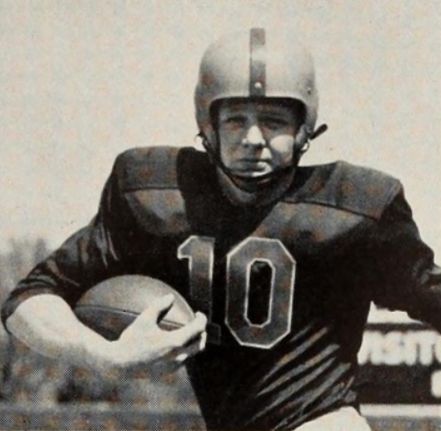
Hiles Stout
Hiles Stout
May 10, 2025
Today, Illini Legends, Lists & Lore acknowledges the 90th anniversary of the birth of Hiles Stout, a six-time Fighting Illini letter winner in football and basketball.
Born May 10, 1935, the former Peoria Central High School star was a standout athlete for both Ray Eliot and Harry Combes in the mid 1950s.
Very few prep performers in the state of Illinois were as acclaimed as the 6-foot-4-inch, 205-pounder. He played quarterback in football, center in basketball, and first base in baseball for the Lions. Stout’s 1,546 career points were an area basketball record. That included a Peoria single-game school record of 48 points against Spalding. Stout ultimately chose to attend the University of Illinois over Michigan, Notre Dame, Miami, Georgia and Kansas.
In 1954 and ’55, for Eliot’s Illini football team, Stout served as the back-up quarterback to Em Lindbeck. As a senior in ’56, he led all Illini QBs with 278 yards passing, boosting his career total to 1,042 yards.
On the hardcourt, Stout primarily served as Combes’ most prominent reserve player in Illini lineups that featured George Bon Salle, Paul Judson, Bill Ridley, Don Ohl and Harv Schmidt. In 59 career appearances, Stout averaged 8.1 points per game.
Upon graduating in 1957, Stout first worked for Caterpillar as a sales representative, then served for several years in the U.S. Marine Corps. He then helped form the Hecht-Stout Insurance Agency in Peoria.
Stout co-founded and chaired Peoria’s St. Jude Tennis Classic, raising more than $1 million over 26 years with that charity.
He was inducted into the Illinois Basketball Coaches Association Hall of Fame in 1974, then the Greater Peoria Sports Hall of Fame in 1983.
Stout died in 2016 at the age of 81.

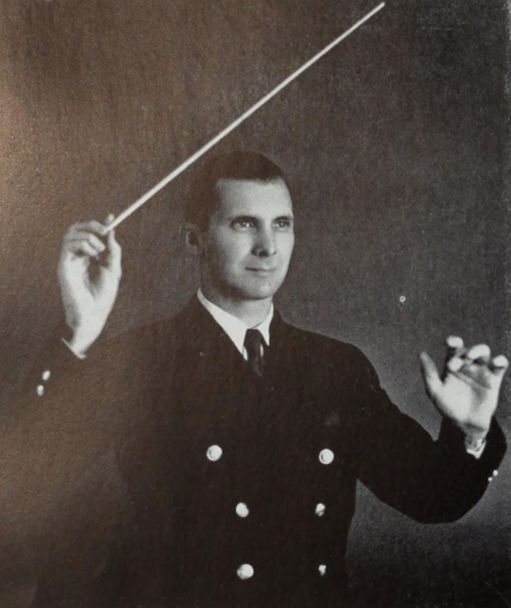
Everett Kisinger
Everett Kisinger
May 5, 2025
Today marks the 113th anniversary of the birth of Everett D. Kisinger, associate director of bands and director of the Marching Illini from 1948 to 1976.
Working hand-in-hand with director of bands Mark H. Hindsley, they developed the pageantry of the football halftime show in pre-computer times through a system that would be imitated by nearly every college marching band around the country. Using a minimalist model to represent Memorial Stadium, Kisinger arranged small screws representing each bandsman on a scale gridiron and checked the fans' viewing angle by sighting down a model of the stands. From the resulting sketch, each bandsman marked his music so he could move to the proper spot on the field without a special signal.
In addition to his marching band responsibilities, Kisinger conducted the university's First and Second Regimental Bands as well as the basketball band. He led the Marching Illini during their 1952 and 1965 appearances at the Rose Bowl parade as well as their participation in the second presidential inaugural parade in Washington, D.C., for Dwight Eisenhower in 1957.
During his tenure at the UI, Kisinger also initiated the university's Alumni Band.
Born in Battle Creek, Mich., in 1912, the Kisinger family moved to Muskegon when he was a teenager, and he graduated from Muskegon High School in 1931. While in high school, he attended the National Music Camp at Interlochen and played under the baton of John Philip Sousa.
Kisinger attended the University of Michigan, where he earned his bachelor's and master's degrees. A student of Michigan band director William D. Revelli, Kisinger's career as director of music included stops in Grandville, Grand Haven and Holland, Mich. Serving as director of the Instrumental Music Department for Holland Public Schools, he also served as chairman of music event for the Holland Tulip Festival from 1946 to 1948.
Kisinger's son, Bill, followed in his father's footsteps, serving as associate director of Purdue University's "All-American" Marching Band.
After retiring in 1976, Everett moved to Colorado Springs, Colo.
He died Jan. 14, 1990, at age 77.


Lowell Hamilton
Lowell Hamilton
May 3, 2025
Happy 59th Birthday to former Flying Illini starter Lowell Hamilton. From 1985-86 through 1988-89, his Illini basketball teams compiled an overall record of 99-33 and 50-22 in Big Ten contests. Hamilton’s ’88-89 Illini made it to the Final Four with a 31-5 record.
Ranked as the nation’s top high school player by Street & Smith Magazine, Hamilton struggled as an Illini freshman. Averaging just 3.7 points and 1.7 rebounds, he came off the bench in each of the 24 games in which he appeared in ’85-86.
Hamilton started 22 of Illinois’s 31 games as a sophomore, averaging 10.8 points and 3.9 rebounds.
As a junior, he split time with Jens Kujawa at center, starting only six of the 33 contests in which he played.
Hamilton enjoyed his greatest success as a senior, averaging 13.6 points, ranking behind Nick Anderson (18.0), Kenny Battle (16.6) and Kendall Gill (15.4). Co-captaining the Flying Illini with Battle, he scored at least 10 points in 27 of his team’s 36 games that year.
Today, he’s a physical education teacher and the assistant athletics director at Tallulah Falls High School in northeast Georgia. Hamilton and his wife, Adrianna, have three children.
Lowell Hamilton’s career, by the numbers:
1 Number of three-pointers he scored at Illinois (of three career attempts).
8 Hamilton was one of eight children in his family.
9 Seasons he played professionally overseas (Turkey, Greece and Israel).
11.6 His points per game average in UI’s five 1989 NCAA Tournament games.
12 Top single-game rebounds performance (at Indiana, 3/4/89).
13.9 His scoring average as a senior at Illini home games.
20 Hamilton is one of only 20 Illini players who averaged at least 10 points per game during a four-year career.
24 His single-game high-point game (vs. LSU, vs. Georgia Tech and vs. Iowa, all during the 1988-89 season.
45 Jersey number at Illinois.
.534 His shooting percentage from the field as an Illini.
.694 Illinois basketball’s winning percentage in Big Ten games during his four seasons.
.892 Providence St. Mel High School’s winning percentage during Hamilton’s four years as a starter.
1,241 Total points he scored during his Illini career, 29th on UI’s list of top point producers.
1985 Year he was selected as the Chicago Sun Times Class A Player of the Year.

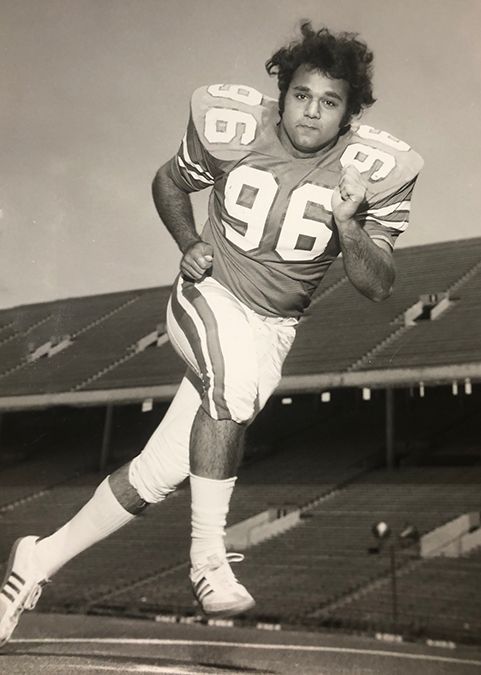
John DiFeliciantonio
John DiFeliciantonio
Apr. 21, 2025
Before Corey Liuget, Whitney Mercilus and Dawuane Smoot in recent years—even before Don Thorp, Moe Gardner and Simeon Rice in the 1980s and ‘90s—Big Ten quarterbacks feared a 6-3, 240-pound Illini tackling machine with a nearly unpronounceable name.
John DiFeliciantonio, a product of Bishop Neumann High School in South Philadelphia, was the man Coach Bob Blackman depended upon to pressure the opponents’ signal callers.
Today - April 21st - he celebrates his 70th birthday.
From 1974 through ‘76, despite incurring a wide assortment of injuries, “Johnny D” made headlines for Illinois from his defensive tackle position. In each of those three seasons, No. 96 recorded double-figure tackles for loss, totaling 32 TFLs for 147 yards in losses for his career.
Teaming with Dean March, Walter Graham and others, DiFeliciantonio racked up nearly 200 tackles during his Illini career, winning second-team All-Big Ten honors after his junior year. As a senior in 1976, he was named Sports Illustrated Defensive Player of the Week for his role in Illinois’s 31-6 upset victory over sixth-rated Missouri. He eventually played in the Blue-Gray All-Star Game, but never played professional football.
As an undergrad, DiFeliciantonio drove a beer truck in Champaign-Urbana during the summer of ’76. However, it was his unusual hobby that grabbed him headlines in newspaper features: potting plants.
“My girl friend went back to Chicago for the summer and she let me take care of her flowers while she was gone,” said the amiable Italian. “She couldn’t take care of ‘em nearly as well as I do.”
Nearly 50 years later, DiFeliciantonio is back in the City of Brotherly Love and his one-time hobby is now his livelihood. After getting his start on the tomato line at Procacci Brothers, he worked himself up to president of the company, building it into one of the nation’s largest wholesalers. Today, he and his wife, Michelle, and three of their four daughters operate the North American Produce Company in southwest Philadelphia. They handle hundreds of varieties of fruits, vegetables and herbs.

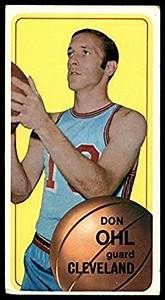
Don Ohl
Don Ohl
Apr. 18, 2025
Former Fighting Illini and Edwardsville High School basketball star Don Ohl would have celebrated his 89th birthday today.
From 1955-56 through 1957-58, Ohl played 66 varsity games for Illinois, averaging 14 points per game, including 19.6 per contest his senior year.
Originally drafted by the Philadelphia Warriors in the second round of the 1958 NBA draft, the 6-3, 190-pound guard scored 11,549 points and appeared in five NBA All-Star Games during his career. Ohl also played for the Detroit Pistons, Baltimore Bullets, and St. Louis Hawks.
Shortly after the 1963-64 campaign, Ohl was involved in an eight-player trade between the Pistons and Bullets. He was sent by the Pistons with Bob Ferry, Bailey Howell, Les Hunter and the draft rights to guard Wally Jones to the Bullets in exchange for Terry Dischinger, Don Kojis and Rod Thorn. Ohl and Howell became mainstays with the Bullets, teaming with all-stars Walt Bellamy and Gus Johnson.
Ohl thrilled fans with his 20-foot jump shot. His shining moment came in the 1965 playoffs, which saw the Bullets eliminate the St. Louis Hawks in four games. In the Western Division finals, Ohl and future Hall of Fame guard Jerry West were locked in a tense shootout that saw West and the Los Angeles Lakers finally prevail in six games, each of which was decided by eights points or fewer. Ohl averaged 26.1 points in 10 games that post-season, still a Bullets/Wizards franchise record.
Midway through the 1967-68 season, the man nicknamed "Waxie" for his crewcut was dealt to St. Louis for future Hall of Fame guard Earl Monroe. Ohl played a couple more years with the Hawks, scored his 10,000th point and retired in 1970.
In 2001, he retired from a career in the bank insurance business to care for his wife, Judy.
Don Ohl died Dec. 2, 2024.

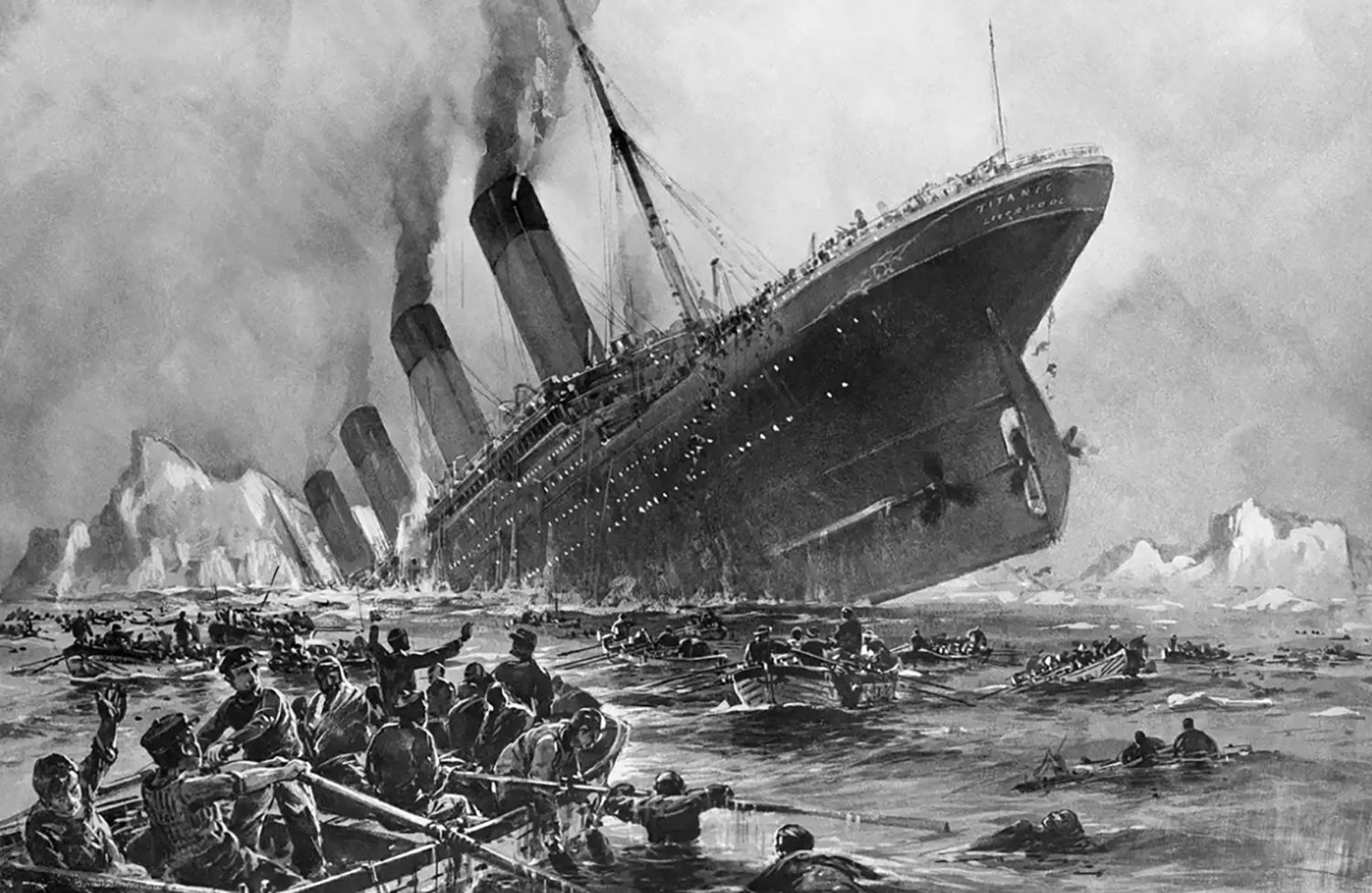
The Titanic
"Titanic" Illini
Apr. 14, 2025
One-hundred-three years ago today, at midnight, the British passenger ship “Titanic” struck an iceberg off the coast of Newfoundland and sank within three hours. Of the 2,224 people aboard, 1,513 died. As a tribute to the anniversary of this historic event, we present our “Titanic Illini”:
* Glen SEAMAN (men’s swimming, 1977-78
* Tom BOATMAN (men’s tennis, 1960-62)
* Ronald SHIPka (fencing, 1958-59)
* Kristi “Ice” BERG (women’s swimming, 1993)
* Thomas HULL (baseball, 1942)
* John ORR (basketball, 1945)
* Joseph ENGLAND (men’s golf, 1960-62)
* Edward Smith* (men’s track, 1983-84)
* Sonya “Icy” WATERS (women’s basketball, 1989-92)
* Julian FISH (men’s track, 1914)
* Jeff “JACK” DAWSON (men’s basketball, 1973-74)
* Jerry ROSE (football, 1968)
*Edward Smith was the name of the captain of the Titanic

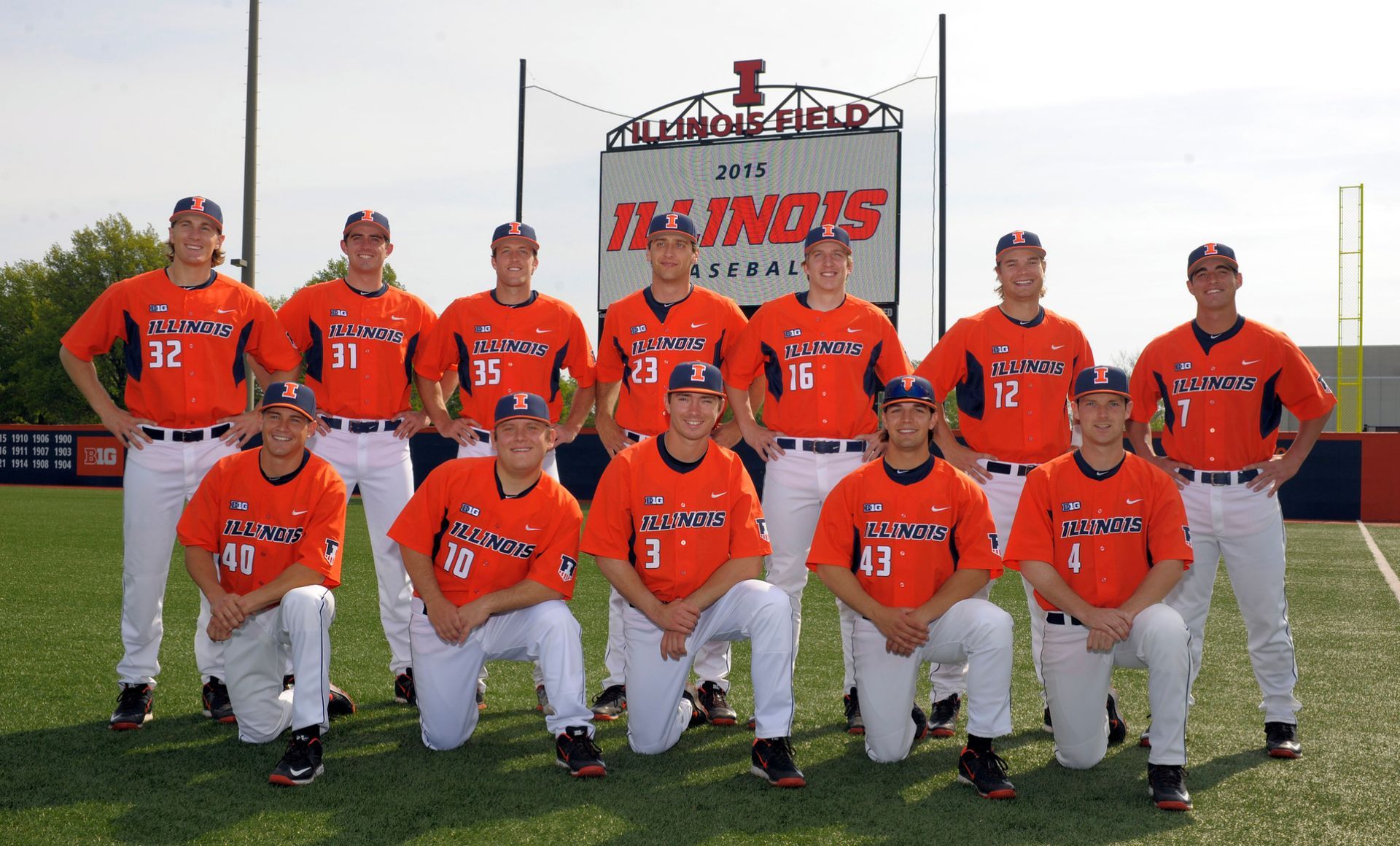
2015 Illini Baseball Seniors
The 2015 Illini Baseball Team
Apr. 9, 2025
Ten years ago this week, the Fighting Illini baseball team swept a weekend series at home against Purdue.
In game one, Illinois struck with five runs in the first and cruised to a 10-5 victory before a crowd of 2,843. Junior Ryan Nagle, who finished a triple short of the cycle, went 3-for-5 with three runs, a home run and two RBI.
The second game’s star was starting pitcher Drasen Johnson, who retired the final 12 Boilermaker hitters he faced, won his fifth decision in seven games.
The Illini won game three in a pitchers’ duel, 2-1. Left-hander Tyler Jay ‘s four strikeouts in four shutout innings helped the Illini notch their first 10-game winning streak since 2002. Illinois ultimately won the Big Ten title with an historic 21-1 record, the best by a league champion in 49 years.
In Illini annals, the 2015 season ranks second in school history in terms of conference winning percentage. A top ten list follows:
Baseball’s Best Big Ten Seasons (min. 10 games, by percentage)
1.000 1910, Coach George Huff (11-0*)
.955 2015, Coach Dan Hartleb (21-1*)
.933 1911, Coach George Huff (14-1*)
.917 1903, Coach George Huff (11-1*)
.909 1921, Coach Carl Lundgren (10-1*)
.900 1934, Coach Carl Lundgren (9-1*)
.900 1937, Coach Wally Roettger (9-1*)
.875 1982, Coach Tom Dedin (14-2**)
.866 1962, Coach Lee Eilbracht (13-2*)
.864 1915, Coach George Huff (9-1-1*)
*Big Ten Champions
**First place, Big Ten West
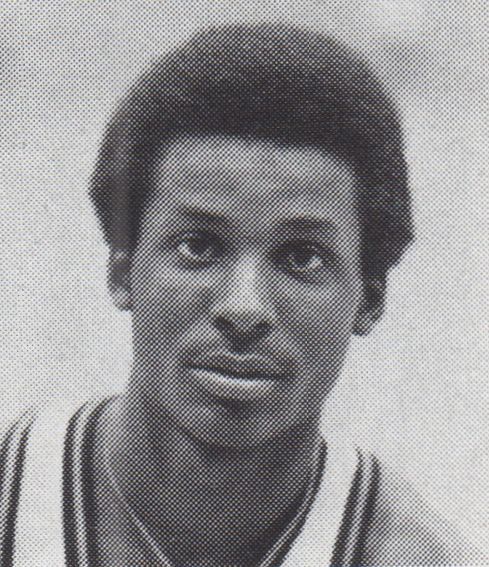
Eddie Johnson
Illini Basketball MVPs
Apr. 4, 2025
Forty-five years ago today - Apr. 7, 1980 - at the 58th Annual Men’s Basketball Banquet, junior forward Eddie Johnson was named Most Valuable Player of the Fighting Illini.
Of the 39 players who preceded him as MVPs, he was only the 15th underclassman to be honored. Johnson’s 610 points during the 1979-80 campaign were the second highest ever by an Illinois player and his 310 rebounds were third highest. He was a repeat MVP the following season (1980-81) as a senior.
Other trivia about Illini men’s basketball MVPs:
• UI’s first official basketball MVP was senior Bob Richmond in 1941.
• Seniors James Griffin and Perry Range were the first to share the award (1982). The prize has been shared just six other times.
• The only time the MVP was given to three different players was in 2005 when juniors Dee Brown and Deron Williams, and senior Luther Head won the honor for UI's 37-2 national runner-up.
• Cory Bradford (1999) and Tracy Abrams (2012) are the only two freshmen to have won MVP awards. Bradford was also the Big Ten Freshman of the Year. Abrams is the last UI MVP who didn’t also lead the team in scoring.
• Neither Andy Kpedi nor Larry Smith, co-MVPs in 1991, won Illinois’s scoring title that season. Andy Kaufmann was UI’s top scorer.
• Andy Phillip was Illini MVP in 1942 and ’43, but did not earn that honor as a senior in 1947 when he returned from service in World War II.
• The first three-time Illini MVP was Dave Downey. He captured the prize 1961, ’62 and ’63. Deon Thomas (1992-93-94) and Kiwane Garris (1995-96-97) are Illinois’s only other players to be honored three years in a row.
• 1984 co-MVP Quinn Richardson (with Bruce Douglas) finished as Illinois’s fifth-leading scorer that season (7.7 ppg).
• Current NBA pro, Meyers Leonard of the Portland Trail Blazers, did not win Illini MVP laurels.
• UI’s 1967 MVP, Jim Dawson, also was the Big Ten MVP. As a team, the Illini tied for seventh in the Big Ten standings.
• Only one Illini MVP—Rod Fletcher in 1952—is a native of Champaign-Urbana. He attended Champaign Central High School.
• Only one former Illini Most Valuable Player—Harv Schmidt in 1957—eventually returned to become Illinois’s head coach. (Note: Doug Mills and Harry Combes likely would have also joined Schmidt in this category, but the award wasn’t officially in place when they competed.)
• No MVP award was given to either 2008 or 2018.
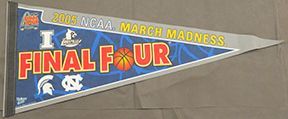
2005 Final Four pennant
April 4, 2005 - By the Numbers
Apr. 4, 2025
Twenty years ago today – Apr. 4, 2015 – Illinois and North Carolina met in the NCAA Tournament’s championship game.
We remember the game, by the numbers:
1 – The 2005 national championship was played between two No. 1 seeds for the first time since 1999. It was Coach Roy Williams’ first NCAA title.
2 – Illinois’ 75-70 loss was only its second of the season (37-2).
2.5 – North Carolina entered the game as a 2.5-points favorite.
5 – Five-year-old Ayo Dosunmu watched the game from his home in Chicago.
6 – Number of championship game players who, 85 days later, were chosen at the June 28, 2005 NBA Draft. UNC’s Marvin Williams was the second overall pick, followed by UI’s Deron Williams (3rd), UNC’s Raymond Felton (5th), UNC’s Sean May (13th), Rashad McCants (14th) and UI’s Luther Head (24th).
9 – Due to early foul trouble, Illini starter James Augustine only logged nine minutes of playing time.
14 – The game-high number of rebounds corralled by UI’s Roger Powell Jr. Eight of the 14 were offensive rebounds.
15.0 – While the Nielsen TV Rating for the Illinois-North Carolina game was outstanding, it fell nine points shy of the 24-point viewer rating that watched the 1979 title game between Michigan State’s Magic Johnson and Indiana State’s Larry Bird.
21 –UNC’s Sean May celebrated his 21st birthday on game day by scoring 26 points, the exact total his father Scott had scored in leading Indiana to the 1976 NCAA championship. Twenty-one was also the Illini-high point total of Luther Head.
30 – Jack Ingram came off the bench and, in his 30 minutes of playing time, had 11 points and seven rebounds.
37 – Illinois’ 37 victories in 2004-05 tied the record set by 1998-99 national runner-up Duke.
40 – Number of 3-point field goals launched by the Illini against North Carolina. Thirty-four of the 40 long bombs came from UI’s guard triumvirate of Head, Dee Brown and Deron Williams.
137 – Beginning with UI’s 87-67 season-opening victory over Delaware State on Nov. 19, 2004 through the NCAA championship game on Apr. 4, 2005, Illini fans enjoyed a total of 137 days of jubilation.
2014 – In 2014, Sports Illustrated voted the 2004-05 Illini team as the best ever to not win a title.
20,000 – Estimated crowd at Memorial Stadium that greeted the Illini when they arrived home the next day in Champaign.
47,262 – The championship game attendance inside the Edward Jones Dome in St. Louis.
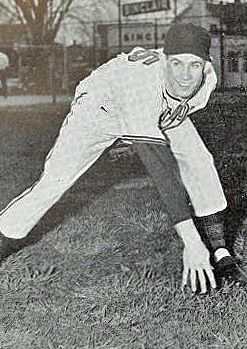
Doug Mills
Doug Mills
Mar. 31, 2025
Today marks the 85th anniversary of the birth of former Fighting Illini athlete Doug Mills. Born and raised in Galesburg, Illinois, he earned six varsity letters in basketball, baseball and football. Mills died on May 14, 2024.
Other highlights in Mills’ career:
* 1958: Earned all-state honors in both football and basketball at Galesburg High School.
* 1962: Won the University of Illinois’ Outstanding Athlete Award. Mills was a two-time All-Big Ten pitcher for the Illini, compiling an 18-1 record while leading the Illini to the Conference title. He also earned two letters as a guard in basketball and one as a punter and halfback in football.
* 1971: Doug and his wife, Linda, bought a controlling interest in the Busey First National Bank in Urbana. At the time, the bank had total assets of $40 million. Today, Busey Bank has assets of more than $1.3 billion.
* 1998: The Mills family, including their children, David and Rob, gave a gift which endows the salary of the Head Football Coach at the U of I.

1990 Illini Women's Gymnastics
1990 Illini Women's Gymnastics
Mar. 24, 2025
Thirty-five years ago this weekend—March 23-24, 1990—the Fighting Illini women’s gymnastics team won the Big Ten team championship, something it had never achieved before nor has accomplished since.
Entering the season, Coach Bev Mackes said that her squad, comprised solely of freshmen, sophomores and juniors, would need to work together, show gradual progress and peak at the right time. She also faced the question of whether or not two of her best athletes would rebound from injuries. Two weeks before the 1989 Big Ten meet, reigning conference all-around champ and co-Gymnast of the Year Heather Singalewitch had blown out her knee, while classmate Denise Lamborn spent the entire ’88-89 season in a back brace.
As the ‘89-90 campaign progressed, both athletes recuperated successfully and so Mackes’s Illini entered the Big Ten meet at Ann Arbor as the favorite to win it all.
On opening night, Illinois responded perfectly in the team competition, posting a UI and Big Ten record score of 188.750 to edge runner-up Michigan State by one and a quarter points. Only four points separated the first- and last-place teams.
The following evening, the Illini continued their individual mastery. Lamborn won the vault with a 9.8 score, Peggy Pullman and Laura Knutson tied for the balance beam title at 9.65, and Singalewitch tied with two other floor exercise competitors to share that championship. All four ladies won All-Big Ten honors while Mackes was singled out as the Big Ten Coach of the Year.
Said Illini co-captain Susan Adams afterwards, “We worked so hard all year and we finally got what we wanted. We couldn’t have done it if we weren’t together as a team.”
Dr. Beverly Mackes Stevens is now retired from Illinois State University. Her husband, Michael, directed the master’s program in counseling psychology at ISU.
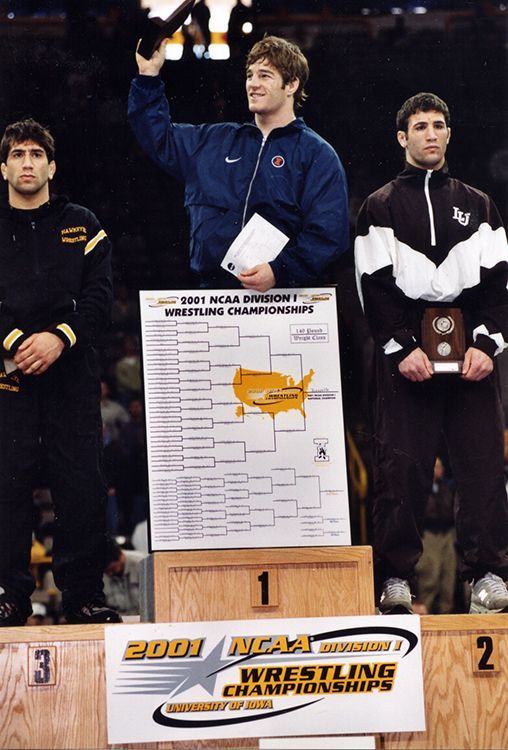
Adam Tirapelle
Wrestling's Title Twins
Mar. 17, 2025
Twenty-four years ago today - Mar. 17, 2001 - something happened with Illinois wrestling that has occurred only three times in its 108-year varsity history. It was the day when two Illini were crowned NCAA champions.
Two weeks earlier at the Big Ten Championship, a pair of Illini senior grapplers—top-seeded 184-pound Nate Patrick and fourth-seeded Pat Quirk (197 pounds)—both won individual titles, leading Illinois to a second-place team finish behind Minnesota. The Illini also got runner-up finishes from a trio of wrestlers: senior Adam Tirapelle (149), sophomore Matt Lackey (165) and junior heavyweight John Lockhart.
Heading to the NCAA meet in Iowa City, Coach Mark Johnson took nine Illini with him and all nine won their first-round matches. Mike Castillo (141), Griff Powell (157) and second-seeded Patrick (184) all got to the round of eight, but each man lost his third match. Now, only eleventh-seeded Ryan Escobar at 125 pounds, seventh-seeded Quirk, fifth-seeded Lackey, fourth-seeded Lockhart and third-seeded Tirapelle remained alive for possible championships.
In the quarterfinals at Carver-Hawkeye Arena, Escobar lost to third-seeded Leroy Vega of Minnesota, 13-3, but four teammates—Tirapelle (11-2 over Central Michigan’s Ty Morgan), Lackey (3-1 OT over Oklahoma’s Robbie Waller), Quirk (8-4 over Nebraska’s Brad Vering) and Lockhart (4-2 OT over Purdue’s Jake Vercelli)—all advanced to the semifinals with victories.
Just one of the four remaining Illini grapplers lost in the semis. Unfortunately, Lackey drew top-ranked Don Pritzlaff of Wisconsin. The former Moline High School star wrestled well, but lost by a score of 6-3 to the eventual 165-pound champ.
Tirapelle shut out second-seeded Jared Lawrence of Minnesota, 6-0, to advance to the finals in the 149-pound division, while Quirk beat eleventh-seeded Mike Fickell of Pennsylvania, 8-4, to get to the championship match at 197.
The semifinals’ most exciting match pitted Lockhart against top-ranked heavyweight and Olympic bronze medalist Garrett Lowney of Minnesota. Twice earlier that season, Lowney had beaten Lockhart, including denying the Mahomet-Seymour giant a Big Ten title. This time it came down to a tie-breaker period and Lockhart notched the victory with a quick escape.
In the Saturday night finals, Tirapelle started things off with a bang, sealing a 5-3 victory over Lehigh’s Dave Esposito with a takedown with 32 seconds left. The senior from Clovis, California jumped off the raised mat into the arms of his head coach. “I was pretty sure he could take it,” Tirapelle joked afterwards.
Quirk’s string of upset victories finally came to an end when the ex-Hinsdale Central High standout lost to top-ranked Mark Munoz of Oklahoma State, 5-2.
In the evening’s final match, Illinois’s Lockhart faced his friend, No. 2-seeded Tommy Rowlands of Ohio State. After finishing regulation time tied at one apiece, the two giants wrestled to a scoreless first overtime period. In the second OT, Lockhart escaped his elected down position with 11 seconds left and the national title was his.
In addition to crowning two individual champions, Illinois posted its best team finish in 55 years. Only Minnesota, Iowa, Oklahoma State and Oklahoma placed ahead of the Illini.
“We proved that we’re doing the right things,” said Johnson.
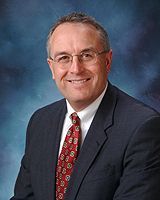
Mike Lehmann
Mike Lehmann
Mar. 13, 2025
Forty-three years ago today—Mar. 13, 1982—at the Silverdome in Pontiac, Mich., Fighting Illini athlete Mike Lehmann captured the NCAA Indoor Track and Field Championships title in the shot put, tossing the 16-pound spherical ball 67-feet-7 ¾-inches. At that time, he joined long jumper Charlton Ehizuelen (1976 and ’77) as the only University of Illinois athletes to accomplish an NCAA indoor individual championship.
The 6-1, 265-pound Lehmann’s primary competition that day was Ohio State superstar Kevin Akins, who stood 6-5 and tipped the scale at 350 pounds. Still, Lehmann was convinced that he could win, primarily because of how he’d been performing in his preparation.
“In practice that week or two before, I was throwing ridiculous distances,” he said, “so my confidence was high.”
At the Silverdome, he added psychological warfare to his repertoire to try to gain an advantage.
“I was prancing around, hooting and hollering, and getting myself psychologically prepared for the upcoming throws,” Lehmann said. “Kevin may have been intimidated a bit by what I was doing. In the heat of the moment, you’re trying to do anything and everything just to get ahead. Basically, it really all came down to technique.”
As a youngster, Lehmann was an aspiring football player at Oak Lawn Community High School, despite the fact that as a freshman he was only 5-7 and 135 pounds.
“After football season was over, my buddies and I wanted to get ourselves bigger, so we got involved with track and field and coach George Dunn’s weight-lifting program,” Lehmann said.
A broken wrist in the first game of his sophomore season ended his football career, so he decided to turn his full attention to becoming a shot putter.
“I remember I threw the shot 33 feet as a freshman,” he said. “Then I gained another 30 pounds as a sophomore and my throw distances kept increasing. By my junior year, things finally started happening. I was determined to work hard and keep getting stronger every year.”
Lehmann placed fourth in the state as a junior but was just an inch and a quarter short of the title winner. By his senior year, he had grown to 6-1 and 200 pounds.
“I was working like a psychopath, but I never thought much about it because that’s just how my parents brought us up,” Lehmann said. “There are always going to be people out there who are more talented, but if they don’t want to work as hard, they may not achieve the goals that they want. I used that work ethic to my advantage.”
West Point recruited him initially, then Kentucky. Shortly after he returned from his recruiting visit to Lexington, Lehmann got a call from Illini coach Gary Wieneke.
“My father absolutely loved Gary Wieneke, so we went down to Champaign for a visit,” he said. “Kentucky was offering a full ride and Illinois not so much, but my father finally convinced me about the advantages that Illinois offered.”
Lehmann excelled at Illinois in track and field, even though he didn’t have a mentor who specialized in throwing weights. He credits his former high school coach, now 91, for his success.
“Thankfully, Coach Dunn had given me the knowledge to put my own pre-season training program together,” Lehmann said.
Four decades after his last collegiate competition, Lehmann continues to be on top of Illinois’ shot put records list, both indoors (69-2 3/4) and outdoors (68-4 ½). Number two on both Illini ledgers is his younger brother, Jeff. Post collegiately, Mike eventually eclipsed the magic 70-foot mark.
Lehmann earned his degree in engineering at Illinois but discovered that “it wasn’t my cup of tea.” He eventually took a job at Chicago’s Mercantile Exchange.
“I discovered that I like the financial side of things because I’ve always been a person who’s enjoyed numbers,” he said.
Lehmann returned to Champaign-Urbana nearly four decades ago and established his own investment and insurance company, LaSalle St. Securities, LLC, in the late 1990s.
His family includes his wife of 38 years, Cheryl, three sons and a daughter. All of Lehmann’s children—Christopher, Courtney, Blake and Clayton—attended Champaign Central High School and several of them competed in collegiate athletics. Courtney now is head coach for girls and boys swimming at Centennial High and her father serves as her assistant in charge of weightlifting.
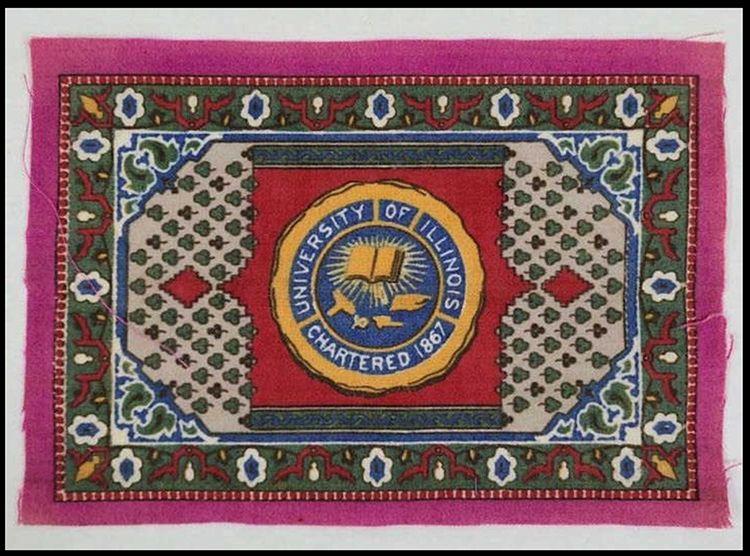
Illinois' seal
Illinois Industrial University
Mar. 11, 2025
One-hundred-fifty-seven years ago today—March 11, 1868—the Illinois Industrial University (University of Illinois) celebrated its opening of nine days earlier with inaugural ceremonies. President John Milton Gregory, both members of his faculty, 77 students and a bevy of town folk gathered in a large hall on the third floor of University Hall, known by its moniker “The Elephant.”
In “Hot Type”, a 2002 book authored by Tom Kasich, the weather outside was described as being miserable. The town’s newspaper, The Union & Gazette, colorfully described the conditions. “It seemed all the elements in nature had combined to make the day disagreeable and the occasion of a failure, for overhead it was dark and lowering, underfoot an almost unfathomable depth of mud, and between and lying loose was rain and water enough to make ducks or the student of hydraulics supremely happy.”
Inside, however the ceremonies were jubilant. Decorated in red, white and blue, a large portrait of George Washington hung over the speaker’s platform. Following a performance of the new University Anthem, speeches were presented by Gregory and Superintendent of Public Instruction Newton Bateman, then the crowd sang “America” and offered a series of toasts.
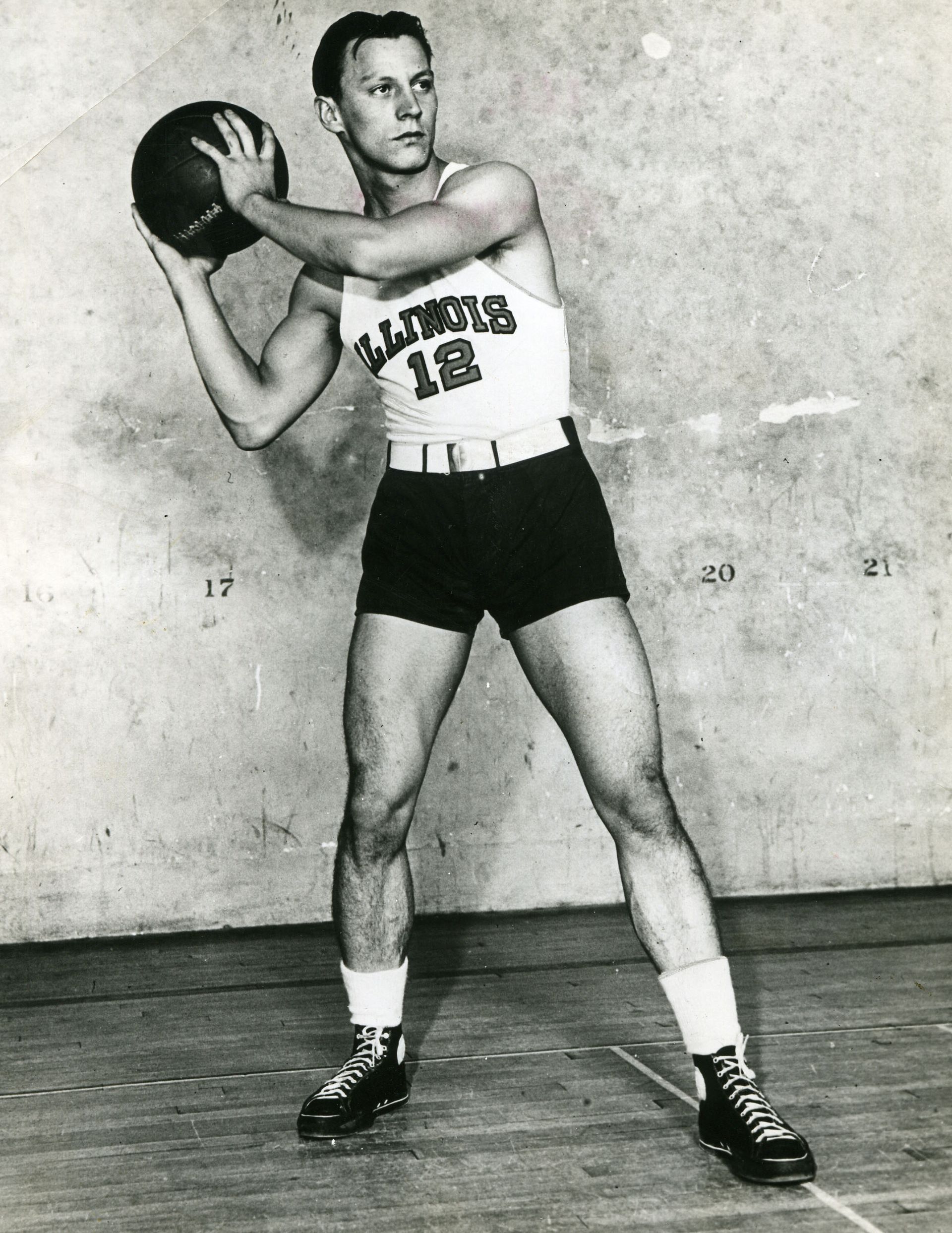
Harry Combes
1937 Illini Big Ten Champs
Mar. 7, 2025
Eighty-eight years ago today—Mar. 7, 1937—rookie head coach Doug Mills’ Illini basketball team clinched a tie for the Big Ten championship with a 32-26 victory over host Northwestern in Evanston.
Captain Roy Riegel, Illinois’ lanky 6-foot-4-inch center, paced the winners with three field goals and three free throws for nine points. Riegel, along with fellow starters Lou Boudreau, Harry Combes, Jim Vopicka and Wib Henry, notched their 10th victory in 12 conference starts, matching co-champ Minnesota’s 10-2 record. It was UI’s second league title in three seasons.
The very next day, Combes was named to the Big Ten’s first-team all-star unit, joining Minnesota’s Martin Rolek, Purdue’s Jewell Young, Ohio State’s Tippy Dye and Michigan’s Jake Townsend. Riegel earned second-team honors.
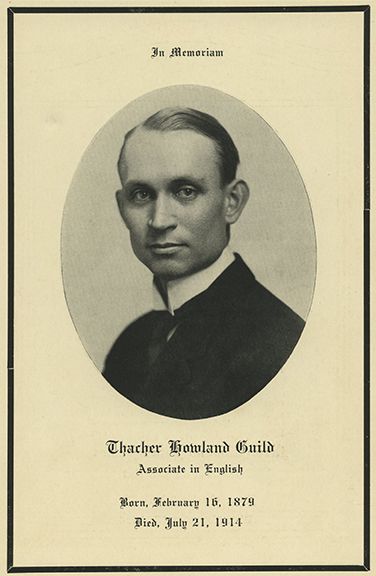
Thatcher Howland Guild
Debut of Illinois Loyalty Song
Mar. 3, 2025
One hundred nineteen years ago today, a song that fans and alumni have heard hundreds of times debuted before the University of Illinois student body.
“Illinois Loyalty” was a work that composer/lyricist Thatcher Howland Guild began when he was a student at Brown University. Hired by the U of I as a 27-year-old English instructor, Guild perfected the melody of the tune with fellow cornet player and future band director Albert Austin Harding. It was at Harding’s very first concert program on March 3, 1906 that “Loyalty” was debuted.
The Illini, UI’s student-published newspaper, described the event that night at what is now recognized as Kenney Gym:
"The large and formal audience that filled the Armory last night was many times stirred to great enthusiasm by the numbers rendered at the annual band concert. It was a gala night. Society turned out in full force to hear the program given by the large band of fifty pieces. It was a program that contained not only old and worn pieces, but numbers which made their first public appearance. There were several times when the audience gave vent to their enthusiasm most freely. Works by two local composers, Mr. T.H. Guild and Mr. B.E. McCoy, were among the principal selections that received a large share of applause. Mr. Guild’s song, “We’re loyal to thee, Illinois”, was a work which deservedly demanded a good reception. The main theme is indeed pleasing, and the spirit of the music and words is the spirit of Illinois. It is a song that could well be included among the few songs that Illinois can call her own. It should undoubtedly be included on the repertoires of future bands and glee clubs just as Illinois now is. Mr. Guild has produced a work which ”takes”, and it will certainly find a place in our college music."
Guild would enjoy his personal fame as the composer of “Illinois Loyalty” for only eight more years, dying from a heart attack during a summer tennis match at the age of 35 in 1914. The song wouldn’t actually be recorded until November 1, 1925 when, the day after Illinois’s football game at the University of Pennsylvania in Philadelphia, Harding took his band to a studio at the Victor Talking Machine Company in Camden, New Jersey.
At last count, thirty-six high schools around the nation use the melody of “Illinois Loyalty” as their school song.
The words of the song as listed in the 1906 program are:
We′re loyal to you, Illinois,
We′re Orange and Blue, Illinois;
We′ll back you to stand
′Gainst the best in the land,
For we know you have sand, Illinois,
Rah! Rah!
So crack out that ball, Illinois,
We′re backing you all, Illinois,
Our team is our fame−protector,
On! boys, for we expect a
Victory from you, Illinois.
Che-he, Che−ha, Che−ha−ha−ha! Che−he, Che−ha, Che−ha−ha−ha!
Illinois! Illinois! Illinois!
Fling out that dear old flag of Orange and Blue
Lead on your sons and daughters, fighting for you,
Like men of old, on giants placing reliance, shouting defiance—
Oskee−wow−wow!
Amid the broad green fields that nourish our land,
For honest Labor and for Learning we stand,
And unto thee we pledge our heart and hand,
Dear Alma Mater, Illinois.
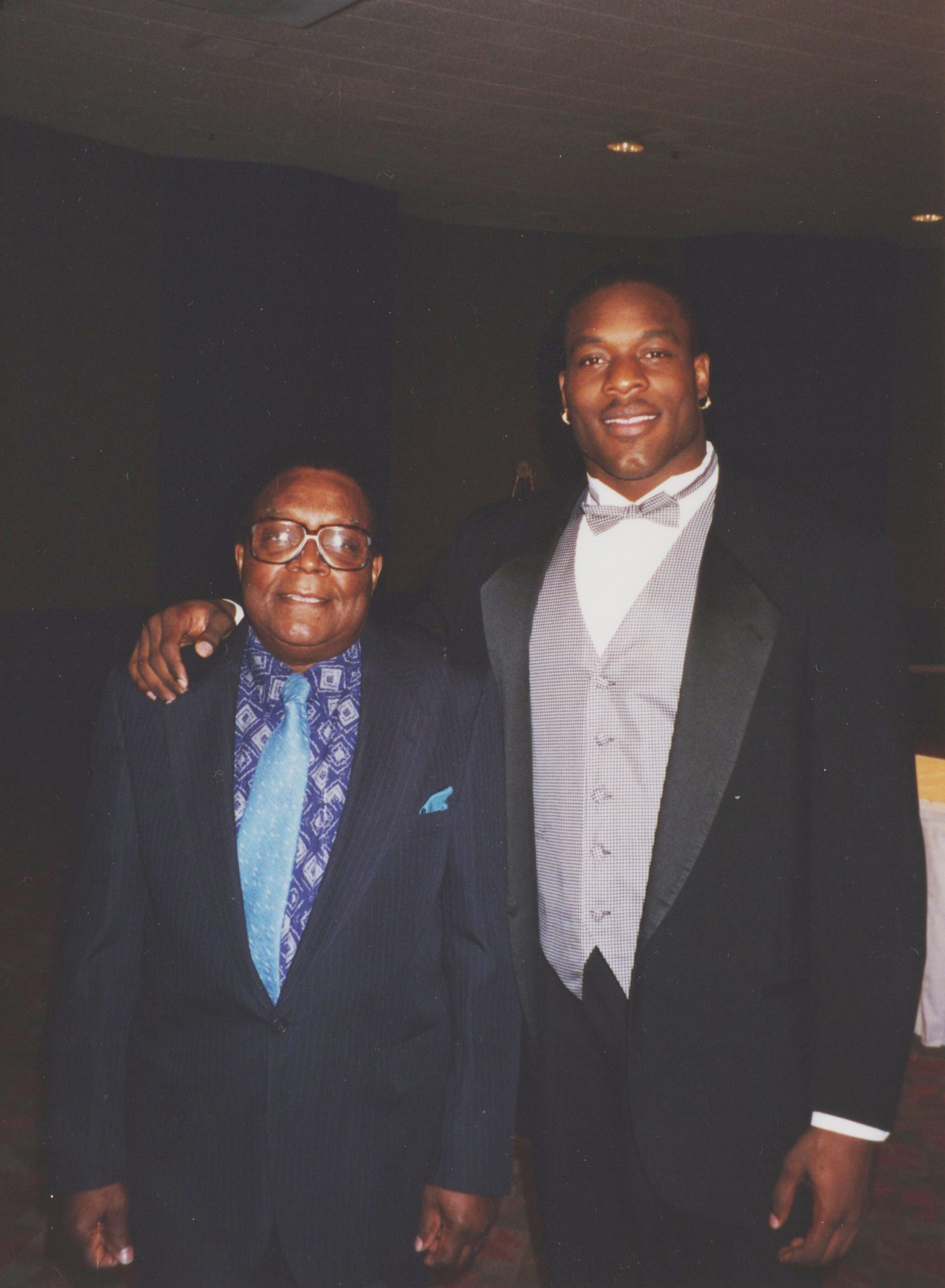
Simeon Rice & his father, Henry
Simeon Rice
Feb. 24, 2025
Today is Fighting Illini football great Simeon Rice’s 51st birthday.
The second born of five children to Henry and Evelyn Rice on Chicago’s south side, young Simeon first became interested in football during pickup games with his brother in the crime-ridden Roseland neighborhood.
His father recognized Simeon’s physical gifts and sent his son to Mt. Carmel, an all-boys Catholic school about an hour away. It wasn’t until his junior year that Coach Frank Lenti moved Simeon to defensive end. A promising senior season caught the eye of University of Illinois recruiters.
Illinois’ former defensive coordinator Denny Marcin, who had coached Lawrence Taylor at North Carolina, quickly identified the potential that his young Illini freshman possessed and boldly predicted that No. 97 was destined for greatness. In Rice’s freshman year, he posted an Illini freshman record nine quarterback sacks. As a junior, he teamed with a talented linebacker corps that included future Butkus Award winners Dana Howard and Kevin Hardy and future longtime NFL standout John Holecek. Rice’s 1994 statistics included 16 QB sacks among his 20 tackles for loss.
The 6-5, 259-pounder surprisingly decided to return to Illinois for his senior season in ‘95 and both school and Big Ten sack records fell in his lap. Thirty years later, Rice’s 44.5 career sacks still lead a conference list that includes names like Iowa’s Jared DeVries, Michigan’s Mark Messner and Ohio State’s Mike Vrabel.
Rice was the 1996 NFL Draft’s third overall pick, following Southern Cal’s Keyshawn Johnson and Illini teammate Kevin Hardy. Over 12 NFL seasons with Arizona (1996-2000), Tampa Bay (2001-06), Denver (2007) and Indianapolis (2007), Rice accumulated 122 career quarterback sacks, just behind Derrick Thomas (126.5), Dwight Freeney (125.5), Von Miller (123.5) and Robert Mathis (123). Of the 20 players ahead of Rice on the list, 14 are members of the Pro Football Hall of Fame and the others are still under consideration for that honor.
Last September, in an interview with Pro Football Journal’s John Turney, Rice admitted that induction into the Pro Hall of Fame would mean a lot to him.
“It (being elected to the Hall of Fame) would be a big honor,” Rice said. “That chapter in my life won’t be closed until I put on a yellow jacket. When you go into a career and you play in pro sports, you want to become the best of the best. I am off the south side of Chicago with an ambition and a dream and chased that dream ... I’ve done it all ... my career is a Hall-of-Fame career.”
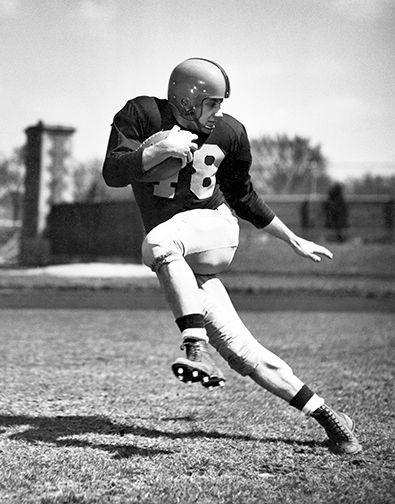
John Karras
Johnny Karras
Jan. 27, 2025
“An elusive, will-o-the-wisp who always was a threat anytime he had the ball.”
That was the description of Fighting Illini running back Johnny Karras by his coach, Ray Eliot.
The famed “Argo Express” was born 97 years ago today - Jan. 27, 1928.
During his three letter-winning seasons from 1949 through 1951, Karras rushed for a University of Illinois record 2,077 yards, six more yards than his idol, Red Grange, but in 15 more attempts. His 826 yards as a sophomore in ’49 was his best single-season effort, including a Big Ten record 732 yards in conference games. He was the team MVP that season.
Though his production tailed off a bit during his last two seasons, Karras led the Illini to a spectacular 16-2-1 cumulative record over that span, including a nearly perfect 9-0-1 mark in 1951 when Illinois topped off its season by defeating Stanford in the Rose Bowl.
He played one season in the NFL with the Chicago Cardinals. In 1990, Karras was selected by fans as a member of Illinois’ All-Century Team.
He died in 2008 at the age of 80.
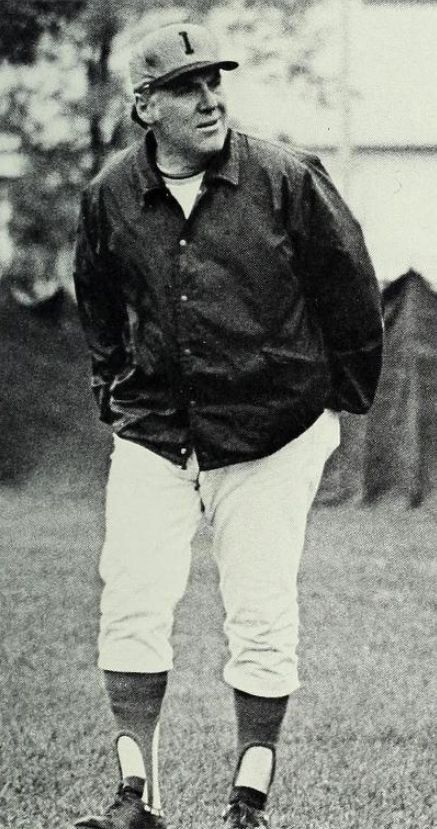
Lee Eilbracht
Lee Eilbracht's Major Leaguers
Jan. 24, 2025
Seventy-three years ago today, Lee Eilbracht was named acting head coach of the Fighting Illini baseball team, replacing Wally Roettger who had died the previous September.
Eilbracht lettered three years as a player (1943, ’46 and ’47). He had a celebrated career as Illinois’ head coach, compiling 515 victories against 393 losses and six ties in 27 seasons. He had 41 more wins than Itch Jones (474 in 15 years) and 201 more than George Huff (314 in 23 years). Current Illini coach Dan Hartleb broke Eilbracht's record in 2023 and has 567 total victories.
Eilbracht’s Illini teams won four Big Ten titles. Fourteen of his Illinois players eventually went on to play Major League Baseball:
Ethan Blackaby: Milwaukee-NL (1962-64) … Career: .120 average, 0 HR, 1 RBI
Bob Burda: St. Louis (1962 & ’71); San Francisco (1965-66, 1969-70); Milwaukee-AL (1970); Boston (1972) … Career: .224 average, 13 HR, 78 RBI
John Felske: Chicago-NL (1968) and Milwaukee-AL (1972-73) … Career: .135 average, 1 HR, 9 RBI
Tom Fletcher: Detroit (1962) … Career: 1 game
Tom Haller: San Francisco (1961-67); Los Angeles-NL (1968-71); Detroit (1972) … Career: .257 average, 134 HR, 504 RBI
Jim Hicks: Chicago-AL (1964-66); St. Louis (1969); California (1969) … Career: .163 average, 5 HR, 14 RBI
Ken Holtzman: Chicago-NL (1965-71, ’78); Oakland (1972-75); New York-AL (1976-77) … Career: 174-150, 3.49 ERA
Dick Hyde: Washington (1955-60); Baltimore (61) … Career: 17-14, 3.56 ERA
Bobby Klaus: Cincinnati (1964) and NY Mets (1964-65) … Career: .208 average, 6 HR, 29 RBI
Gary Kolb: St. Louis (1960, 62-63); Milwaukee-NL (1964-65); New York-NL (1965); Pittsburgh (1968-69) … Career: .209 average, 6 HR, 29 RBI
Em Lindbeck: Detroit (1960) … Career: 2 games
Herb Plews: Washington (1956-59) and Boston (1959) … Career: .262 average, 4 HR, 82 RBI
Lou Skizas: New York-AL (1956); Kansas City (1956-57); Detroit (1958); Chicago-AL (1959) … Career: .270 average, 30 HR, 86 RBI
Ed Spiezio: St. Louis (1964-68); San Diego (1969-72) and Chicago-AL (1972) … Career: .238 average, 39 HR, 174 RBI
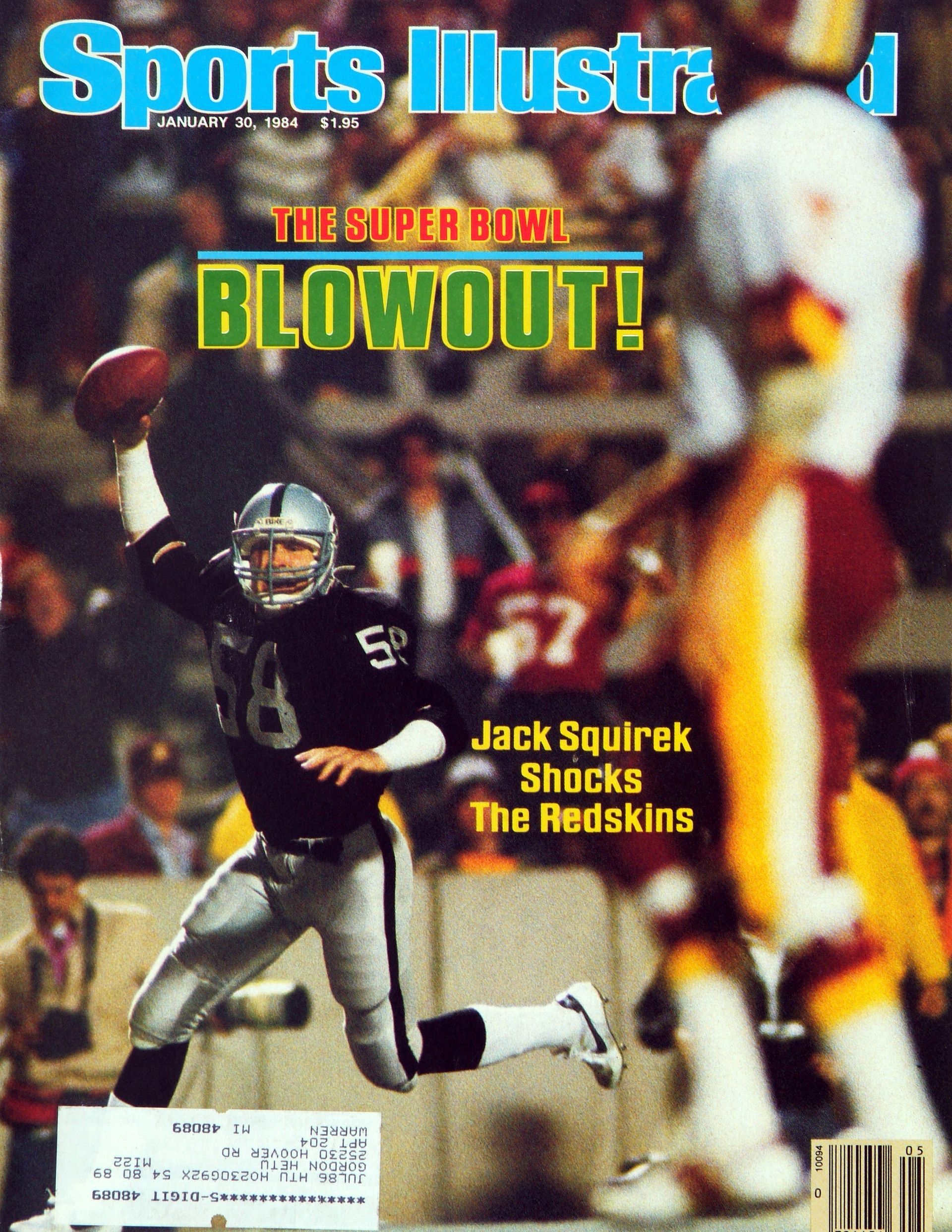
Jack Squirek on the cover of Sports Illustrated
Jack Squirek
Jan. 22, 2025
Forty-one years ago today - Jan. 22, 1984 - former Fighting Illini star Jack Squirek scored a touchdown on a five-yard interception as the Los Angeles Raiders beat the Washington Redskins, 38-9, in Super Bowl XVIII.
At that point, just three years into his pro career, Squirek only saw spot duty as a reserve linebacker. Raiders linebacker coach Charlie Sumner substituted the athletic Squirek for Matt Millen with just seconds remaining in the first half and Washington at its own 12-yard line. Instead of running the clock out, Redskins quarterback Joe Theismann decided to throw an ill-fated screen pass. Squirek stepped in front of halfback Joe Washington and went into the end zone untouched for a TD.
His game-turning play earned him the spotlight on Sports Illustrated’s Jan. 30, 1984 issue. In a retrospective article written by SI’s Jeff Pearlman, Squirek remembered his day in the sun.
"It was all very amazing," he told Pearlman. "I was staying at the LAX Hilton at the time, and I came down to the magazine stand in the lobby and saw the cover. It blew me away."
Eventually, injuries shortened Squirek’s career and his playing time ended in 1986.
He died on Jan. 5, 2024, at the age of 2024.

Rob Mango
Rob Mango
Jan. 20, 2025
As a 14-year-old freshman at Tinley Park High School, future University of Illinois star Rob Mango was focused on two things: running and visiting the Art Institute of Chicago. Following weekend track meets, his parents would shuttle him to 111 South Michigan Avenue where he attended classes and devoured the paintings of Monet, Van Gogh and Picasso.
Mango credits his mother for creating his passion for literature and fine arts.
“Every morning my mother prodded me in the direction of literature and the American poets and authors who she was most familiar with,” he said.
Once Mango arrived at the University of Illinois on a partial track scholarship, the middle-distance ace trained with long-distance teammates Lee LaBadie, Mike Durkin and a young Craig Virgin. He endured extreme pain when, during the six-to-twelve-mile runs, they would ratchet up the pace.
“To survive the experience,” said Mango, “I would visualize my paintings, usually works in progress, but also new pictorial hallucinations as my mind would fill with fragments from my subconscious.
“My life was a composition of training and distance running and studying art and creating,” he continued. “I found out what oxygen debt meant; when you’re not breathing in enough air to supply to your muscles for the speed that you’re running. Something happens to your brain. You’re looking straight ahead and your mind is gushing forward ideas and images. You’re seeing them in your eye. I was seeing rectangles with pieces moving. Different forms of symmetry started entering my mind … bilateral, radial, rotational symmetry … really just the contents of the human psyche, which we all have. But I was able to excavate them and use them as a motif format to create paintings.”
Running long distances turned out to be a highly successful for Mango, as he would finish his career with two Big Ten individual championships (880-yard run in 1972 & ’73) and one conference relay title (one-mile relay in 1970).
At the NCAA meet in 1972, Mango anchored the two-mile team of Dave Kaemerer, Ron Phillips and LaBadie that captured first place. Individually, Mango also finished second in the 1973 NCAA 880-meter run.
He was a 1972 Olympic Trials finalist and won the 1973 Big Ten Conference Medal of Honor for proficiency in the classroom and in athletics.
Mango continued to study painting after graduating in 1973, first at the University of New Mexico, then back at Illinois where he received his Master of Fine Arts for sculpture.
Then, Mango said, New York began calling his name.
“It was the home of the beatnik poets and it was the city where the art world was and the people I admired. Painting became the essence of my being.”
Since November of 1977, Mango has operated his own gallery and studio in Tribeca on Lower Manhattan. For more than 40 years, he has been an internationally exhibited painter and sculptor. Mango’s work has been extensively collected in both the private and corporate spheres. He has participated in several solo exhibitions across the United States and Europe. Mango and his artwork have been featured in such publications as The New York Times, Art in America, and Art News. He’s also written a book entitled 100 Paintings: An Artist’s Life in New York City.
Mango’s family includes his wife, Helena, and two children. Today, he celebrates his 74th birthday.
To view his work, go to www.robertmango.com.
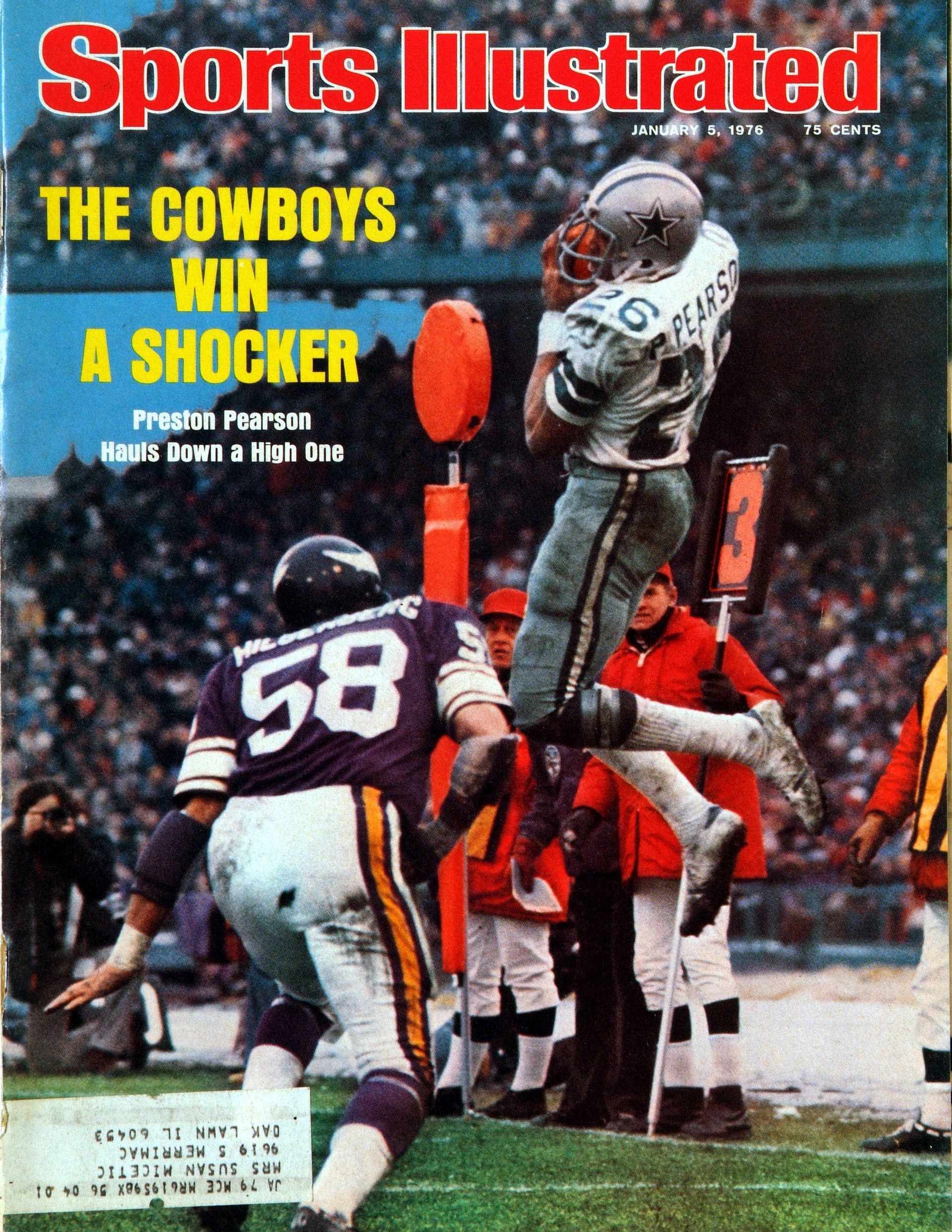
Preston Pearson
Preston Pearson
Jan. 17, 2025
Preston Pearson, former University of Illinois basketball star and the answer to several sports trivia questions, celebrates his 80th birthday today.
At 6-2, he was a prep all-state selection at Freeport High School, chosen to the same all-Illinois all-star team that featured Dan Issel from Batavia. A three-sport star at Freeport, Illini basketball coach Harry Combes recruited him to Illinois.
Pearson eventually became a part-time starter, sharing the court with such Illini as Jim Dawson, Don Freeman, Skip Thoren, Tal Brody, Rich Jones and Dave Scholz. His basketball career was mostly unspectacular, averaging five points and three rebounds through 62 games.
However, in the 1967 National Football League Draft, Coach Don Shula’s Baltimore Colts saw promise in the powerfully built Pearson and made him a late-round selection. With that break, Pearson’s career as a professional athlete took off. He began his career as a defensive back, but was eventually moved to running back where he excelled. Pearson played for Shula’s Colts from 1967-69, then Chuck Noll’s Pittsburgh Steelers from 1970-74, and finally for Tom Landry’s Dallas Cowboys from 1975-80.
He played in five Super Bowl games and is the only player to have done it with three different teams: the Colts of 1969, the Steelers of 1975 and the Cowboys of 1976, 1978 and 1979. Upon his retirement from the game, Pearson established a sports marketing company called Pro-Style Associates.
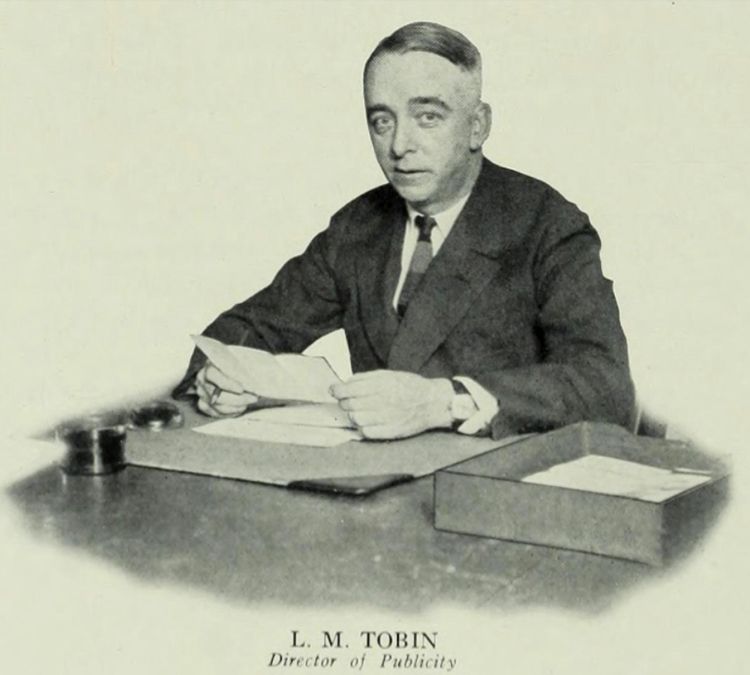
L.M. "Mike" Tobin
This Date in Illini History
Jan. 13, 2025
Jan. 13, 1923: Nine of Wally Roettger’s 15 points came via free throws and captain Swede Hellstrom added 10 points as Illinois defeated visiting Indiana, 31-22.
Jan. 13, 1930: Illinois held Michigan to just four field goals en route to a 24-18 basketball victory at Ann Arbor.
Jan. 13, 1944: Longtime Illinois sports information director L.M. “Mike” Tobin (pictured) died at the age of 64.
Jan. 13, 1968: Dave Scholz capped a spectacular 26-point performance by drilling a 20-foot jumper with just five seconds left as Illinois topped host Minnesota, 61-60.
Jan. 13, 1973: Jed Foster sank two free throws with just 11 seconds left to help Illinois defeat Iowa, 80-78.
Jan. 13, 1981: NCAA members vote to begin holding women’s championship meets.
Jan. 13, 2001: Three Illini women’s track standouts broke school records in a meet at UI’s Armory. Perdita Felicien set a new mark in the 60-meter hurdles, Angela Hilgers broke Illinois’ pole vault record, and Adeoti Oshinowo broke the school record in the 20-pound weight throw.
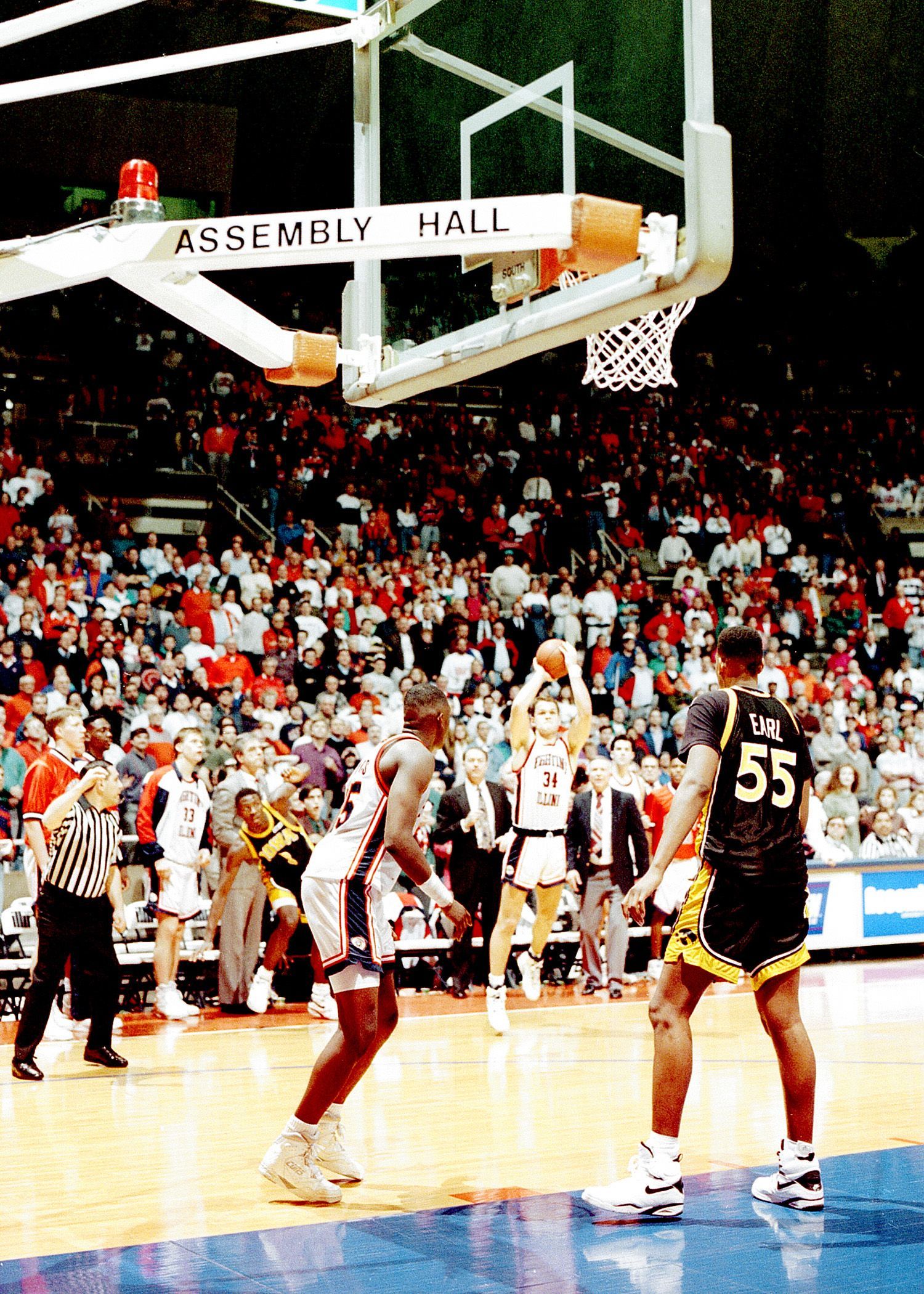
Andy Kaufmann vs. Iowa, 1993
Memorable Games of the '90s
Jan. 9, 2025
The decade of the 1990s was an exciting chapter in the history of Fighting Illini men's basketball. Today, we rank the 10 most thrilling games of the '90s:
Feb. 4, 1993: Andy Kaufmann hits a long-range 3-pointer at the buzzer to lead Illinois past No. 9 Iowa, 78-77.
Mar. 6, 1999: Last-place Illinois reaches the finals of the Big Ten Tournament with a 79-77 victory over Ohio State, its third straight win over a nationally ranked team.
Dec. 1, 1995: Illinois upsets No. 12 Duke, 75-65, snapping the Blue Devils' 95-game non-ACC winning streak at Cameron Indoor Stadium.
Feb. 24, 1996: Following Illinois' 91-86 victory over No. 18 Iowa, Lou Henson announces that he'll step down as head coach.
Mar. 11, 1990: Illinois beats Indiana for the third straight time in Bloomington (69-63) as Kendall Gill becomes the Big Ten scoring champ.
Feb. 12, 1998: Illinois beats 13th-ranked MSU, 84-63, at the Assembly Hall, to climb into a tie for first place. UI would go on to share the Big Ten title.
Dec. 20, 1995: Fourteenth-ranked Illinois beats 15th-ranked Missouri, 96-85, in overtime to stay unbeaten.
Jan. 14, 1997: UI beats No. 7 Minnesota, 96-90, at the Assembly Hall. The Gophers went on to earn the Big Ten title and a berth in the Final Four.
Mar. 2, 1997: The Illini outscore Michigan 41-9 to close out the game in a 70-51 victory at the Assembly Hall.
Dec. 22, 1990: Rennie Clemons dunks over Shaquille O'Neal in Illinois' 102-96 triumph over LSU.
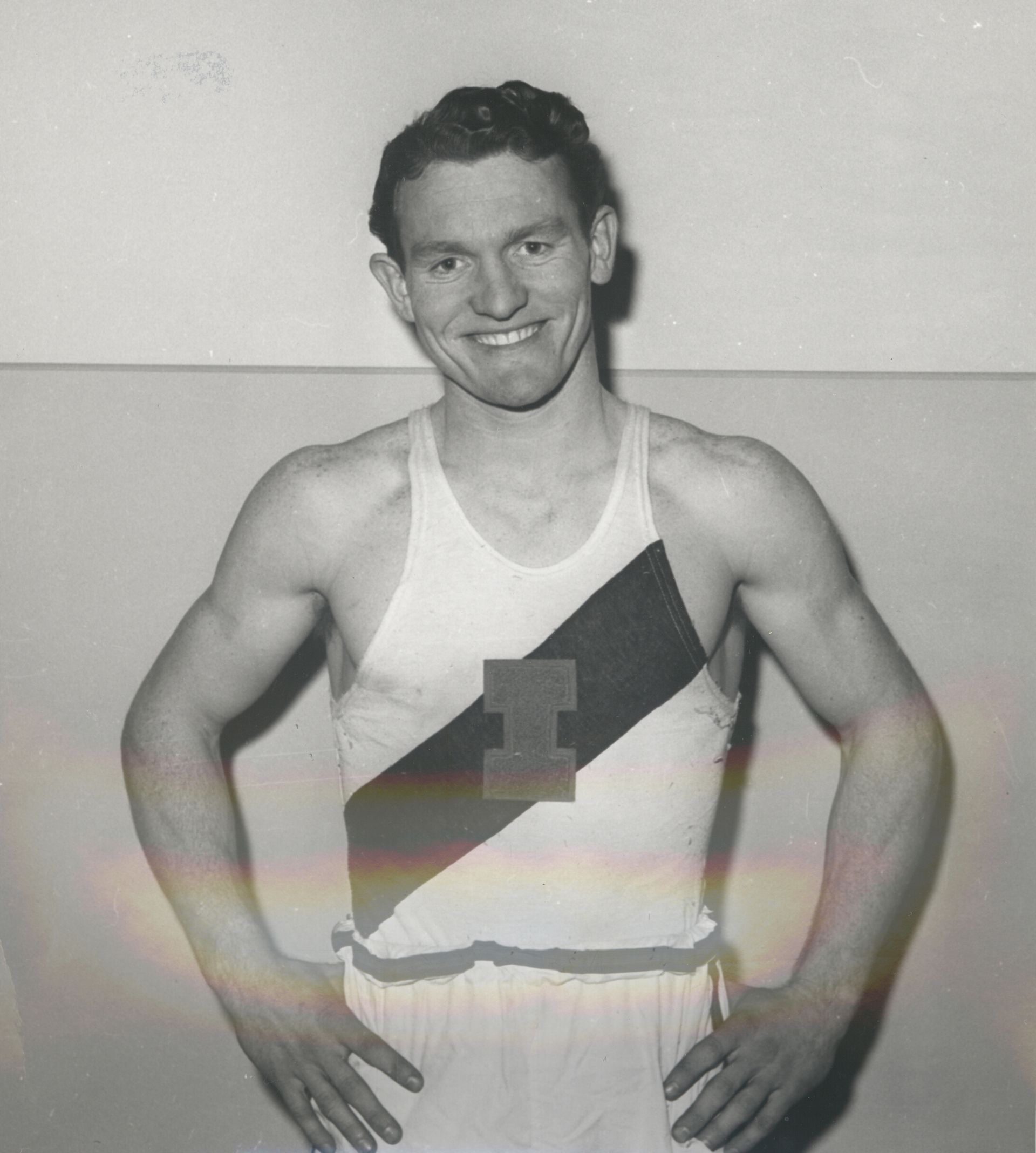
Bob Richards
Bob Richards
Jan. 2, 2025
Seventy-three years ago today—Jan. 2, 1952—former University of Illinois track and field star Bob Richards became the first—and heretofore only—Fighting Illini athlete to win the James E. Sullivan Memorial Award as America’s amateur athlete of the year.
A 1944 graduate of Champaign High School and a two-time Illini letter winner (1946 and ’47), the then 25-year-old Richards easily outdistanced tennis standout Maureen Connolly, 1,283 points to 903. Richards had 174 of the 487 first-place votes, while Connelly had 115.
Earlier in 1951, Richards had become the second pole vaulter in history to clear 15 feet and won the national decathlon championship. The best vault of his career at that point was 15-feet-4 ¾-inches, less than four inches beneath Cornelius Warmerdam’s world record. Richards’ best effort in the 10-event decathlon was 7,834 points, exceeded only by Bob Mathias’s 8,042 points mark (in 1948) and Glen Morris’s 7,254 points (1936) in Olympic competition.
At the time he won the Sullivan Award, Richards was an ordained minister in the Church of the Brethren and an instructor in religious philosophy at California’s La Verne College. A member of Richards’ congregation at that time was future tennis star Billie Jean King.
Richards’ training regimen was unlike other athletes.
In a 1952 Associated Press article, Richards told a writer, “I have to train much of the time at night. I usually teach in the morning, have business affairs to care for in the afternoon, preach at night, and then comes my training.”
Richards would go on to win Olympic gold medals as a vaulter, capturing first place in both 1952 at Helsinki, Finland and 1956 at Melbourne, Australia. He earned a bronze medal in 1948 at the London Games. He is the only vaulter to win more than two Olympic medals.
The longtime spokesman for Wheaties cereal died on Feb. 26, 2023, six days after his 97th birthday.
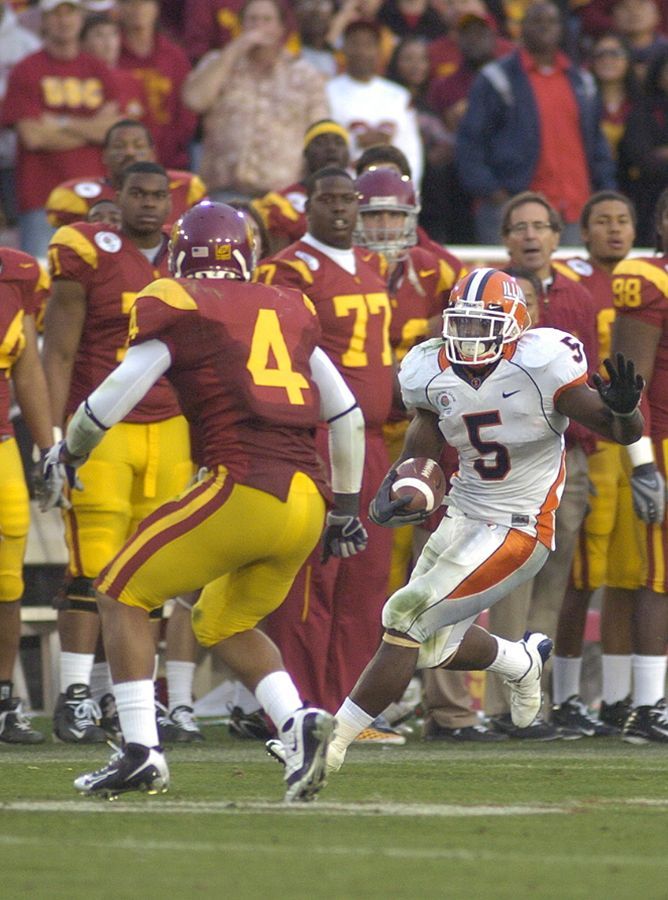
Rashard Mendenhall
Rose-Petaled Touchdowns
Dec. 30, 2024
The University of Illinois football team has played in five Rose Bowls in its program history. In those five appearances, the Orange and Blue have scored a total of 18 touchdowns.
- Julius Rykovich (one-yard TD, run, 1947)
- Buddy Young (two-yard TD, run, 1947)
- Paul Patterson (four-yard TD, run, 1947)
- Perry Moss (one-yard TD, run, 1947)
- Buddy Young (one-yard TD, run, 1947)
- Ruck Steger (68-yard TD, interception return, 1947)
- Stan Green (81-yard TD, interception return, 1947)
- Pete Bachourus (six-yard TD, run, 1952)
- Bill Tate (five-yard TD, run, 1952)
- John Karras (seven-yard TD, run, 1952)
- Bill Tate (eight-yard TD, run, 1952)
- Don Stevens (seven-yard TD, run, 1952)
- John Ryan (six-yard TD, pass from Don Engels, 1952)
- Jim Warren (two-yard TD, run, 1964)
- Jim Grabowski (one-yard TD, run, 1964)
- Thomas Rooks (five-yard TD, pass from Jack Trudeau, 1984)
- Rashard Mendenhall (79-yard TD run, 2008)
- Arrelious Benn (56-yard TD, pass from Eddie McGee, 2008)

Tom Porter
Tom Porter
Dec. 27, 2024
A longtime member of the University of Illinois staff, Tom Porter celebrates his 83rd birthday today.
He wrestled as an undergrad at Illinois, then at Indiana State where he eventually received bachelor’s and master’s degrees.
Porter began his coaching career in 1965 at Mount Prospect High School and moved on to John Hersey High School in Arlington Heights where he guided the Huskies to state championships in 1971 and ’72.
After four seasons at Hersey, Porter took a $4,000 cut in pay to become head coach of the Fighting Illin, replacing Jack Robinson. Two of his most successful wrestlers at Illinois were Kevin Puebla and Kevin Pancratz. Porter also served as an assistant football coach for the Illini.
In 1978, athletic director Cecil Coleman transitioned Porter into administrative work at the UI, most prominently in summer camps, promotions and marketing. It was Porter who turned “Tailgreat” into a nationally prominent promotion and introduced UI logo merchandise as a revenue stream for the athletic department. Other ideas of Porter’s that flourished were the “Go Illini Card”, the “Illini Pride” student support organization and “Hometown Heroes”.
He retired from his fulltime position at Illinois in 1999, but continued to serve A.D. Ron Guenther in a number of part-time roles.
In 2002 and ’03, Porter returned to coaching in Mahomet and guided the Bulldogs to a 44-7 dual meet record in 2002 and ’03. Porter was inducted into the Illinois Chapter of the National Wrestling Hall of Fame in 2012.
He and his wife, Pat, have been married for 60 years.
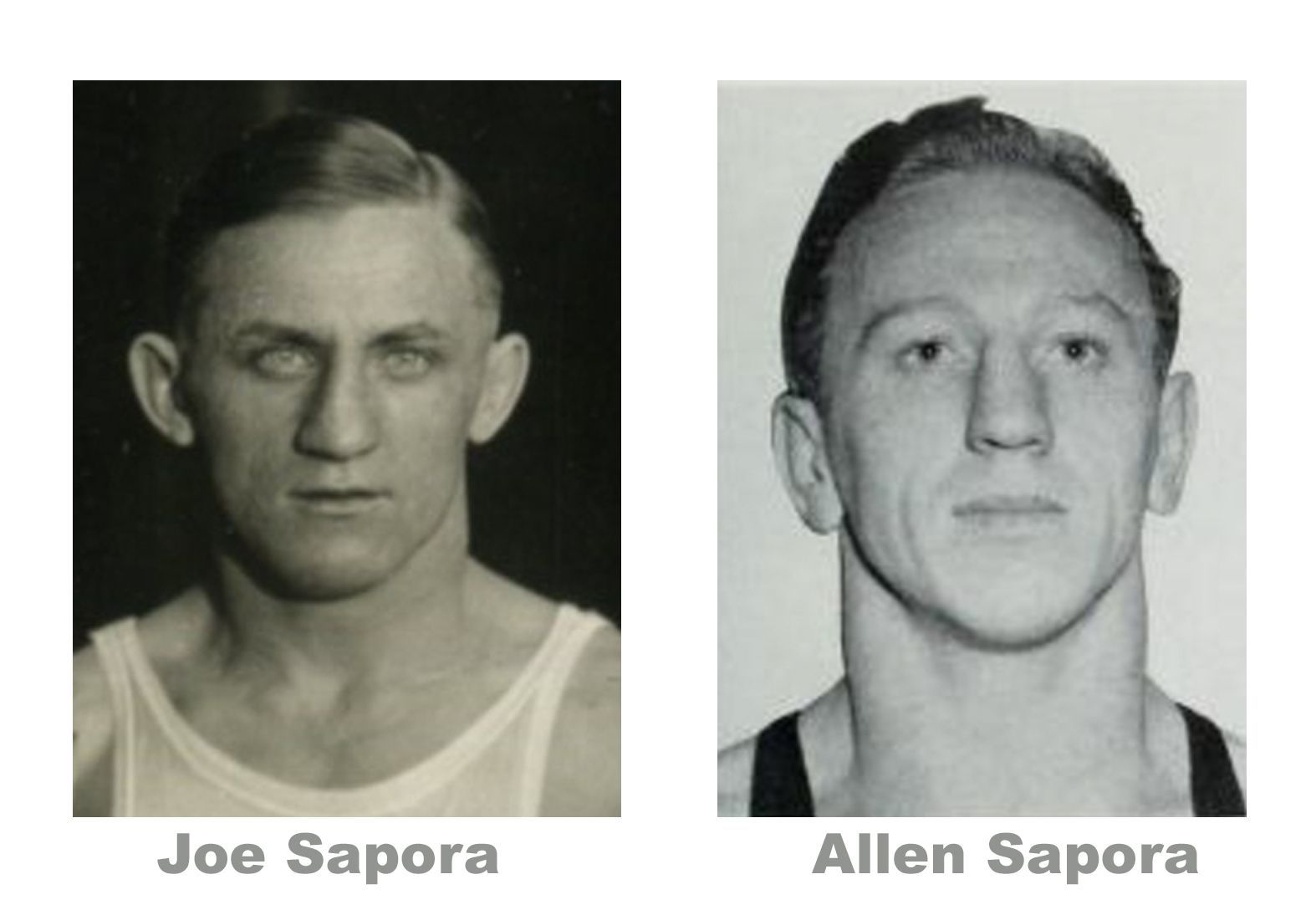
Sapora brothers
Wrestling's Sapora Brothers
Dec. 23, 2024
Of the 44 pairs of brothers who have earned varsity letters as members of the Fighting Illini wrestling program, the very first siblings—Joe and Allen Sapora—stand out above the others.
The natives of Renova, Pennsyslvania, a small lumbering community 178 miles northeast of Pittsburgh, matriculated to the University of Illinois and had legendary collegiate careers.
Joe, born in 1904, was recruited by then Illini coach Paul Prehn, but wrestled his final two seasons for Harold “Hek” Kenney. In 1929 and 1930, he was the nation’s premier grappler at 115 pounds, winning back-to-back NCAA and Big Ten individual titles. Team-wise, Sapora and his Illini teammates won Big Ten titles in 1928 and ’30 and placed second and fourth in the NCAA Championships in 1930 and ’29, respectively. Sapora went on to capture a pair of Amateur Athletic Union national freestyle titles for the New York Athletic Club, then became a professor of physical education and head coach at City College of New York. His biggest stars at CCNY were Henry Wittenberg, a 1948 gold medalist at the 1948 Olympics, and Jacob Twersky, a blind wrestler who was an NCAA finalist in 1942. Sapora retired from CCNY in 1968. He was inducted into the Helms Foundation Hall of Fame in 1994, two years after his death at the age of 87 in Daytona Beach, Fla. Sapora was a 2018 inductee into the Illini Athletics Hall of Fame.
Like his older brother, Allen was a dominant lightweight star at Illinois. The 126-pounder won the Big Ten title in 1937, then the NCAA crown in 1938. When he won the latter championship, it marked the first time that brothers won national titles. Sapora and his UI teammates won the Big Ten Championship in 1937 and placed second in the NCAA meet in 1938. Immediately afterwards, he became Kenney’s assistant with the Illini and continued in that role until he earned his doctorate degree in recreation. Sapora was a longtime member of the UI’s teaching staff in leisure studies. He also became an accomplished wrestling official, serving at five Illinois state championship meets. Born 112 years ago today, Allen Sapora died in 2004 at the age of 92.
In 1993, Illini wrestling named its Most Valuable Wrestler award in honor of the Sapora brothers.
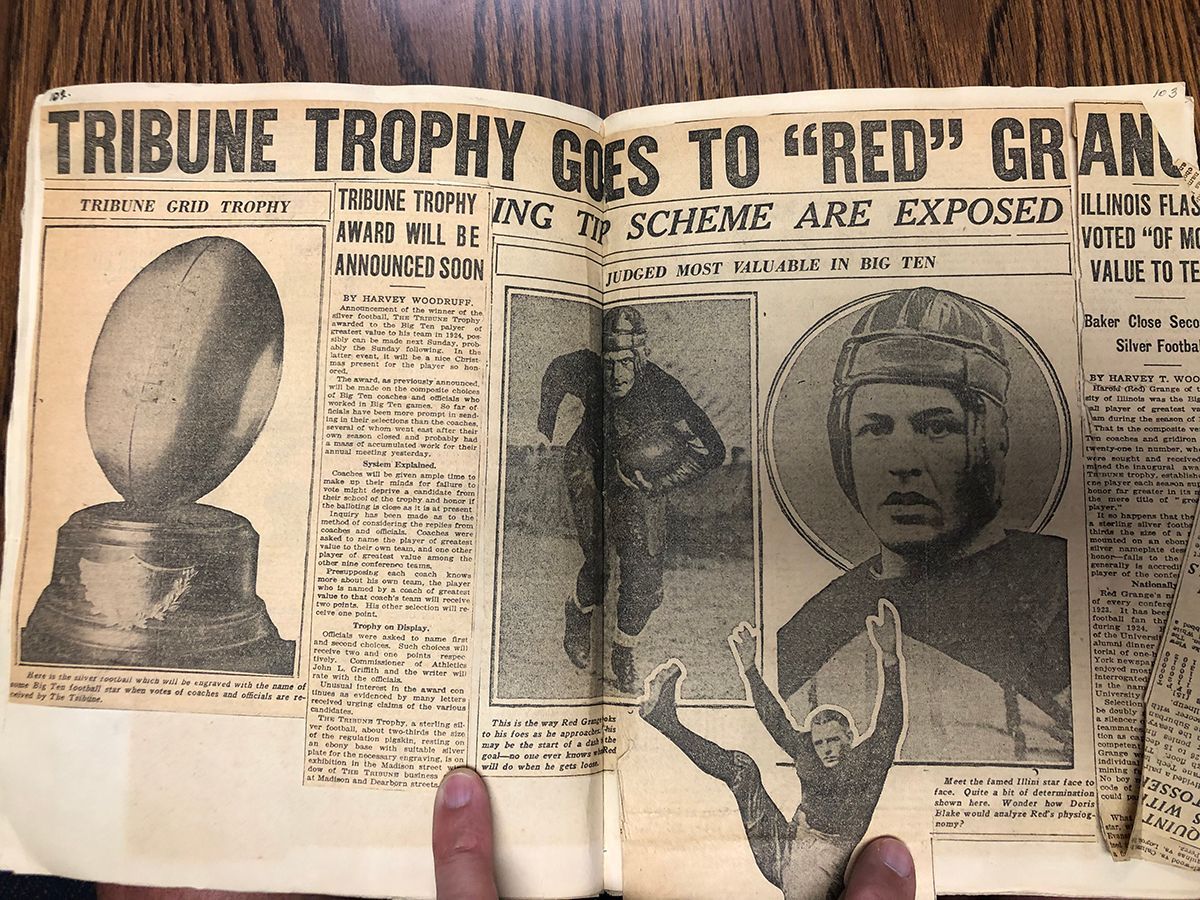
Red Grange
Red Grange & The Silver Football
Dec. 20, 2024
One-hundred years ago this week—Dec. 21, 1924—a distinguished panel of 21 coaches and sportswriters named a Fighting Illini football star as the inaugural recipient of the “Tribune Trophy”.
Wrote the Chicago Tribune’s Harvey Woodruff in his lede, “Harold (Red) Grange of the University of Illinois was the Big Ten football player of greatest value to his team during the season of 1924.”
Grange’s 1924 statistics were greatly enhanced by his week three performance against Michigan. That, of course, was the day the University of Illinois dedicated Memorial Stadium. On that Oct. 18th afternoon, No. 77 rushed for 212 yards, passed for 64, and returned three kickoffs for 125 more, scoring five touchdowns altogether. In the six games Grange played in 1924, the Illini advanced the football seven-and-a-half yards every time he touched the ball.
Ironically, the runner-up for the award was an Illini freshman teammate of Grange in 1922. Ralph “Moon” Baker, a halfback who eventually transferred from Illinois to Northwestern, possessed triple-threat skills, spearheading the school’s emergence in the mid 1920s. As a sophomore in 1924, Baker gained particular notoriety when he drop-kicked two field goals against Notre Dame’s famed “Four Horsemen” squad at Chicago’s Soldier Field. Northwestern lore indicates that Baker’s feisty effort that day against the Fighting Irish ultimately inspired a Chicago writer to nickname NU’s teams the “Wildcats”, instead of more commonly referring to them as the “Purple” or the “Fighting Methodists”.
Grange selection as the “Tribune Trophy” winner—known as the “Silver Football”—was not unanimous. Big Ten coaches, who were not allowed to choose one of their own players for the award, swung their support toward Grange. Six of the nine votes went to the “Galloping Ghost”, while the remaining ballots were split between Baker, Iowa’s Leland Parkin, Purdue’s Ralph Claypool and Chicago’s Harry Thomas. Big Ten sportswriters’ votes leaned most heavily to Grange, then to Baker.
Since 1924, the only Illini to be similarly named Big Ten football’s MVP have included Alex Agase (1946), Bill Burrell (1959), Dick Butkus (1963), Jim Grabowski (1965), Don Thorp (1983) and Rashard Mendenhall (2007).
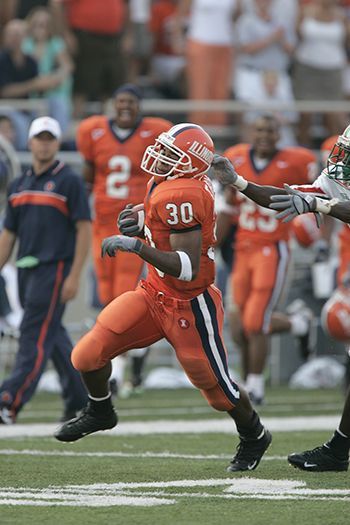
Pierre Thomas
Pierre Thomas: By the Numbers
Dec. 18, 2024
Former Fighting Illini football star Pierre Thomas celebrates his 40th birthday today.
A native of Lynwood, Ill. and an all-stater at Thornton Fractional South High School, he never earned more than honorable All-Big Ten honors at Illinois despite finishing his career as the No. 6 all-time rusher for the Illini.
Thomas trivia, by the numbers:
1 His ranking on Illinois’ career kickoff return yardage list
2 Seasons he was Illinois’ Most Valuable Player (2004 and ’05)
9 Number of career 100-yard rushing games at Illinois
20 Number of rushing touchdowns he scored as an Illini
21 Number of TDs he’s scored for the Saints
23 His jersey number with the New Orleans Saints
30 His jersey number at Illinois
XLIV The Super Bowl game in which he played for the Saints
88 Number of touchdowns he scored in high school
99 Longest kickoff return (vs. Western Michigan, 9/18/04)
2,545 Career rushing yardage at Illinois

Cory Bradford
That's a Three ... Cory Bradford
Dec. 16, 2024
Twenty-four years ago today - Dec. 16, 2000 - fifth-ranked Illinois defeated seventh-ranked Arizona, 81-73, in a battle royale at Chicago’s United Center. Five near skirmishes between the Illini and the Wildcats resulted in 53 total fouls.
A crowd of 19,533 saw Cory Bradford break the NCAA record for consecutive games with a three-pointer. His trey late in the first half was his 74th in 74 career games, breaking Wally Lancaster’s 14-year-old record.
Bradford would go on to sink three-point field goals in 14 more games, setting a record that still stands today. A review of his “trey-mendous” streak:
*First game with a “three”: Nov. 11, 1998 vs. Wake Forest
*Last game with a “three”: Feb. 10, 2001 vs. Purdue
*Game in which his streak ended: Feb. 13, 2001 vs. Wisconsin
*When his first “three” came in overtime: Dec. 9, 2000 vs. Seton Hall
*Game in which the NCAA record was tied: Dec. 9, 2000 vs. Seton Hall
*Game in which the NCAA record was broken: Dec. 16, 2000 vs. Arizona

Dike Eddleman
Dike Eddleman & The National High School Hall of Fame
Dec. 13, 2024
Forty-one years ago today—Dec. 13, 1983—Fighting Illini legend Dwight “Dike” Eddleman was inducted into the National High School Hall of Fame.
Included among the second-ever class initiated into the Indianapolis-based organization, Eddleman was one of the first six prep athletes received. The Centralia, Ill. native joined an elite group that included Oscar Robertson of Indiana, Jesse Owens of Ohio, Bill Bradley of Missouri, Jim Ryan of Kansas and Ken Hall of Texas.
Eddleman’s high school coach, Arthur Trout, was one of 13 coaches, officials and administrators in the charter class of 1982.
Dike lettered in football, basketball and track and field from 1939-42. He was a three-time Illinois high school state high jump champion, while his 2,702 points in basketball led Centralia High to three state tournament berths and to the 1942 Illinois state title.
At the University of Illinois, Eddleman helped the Illini win the 1947 Rose Bowl, captained a Final Four hoops squad in 1949, and earned a medal at the 1948 Summer Olympic Games in London.
December 27 will mark the 102nd anniversary of Dike's birth. He died in 2001.
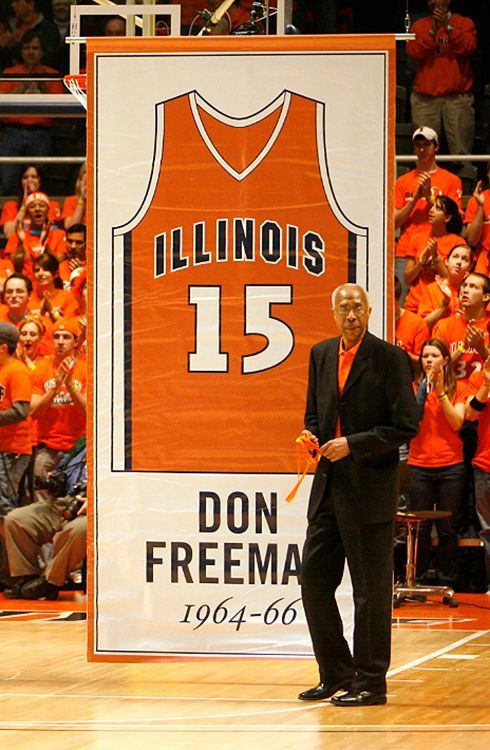
Don Freeman
Don Freeman
Dec. 11, 2024
Fifty-nine years ago today - Dec. 11, 1965 - Illinois’ Don Freeman scored 35 points as the Fighting Illini topped previously undefeated West Virginia, 96-86. Among his points were 15 free throws in 16 attempts.
Freeman, a native of Madison, Illinois, wound up his three-year Illini basketball career with a school record 1,449 points, including a single-season record 668 points in 24 games his senior year (1965-66). That mark stood until 2024 when Terrence Shannon Jr. scored 736 points in 32 games.
In 72 collegiate games, Freeman averaged 20.1 points per game.
The 6-3 guard played pro ball for eight different teams from 1968-76 and scored more than 12,000 points.
Freeman was inducted into the Illini Athletics Hall of Fame in 2019.
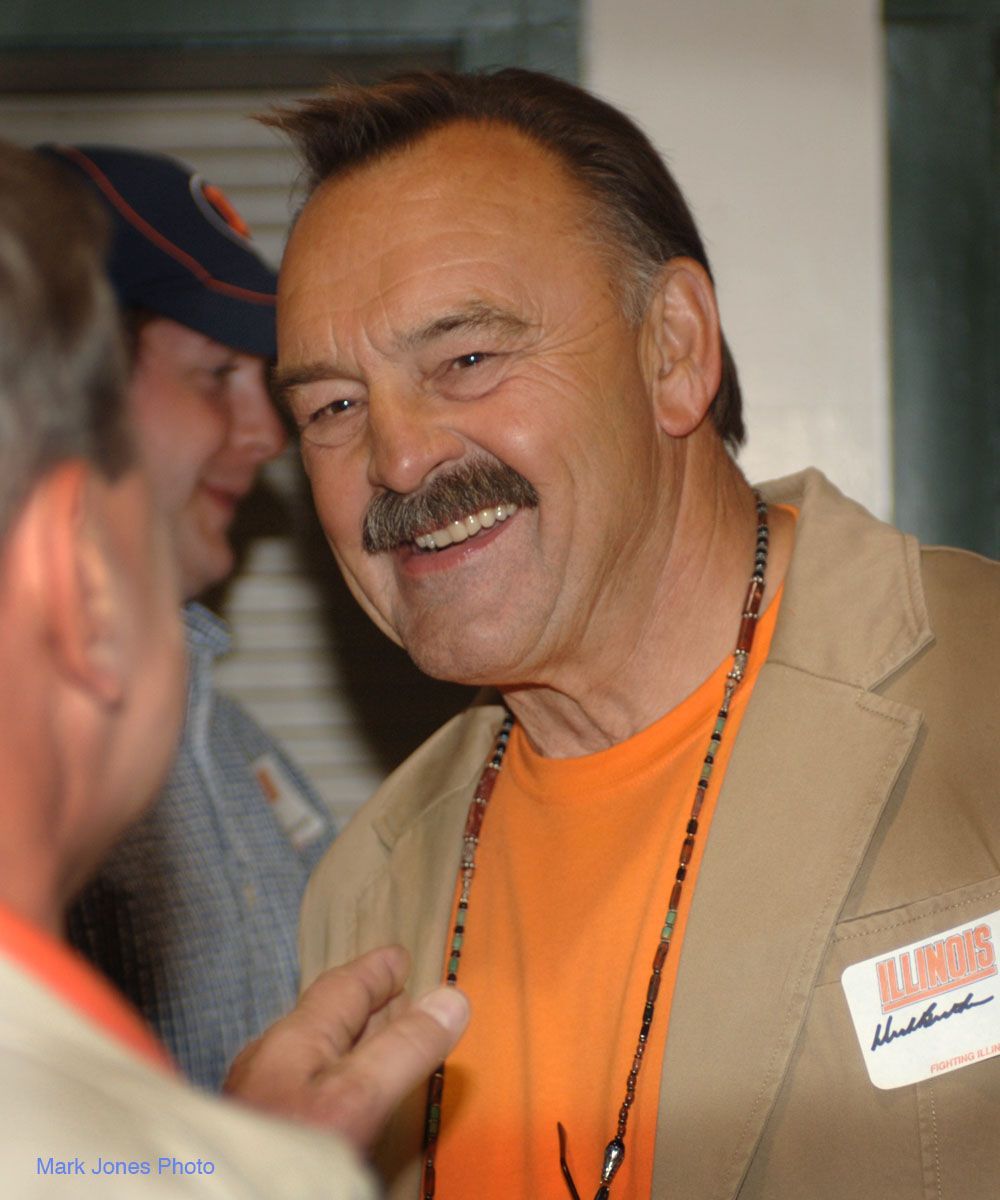
Dick Butkus
Illinois' Butkus Family
Dec. 9, 2024
Today would have been the 82nd birthday of former Fighting Illini football star Dick Butkus. Since Dick last wore Illinois’ orange and blue from 1962-64, two of his nephews have starred for the Illini gridders. Mark lettered four times from 1980-83 as a defensive tackle and his cousin, Luke, earned four varsity monograms as an offensive center, from 1998-2001. Charting the Butkus family:
•Butkus jersey numbers: Luke, #71; Mark, #53; Dick, #50
•The tallest Butkus: Mark and Luke, 6’4” (Dick, 6’3”)
•The heaviest Butkus: Luke, 287 pounds (Mark, 260 pounds; Dick, 234 pounds)
•The best overall record: Mark, 27-18-1, .598 (Dick, 16-11-1, .589; Luke, 26-20-0, .565)
•The best Big Ten record: Mark, 24-11-0, .686 (Dick, 11-9-1, .548; Luke, 15-17-0, .469)
•The best home-field record: Mark, 15-6-0, .714 (Dick, 8-5-0, .615; Luke, 15-9-0, .625)
•Most tackles: Dick, 374 (Mark, 207; Luke, never played defense)
•Most All-Big Ten selections: Dick, 1963 and 1964 (Mark, 1983; Luke, 2001)
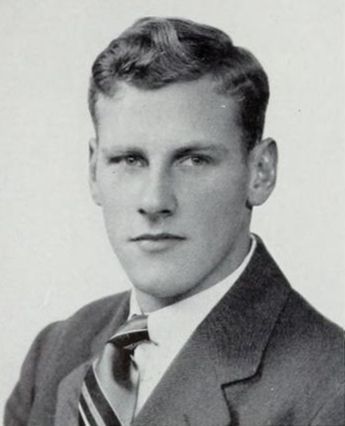
Bill Richart
Bill Richart
Dec. 6, 2024
Born on this date 106 years ago today—Dec. 6, 1918—was Frank “Bill” Richart. He was the University of Illinois’ Big Ten Conference Medal of Honor winner in 1940.
Richart, an athlete at Urbana High School, helped lead the Fighting Illini golf team to the league title in 1940. He also lettered for Illinois in 1939 and1946.
Richart served active duty at the Naval Aircraft Factory in Philadelphia for three and a half years during World War II, then returned to school at Illinois.
Richart, whose father was a professor at the U of I, earned B.S., M.S. and Ph.D. degrees in engineering, then taught for three years at Harvard University. While in Cambridge, he worked on developing a series of early warning radar stations that were eventually used to detect incoming Soviet bombers during the Cold War.
In 1952, Richart left Harvard for the University of Florida to teach the first college course fully devoted to soil dynamics. After 10 years at Florida, he was hired at the University of Michigan where he taught and did research for the remaining 24 years of his career. He received many awards from the American Society of Civil Engineering, including the highest award in his specialty field, the Terzaghi Award.
As a post-collegiate golfer, he was both the Ann Arbor City Champion and State of Michigan Senior Champion. Richart died at age 75 in 1994.
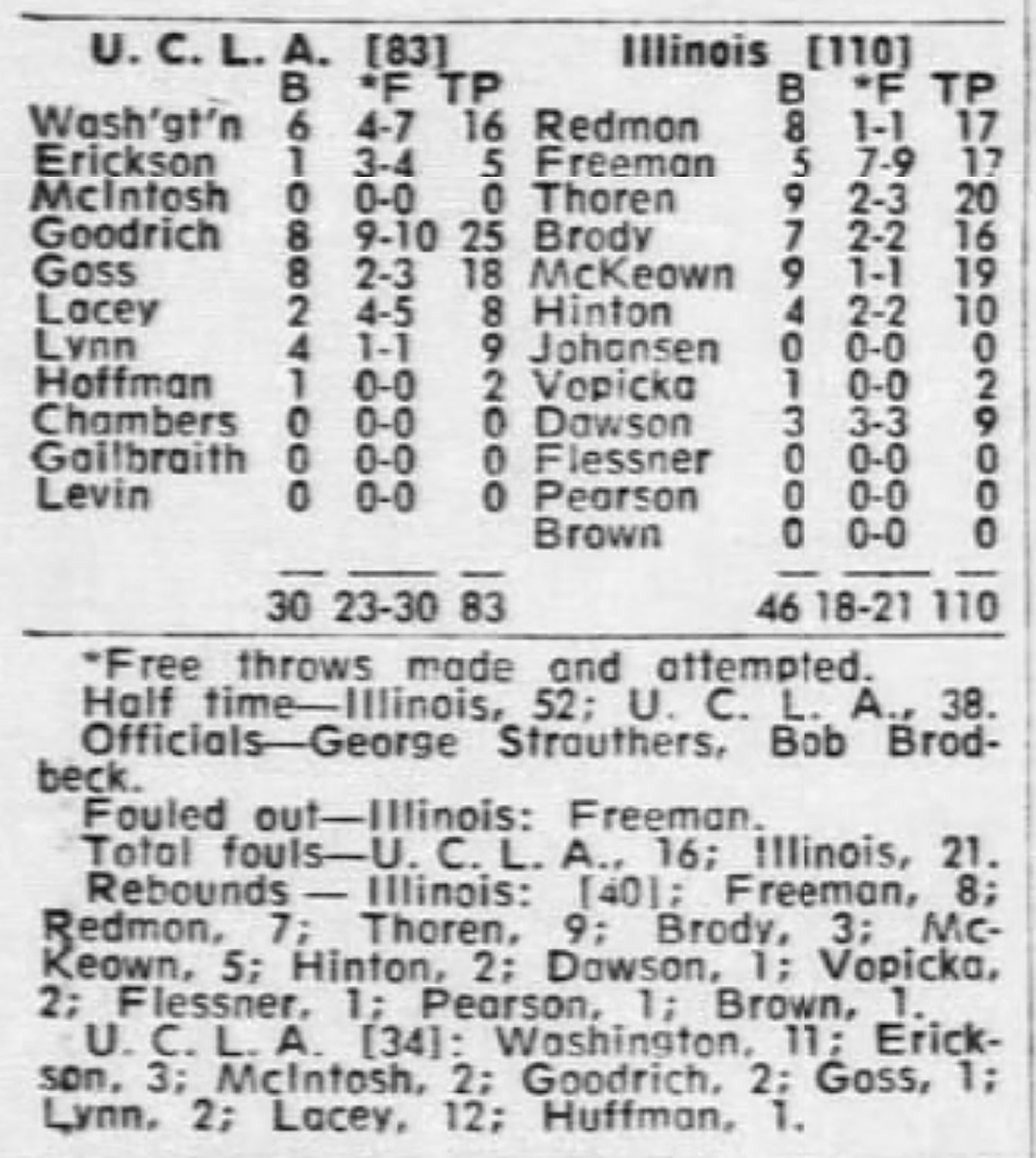
1964 Illini vs. Bruins Box Score
1964 Illinois-UCLA Game
Dec. 4, 2024
Sixty years ago today—Dec. 4, 1964—the Fighting Illini hit a single-game percentage record of its shots and broke defending NCAA champion UCLA’s 30-game winning streak, defeating Coach John Wooden’s Bruins by a score of 110 to 83 at the Assembly Hall.
Though UCLA guard Gail Goodrich took game honors with 25 points on eight field goals and nine of 10 free throws, Illinois’ beautifully balanced attack from six individuals in double figures was the story of the day. Hitting long shots over UCLA’s deep-sag defense, Coach Harry Combes’ team cashed in on 46 of its 79 shots for a school record efficiency of 58.2 percent. UI’s previous varsity mark was 56.3 percent against Butler in 1958.
Illini center Duane “Skip” Thoren tallied 20 points to pace the home team to its Friday night massacre in Champaign. He was closely followed in the scoring ledger by Bill McKeown’s 19 points, then 17 apiece from Don Freeman and Bogie Redmon, 16 from Tal Brody, and 10 from Larry Hinton.
The Illini would go on to finish the 1964-65 season with an 18-6 record and a 10-4 mark in Big Ten Conference play.
Wooden’s Bruins seemed to miss the steady direction of graduated All-America guard Walt Hazzard that evening against Illinois, but rebounded successfully the following day to beat host Indiana State, 112-76. then rattled off 12 more wins in a row before a Jan. 29 loss against Iowa on a neutral court. After that second loss, UCLA won its last 15 straight, including a 91-80 victory over Cazzie Russell’s Michigan team in the NCAA championship game.
UCLA would “slump” to a disappointing 18-8 record in 1965-66, but amazingly went on to be crowned back-to-back-to-back-to-back-to-back-to-back NCAA champs in 1966-67 (30-0), ‘67-68 (29-1), ‘68-69 (29-1), ’69-70 (28-2), ’70-71 (29-1), ’71-72 (30-0) and ’72-73 (30-0).
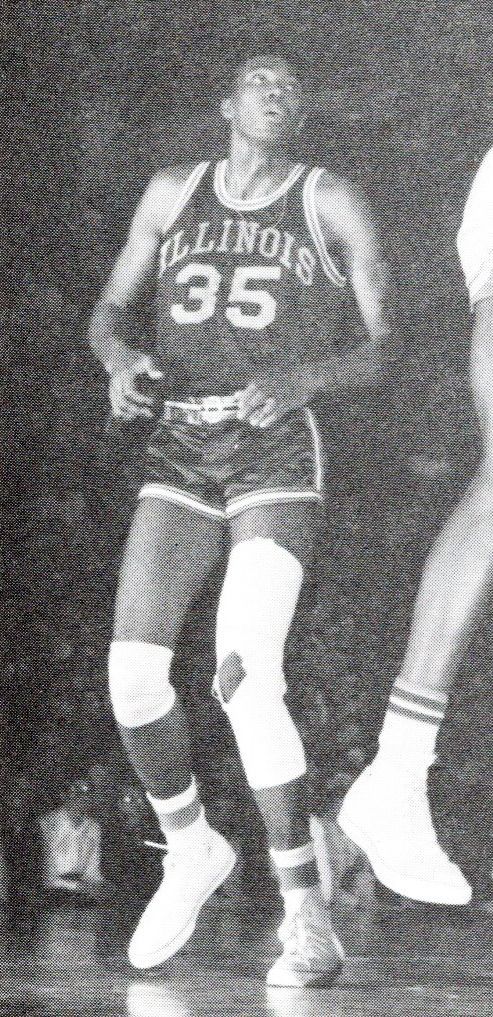
Ron Dunlap
Ron Dunlap
Dec. 2, 2024
Though he never realized his basketball potential with the Fighting Illini, Ron Dunlap wisely used his education to learn a lesson from what is considered to be one of the darkest periods in University of Illinois history.
The 6-foot-8-inch junior center from Chicago’s Farragut High School appeared to be blossoming into an outstanding player in December of 1967. After five games, Coach Harry Combes’ Illini had compiled a 4-1 record, including a 98-97 overtime victory over powerful Kentucky in Lexington. Dunlap was averaging 15 points and 12 rebounds per game, but his dream season almost instantly turned into a nightmare.
What would infamously become known as the "slush fund scandal” exposed that seven Illini athletes, including Dunlap, had been provided with small monthly stipends to assist them in school. At the time, the just-turned-21-year-old Dunlap was married and was the father of a daughter at the time.
Dunlap later told The News-Gazette’s Loren Tate that "It hadn't really occurred to me that I was doing anything wrong. When you're young, you respect your elders."
Ultimately, a trio of Illini coaches—Combes, assistant basketball coach Howie Braun and head football coach Pete Elliott—resigned under pressure, and the athletes lost their remaining eligibility to play in the Big Ten.
Several college coaches called upon Dunlap, but he decided to instead continue his scholarship and ready himself for his future. He graduated in 1968 from the U of I with a teaching degree. Dunlap was drafted by the Chicago Bulls in the second round of the 1968 NBA Draft. He also played briefly for the Phoenix Suns and the New York Nets, the later in the ABA with the Rockford Royals and with Israel in the European Leagues.
Following his brief basketball career, Dunlap spent several years teaching in his native Chicago. To supplement his family’s income, he began a long career as an umpire in Chicago’s famed 16-inch softball leagues, eventually being inducted into that association’s Hall of Fame. Dunlap became principal of Lincoln Elementary School in Appleton, Wisconsin in 1990. In 2011, he left his principal’s position and became minority services coordinator for the Appleton Area School District.
Born on this date in 1946, Dunlap died in 2019 at the age of 73.

Dick Butkus
Dick Butkus and the 1963 All-America Team
Nov. 25, 2024
Sixty-one years ago today - Nov. 25, 1963 - Fighting Illini linebacker Dick Butkus was named to the American Football Coaches Association’s All-America Football Team. No. 50’s 145 tackles that season stood as the school’s single-season record until 1976. Later in the ’63 season, the junior from Chicago was awarded the Silver Football Award as the Big Ten’s Most Valuable player. Others joining Butkus as first-team All-Americans in 1963 included:
End Vern Burke, Oregon State
End Lawrence Elkins, Baylor
Tackle Scott Appleton, Texas
Tackle Carl Eller, Minnesota
Guard Bob Brown, Nebraska
Guard Rick Redman, Washington
CENTER DICK BUTKUS, ILLINOIS
Back Roger Staubach, Navy
Back Gayle Sayers, Kansas
Back Sherman Lewis, Michigan State
Back Jim Grisham, Oklahoma
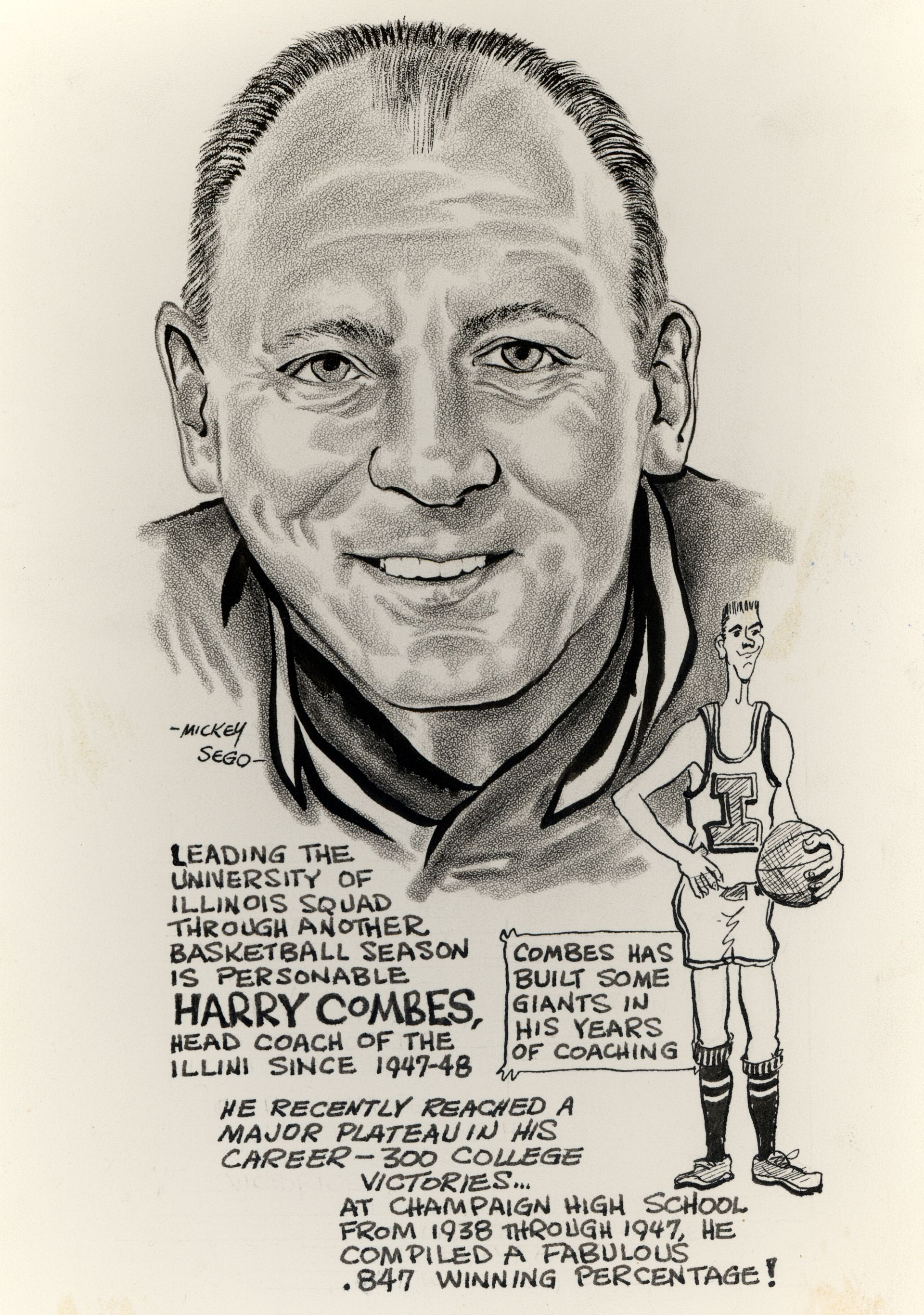
Harry Combes
Harry Combes
Nov. 13, 2024
Forty-seven years ago today - Nov. 13, 1977 - former Fighting Illini basketball coach Harry Combes died at the age of 62.
The Monticello, Illinois native played guard and forward on the University of Illinois teams of 1935, ’36 and ’37, twice leading the Illini to Big Ten Conference titles. An All-Big Ten selection his junior and senior seasons, Combes also won the Conference Medal of Honor for proficiency in athletics and scholarship his final year.
Two years after his graduation, he began a highly successful nine-year prep coaching career at Champaign High School.
Combes succeeded Doug Mills as Illinois’ basketball coach in 1947 and led the Illini to Conference titles in three of his first five seasons. In 1949, ’51 and ’52, UI basketball clubs finished third at the NCAA tournament each year. Combes’s 20-year coaching record at Illinois was 316 wins and 150 losses, a mark that stood as the Illini record until it was broken by Lou Henson.

Memorial Stadium's colonnade
Veterans Day and the U of I
Nov. 11, 2024
Observed annually on November 11, Veterans Day (known as Armistice Day until 1954) was initiated by President Woodrow Wilson in 1919, exactly one year after World War I ended at the 11th hour of the 11th day of the 11th month.
Military training has been part of the University of Illinois curriculum for its entire history. Prior to UI instituting its Reserve Officers Training Corps (ROTC) program in 1917, the 1862 Morrill Act obligated land-grant universities to instruct its male students in military tactics.
UI students have faithfully answered the call into the nation’s armed forces. More than 9,000 Illini served in World War I and more than 20,000 entered service in World War II.
Altogether, 1,121 UI students have died in service, including 184 during World War I, 844 during World War II, 22 during the Korean War, 64 during the war in Viet Nam, and seven in other world hostilities.
Hundreds of Illinois’s student-athletes have been in uniform and at least five letter winners have been killed. The list of honored Illini athletes includes:
EDWARD WALLACE: Wallace lettered in baseball in 1911 for Coach George Huff and graduated in 1913. He rose to the rank of First Lieutenant in the Army and served with the 146th Field Artillery Regiment, 41st Division. Wallace died on Sept. 13, 1918, at the age of 28, just two months before the end of World War I. He is buried at Suresnes American Cemetery in France, Plot B, Row 16, Grave 6. His name is on one of the columns at Memorial Stadium.
HOMER WAHLSTON DAHRINGER: A native of Waukegan, Dahringer lettered in basketball in 1912 and ’13, and served in World War I. After taking artillery instruction at Samur, France, Lt. Dahringer was assigned to the First Aero Squadron. While on an observation mission, he died at the age of 28 on Sept. 17, 1918, just four days after Wallace’s death. His name is etched on one of the columns at Memorial Stadium and he is buried at Pineview Memorial Park in Lake County, Illinois.
ROBERT FERN RICHMOND, JR.: A letter winner in 1939 and ’41 for Coach Doug Mills’ Illini basketball team, Richmond was an African invasion veteran for the U.S. Navy, rising to the rank of Lieutenant. On May 16, 1944, he died at the age of 24 in a Navy plane crash in Virginia. Richmond is buried at the Lakeview Cemetery in Johnston City, Ill.
ANTHONY JAMES BUTKOVICH: A star running back for Coach Ray Eliot in 1941 and ’42, he was transferred for military training to Purdue University. In 1943, he led the Boilermakers and the nation in rushing in with 833 yards, scoring a record 16 touchdowns. Butkovich was a first-round selection in the 1944 National Football League Draft, but instead enlisted in the U.S. Marines. As a Corporal with the 6th Marine Division, 29th Regiment, he was killed in action on Apr. 18, 1945 at Okinawa. He is buried at St. Mary’s Cemetery in Canton, Ill.
JOHN BRUCE CAPEL: A three-time letter winner in the 1960s, Capel played on Illinois’s 1963 Big Ten and 1964 Rose Bowl championship team. He enlisted with the Marine Corps at age 23 and was sent to Vietnam in 1966. That year, on May 12, Lt. Capel died in combat when he was leading a 14-man patrol which was ambushed southwest of Da Nang by a large force of Viet Cong. Each year since 1967, the Illini football team recognizes their most courageous player with the Bruce Capel Award. He’s honored on Panel 7E, Line 51, of the Vietnam Veterans Memorial in Washington, DC. The Glen Ellyn native is buried at his hometown’s Forest Hill Cemetery.
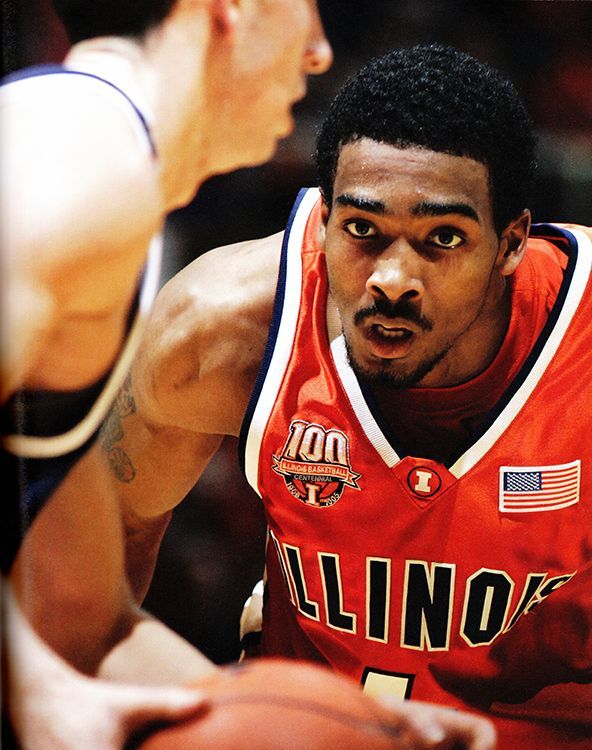
Luther Head
Luther Head
Nov. 8, 2024
Twenty-four years ago today - Nov. 8, 2000 - the University of Illinois signed Luther Head to a national letter of intent to play basketball.
As a Fighting Illini freshman for Coach Bill Self, he averaged 4.5 points and 1.9 rebounds while ranking second on the team in steals with 34.
Despite missing seven games due to a pelvic injury during his sophomore season, Head averaged 7.9 points and 2.8 rebounds, then boosted those numbers to 11.0 points and 3.8 rebounds as a junior.
During his fabulous senior campaign in 2004-05, Head was named First-Team All-Big Ten by the media and the league coaches, leading the Illini with an average of nearly 16 points per game. He set an Illinois single-season record with 116 three-point field goals made, including six treys in the NCAA semifinal game against Louisville. Head earned Consensus Second-Team All-America honors and made the NCAA Chicago Regional Team, as well as the Final Four All-Tournament Team.
He finished his collegiate career at Illinois as the school’s 19th all-time leading scorer with 1,295 points, ranked fourth in three-point field goals made (209) and ninth in steals (158). Head left Illinois as the school record holder for career NCAA Tournament games played (14) and points scored (162).
Drafted by Houston in the first round (24th overall) of the 2005 NBA Draft, he played with the Rockets for four seasons, averaging 9.9 points and 2.6 assists in 255 games. Head split the 2008-09 season between Houston and the Miami Heat, then played 47 games for the Indiana Pacers in 2009-10. He completed his NBA career with the Sacramento Kings in 2010-11.
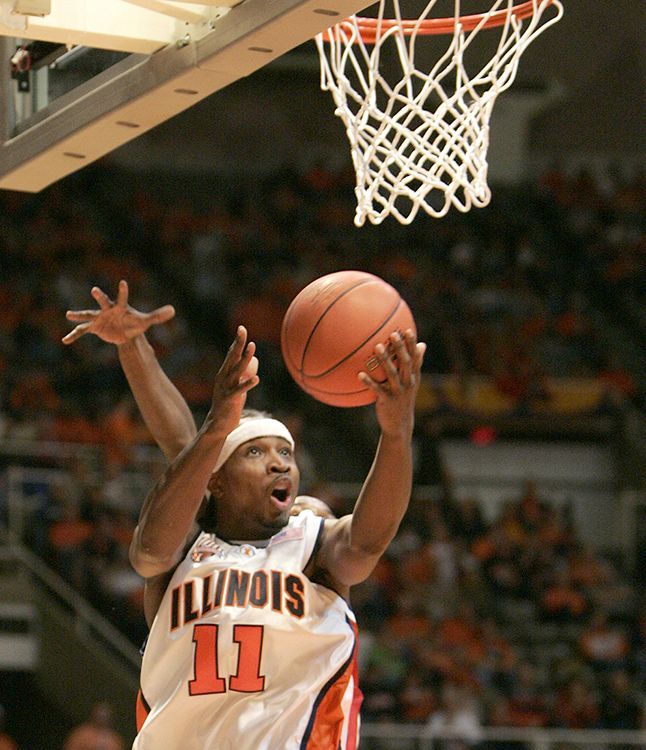
Dee Brown
Dee Brown's 2004-05 Season
Nov. 6, 2024
Illinois basketball’s Dee Brown appeared in all 39 games during the 2004-05 season, leading the Fighting Illini men to an historic 37-2 record.
He was overwhelmingly productive in a great majority of the games, earning him consensus first-team All-America honors. While onlookers can only subjectively identify Brown’s best overall games, Illini Legends, Lists & Lore attempts to quantify his top performances of 2004-05, based on the following points system:
INDIVIDUAL PERFORMANCE POINTS
Two-point field goals = +2 points each (-2 points for each miss)
Three-point field goals = +3 points each (-3 points for each miss)
Free throws made = +1 point each (-1 for each miss)
Assists = +2.5 points each
Steals/Rebounds/Blocks = +1 point each
Turnovers = -2.5 points each
TEAM PERFORMANCE POINTS
Victory over ranked team = +10 points (-5 points for loss to ranked team)
Victory over unranked team = +5 points (-10 points for loss to unranked team)
Victory at home = +1 point (-3 points for loss at home)
Victory on neutral court = +2 points (-2 points for loss on neutral court)
Victory on road = +3 points (-1 point for loss on road)
Opp. (Date) Score IndiPts+TeamPts =TotalPts
At Penn State (2/16/05) – UI 83, PSU 63 ….. 38+8= 46 total performance points
Vs. Gonzaga (11/27/04) – UI 89, GU 72 ….. 32+12= 44 total pts
Wake Forest (12/1/04) – UI 91, WF 73 ….. 25.5+11= 36.5 total pts
Chicago State (12/6/04) – UI 78, CSU 59 … 30+6= 36 total pts
Valparaiso (12/19/04) – UI 93, VU 56 ….. 27.5+6= 33.5 total pts
Longwood (12/27/04) – UI 105, LU 79 ….. 27.5+6= 33.5 total pts
Vs. Oregon (12/11/04) – UI 83, UO 66 ….. 23+6= 29 total pts
Northwestern (2/23/05) – UI 84, NU 48 ….. 21+6= 27 total pts
Ohio State (1/5/05) – UI 84, OSU 65 ….. 20+6= 26 total pts
Purdue (3/3/05) – UI 84, PU 50 ….. 19+6= 26 total pts
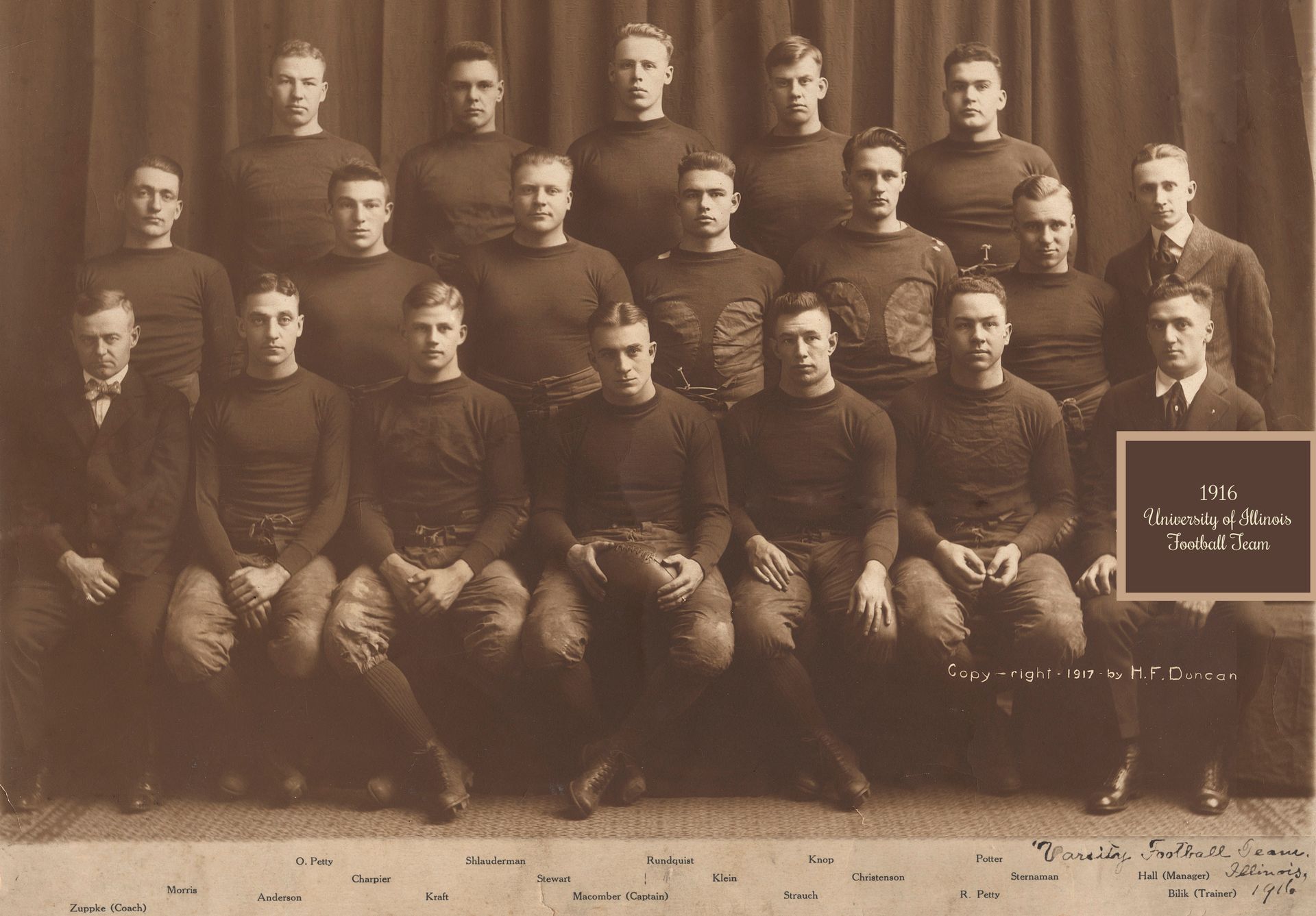
1916 Fighting Illini Football Team
Illini Defeat Minnesota's "Perfect Team"
Nov. 4, 2024
One-hundred-eight years ago today - Nov. 4, 1916 - the University of Illinois football team registered perhaps the biggest upset in school history. Coach Bob Zuppke’s squad was the defending Big Ten champ, but had lost most of its greatest stars to graduation, including Ralph Chapman, Harold Pogue and Potsy Clark. UI entered the game at Minneapolis with a modest record of 2-2 while the powerful Gopher squad had an unblemished mark of 4-0, having rolled over its competition by a points margin of 236 to 14. The Illini, who played the entire game with the same 11 men, jumped out on top of Minnesota, 14-0, then withstood a furious Gopher comeback. Illinois captain Bart Macomber admitted years later that he had purposely used stall tactics in the closing minutes, untying his shoes, breaking the string on his shoulder pads, losing his head gear, and miscalling signals in order to kill time. Other than its 14-9 loss that day to Illinois, Minnesota outscored its other six opponents 337-14.
Other unlikely Illini victories:
Nov. 18, 1950: Illinois 14, No. 1 Ohio State 7
(OSU outscored its other eight opponents, 279-97)
Nov. 5, 1955: Illinois 25, No. 1 Michigan 6
(UM outscored its other eight opponents, 173-69)
Oct. 27, 1956: Illinois 20, No. 1 Michigan State 13
(MSU outscored its other eight opponents, 226-67)
Oct. 1, 1983: Illinois 33, No. 4 Iowa 0
(Iowa outscored its other 11 opponents, 362-156)
Oct. 23, 1993: Illinois 24, No. 13 Michigan 21
(UM outscored its other 11 opponents, 321-136)
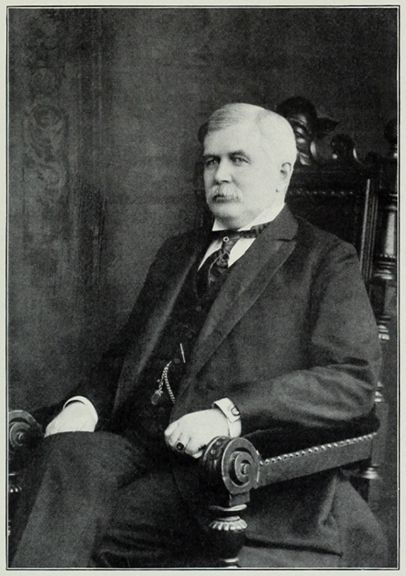
President Andrew Draper
President Andrew Draper
Nov. 1, 2024
Andrew Sloan Draper served as the University of Illinois president during the some of the most formative years of the Fighting Illini athletics program.
UI’s Board of Trustees unanimously hired the 46-year-old on Apr. 13, 1894 to replace Acting Regent Thomas Burrill. Draper had served as Superintendent of Public Instruction in Cleveland and had established a distinguished career in both law and education. A house was built for him at the northeast corner of Wright and Green streets.
During the 10-year Draper administration, the university added a library building (currently known at Altgeld Hall), agriculture, engineering and chemistry buildings, and a Women’s Building (now called Bevier Hall). Colleges in medicine, dentistry, commerce and law were established while Draper served as president, while improvements included an automated university telephone system, the installation of a centralized power plant, addition of electricity in campus buildings, and the launching of UI’s student-operated newspaper, The Illini.
Intercollegiate athletics made huge strides during President Draper’s decade of service. A major highlight included Illinois’s charter membership in the Intercollegiate Conference of Faculty Representatives (eventually known as the Big Ten) in 1896.
On Nov. 1, 1894—130 years ago today—President Draper asked the student body to officially accept orange and navy blue as the university’s colors.
Draper resigned from his post in 1904 to become the State of New York’s Commissioner of Education. He died nine years later at the age of 64.
University of Illinois Presidents
1867-1880 – John M. Gregory
1880-1891 – Selim H. Peabody
1891-1894 – Thomas J. Burrill
1894-1904 – Andrew S. Draper
1904-1920 – Edmund J. James
1920-1930 – David Kinley
1930-1933 – Harry W. Chase
1933-1934 – Arthur H. Daniels
1934-1946 – Arthur C. Willard
1946-1953 – George D. Stoddard
1953-1955 – Lloyd Morey
1955-1971 – David D. Henry
1971-1979 – John E. Corbally, Jr.
1979-1995 – Stanley O. Ikenberry
1995-2005 – James J. Stukel
2005-2009 – Bernard J. White
2010 - Stanley O. Ikenberry (interim)
2010-2012 – Michael J. Hogan
2012-2015 – Robert A. Easter
2015-Present – Timothy L. Killeen
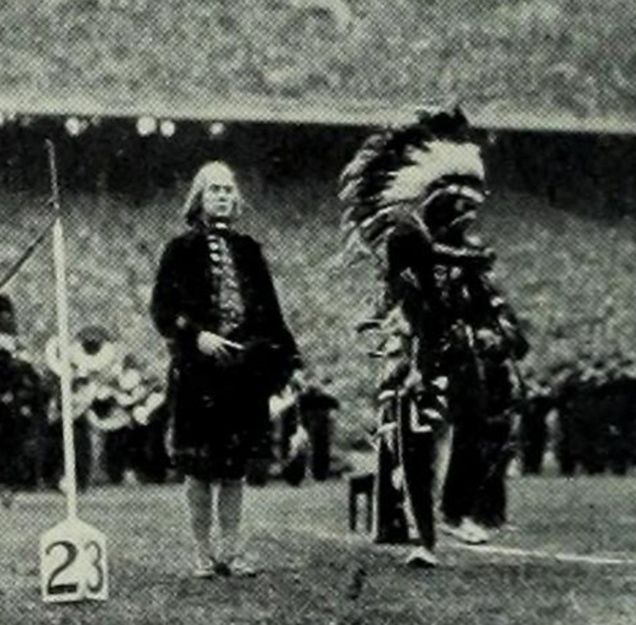
Chief Illiniwek, as portrayed by Lester Leutwiler
Chief Illiniwek's First Performance
Oct. 30, 2024
Ninety-eight years ago today—Oct. 30, 1926—Chief Illiniwek made his first appearance at a Fighting Illini athletic event.
Lester Leutwiler, son of University of Illinois professor O.A. Leutwiler, was the individual who performed the role. UI assistant marching band director Ray Dvorak is credited with starting the tradition.
In his recollection of that first performances, Leutwiler wrote, “As the band marched into the formation (spelling out the word “Penn”), the Chief ran from a hiding place north of the Illinois stands and led the band with his frenzied dance. The band stopped in the center of the field and played ‘Hail Pennsylvania’ while the Chief saluted the Penn rooters. William Penn, impersonated by George Adams (the Illinois drum major), came forward and accepted the gesture of friendship. Together, we smoked the peace pipe and walked arm in arm across the field to the Illinois side, amidst a deafening ovation.”
Leutwiler’s performance was so well received that he was asked to continue his performances at Fighting Illini football games, and he did so through the 1928 season.
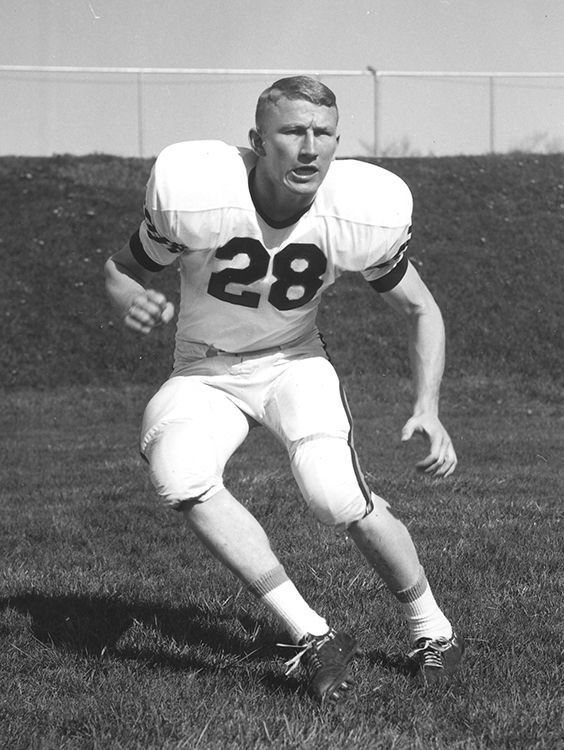
Phil Knell
Phil Knell
Oct. 28, 2024
Fifty-eight years ago this week—Oct. 29, 1966—Fighting Illini defensive back Phil Knell set a school record by intercepting three passes from Purdue quarterback Bob Griese. The former Mahomet-Seymour star wound up with a total of seven picks that season, earning second-team All-Big Ten honors.
Combined with the three interceptions he had as a junior in 1965, Knell’s 10 career defensive snags tied him for fourth place on UI’s all-time list with Ron Bess, trailing Al Brosky’s 30 from 1950-52, George Donnelly’s 13 from 1962-64, and Red Grange’s 11 from 1923-25.
Inducted into the Mahomet-Seymour Hall of Fame in 2017, Knell excelled in athletics and academics. In four years as a football starter for Coach Leo Vitali, Bulldog teams were a perfect 32-0. He was a four-year letter winner on the basketball court, scoring a school-record 1,499 points and playing on teams that won three Sangamon Valley Conference titles. On the track, Knell set school records in five different events. He also was his class’s co-valedictorian in 1963.
He’s had a very successful career after graduating from Illinois in 1968, serving as Vice President of Sales and Marketing for Wilson Sporting Goods from 1973-83. Knell then served as a V.P. at ARA Services and Ameritech Cellular. He was President and CEO of Darome Teleconferencing, selling the business to MCI in ’95 for $45 million. He continued working for MCI as President and General Manager of Conferencing from 1995-2006.
Knell served on the Executive Advisory Board of Gryphon Investors in the San Francisco Bay Area from 2003-17. He’s been President of PDK Investments and Consulting in Irvine, Calif. since 2006.
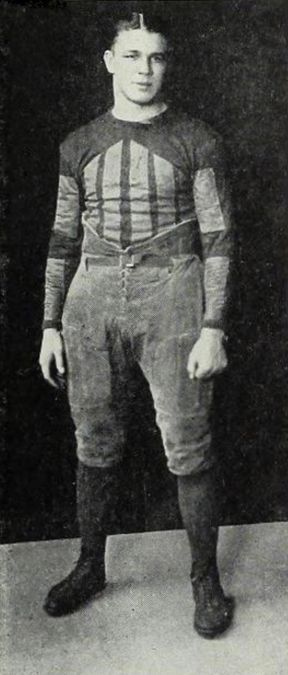
Jim McMillen
Jim McMillen
Oct. 23, 2024
One-hundred-twenty-two years ago today - Oct. 23, 1902 - former University of Illinois football star Jim McMillen was born.
Before Red Grange joined the Illini varsity squad in 1923, McMillen was the team's star, earning All-America honors the season before. The burly all-star guard from Grayslake attended Libertyville High School prior to enrolling at the Urbana-Champaign campus.
During his senior season at Illinois in '23, McMillen created the holes through which Grange ran to fame. Both of the Illini standouts earned consensus All-America honors for Coach Bob Zuppke's 8-0 national champions.
McMillen also earned two letters in wrestling, graduating from Illinois with a degree in engineering. He played pro football from 1924 through 1928 with George Halas and the Chicago Bears, who were world champions in McMillen's rookie season. In 1931, Halas named his standout lineman vice president of the Bears organization. McMillen was a famous professional wrestler from 1924 through 1950 and could have continued with football, but found that wrestling was more lucrative. One of his most famous matches occurred in 1936 when he defeated wrestling legend "Strangler" Lewis.
McMillen served for the U.S. Navy in World War II as a lieutenant commander. He was an active citizen in Antioch, Ill., serving as chief engineer for the Lake County Forest Preserve and holding posts at the high school, on the city's fire department, and later as mayor for six years.
McMillen died in January of 1984 at the age of 81.
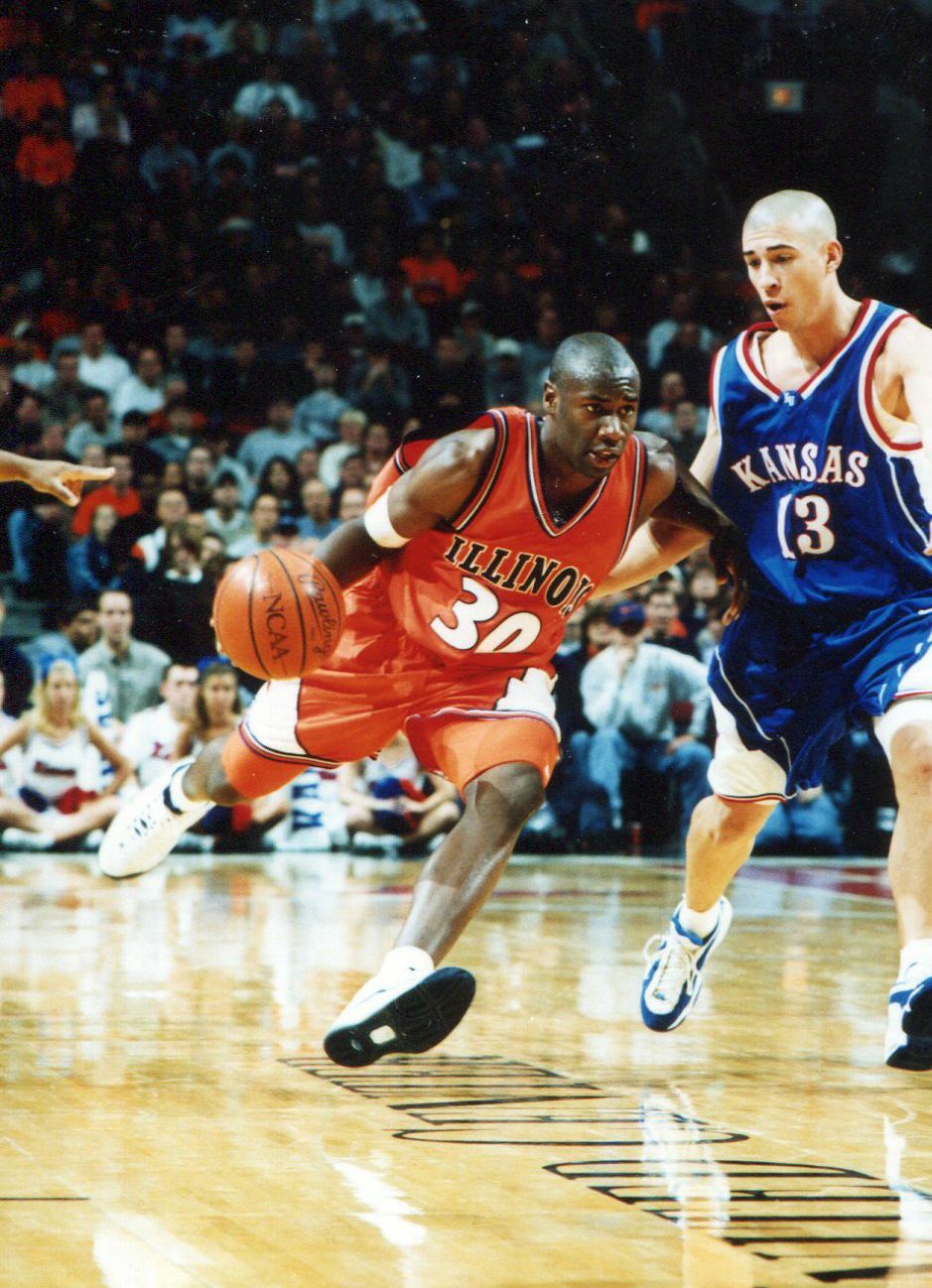
The week before the big game
Frank Williams
Oct. 21, 2024
Twenty-seven years ago today, Peoria Manual High School's Frank Williams committed to play basketball for the University of Illinois. He joined former teammates Sergio McClain and Marcus Griffin, then helped lead the Fighting Illini to three sensational seasons from 1999-2000 through 2001-02. The basketball career of Frank Williams, by the numbers:
2 - Number of times Williams was named Illini MVP
4 - Ended his UI career in fourth place with 212 steals
5 - Illinois' fifth player to win the Big Ten's Silver Basketball Trophy
11 - With 1,440 total points, he finished in 11th place on UI's career scoring list
14.3 - His points-per-game average at Illinois
20 - One of 20 players named to Illinois' All-Century Team
25 - Williams was the No. 25 pick in the 2002 NBA Draft
30 - His jersey number at Illinois
75 - UI's total team victories during Frank's three seasons
432 - Total number of assists Williams had for the Illini
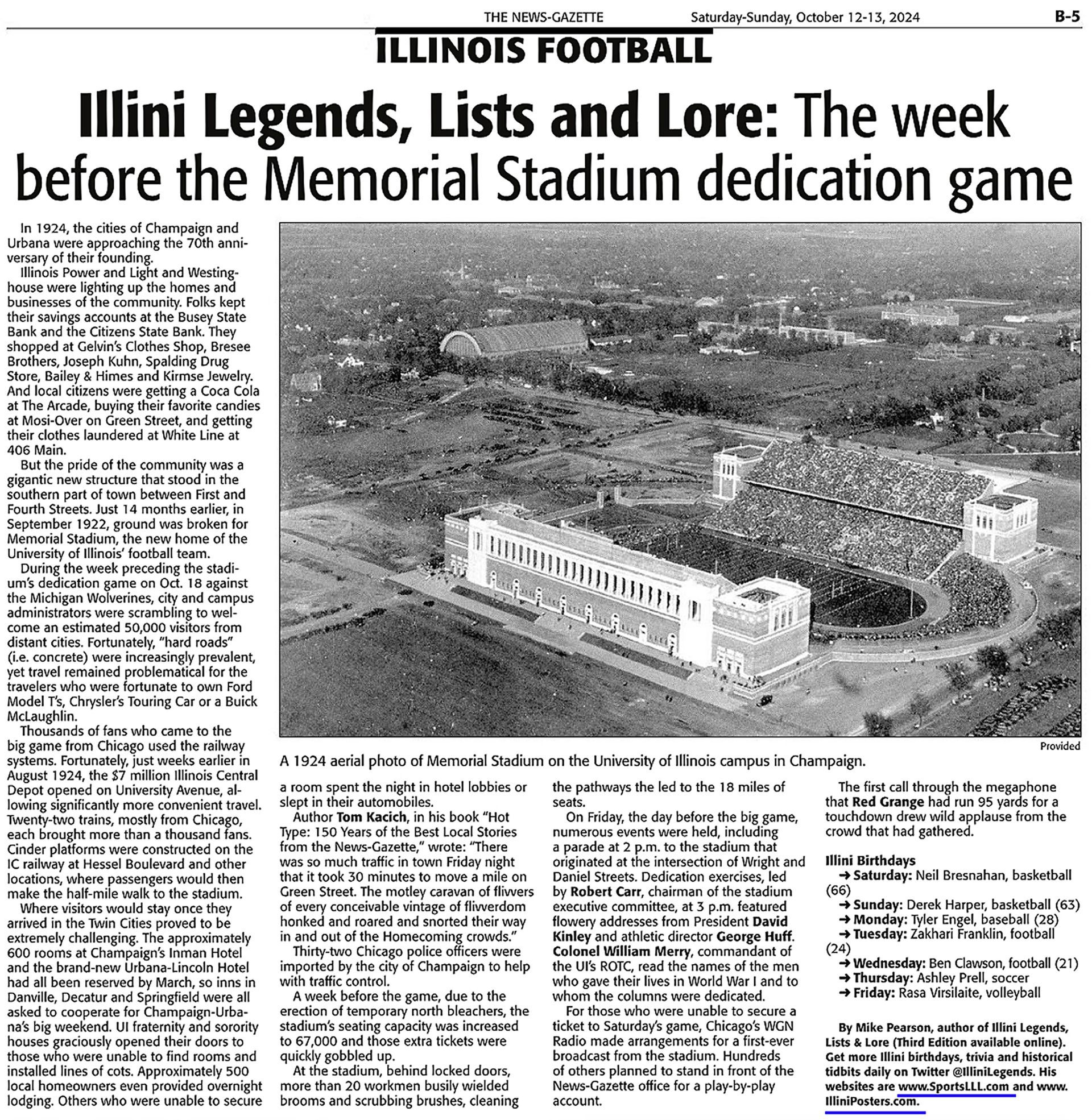
The week before the big game
Flashback to 1924 - The week before the big game
Oct. 18, 2024
In 1924, the cities of Champaign and Urbana were approaching the 70th anniversary of their founding.
Illinois Power and Light and Westinghouse were lighting up the homes and businesses of the community. Folks kept their savings accounts at the Busey State Bank and the Citizens State Bank. They shopped at Gelvin’s Clothes Shop, Bresee Brothers, Joseph Kuhn, Spalding Drug Store, Bailey & Himes and Kirmse Jewelry. And local citizens were getting a Coca Cola at The Arcade, buying their favorite candies at Mosi-Over on Green Street, and getting their clothes laundered at White Line at 406 Main.
But the pride of the community was a gigantic new structure that stood in the southern part of town between First and Fourth Streets. Just 14 months earlier, in September of 1922, ground was broken for Memorial Stadium, the new home of the University of Illinois’ football team.
During the week preceding the stadium’s October 18th dedication game against the Michigan Wolverines, city and campus administrators were scrambling to welcome an estimated 50,000 visitors from distant cities. Fortunately, “hard roads” (i.e. concrete) were increasingly prevalent, yet travel remained problematical for the travelers who were fortunate to own Ford Model T’s, Chrysler’s Touring Car or a Buick McLaughlin.
Thousands of fans who came to the big game from Chicago used the railway systems. Fortunately, just weeks earlier in August of ‘24, the $7 million Illinois Central Depot opened on University Avenue, allowing significantly more convenient travel. Twenty-two trains, mostly from Chicago, each brought more than a thousand fans. Cinder platforms were constructed on the IC railway at Hessel Boulevard and other locations, where passengers would then make the half-mile walk to the stadium.
Where visitors would stay once they arrived in the Twin Cities proved to be extremely challenging. The approximately 600 rooms at Champaign’s Inman Hotel and the brand-new Urbana-Lincoln Hotel had all been reserved by March, so inns in Danville, Decatur and Springfield were all asked to cooperate for Champaign-Urbana’s big weekend. UI fraternity and sorority houses graciously opened their doors to those who were unable to find rooms and installed lines of cots. Approximately 500 local homeowners even provided overnight lodging. Others who were unable to secure a room spent the night in hotel lobbies or slept in their automobiles.
Author Tom Kacich, in his book Hot Type: 150 Years of the Best Local Stories from the News-Gazette, wrote: “There was so much traffic in town Friday night that it took 30 minutes to move a mile on Green Street. The motley caravan of flivvers of every conceivable vintage of flivverdom honked and roared and snorted their way in and out of the Homecoming crowds.”
Thirty-two Chicago police officers were imported by the city of Champaign to help with traffic control.
A week before the game, due to the erection of temporary north bleachers, the stadium’s seating capacity was increased to 67,000 and those extra tickets were quickly gobbled up.
At the stadium, behind locked doors, more than 20 workmen busily wielded brooms and scrubbing brushes, cleaning the pathways the led to the 18 miles of seats.
On Friday, the day before the big game, there were numerous events, including a 2 o’clock parade to the stadium that originated at the intersection of Wright and Daniel Streets. Three o’clock dedication exercises, led by Robert Carr, chairman of the stadium executive committee, featured flowery addresses from President David Kinley and Athletics Director George Huff. Colonel William Merry, commandant of the U of I’s ROTC, read the names of the men who gave their lives in World War I and to whom the columns were dedicated.
For those who were unable to secure a ticket to Saturday’s game, Chicago’s WGN Radio made arrangements for a first-ever broadcast from the stadium. Hundreds of others planned to stand in front of the News-Gazette office for a play-by-play account.
The first call through the megaphone that Red Grange had run 95 yards for a touchdown drew wild applause from the crowd that had gathered.
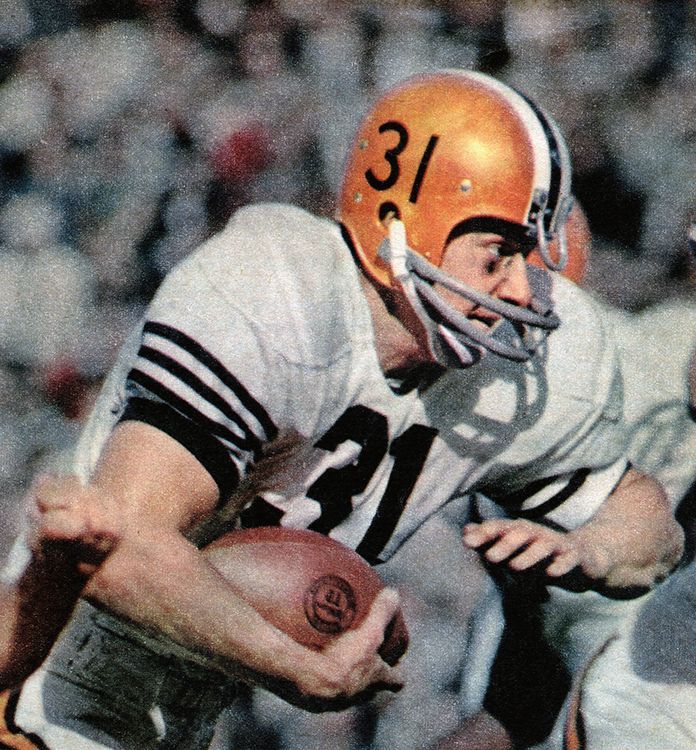
Jim Grabowski
Jim Grabowski's Greatest Games
Oct. 16, 2024
Fifty-nine years ago today - Oct. 16, 1965 - Jim Grabowski banged out 186 yards and two touchdowns on 30 carries to pass Red Grange’s career rushing record at Illinois. The host Fighting Illini beat Indiana by a score of 34-13. Overall, this was “Grabo’s” fourth-best game in terms of rushing yardage at Illinois. Number 31’s top 12 collegiate rushing performances:
239 yards Vs. Wisconsin, 11/14/64
196 yards At Wisconsin, 11/13/65
187 yards At Northwestern, 11/20/65
186 yards Vs. Indiana, 10/16/65
185 yards Vs. Michigan State, 11/21/64
171 yards Vs. UCLA, 10/24/64
163 yards Vs. Purdue, 10/30/65
127 yards Vs. Southern Methodist, 9/25/65
125 yards Vs. Washington, 1/1/64 (Rose Bowl)
125 yards At Michigan State, 10/2/65
110 yards At California, 9/26/64
104 yards At UCLA, 10/25/63
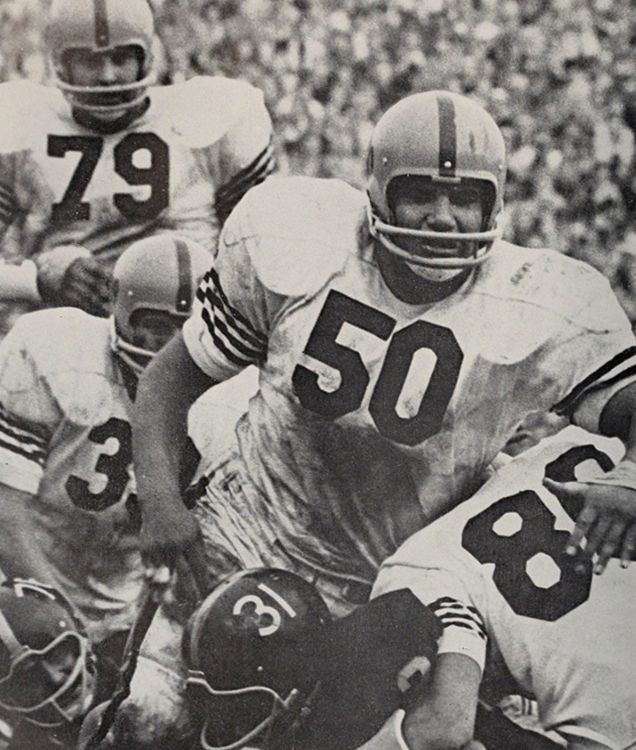
Tony Parrilli
Tony Parrilli
Oct. 14, 2024
On this date 63 years ago—October 14, 1961—Illini senior linebacker Tony Parrilli recorded 22 tackles, but he and his team fell by a score of 44-0 to host Ohio State in both team’s Big Ten season opener at Columbus. The Buckeyes went on to an 8-0-1 record and finished second in the national rankings.
Parrilli, a 5-11, 217-pound graduate of Proviso East High School, performed so spectacularly in his final collegiate season that his teammates selected him as the team’s Most Valuable Player. United Press International additionally selected him to its 1961 first-team All-Big Ten squad and as an honorable mention member of its All-America unit. He later played in the East-West Shrine Game and in the Hula Bowl. Altogether, Parrilli lettered for the Illini in 1959, ’60 and ’61.
Parrilli was selected by the San Francisco 49ers in the eleventh round of the 1961 National Football League Draft. He was released by the 49ers prior to the beginning of the 1962 season, then was signed by the Chicago Bears as a free agent. In 1963, Parrilli signed with the Washington Redskins, but released before the season due to a shoulder injury.
On New Year’s Eve, 1963, Parrilli attended a party at a bowling alley owned by former Bears teammate Mike Ditka. According to a Chicago Tribune article, Parrilli was accidentally but fatally shot by a police officer who was attempting to break up a restroom scuffle in which Parrilli and two others were involved. The officer later was placed on two years probation after being charged with reckless conduct.

1947 Illinois-Army game
1947 Illinois-Army game
Oct. 11, 2024
Playing on a Yankee Stadium field that just five days before had hosted Game 7 of the World Series and facing a team that hadn’t lost a game in nearly four years, Coach Ray Eliot’s sixth-ranked Fighting Illini football team were in in New York City 77 years ago today—Oct. 11, 1947—battling No. 5 Army.
Coach Red Blaik’s Cadets, the reigning three-time national champs, were in the midst of an unbeaten streak that dated all the way back to their 1943 season finale when they lost to Navy.
During that span of 1,413 days, Army had amassed a nearly perfect record of 29-0-1. The tie had also been at Yankee Stadium, a 0-0 draw against Notre Dame.
The Illini were a formidable team at that time, riding an eight-game winning streak that had included a 45-14 victory over UCLA in the 1946 Rose Bowl.
Illinois had a chance to break the defensive struggle with just 10 seconds left in the first half, having driven 51 yards from its own 27 to the Army 22 in 14 plays. The key efforts during the advance were a nine-yard run by Dike Eddleman and an 18-yard scramble by Ruck Steger that took the ball from the Army 24 to the six-yard line. However, the Cadet defense stiffened, forcing Eliot to send in Don Maechtle to try a field goal. Unfortunately, Lou Levanti’s pass from center to holder Tommy Gallagher wasn’t on target. Maechtle was able to get the kick in the air, but it was low and to the left of the uprights. It would turn out to be the Illini’s best chance to score all day.
Army’s foremost opportunity to score came when it returned an Eddleman punt 18 yards to the Illinois 24-yard line. However, UI’s defensive line of Wrenn, Al Mastrangeli and Levanti stiffened and the Illini were able to recapture the ball on downs.
A bad break nullified one final Illini attempt to score late in the game when Eddleman evaded four tacklers to return a punt 39 yards to the Army 16. But officials called clipping on the play and the ball was brought back to mid field.
When the final gun sounded, the scoreboard showed a 0-0 draw. It extended Army’s unbeaten streak to 31 games, though the Cadets would finally lose two weeks later at Columbia, 21-20. The Illini split their last six games of 1947 and ended with a 5-3-1 record.
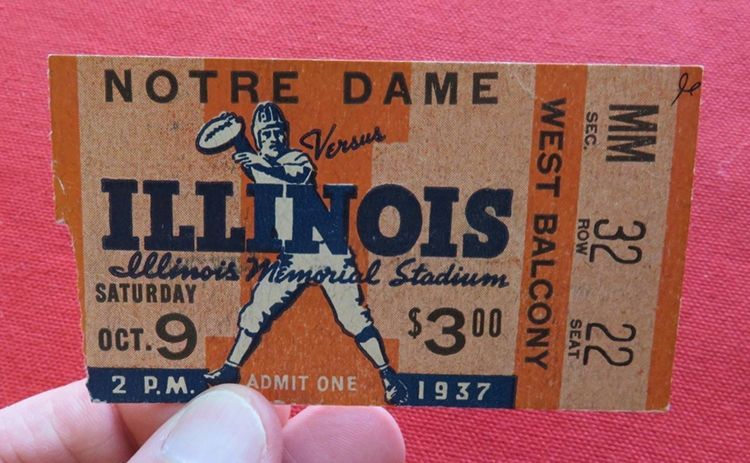
A ticket to the 1937 Illinois-Notre Dame game
1937 Illinois-Notre Dame game
Oct. 9, 2024
On this date in 1937, with Germany’s Nazi troops just weeks away from launching a takeover of Austria overseas and only a day before the New York Yankees would complete its five-game World Series conquest of the cross-town Giants, Illinois and Notre Dame met on the football field for the first time since 1898.
A section of 1,200 student soldiers were among the 45,000 spectators that came to see the battle at Memorial Stadium that would end in a 0-0 tie.
On the gridiron that day, Coach Elmer Layden’s heavily favored and Top Ten ranked Fighting Irish were stymied by Bob Zuppke’s defensive unit. Notre Dame was held to just 170 total offensive yards and 10 first downs by Illinois, as Illini left end Joe Klemp repeatedly crashed past Notre Dame blockers. Klemp was ably supported by the defensive efforts of teammates Howard Carson, Jim McDonald, John Berner and Captain Lowell Spurgeon, allowing Irish passers to complete only four of 17 pass attempts.
Illinois’ offense was even less effective than Notre Dame, managing only 89 total yards of production.
Both teams punted 12 times and neither team’s placekicker was able to convert a field goal. Illini sophomore Mel Brewer was 0-for-2 on his tries, missing from 21 and 34 yards.
Its scoreless tie 87 years ago today against the Illini marks the only time in the now 12-game series history between the two schools that Notre Dame didn’t win.
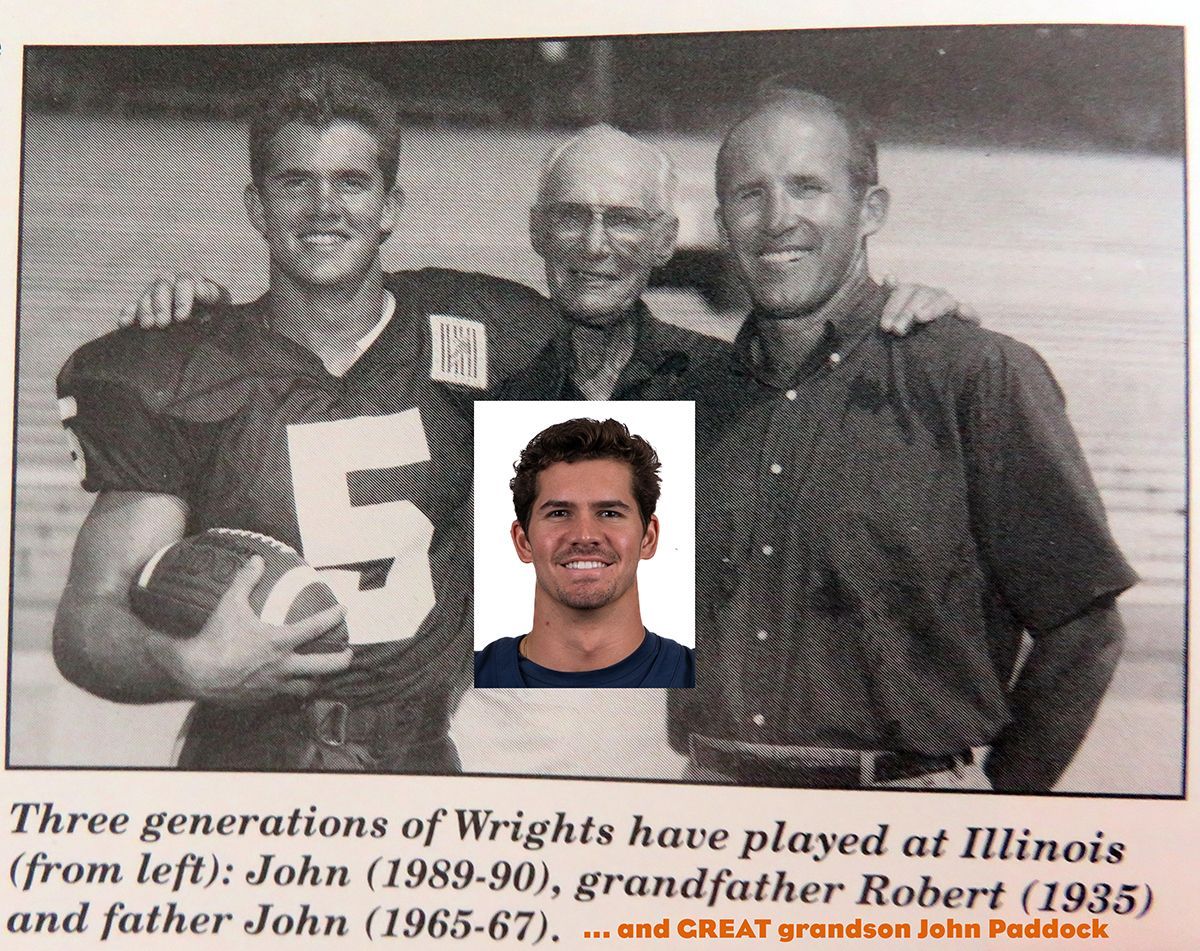
Bob Wright and family
Coach Bob Wright
Oct. 7, 2024
Robert “Bob” Wright, patriarch of the University of Illinois’ Wright family, was born on this date 110 years ago.
The native of Roodhouse, Illinois was a football letter winner for Coach Bob Zuppke’s Fighting Illini in 1935. He also was a track and field standout for Coach Don Seaton’s 1936 Illini squad.
Perhaps his greatest individual athletic success came as head coach of Illinois’ track and field team from 1965-74. His 1972 squad finished second at both the Big Ten indoor and outdoor meets, tying for seventh at the NCAA Championships.
Among his greatest athletes were Rich Brooks, Mike Durkin, Charlton Ehizuelen, Ed Halik, Lee LaBadie, Rob Mango, Craig Virgin, and his own son, John Wright.
Bob’s grandson, John, also excelled as an Illini athlete, starring as a receiver on the football team. His great great grandson, John Paddock, was a single-game record-setting quarterback for Illinois in 2023.
His wife, Mary, was one of Champaign-Urbana’s most beloved citizens. Bob died on Nov. 4, 1996, at the age of 82.
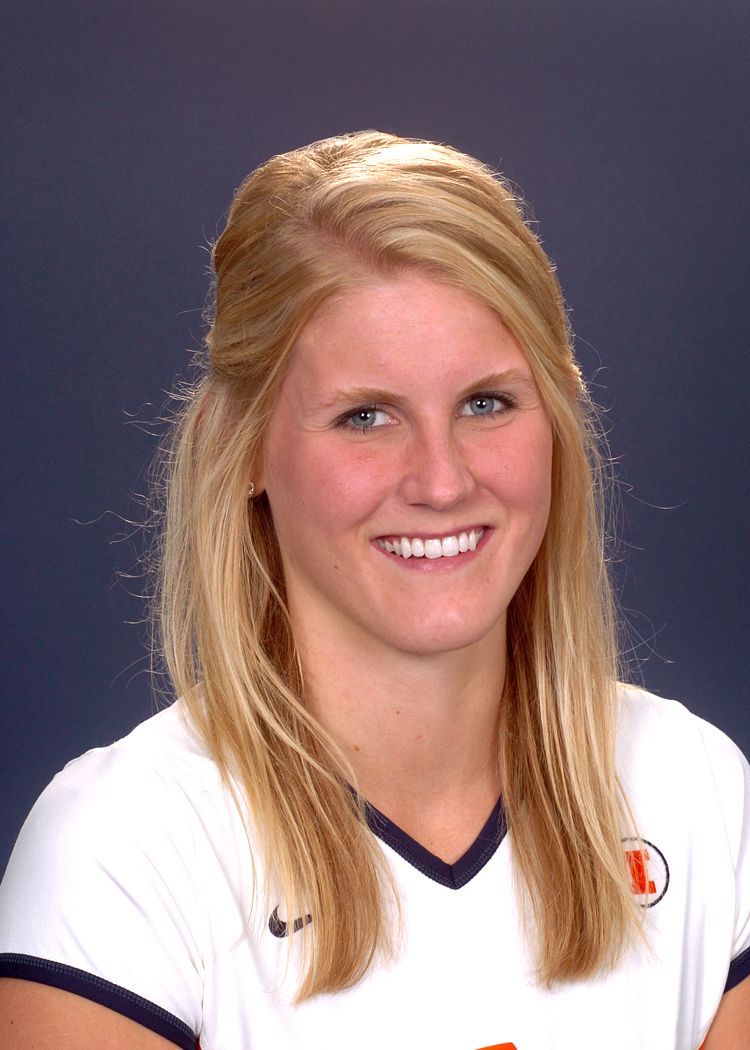
Colleen War Barone
Colleen Ward Barone
Oct. 4, 2024
Celebrating her birthday today is former Fighting Illini volleyball superstar Colleen Ward Barone. An All-American in each of her two seasons—first-team in 2011 and second-team in 2010—her efforts helped lead Illinois to the national championship match during her senior campaign.
Her name is sprinkled throughout Illini volleyball’s record book and tops the list for single-match aces (9 vs. BYU in 2010).
Now married, she is a vice president at Northern Trust in Miami, Fla.
The product of Naperville North High School and transfer from the University of Florida recalled several moments during her career and remembered many of the athletes with whom she played:
•On Illinois ending Penn State’s 65-match Big Ten winning streak in 2010: “We didn’t let that intimidate us. It really fed into our competitive nature.”
•On UI’s three-hour, five-set victory at PSU in 2011: “We started our season off really strong (16th consecutive win in a 20-0 start). We were ranked No. 1, but it didn’t feel like we were No. 1 at that point because we knew we had the potential to be so much better. We knew that we had to keep improving.”
•On facing her former teammates, the Florida Gators, in the 2011 NCAA regional finals in Gainesville: “Knowing that I wanted to transfer to Illinois, I had the same exact feeling when we were watching the (NCAA Tournament) selection show. I just knew that we were going to end up playing Florida. Once it all came to reality, it was pretty cool to see. I really don’t remember the games very well, other than just the feeling of playing. It pretty much just went into my own little world and focused on playing the games, point to point.”
•On Illinois’ legendary match vs. Southern California in the 2011 NCAA semifinals: “The coaches did a great job of preparing us for the Final Four. An early loss in one of the games wasn’t going to scare us. USC came out to play and we were the same way. Every point really mattered. The final point is something we’ll all remember forever. Very long. Very competitive. A lot of amazing saves on both sides. That spirit reflected our team a lot from that season.”
•On UI’s loss in the championship match against UCLA: “Honestly, I can say going into the final that we did get a little overwhelmed. We just got a little bit out of our game and made more mistakes than we normally would, and we weren’t as aggressive as we should have been.”
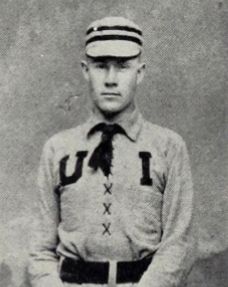
Illini Baseball's Beginnings
The Beginning of Illini Baseball
Oct. 2, 2024
Exactly 145 years ago today—Oct. 2, 1879—as an extension of an oratorical competition between Illinois Industrial University (University of Illinois) and Illinois College, the two institutions faced off on the baseball diamond for what history reveals was the university’s very first intercollegiate game.
Reported The Illini later that week, “The Jacksonville ball nine came to the oratorical contest and played our nine on the afternoon of October 2. The game was called at the end of the fifth inning when the score stood 5 to 12 in favor of our boys. We are sorry that you were so badly beaten, Jacksonville.”
The Illini were led by its catcher, Comma Boyd, who served as both the captain and manager of the first team. Boyd was considered by his teammates as “the Babe Ruth of his time”. After graduating, he went on to become a successful farmer and a breeder of thoroughbred Hereford cattle in Sheffield (Illinois).
Illinois’ pitcher was W.T. Andrews. The remainder of UI’s first intercollegiate squad consisted of H.A. Nelson (1B), E.L. Kelso (2B), E.H. Swasey (SS), C.R. Huntley (3B), Harry Diffenbaugh (LF), T.E. McIlduff (CF), Morton Chase (RF), and Frank White (RF).
Baseball was actually played at the U of I four years prior to that initial intercollegiate game in 1879. The Illini mentioned the game numerous times in its editions, including a report about the first contest to be played outside of the university. That occurred on Apr. 26, 1878 when “a number of boys took advantage of the excursion rates and went to Danville. A promiscuous nine was selected and a game was played against the Danville Club.” Danville scored seven runs in the bottom of the ninth inning and won by a score of 13 to 10.
In April of 1879, The Illini extended an invitation to other teams to play, writing “Our (baseball) boys are getting in trim. Let us hear from some of the neighboring colleges and we will try and give them a rub.”
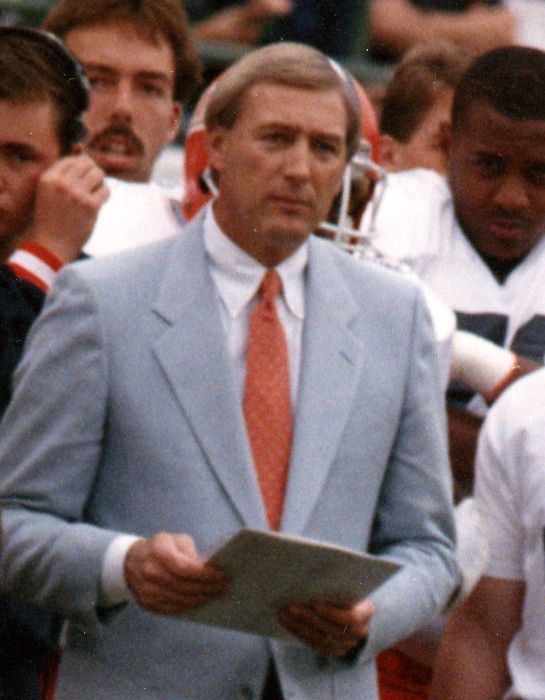
John Mackovic
John Mackovic
Sept. 30, 2024
Toomorrow (Oct. 1) marks the 81st birthday of former Fighting Illini football coach John Mackovic. Illinois’ 19th head coach was named to that post on February 3, 1988 by athletic director Neil Stoner.
Each of the four teams Mackovic directed earned bids to Bowl games and his 1990 club shared the Big Ten title. He became the first man to earn Conference Coach of the Year honors in each of his first two seasons. Less than 11 months after he was named head coach, Mackovic also became the school’s athletic director. He resigned both positions in December of 1991 to become head coach at the University of Texas.
Mackovic’s 10 most memorable victories at Illinois:
Oct. 1, 1988: Mackovic celebrated his 45th birthday with a victory at Ohio State, Illinois’ first triumph in Columbus in 21 years.
Nov. 5, 1988: Trailing 20-9 with less than four minutes remaining, quarterback Jeff George threw dramatic TD passes to Shawn Wax and Mike Bellamy. The Illini win, 21-20.
Sept. 4, 1989: Two touchdowns in the final six minutes help Illinois beat highly ranked Southern California on Labor Day night at the Coliseum.
Oct. 7, 1989: Howard Griffith (117 yards rushing) and Jason Verduzco (126 yards passing) led Illinois past Ohio State, 34-14, in Champaign.
Jan. 1, 1990: Illinois ended season at 10-2 with a 31-21 Citrus Bowl victory vs. Virginia.
Sept. 15, 1990: The Illini handed eventual co-national champion Colorado its only loss of the season.
Sept. 22, 1990: Howard Griffith scored an NCAA-record eight touchdowns in Illinois’ 56-21 victory over Southern Illinois.
Oct. 6, 1990: Illinois beat Ohio State for the third consecutive season, 31-20, at Columbus.
Oct. 20, 1990: Doug Higgins’ record-tying five field goals, including a game-winning 48-yarder in the last minute, helped Illinois defeat MSU, 15-13.
Oct. 12, 1991: Chris Richardson kicked a 41-yard field goal with only 37 seconds left to lead Illinois past Ohio State, 10-7.
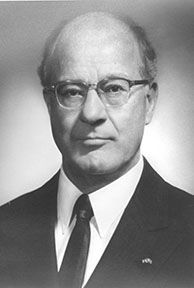
Avery Brundage
Avery Brundage: By the Numbers
Sept. 27, 2024
Born 137 years ago—Sept. 28, 1887—was Fighting Illini legend Avery Brundage. His greatest fame came from 1952 to 1972 when his served as president of the International Olympic Committee (IOC).
Wrote Pulitzer Prize winning author David Maraniss in his book entitled “Rome 1960: The Olympics That Changed the World”, “I found Avery Brundage to be one of the most contradictory characters I’ve ever written about. He was not especially likeable, yet the fact that at some points in his career nearly every faction hated him for some reason or other seemed to me like a bit of a saving grace. His devotion to the Olympic movement was greater than his belief in anything else. He truly believed that the Olympic movement was greater than any ideology or religion.”
Brundage’s noted and often controversial career, by the numbers:
3 Number of varsity letters he earned as an athlete at the University of Illinois, including one in basketball and two in track and field.
17 Age at which he began classes at the U of I.
45 His age in 1928 when he replaced General Douglas MacArthur as president of the American Olympic Association.
87 His age at the time of his death on May 8, 1975, in West Germany.
1,200 The IOC’s share (in dollars) of television rights for the 1960 Olympic Games (Rome).
1912 Year of the Olympic Games (Stockholm, Sweden) in which he placed sixth in the pentathlon and 16th in the decathlon.
1952 Year in which Brundage was selected president of the IOC, 30 votes to 17 for Great Britain’s Lord Burghley.
7,700 Number of Asian art objects he donated to San Francisco’s Society for Asian Art, estimated to be worth 50 million dollars.
350,000 Amount of money Brundage bequested to the University of Illinois to fund scholarships for students interested in competing in sports who were otherwise unfunded.
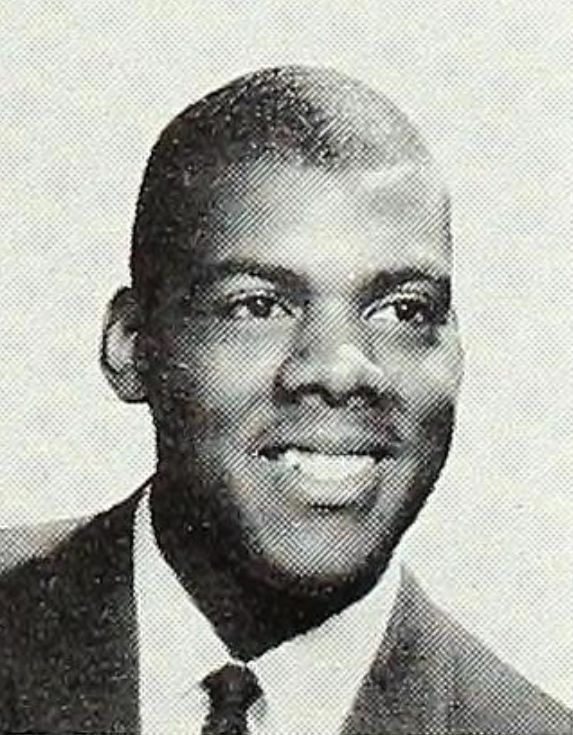
Bill Burwell
Bill Burwell
Sept. 25, 2024
Though the borough of Brooklyn, N.Y. is best known as the longtime home of professional baseball’s Dodgers, its most prolific contribution has traditionally come from the sport of high school basketball.
Brooklyn’s Boys High School, located in the Bedford-Stuyvesant neighborhood, has produced an amazing collection of prep stars who went on to become world famous, including Hall of Famers Connie Hawkins and Lenny Wilkens.
Bill Burwell, another standout player from Boys High, became a prominent member of the University of Illinois’ 1963 Big Ten champions. At 6-8, 235 pounds, Burwell was by far the biggest Illini player on Coach Harry Combes’ squad. In three seasons—1960-61, ’61-62 and ’62-63—he averaged 15.3 points per game. In fact, when Burwell graduated, he ranked as UI’s third-leading scorer of all-time with 1,119 points. His top single-game scoring effort ironically came at New York’s Madison Square Garden (26 points).
Perhaps Burwell’s most important role with the Illini came as a rugged rebounder. He averaged nearly 10 boards per game, second only to teammate Dave Downey. Today, his 9.6 rebounds per game average is sixth-best in Illinois’ record book, trailing only Nick Weatherspoon (11.3), Skip Thoren (11.2), Downey (11.0), Don Freeman (10.3) and Dave Scholz (9.7). Burwell’s 21 rebounds versus Wisconsin on Feb. 19, 1962 once tied for the school record.
The team’s overall record during Burwell’s last two seasons was a respectable 35-14.
Today would have been his 84th birthday. He died in 2021.
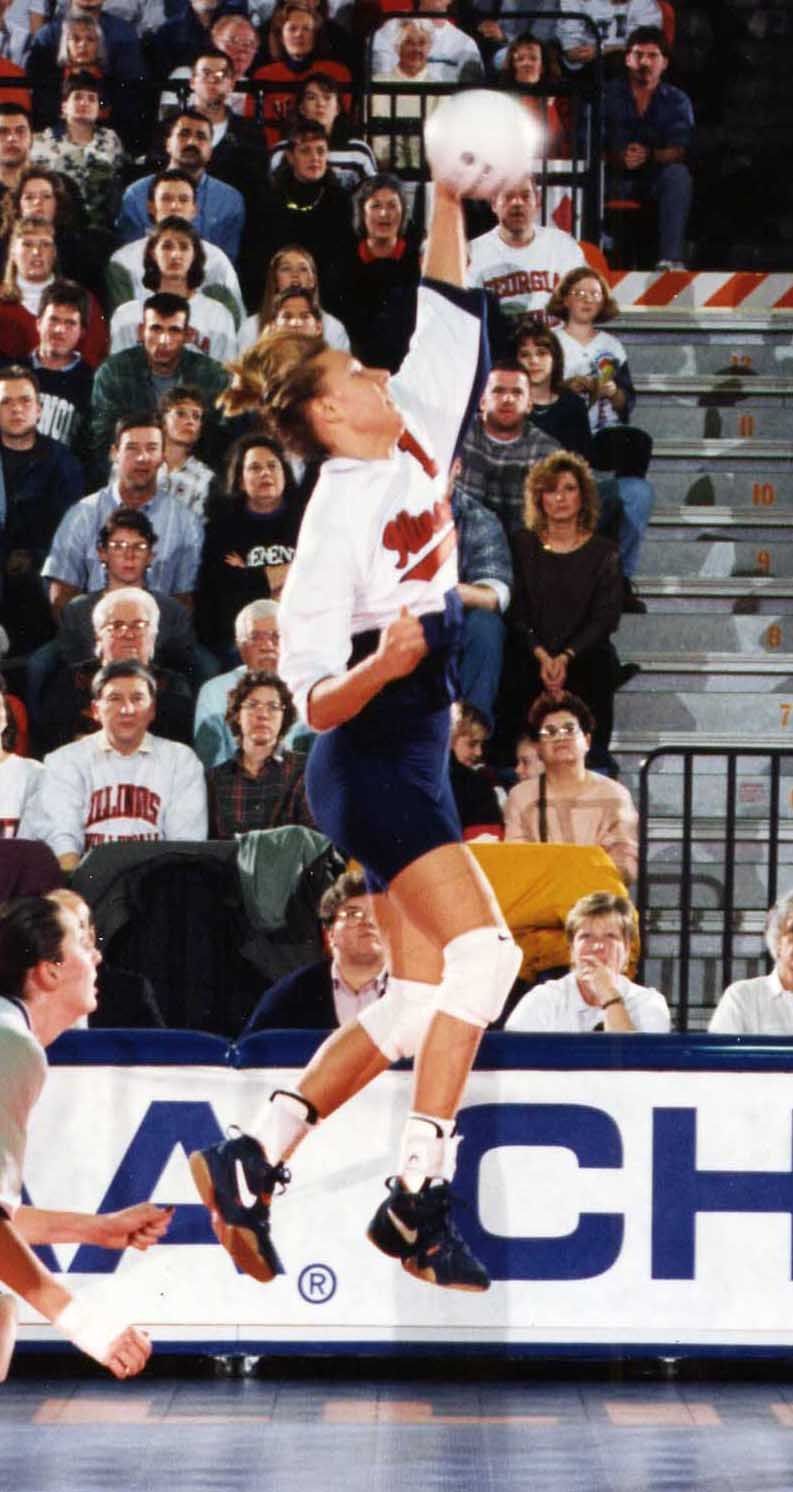
Erin Borske Gray
Erin Borske Gray
Sept. 23, 2024
Twenty-nine years ago today—September 23, 1995—sophomore Erin Borske (Gray) shattered Illini volleyball’s record for single-match kills, hammering 44 winners in 92 swings in Illinois’s near upset of sixth-ranked Penn State.
Though she only played two seasons in Champaign-Urbana, Gray plastered her name throughout UI’s record book. The product of Stagg High School in Palos Heights quickly made an immediate impact, earning Big Ten Freshman of the Year honors in 1994, amassing 478 kills and 355 digs. More than two decades later, her sophomore season total of 714 kills still stand as UI’s record. That earned her first-team All-America honors
Of Illinois’s top 10 single-game performances for kills, Gray holds the top two marks in that category (44 vs. Penn State and 41 vs. Minnesota) plus three others.
When her Illini coach, Mike Hebert, announced that he was leaving Illinois for Minnesota following the 1995 season, Gray announced her intentions to also leave the program.
"He was really the reason I was at Illinois," she said. "I respected him a lot and enjoyed playing for him. I didn’t really feel connected to the program if he wasn’t there."
Gray’s hopes to transfer to Arizona State never materialized, so she instead pursued a professional career in beach volleyball. She was Rookie of the Year and Player of the Year on the EVP Tour in 1998 and ’99, respectively. Gray retired in 2015 following several years on the circuit.
Today, she resides in Redondo Beach, Calif. and serves as assistant coach for that city’s sand beach team. Gray and her husband have five children.
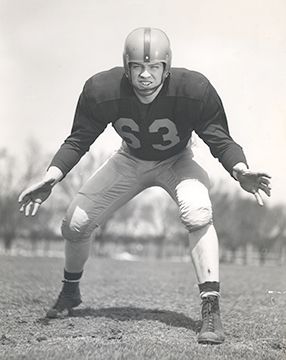
Peter Palmer
Peter Palmer
Sept. 20, 2024
Born on this date in 1931 in Milwaukee and reared in St. Louis, Peter Palmer became an all-star football lineman and lettered at the University of Illinois in 1952 and ‘53.
There, he became the first music major to win a letter in football and probably the only gridiron hero to sing the National Anthem before games. Fresh out of college,
Palmer won a Chicago radio contest and that led him to Hollywood where most of the major studios butted heads, trying to sign him to contracts. Instead, he enlisted in the service.
At age 24, Palmer appeared on Ed Sullivan's program, where he was spotted was by Broadway producers who were putting together talent for the soon-to-be smash-hit production of Li’l Abner. The 6-foot-4, 220-pound Palmer performed on New York’s Great White Way from 1956 through 1959 in the role of Li’l Abner Yokum. In 1959, the Broadway show became a movie. Palmer also acted in five other movies, including the 1990 hit Edward Scissorhands.
He died on Sept. 21, 2021 at the age of 90.
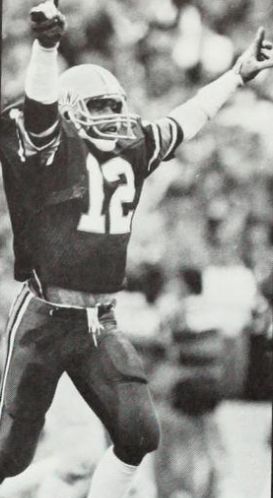
Craig Swoope
Craig Swoope
Sept. 18, 2024
On this date 42 years ago, freshman defensive back Craig Swoope intercepted two passes and quarterback Tony Eason threw for 293 yards to lead Coach Mike White’s Fighting Illini past host Syracuse, 47-10.
SU’s Carrier Dome was the site for Illinois’ first indoor game since the turn of the 20th century.
Swoope’s defensive picks came in only his third collegiate game and were two of 12 career interceptions he made for the Illini. At the conclusion of his career, he ranked fourth in that category behind Al Brosky (29), Mike Gow (19) and teammate Mike Heaven (13).
The native of Fort Pierce, Fla. had 205 tackles altogether, just shy of placing him among Illinois’ top ten in defensive stops. Swoope co-captained the Illini as a senior in 1985 with Jack Trudeau and Chris White, earning All-Big Ten honors all four years he played in Champaign. His college career was marred by a federal indictment on drug charges in 1984, but he eventually was acquitted by a District Court jury.
Swoope was a fourth-round pick in the 1986 NFL Draft by the Tampa Bay Buccaneers and also later played for the Indianapolis Colts. In 2008, Fort Pierce’s Westwood High School retired Swoope’s No. 20 jersey.
He now resides in Champaign-Urbana.
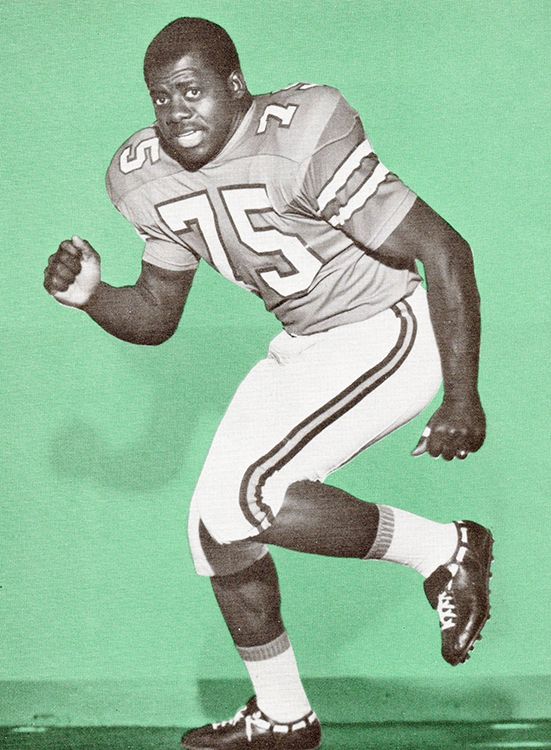
Tab Bennett
Tab Bennett
Sept. 16, 2024
Tab Bennett, former Fighting Illini football star and longtime Sports Information Director at the University of Illinois, was born 73 years ago yesterday. He died in 1994 at the age of 42.
Bennett got his nickname from the initials of his full name: Theodore Anthony Bennett.
As a junior in 1971, he earned All-Big Ten honors as a defensive end. An ankle injury cut short what could have been a promising professional career.
The Big Ten’s defensive all-stars of 1971:
DE Tab Bennett, Illinois
DE Mike Keller, Michigan
DT Ron Curl, Michigan State
DT George Hasenohrl, Ohio State
LB Mike Taylor, Michigan
LB Stan White, Ohio State
LB Randy Gradishar, Ohio State
DB Tom Darden, Michigan
DB Eric Hutchinson, Northwestern
DB Brad Van Pelt, Michigan State
DB Craig Clemons, Iowa
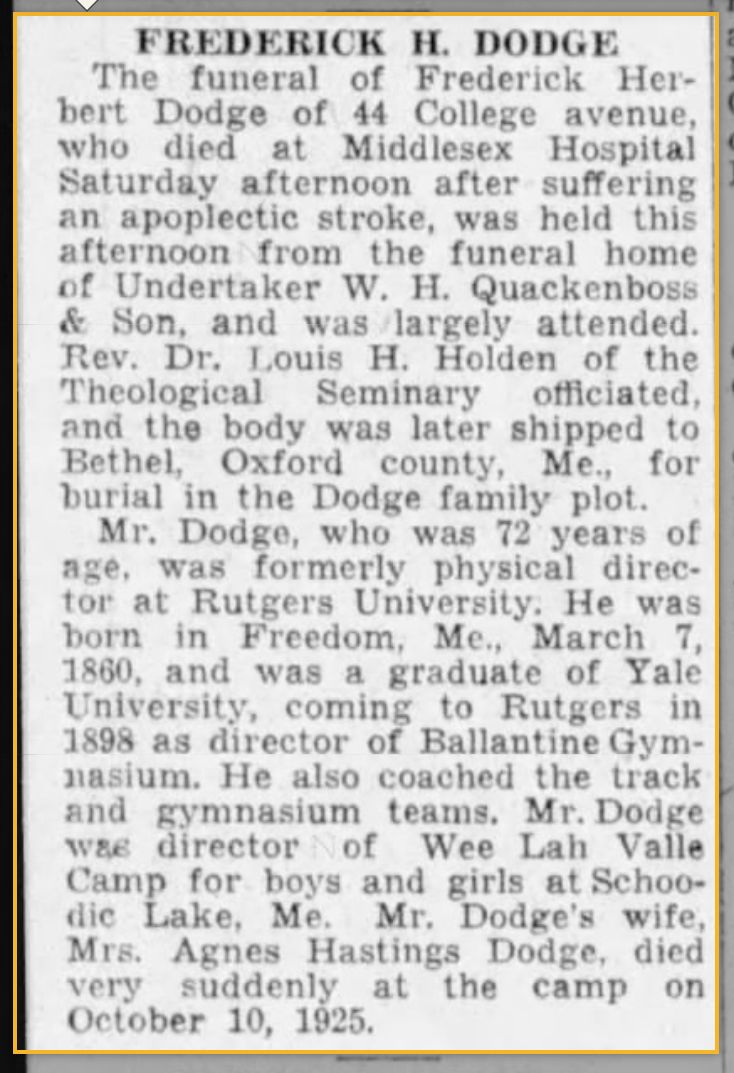
Frederick Dodge
Frederick Dodge
Sept. 13, 2024
On this date 130 years ago—Sept. 13, 1894—thirty-four-year-old Professor Frederick H. Dodge was introduced as the new director of athletics at the University of Illinois. He succeeded Edward K. Hall, the UI’s very first A.D., who resigned three months earlier.
An 1884 graduate of Yale University, Dodge devoted his undergraduate athletic endeavors to rowing and did not participate in any other sports. Born in 1860, the native of Bangor, Me. was first employed as the chair of physical culture at Bates College in his home state, then moved on to become director of the Chicago Athenaeum’s gymnasium for three years, located at 59 East Van Buren Street.
Three weeks after Dodge was hired at Illinois, he brought on Louis Vail from the University of Pennsylvania to coach the Illini football team. Vail’s 1894 squad, his only one, had a 5-3 record.
In Dodge’s seventh week on the job as the Illini athletics director, the school’s official colors changed from green and white to orange and blue.
Under Dodge’s direction in 1895, Illinois organized a varsity track and field program and became a charter member of the nation’s first intercollegiate athletics conference that would come to be known as the Big Ten.
When Dodge departed Champaign-Urbana in June of 1895 for New Brunswick, N.J, he was replaced by George Huff.
Dodge served as director of Rutgers University’s Ballantine Gymnasium and also coached the Scarlet Knights’ track and gymnastics teams.
He later was director of Wee Lah Valle Camp for boys and girls at Schoodic Lake, Me.
Dodge died in 1932 at the age of 72 and was buried in Bethel, Me.
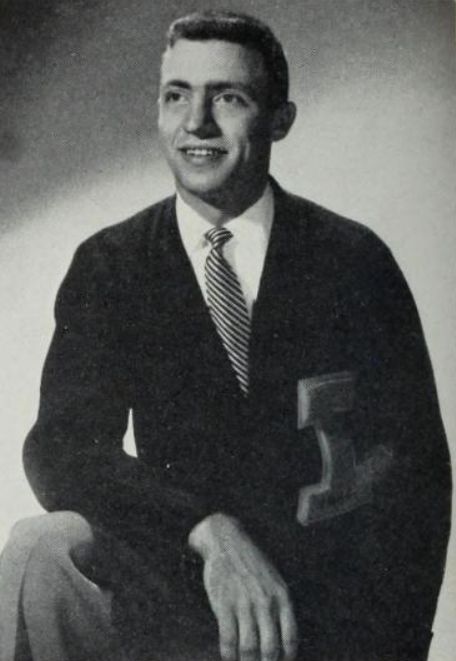
Joe Corley
Joe Corley
Sept. 11, 2024
Belated birthday greetings to former Fighting Illini NCAA champion Joe Corley who turned 93 years old yesterday.
A track and field athlete for Coach Leo Johnson, the standout athlete from St. Elmo High School won the 1954 NCAA individual title in the 220-yard hurdles finals with a time of :22.60. Corley and his teammates, including classmate and longtime friend Willie Williams, won eight consecutive Big Ten championships from 1951-54. He served as the Illini captain his senior season.
Corley was an ROTC student at the University of Illinois and was a member of the Tau Kappa Epsilon fraternity. Upon earning a degree in economics in 1954, he served in the U.S. Army from 1955-57. He was stationed at a Nike Missile Site in Chicago and continued to compete in track as a soldier. Corley was a 4th Army champion in the 100, 220 hurdles and the long jump and qualified for the 1956 Olympic Trials.
He returned to Champaign to serve as a fraternity manager and accountant for Bresee-Warner. Corley eventually became a successful real estate broker, manager and appraiser until his retirement in 2014. He immersed himself in a number of volunteer roles, including the C-U Convention & Vistors Bureau, the United Way, the UI Quarterback Club, the Illini Striders, the Christie Clinic Illinois Marathon and Meals on Wheels.
Corley's family includes four children, two stepchildren, 11 grandchildren and six great grandchildren.
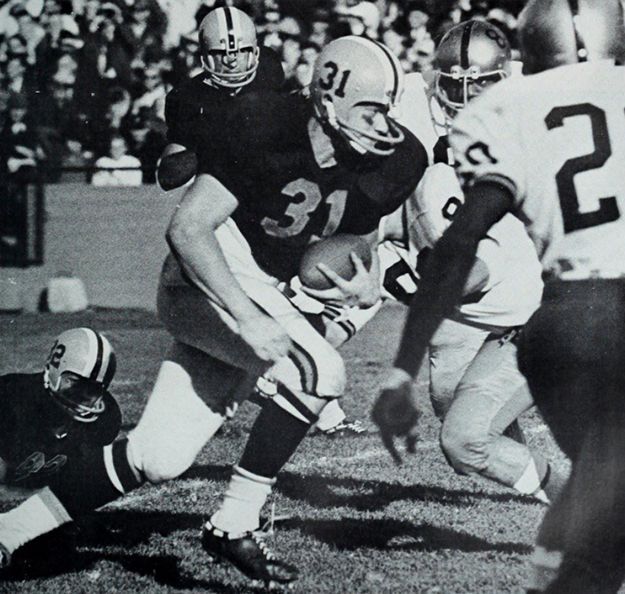
Jim Grabowski
Jim Grabowski
Sept. 9, 2024
Former Fighting Illini running back and longtime football color analyst Jim Grabowski celebrates his 80th birthday today.
“Grabo” broke nearly all of Red Grange’s rushing records and played in the first two Super Bowls during a six-year career in the National Football League, but he will be remembered for much more than just his prowess on the athletic field at the University of Illinois.
The personable native of Chicago was an all-star in the classroom as well, earning Academic All-America acclaim in 1964 and ’65 and the Big Ten Medal of Honor in 1966.
Grabowski was inducted into the Academic All-America Hall of Fame in 1993, joining such notables as Princeton’s Bill Bradley, Notre Dame’s Joe Theismann and Southern Cal’s Pat Haden.
No. 3 in the Heisman Trophy balloting of 1965, Grabowski finished his brilliant Illini career as the Big Ten’s career rushing leader with 2,878 yards. He was the first-round pick of the Green Bay Packers in 1966, retiring after the 1971 season following a series of knee injuries. In January of 1995, Grabowski was selected to become a member of the College football Hall of Fame.
He served as color commentator for the Illini Football Radio Network for more than 30 years.
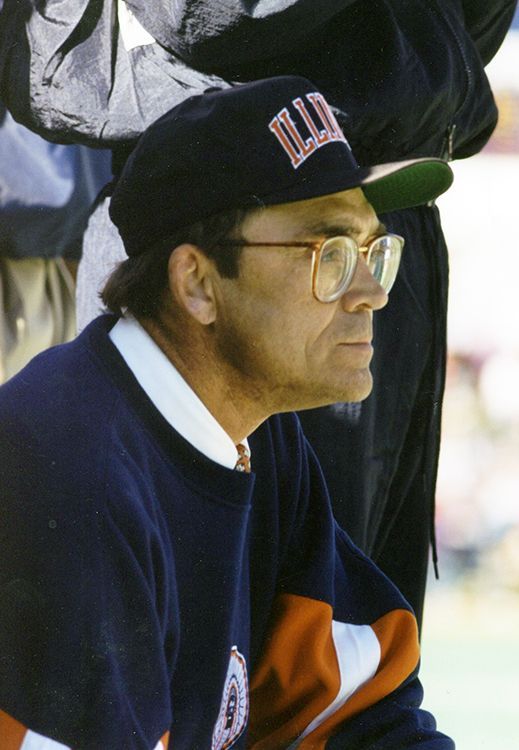
Lou Tepper
Lou Tepper
Sept. 7, 2024
Lou Tepper, Illinois’ 20th head football coach (from Dec. 31, 1991 through Nov. 25, 1995) celebrates his 79th birthday on Saturday (Sept. 7).
His first game directing the Illini came on New Year’s Eve at the John Hancock Bowl in El Paso, Tex., taking over for John Mackovic who, just a few weeks before, had been named head man of the Texas Longhorns.
Though his overall winning percentage was less than .500 (25-31-2), Tepper did lead Illinois to a number of landmark victories, including a pair of wins over Ohio State plus a victory and a tie at Michigan. He also coached consecutive Butkus Award winners in Dana Howard (1994) and Kevin Hardy (1995).
After coaching stints at Edinboro and Indiana of Pennsylvania, Tepper finished with a record of 101-75-2 as a head coach.
His most memorable games as head coach at Illinois:
Sept. 12, 1992: Illini jumped out to a 24-0 lead, then held on to top Missouri in Champaign, 24-17. Tepper was 2-1 against the Tigers.
Oct. 10, 1992: Illinois won its fifth consecutive game vs. Ohio State. The 18-16 triumph was its third straight win at Columbus.
Nov. 14, 1992: The underdog Illini battled third-ranked Michigan to a 22-22 stalemate. UM salvaged the tie on a field goal with just 16 seconds left in the game.
Oct. 23, 1993: Illinois won at No. 3 Michigan, 24-21, its first victory at Ann Arbor since 1966. The winning score came on a fourth-down, 15-yard pass from Johnny Johnson to Jim Klein in the final seconds.
Oct. 8, 1994: Backing up his prediction earlier in the week, linebacker Dana Howard willed the Illini past Ohio State, 24-10, its fourth straight victory at Columbus.
Dec. 31, 1994: On New Year’s Eve in Memphis, Illinois shut out East Carolina, 30-0, in the Liberty Bowl.
Sept. 16, 1995: Led by Simeon Rice’s defensive effort, Illinois topped No. 17 Arizona, 9-7, at Memorial Stadium.
Oct. 5, 1996: In the first overtime game in Big Ten history, the Illini dispatched Indiana, 46-43, in Champaign. It was Tepper’s final victory at Illinois.
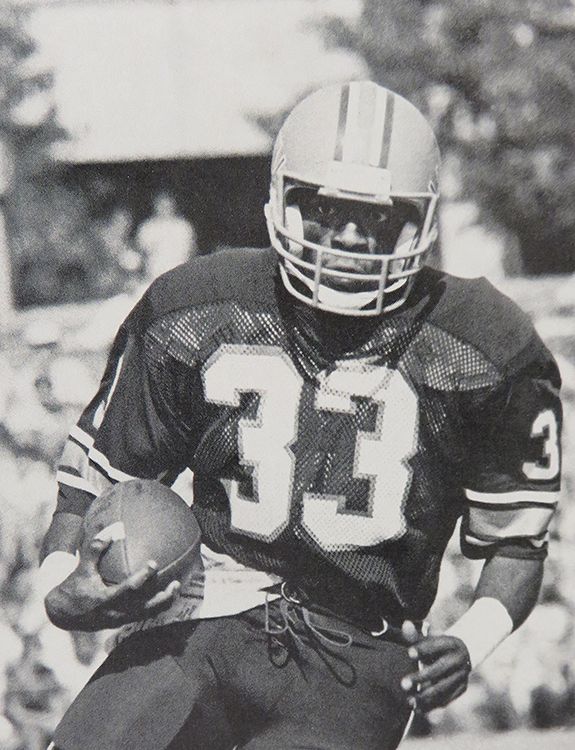
Mitch Brookins
Mitch Brookins
Sept. 4, 2024
Forty-two years ago today—Sept. 4, 1982—Illini junior running back Mitchell Brookins scored three touchdowns and led Illinois past Northwestern at Memorial Stadium, 49-13.
Though the former Wendall Phillips High School star was only his team’s fourth-leading rusher against the Wildcats—behind Dwight Beverly, Richard Ryles and Thomas Rooks—nobody reached the end zone more frequently than No. 33 that day. Brookins scored on five-yard runs in both the first and second quarters, then added a third TD early in the fourth quarter on a 15-yard pass from Tony Eason.
He tallied seven more touchdowns in 1982. His best single-game rushing effort was as a freshman in 1980 when Brookins ran for 180 yards in Mike White’s coaching debut. He played his senior season as a wide receiver, averaging a team-best 21.7 yards per catch.
At the 1984 NFL Draft, the Buffalo Bills used their fourth-round pick to choose Brookins. He didn’t disappoint his new team that year, catching 18 balls for 318 yards, including a 70-yard TD.
Brookins died in an automobile accident in July of 1993 at the age of 32. He’s buried at Oakridge-Glen Oak Cemetery in Hillside, Ill.
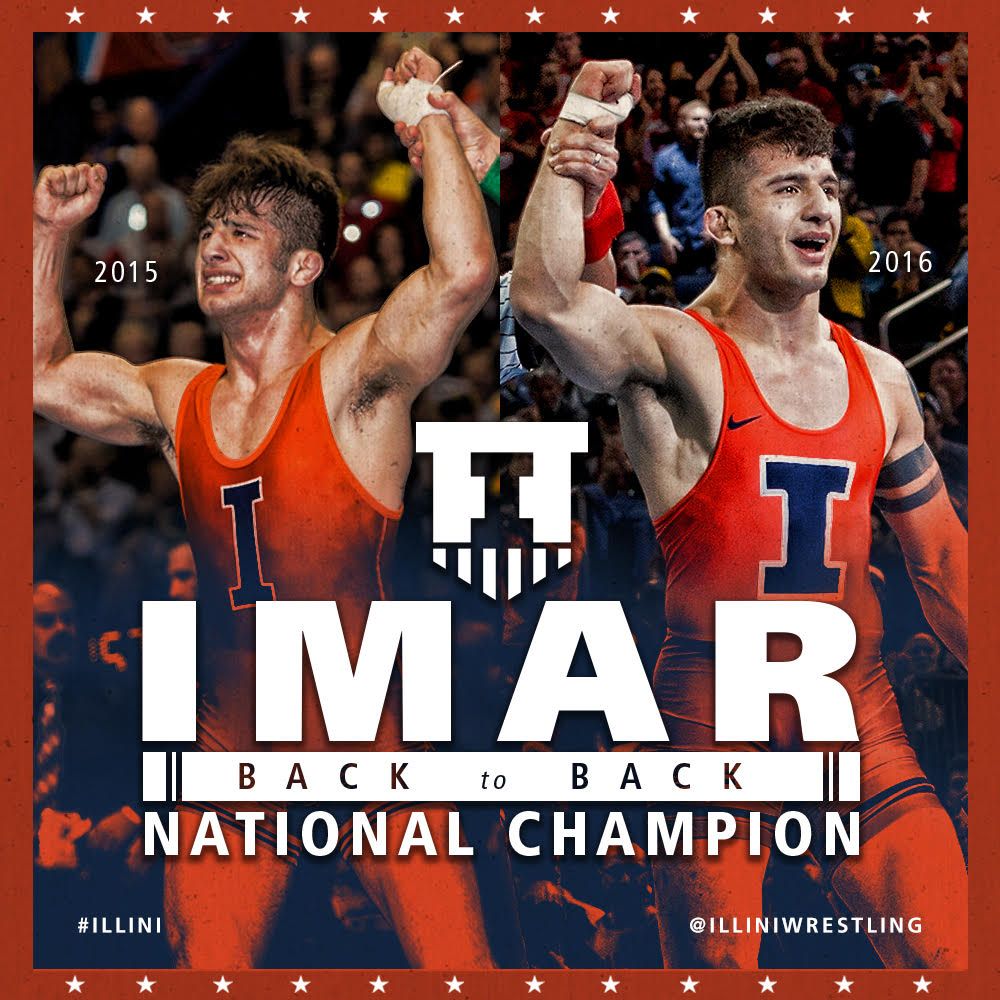
Isaiah Martinez
Isaiah Martinez
Sept. 2, 2024
Happy 30th Birthday to legend Isaiah Martinez, one of only four Fighting Illini varsity wrestling alumni to win two NCAA titles.
Recruited by Coach Jim Heffernan, Martinez travelled more than 2,100 miles to attend the University of Illinois from his home in Lemoore, California. He was redshirted as a true freshman, then began a dominating run of his Big Ten competition in the 2014-15 season.
in 2024-25, Martinez will serve as Illinois wrestling’s assistant coach for a third season.
I-Mart’s record-setting Illini career, by the numbers:
• 2 Number of times he won the Dike Eddleman Award as UI’s Male Athlete of the Year (2016 and ’17).
• 4 Big Ten championships he captured, one of only 16 conference wrestlers to accomplish that feat.
• 10 His ranking on Illinois’s career victory list.
• 16 Seasons between him (2015) and Iowa State’s Cael Sanderson (1999) in becoming college wrestling first undefeated freshman (35-0).
• 54 Consecutive matches he won from 11/9/14 to 1/23/16.
• 116 Career victories in 119 overall college matches (116-3).
• 157 Weight at which Martinez wrestled as a redshirt freshman and redshirt sophomore.
• 165 His wrestling weight in his final two collegiate seasons.
• 205 Career victories Martinez compiled at Lemoore High School (205-7)
• .900 His winning percentage in NCAA Tournament wrestling matches.
• .975 His career winning percentage, an Illinois record.
• 2018 Year Martinez was awarded the Big Ten Conference Medal of Honor for proficiency in athletics and academics.
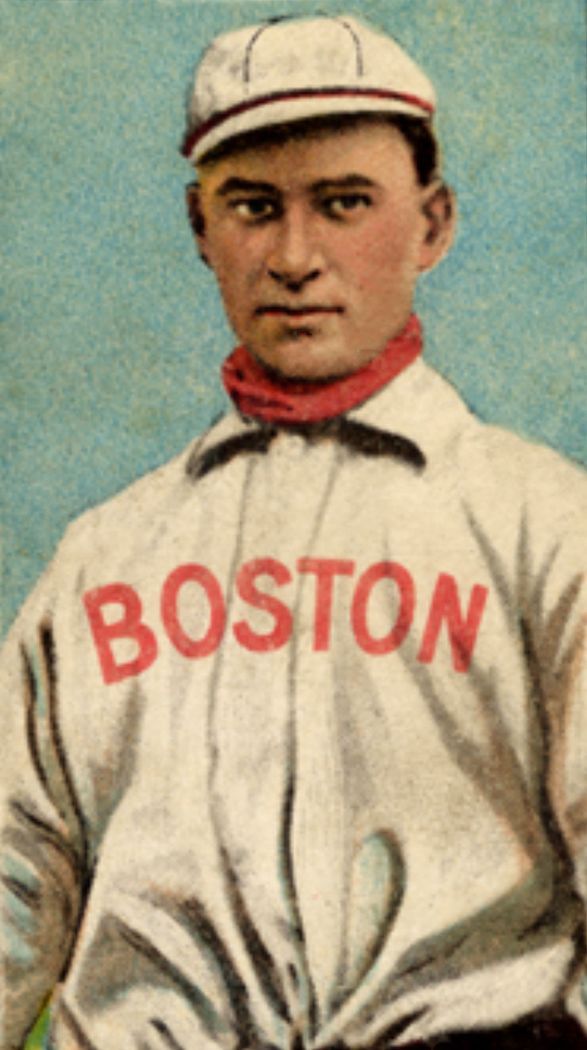
Garland "Jake" Stahl
Garland "Jake" Stahl
Aug. 30, 2024
A member of the 2020 Fighting Illini athletics Hall of Fame class, Garland “Jake” Stahl played nine Major League seasons.
Born in 1879, he was the third son of Henry and Eliza Stahl of Elkhart, Ill. Jake’s dad was a front-line Union soldier in the Civil War, surviving the Battle of Shiloh in Mississippi, a bloodbath where more than 23,000 individuals died.
After finishing tenth grade, Jake matriculated to the University of Illinois and became the school’s most celebrated athlete. He lettered four times in football (1899-1902) and three times in baseball (1901-03).
When the Major League’s Boston Americans lost its backup catcher to an injury, team owner Henry Killelea journeyed to Chicago to sign Stahl to an American League contract. Jake got into his first big league game on opening day (Apr. 20, 1903) and appeared in 40 games as a catcher, batting .239.
Stahl was dealt to the Washington Senators during the winter of 1904 and played three seasons in the nation’s capital, collecting more than 1,500 at bats. In that third season, he was promoted to skipper of the Senators at the age of 26, becoming the American League’s youngest-ever player/manager.
Following Washington’s disastrous 1906 season (55 wins and 95 losses), Stahl asked to be traded to the Red Sox. Instead, Senators management traded him to the Chicago White Sox. When Stahl refused to report, he spent the 1907 season working in his father-in-law’s bank, coaching the ’07 Indiana University baseball team, and playing semiprofessionally in Chicago.
The White Sox traded Stahl’s rights to the New York Highlanders. He spent the first 75 games of the 1908 season in the Big Apple, then was traded back to Boston to play first base.
Stahl enjoyed his best professional season in 1910, teaming with Hall of Famers Tris Speaker and Harry Hooper. Stahl tied for the A.L. lead in home runs with 10.
Amazingly, despite his long-ball success, Stahl opted to sit out the 1911 season and returned to his career as a banker at Washington Park National Bank on Chicago’s South Side.
New management in Boston convinced Stahl to come out of retirement in 1912, in part due to an offer to become a part-owner of the Red Sox. As Boston’s player-manager, the Red Sox ran away with the 1912 American League pennant, then beating Manager John McGraw’s talented New York Giants in the World Series. Stahl is said to have invested his winning World Series share in his father-in-law’s bank.
Stahl’s career unceremoniously ended in 1913 when he suffered a serious foot injury that required the removal of part of a bone in his right foot. While he continued to manage the Red Sox, he could not play first base. Following a mid-season argument with management, Stahl was released. Weeks later, the former Illini star announced that he was through with baseball.
Stahl immediately began his second career as a full-time banker in Chicago, but hard work and long hours took its toll. He suffered a nervous breakdown in 1920 and was placed in a Monrovia, Calif. sanitarium. Two year later, he contracted tuberculosis and passed away in September of 1922 at the age of 43.
Nine things you didn’t not know about Jake Stahl’s Major League career:
1) He was a member of two World Series championship teams (as player for 1903 Boston Americans, the very first Series champ) and as player/manager for the 1912 Boston Red Sox).
2) In 1904, he led all American League first basemen with 29 errors.
3) He led the American League by being hit by a pitch 17 times in 1905.
4) His 41 stolen bases in 1905 ranked third in the AL.
5) He ranked second to the immortal Ty Cobb in triples in 1908 (Cobb had 20, Stahl had 16). Stahl ranked among the AL’s top seven in triples four times.
6) He led the AL three times in batting strikeouts (1904, 1909 and 1910).
7) Not only did he tie for the lead in AL home runs in 1910 with 10 (one every 53.1 at bats), he led the league in putouts as a first baseman and ranked fourth with 77 RBI.
8) He currently ranks 233rd on the Major League career triples list with 87.
9) He received one Baseball Hall of Fame vote in both 1938 and 1939.
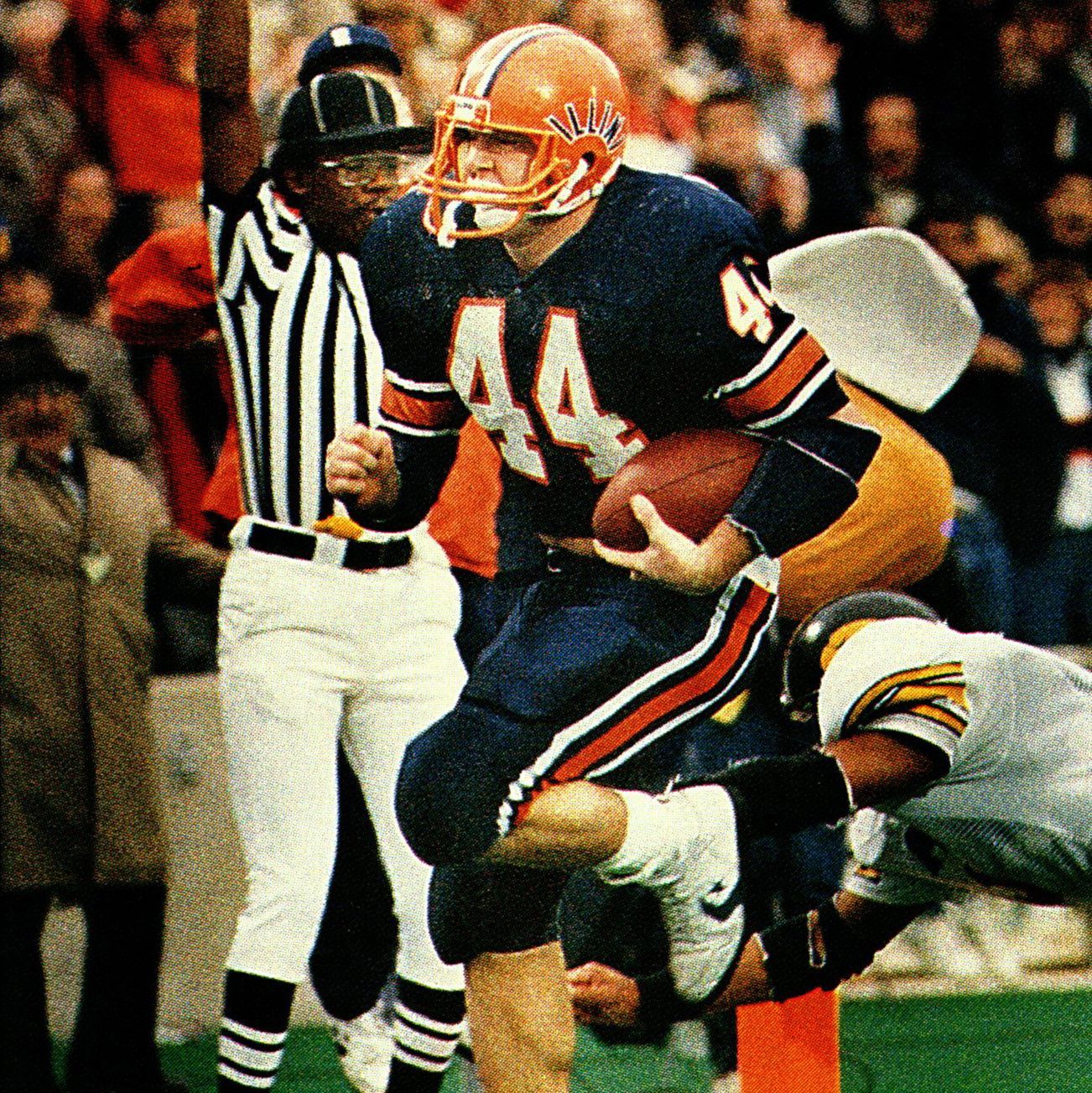
Defensive Debuts
Aug. 28, 2024
Fighting Illini coach Bret Bielema would love to see his team throw a shutout in Thursday night’s season opener vs. Eastern Illinois. However, in Illinois history, that’s only happened three times over the last 50-plus years in opening games.
The last time the Orange & Blue shut out its initial foe was 38 years ago when Mike White’s 1986 Illini blanked Louisville at Memorial Stadium, 23-0.
The king of Illini football shutouts in season openers is the immortal Bob Zuppke whose teams goose-egged their first opponent 15 times. Here are a few Illini defensive players who sparkled in season lid-lifting shutouts:
•Oct. 1, 1927: Zuppke’s Illini began what would become a national championship season with a 19-0 win versus Bradley. All-America lineman Robert Reisch, Butch Nowack and Russ Crane paced UI’s defensive effort.
•Sept. 25, 1948: The Illini handed visiting Kansas State a 40-0 defeat, the Wildcats’ 27th consecutive loss. Captain Herb Siegert, Dike Eddleman and Jim Valek star on defense for Coach Ray Eliot.
•Sept. 28, 1963: Illinois defensive backs George Donnelly, Mike Dundy and Jimmy Warren held California quarterback Craig Morton to just four completions in 15 attempts for 57 years. UI beat the Bears, 10-0, in Berkley.
•Sept. 14, 1974: Four of Illini linebacker Tom Hicks’ 16 stops halted Indiana runners inside the two-yard line. UI topped the Hoosiers, 16-0, in Champaign.
•Sept. 9, 1978: In one of the most infamous season openers in Illini history—a 0-0 tie with bottom-dweller Northwestern—linebacker John Sullivan racked up 15 tackles as UI limited the “Mildcats” to just 220 total offensive yards.
•Sept. 6, 1986: Junior linebacker Jeff Markland (pictured) led the Illini to a shutout victory over Louisville with a team-best 10 tackles. He performed at that position for the first five games of the ’86 season, then was moved by coaches to play fullback.
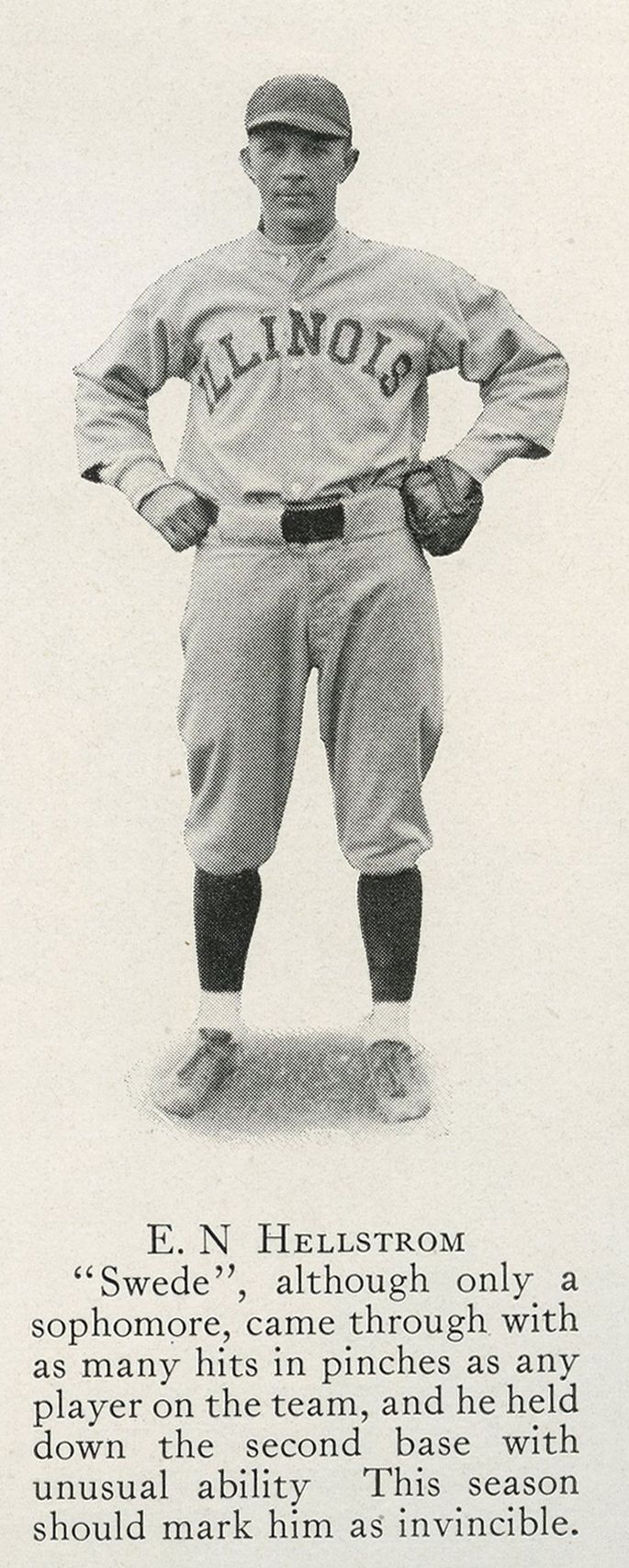
"Huddie" Hellstrom
Aug. 26, 2024
On this date in 1964, former three-sport Illini standout Norton E. “Huddie” Hellstrom died at the age of 68.
Born a first-generation American in 1896, Hellstrom was the son of Swedish immigrants. He attended Evanston Township High School, the same school that sent UI Hall of Famers Chuck Carney and Alex Agase to play for the Illini.
As a prep football player, Hellstrom’s senior team in 1916 won Suburban League in impressive fashion, not allowing any of its five opponents to score a single point. That same year, Evanston’s basketball team won the Stagg Tournament, referred to by many as the national high school championship. Hellstrom also starred as a baseball player, winding up as Evanston’s first athlete to win 12 varsity letters.
Shortly after after his graduation from Evanston, he fought in World War I, serving for the United States Navy.
Hellstrom lettered as an end for Coach Bob Zuppke’s football squad in 1920, but decided to focus his efforts on basketball and baseball for the remainder of his career.
Illini basketball coach Frank Winters inserted him into the starting lineup at forward with Carney in 1921, but he was sidelined with a leg injury the following season. Hellstrom captained coach Craig Ruby’s initial Illini club in 1923 at the age of 27.
With coach Carl Lundgren’s Illinois baseball club, he lettered from 1921-23 as an infielder. Both the 1921 and ‘22 Illini were Big Ten champions, losing only three times in two conference seasons. UI’s overall record over Hellstrom’s three seasons was 48-11-2.
At age 47, he rejoined the U.S. Naval Reserves and rose to the rank of lieutenant during World War II. After the war, Hellstrom moved his family to Fort Pierce, Florida where he was a realtor.
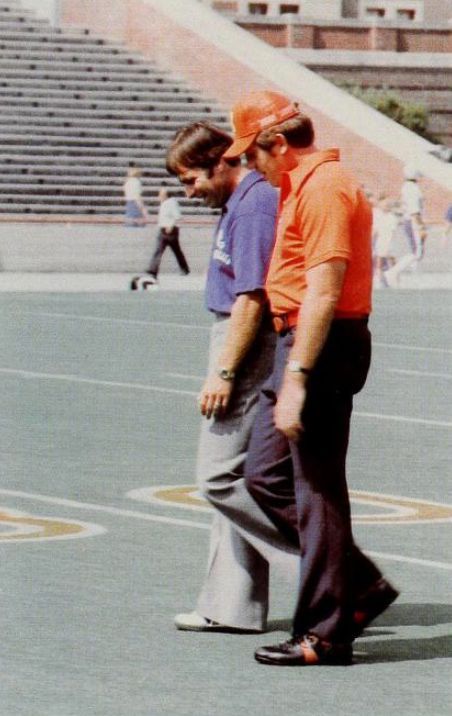
Advancing to Head Coach
Aug. 23, 2024
Historically, the University of Illinois’ football program has been a launching pad for future head football coaches.
Former Fighting Illini assistant coaches who left Champaign-Urbana to seek head coaching jobs include Glenn Mason, Lloyd Carr, Joe Novak and Bob Sutton who all served as key aides to Gary Moeller during the late 1970s. Dick MacPherson, who was a graduate assistant coach on Ray Eliot’s 1959 squad, went onto success at UMass and Syracuse, then had a two-year stint as head coach of the New England Patriots.
Besides MacPherson, four other former Illini assistants—Sean Payton, Bill Callahan, Leslie Frazier and Brad Childress—also eventually became NFL head coaches.
Eliot and Lou Tepper, both Illinois assistants who subsequently became Illini head coaches, also are among the men on this top ten list in terms of victories:
123 Glenn Mason (123-121-1 at Kent St., Kansas & Minnesota)
122 Lloyd Carr (122-40 at Michigan)
111 Dick McPherson (111-73-5 at UMass, Syracuse and New England Patriots)
101 *Lou Tepper (101-75-2 at Illinois, Edinboro and Indiana-Pa.)
83 *Ray Eliot (83-73-11 at Illinois)
80 Sean Payton (80-48 at New Orleans Saints)
69 Walt Harris (69-85 at Pacific, Pitt and Stanford)
63 Joe Novak (63-76 at Northern Illinois)
62 Dee Andros (62-80-2 at Idaho and Oregon St.)
44 Bob Sutton (44-55-1 at Army)
*Includes coaching victories as head coaches at Illinois

Carl Lundgren
Aug. 21, 2024
The immortal George Huff called him “the greatest of all college baseball coaches.” An early sporting magazine, Athletic World, praised him as “the peer of all college baseball instructors.”
In any case, the name Carl Leonard Lundgren is permanently linked with University of Illinois success on the baseball diamond.
As a pitcher on the Fighting Illini nines of 1899-1902, “Lundy” led Illinois to Big Ten championships his sophomore and senior seasons. The esteem in which he was held by his fellow students was displayed by his election not only to the baseball team’s captaincy, but also to the presidency of UI’s senior class.
Lundgren went directly from Illinois into professional baseball, pitching for the Chicago Cubs for seven seasons. Twice the Cubbies were world champs, due in great part of Lundgren’s spectacular pitching which accounted for 92 Major League career victories.
After leaving the Cubs, he began his brilliant coaching career at Princeton as freshman coach, then went to Michigan as varsity coach, where he tutored future Hall of Famer George Sisler. Huff lured Lundgren back to Champaign to coach the Illini in 1921, where he directed Illinois to five conference titles in 12 seasons.
Lundgren died nearly 90 years ago on August 24, 1934, of a heart attack at the age of 54.
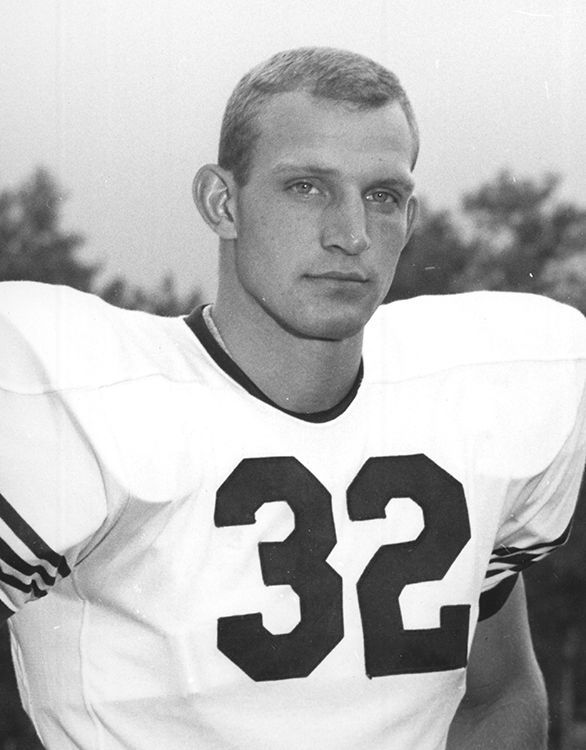
Don Hansen
Aug. 19, 2024
By a few historians, the collection of linebackers produced by the University of Illinois football program is second to none, and one of the most underrated players among that all-star group is 1960s standout Don Hansen.
A star recruit from Evansville, Indiana’s Reitz High School, Hansen began his Fighting Illini career as a fullback. He suffered a knee injury as a freshman and was moved to linebacker in 1963 where he played alongside Dick Butkus for the Big Ten champs. Hansen earned second-team All-Big Ten honors as a junior in 1964, then first-team laurels as a senior in ’65. Both seasons he gained honorable mention All-America acclaim.
Following impressive performances in three collegiate post-season all-star games, Hansen was selected in the third round of the 1966 NFL Draft by the Minnesota Vikings. He became the team’s Rookie of the Year for Coach Norm Van Brocklin. Hansen quit football following the 1967 campaign to partner in business with a relative in Evansville, but Van Brocklin talked him out of retirement to play for the ‘69 Atlanta Falcons. Highlighted by his selection as Atlanta’s Player of the Year in 1972, Hansen stayed with the Falcons through 1975. He started 70 of the teams 95 games during that seven-year period in Atlanta, while intercepting 10 passes and recovering 13 fumbles.
In 1976, Hanson played briefly for Seattle, then was traded to Green Bay where he concluded his 11-year NFL career in 1977.
Hansen was inducted into the Indiana Football Hall of Fame in 2014.
Today, Hansen celebrates his 80th birthday. He and his wife of 61 years, Sandy, reside in Snellville, Georgia. They have 11 grandchildren and three great-grandchildren.
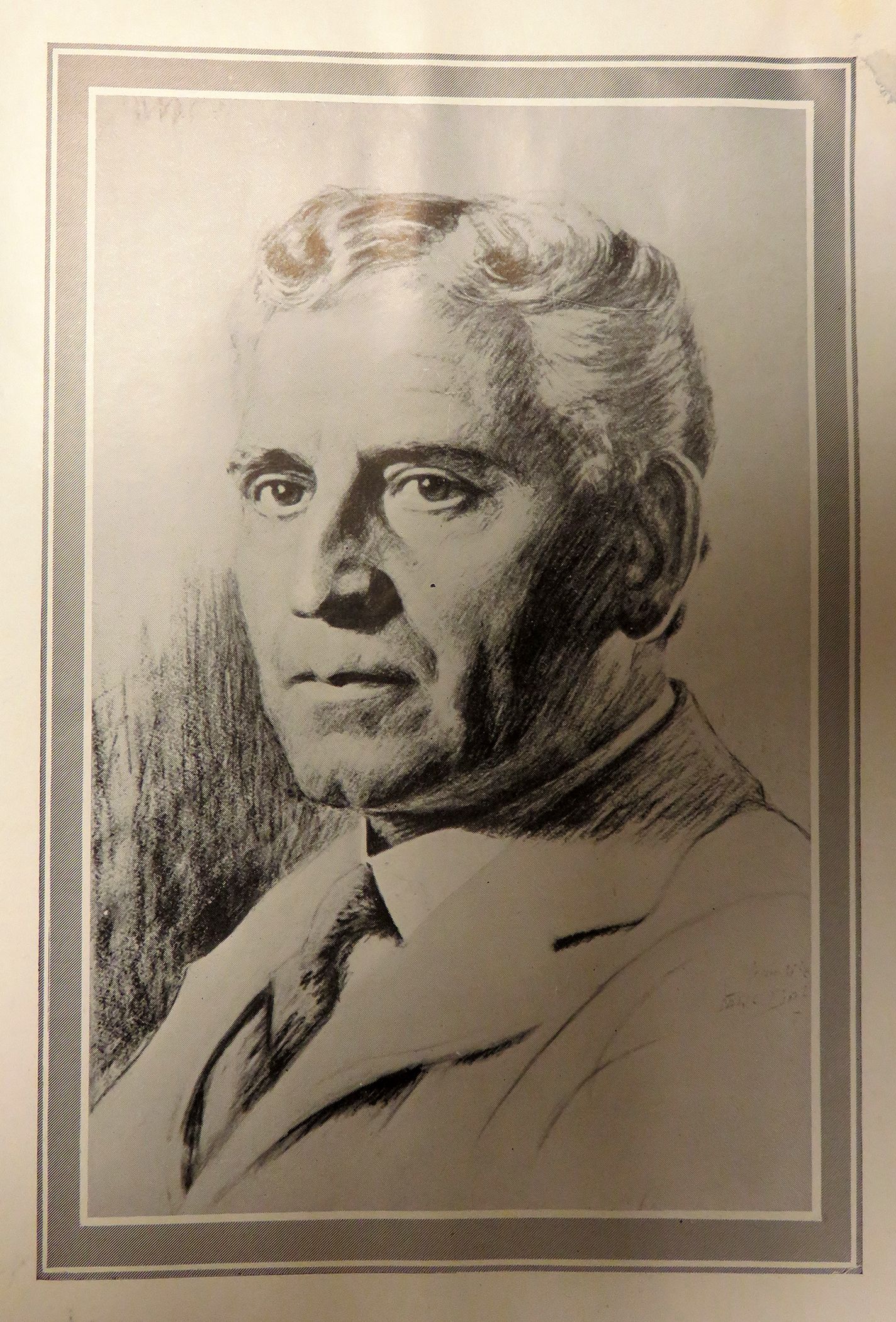
Illini vs. Amos Alonzo Stagg
Aug. 16, 2024
Born 162 years ago today—August 16, 1862—Amos Alonzo Stagg, the “Grand Old Man of the Midway”, played a significant role in the history of University of Illinois football.
Very few individuals over the first 100 years of the college game were more respected than the former Yale University All-American. In fact, Stagg was a charter class member of the College Football Hall of Fame (1951) as both a player and a coach.
Stagg’s counterpart at Illinois, Bob Zuppke, had high praise for the 41-year head coach of the University of Chicago Maroons.
“The name and influence of A.A. Stagg will live a long time in the Western Conference and American football,” Zuppke said. “He and Fielding Yost and George Huff are the men who made the Big Ten what it is. Through the years, I found Yost’s teams tougher defensively than Stagg’s teams at Chicago. But on offense, Alonzo Stagg had no superior. He applied imagination to his attack. Back in the days when his material was on a par with that of the other universities in the conference, it may have looked from the stands as though his teams merely used mass power to bowl over the defense. Actually, his offense was shifty and deceptive.”
Among many innovations, Stagg pioneered the man-in-motion, the fake handoff, cross-blocking, the T-formation and the quick kick.
From Stagg’s first season in 1892 through following 17 campaigns, the Maroons had their way with Illinois, posting a 9-2-2 record. One of UC’s pair of losses during that span ultimately resulted in a forfeit because of a dispute with the officiating.
Once Zuppke arrived on the scene in Champaign in 1913, UC’s long reign took a southward turn. During Stagg’s final 20 seasons in Chicago (1913-32), Zup’s Illini held a 13-5-2 edge.
Other interesting notes about Illinois’s 37 battles against Stagg and the UC Maroons:
• Illinois posted a 17-16-4 records during Stagg’s time in Chicago, including an 8-7 mark in Champaign-Urbana.
• UI and UC played twice against Stagg’s first squad (1892), a team for which he both played and coached. In the first meeting (Nov. 16), Chicago was leading 10-4 when officials called the game on account of darkness. Illinois protested and officials eventually ruled that the 4-4 halftime score would stand as the final score. Stagg himself scored the touchdown that was ultimately nullified.
• Illinois was awarded a forfeit victory over Chicago in 1894 when officiating again decided the result. When UI’s R.J. Hotchkiss ran for a 90-yard touchdown, UC’s captained claimed that he had asked for timeout. When the umpire requested the Maroons to play ball, they refused.
• On Oct. 31, 1896, the date of the Illini’s first-ever Big Ten Conference game (then officially known as the Intercollegiate Conference of Faculty Representatives), Chicago prevailed at Illinois Field, 12-0.
• In 1910, UC played Illinois at its first-ever Homecoming game. Otto Seiler’s 38-yard drop-kick field goal provided the Illini with a 3-0 victory.
• When Stagg and Zuppke coached against each other for the first time, host Chicago beat Illinois, 28-7.
• On Nov. 3, 1923, in a downpour at Memorial Stadium’s first game, 60,000 fans watched Red Grange score UI’s only touchdown, handing Chicago its only loss of the season.
• Stagg’s Maroons snapped a 15-game Illini winning streak in 1924 with a 21-21 tie in Chicago.
• In 70-year-old Coach Amos Alonzo Stagg’s final game against the Illini (1932), Bob Zuppke’s squad snapped a 10-game Big Ten losing streak with a 13-7 victory at Stagg Field.
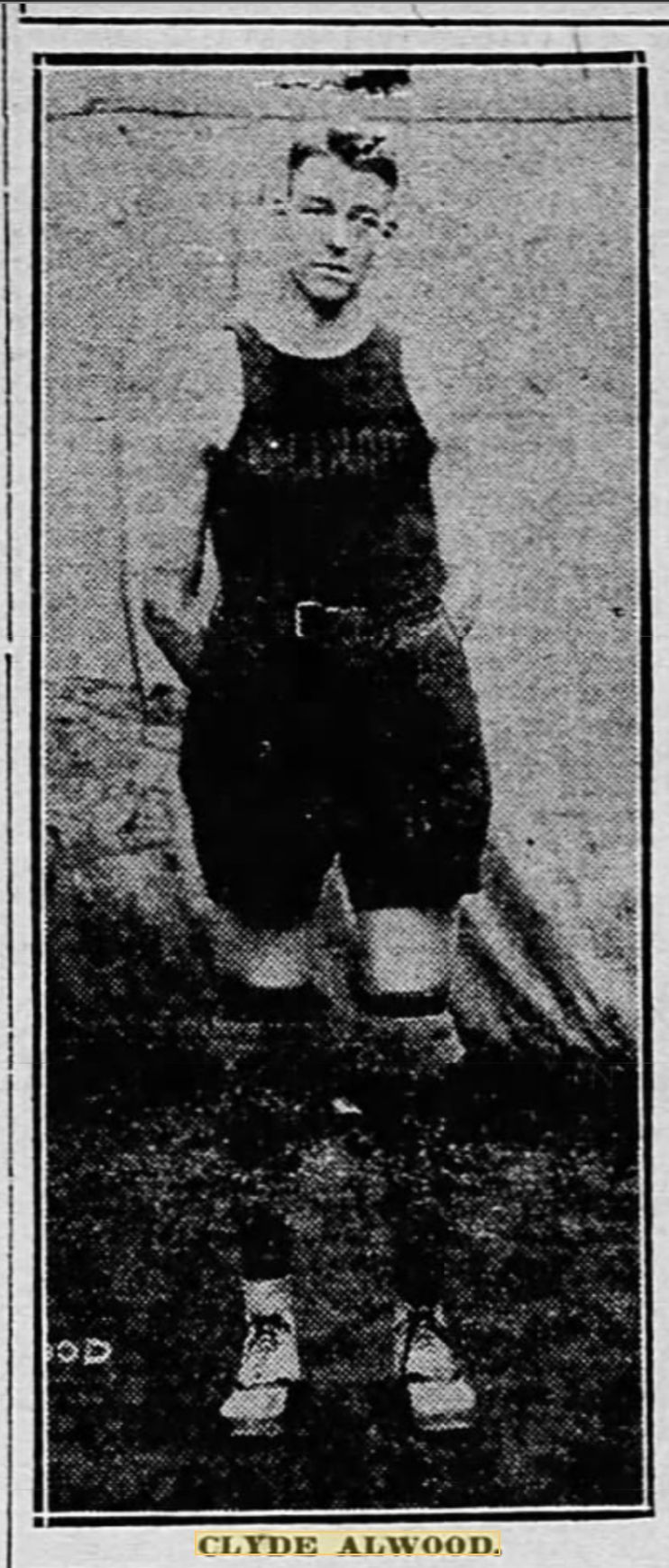
Clyde Alwood
Aug. 14, 2024
Clyde Alwood, the University of Illinois’ third-ever recipient of the Big Ten Conference Medal of Honor for athletic and academic excellence, died on this date in 1954 in his childhood hometown of Clinton, Ill.
The three-time letter-winning Fighting Illini basketball star, whose life ended from a fatal heart attack, was only 59. Alwood was visiting his childhood home to celebrate his mother’s birthday.
The 6-foot-4-inch center was a starter for Coach Ralph Jones’ 1915, ’16 and ’17 teams, units that posted a composite record of 42 victories and only six losses. During Alwood’s sophomore campaign, Illinois’ undefeated team (16-0) not only won the Big Ten title (12-0) but was also declared college basketball’s national champion.
In Alwood’s junior season, Illinois won its first eight games to extend UI’s winning streak to a school-record 28 victories in a row. The 1916 Illini lost only three of their 16 games and finished second in the conference standings.
The club that Alwood captained as a senior regained the conference title by posting a 10-2 record. He played alongside future UI Hall of Famers Ray Woods and George Halas that season.
Academically, Alwood majored in agriculture and upon graduation began operating a small farm near Marshall, Ill. Just two months after he received his UI degree, Bloomington High School hired him as its head basketball coach. That stint lasted only one season. Though he wasn’t sent overseas to fight during World War I, Alwood served in the U.S. Army as a YMCA instructor. Alwood eventually became a civil engineer with the Illinois Central Railroad, then a salesman in Indianapolis, Rockford and Beloit, Wis.
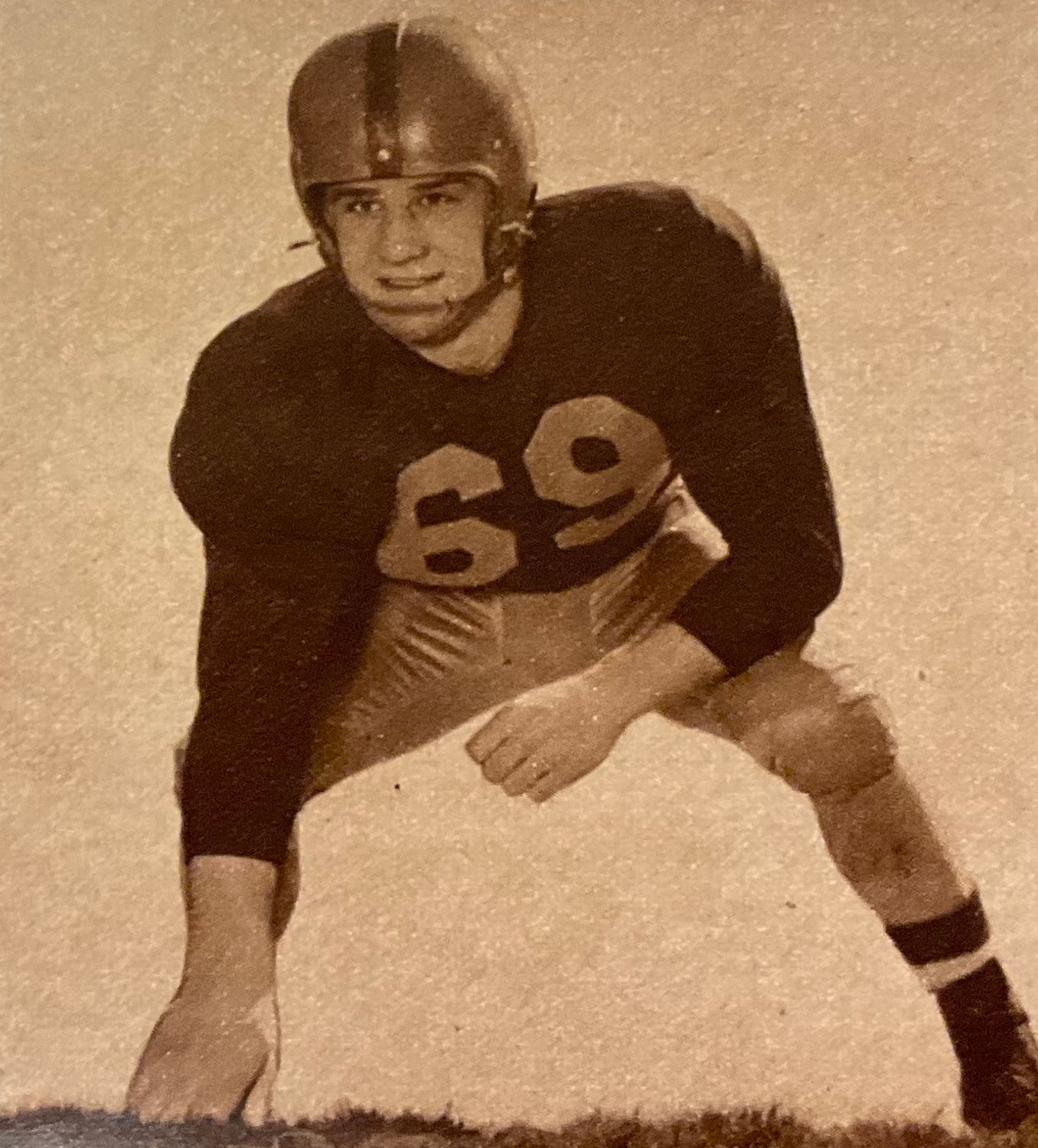
Best Offensive Lines
Aug. 12, 2024
Which Fighting Illini football team of the past had the best single collection of centers, tackles and guards? It’s all very subjective, of course, because offensive linemen don’t have individual statistics like their buddies in the backfield and at wide receiver.
Logic says that Illinois’s most successful teams in terms of wins and losses and championships probably also had the best offensive lines. Researchers could perhaps look at past All-Big Ten teams to define who the greatest stars were. Or one might also study the NFL rosters of the past to determine UI players’ length of service as professionals.
So, we took all three factors into consideration, ranked them one to ten in each category, and assigned point totals to create our own grading system. We judged seven different Illini teams that won Big Ten titles—1946, 1951, 1953, 1963, 1983, 1990 and 2001—plus three other teams that had multiple all-star linemen—1950, 1959 and 2007. We gave 12 points to the top set of linemen in each category, then ascended to nine points for the second-ranked unit, eight for No. 3, and all the way down to one point for tenth place.
For example, the Coach Ray Eliot’s ‘51 team had a school-record three first-team All-Big Ten honorees among their offensive line: center Chuck Boerio, guard Chuck Studley and tackle Chuck Ulrich. The ’51 squad also had the best overall winning percentage at .950 (9-0-1 record). However, only Ulrich (five years) and Boerio (one year) played in the NFL, so the ’51 unit ranks lower in that category.
Admittedly, we bent the rules a bit when assessing Dick Butkus as a pro, “guessing” that the legendary linebacker who also played center at Illinois probably could have also flourished on the offensive side of the ball.
Here is Illini Legends, Lists & Lore’s ranking of UI’s offensive lines, from one to ten:
1. 29 points - 1951: Dan Sabino (C), Chuck Studley (G), Don Gnidovic (G), Bob Weddell (T) and Chuck Ulrich (T)
2. 28 points - 1963: Dick Butkus (C), Wylie Fox (G), Ed Washington (G), Archie Sutton (T) and Bill Minor (T)
3. 26 points - 2001: Luke Butkus (C), Dave Diehl (G), Bucky Babcock (G), Sean Bubin (T) and Tony Pashos (T)
4. 21 points - 1983: Bob Miller (C), Chris Babyar (G), Rick Schulte (G), Jim Juriga (T) and Bob Stowe (T)
5. 18.5 points - 1990: Curtis Lovelace (C), Cam Pepper (G), Tim Simpson (G), Brad Hopkins (T) and Tony Laster (T)
6. 15 points - 1959: Dave Ash (C), Bill Burrell (G), John Gremer (G), Joe Rutgens (T) and Cliff Roberts (T)
7. 14.5 points - 2007: Ryan McDonald (C), Martin O’Donnell (G), Jon Asamoah (G), Xavier Fulton (T) and Akim Millington (T)
8. 14 points - 1950: Bill Vohaska (C), Charles Brown (G), Chuck Studley (G), Bob Weddell (T) and Chuck Ulrich (T)
9. 12 points - 1946: Mac Wenskunas (C), John Wrenn (G), Alex Agase (G), Lou Agase (T) and Bob Cunz (T)
10. 10 points - 1953: Herb Borman (C), John Bauer (G), Jan Smid (G), Bob Lenzini (T) and Don Ernst (T)
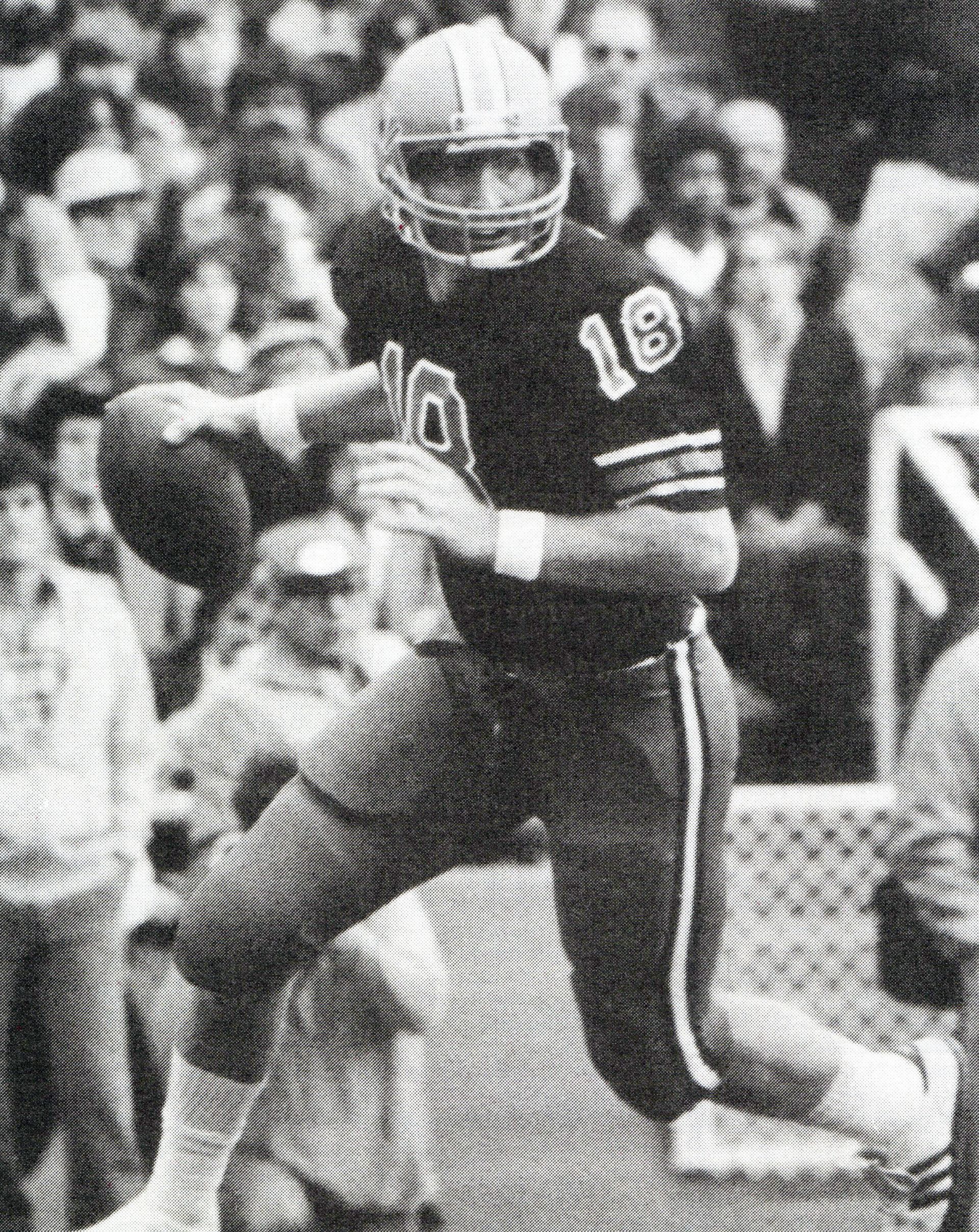
Big Ten Rescinds Illini Probation
Aug. 9, 2024
Forty-two years ago this week - Aug. 10, 1982 - faculty representatives of the Big Ten Conference rescinded the probation of the University of Illinois football team.
There had been a fierce fight between the school and the Big Ten Conference over the eligibility of the quarterback Dave Wilson. In 1981, the Fighting Illini received a three-year probation for permitting Wilson to play, even though his grades at Fullerton Junior College averaged less than C-. When the Big Ten ruled Wilson ineligible, he sued the conference to allow him to play.
Because of Illinois’ continued defiance of the conference, the Big Ten threatened to expel the university.
UI Chancellor John Cribbet told a news conference, “We felt we had no alternative but to accept the sanctions or withdraw from the conference. Withdrawal might have appeared to be attractive. It may have been the easy way to resolve this. But the long-term academic relationship with the Big Ten is more important than any short-term gratification we might have received.”
Wilson ultimately signed a multi-year contract with the New Orleans Saints after he was denied a second year of competition at Illinois when a federal judge ruled his case should not be ruled by the courts.
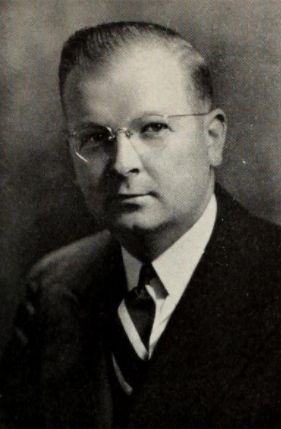
Chuck Flynn
Aug. 7, 2024
Charles “Chuck” Flynn, the longtime sports information director at the University of Illinois, was born on this date in 1912.
He began teaching journalism at the UI in 1937, then in 1944 became UI’s director of athletic publicity. In 1956, Flynn became the director of public information for the university.
He left the UI in 1975 to work for the News-Gazette. He died Oct. 11, 2003, at the age of 91.
Here are some of the Fighting Illini’s most notable athletic events during Flynn’s time as SID:
- 1944: Football star Buddy Young finished fifth in Heisman Trophy balloting.
- 1945: Illini football teams began using airplanes to travel to away games.
- 1946-47: UI won the Big Ten and played in its first-ever Rose Bowl game.
- 1947: Senior track star Herb McKenley finished his record-breaking career at UI.
- 1949: Illini basketball team played in the Final Four (also 1951 and ’52).
- 1950: UI’s golf course in Savoy opened.
- 1951-52: Illinois’ football team played in Rose Bowl.
- 1951-52: Illini athletic teams won record eight Big Ten titles.
- 1952: Football’s Al Brosky ended his career with an NCAA record eight interceptions.
- 1955-56: UI’s gymnastic team won back-to-back national championships.
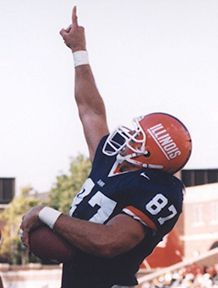
Josh Whitman
Aug. 5, 2024
Happy 45th Birthday today to University of Illinois Director of Athletics Josh Whitman. The former Fighting Illini football player answered a series of questions for Illini Legends, Lists & Lore about his career as an athlete.
• Who most inspired your career in sports? “My dad (Mark) was a coach and a teacher. My earliest memories are playing catch or shooting baskets with my dad. No matter how tired he might have been, he always made time. He instilled in me a love of sports and competition that has defined much of my life.”
• What was something your mom (Mary Beth) taught you that remains important to you today? “My mom taught me to love reading. Growing up, when I wasn’t playing sports, you were likely to find my nose in a book. My mom, who was an elementary school teacher and later a school media specialist and librarian, always made sure I had access to tremendous books. Now, with our daughter almost two and our son just born, the thing I learned most from my mom and dad was how to be a loving, supportive, encouraging parent. They were the best.”
• Growing up in West Lafayette, who was your favorite Boilermaker athlete? “I admired basketball player Steve Scheffler and football player Mike Alstott. Both were big, rugged, tough guys, and I was at a point in my life when I was starting to push myself athletically to compete at a high level. Those guys were tremendous role models for the work ethic and toughness required to be great.”
• What was your most memorable game at William Henry Harrison High School? “My senior year at Harrison, we competed in the state’s last single-class basketball tournament (as seen in the movie Hoosiers). In Indiana, winning the sectional, the state tournament’s opening round, was a really big deal. Because it was a single class, the opening round pitted us against all the other local schools. We hadn’t won the sectional since the early 1980s, but my senior year we defeated Lafayette Jefferson, our cross-town rival, to take the title. It was one of the most exciting experiences of my life. Our high school and community rallied around that team like nothing I had ever seen. Students camped outside the school to buy tickets as soon as they went on sale. It was pretty incredible.”
• Who was the most impressive basketball player you competed against in high school? I played against Kevin Garnett in an AAU tournament. That didn’t go so well.
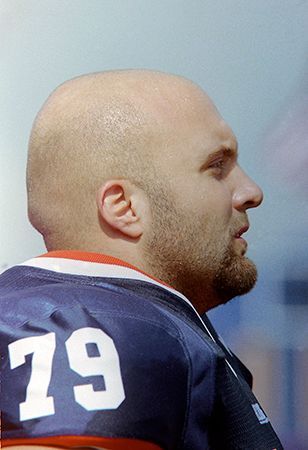
Tony Pashos
Aug. 2, 2024
Celebrating his 44th birthday on Saturday (Aug. 3) is former Fighting Illini football all-star Tony Pashos. Born in Palos Heights and a graduate of Lockport Township High School, his parents (Georgios and Despina) immigrated to the United States from Greece.
His career story, by the numbers:
2 - Seasons he earned first-team All-Big Ten honors as an offensive lineman.
3 - Number of languages Pashos speaks (English, Greek and German).
5 - NFL Draft round in which he was selected by the Baltimore Ravens.
9 - Number of varsity letters Pashos was awarded at Lockport High.
12 - Illinois’ final AP team ranking in 2001, his junior season.
47 - Consecutive career starts he made at Illinois.
79 - Jersey number Pashos wore for the Illini and for most of his NFL player.
82 - Number of career starts he made during his NFL career, including every game in 2006, ’07, ’08, 11 and ’12.
325 - His playing weight as a pro.
2002 - Season he served as an Illini co-captain and won the Bruce Capel Award as the team’s most courageous player.
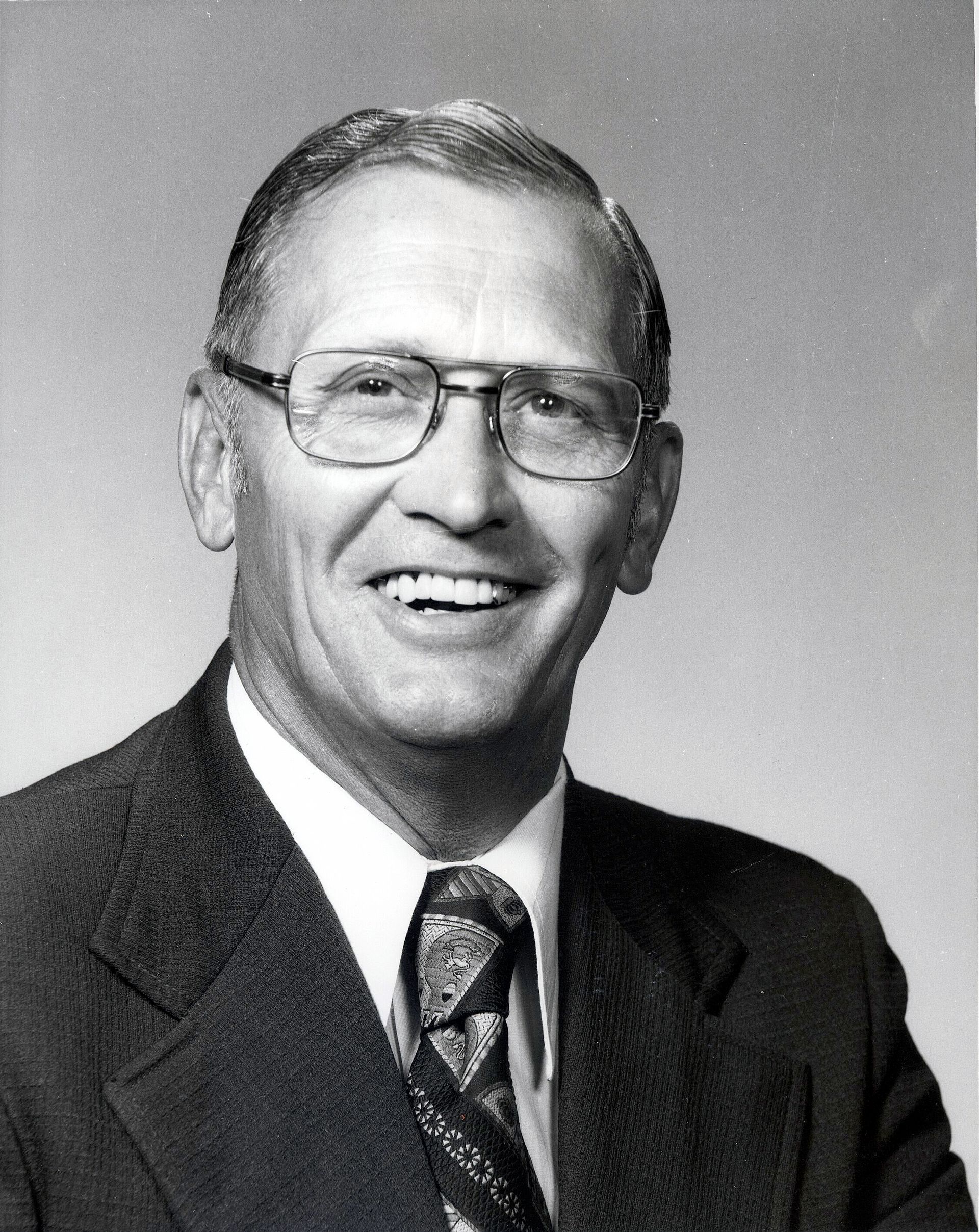
Cecil Coleman
July 31, 2024
Fifty-two years ago tomorrow—August 1, 1972—Cecil Coleman began his seven-year reign as director of athletics at the University of Illinois. He assumed duties as AD when Gene Vance resigned.
A native of South Bend, Indiana, Coleman came to Illinois from Wichita State University and served as president of the National Association of Collegiate Director of Athletics (NACDA) during the 1972-73 season, his first at Illinois.
Though Coleman might not have been one of UI’s most popular athletic directors, he had a hand in numerous history-making decisions, including:
*October, 1973: Coleman headed up a $1.65 capital campaign to upgrade UI’s aging Memorial Stadium with artificial turf and lighting.
*June, 1974: Capping the establishment of UI’s new women’s intercollegiate athletics program, he hired Dr. Karol Kahrs to become UI’s first assistant director for women’s athletics.
*April, 1975: Coleman hired Lou Henson as head basketball coach. Henson went on to accumulate a record of 423-224 in 21 seasons.
*June, 1977: UI’s Memorial Stadium hosted the 1977 NCAA Track & Field Championships. Illinois also served as hosts for the 1979 national meet.
*April, 1979: Despite ultimately being dismissed as UI’s athletic director, Coleman had successfully improved the school’s image with the NCAA and had balanced UI’s athletic budget.
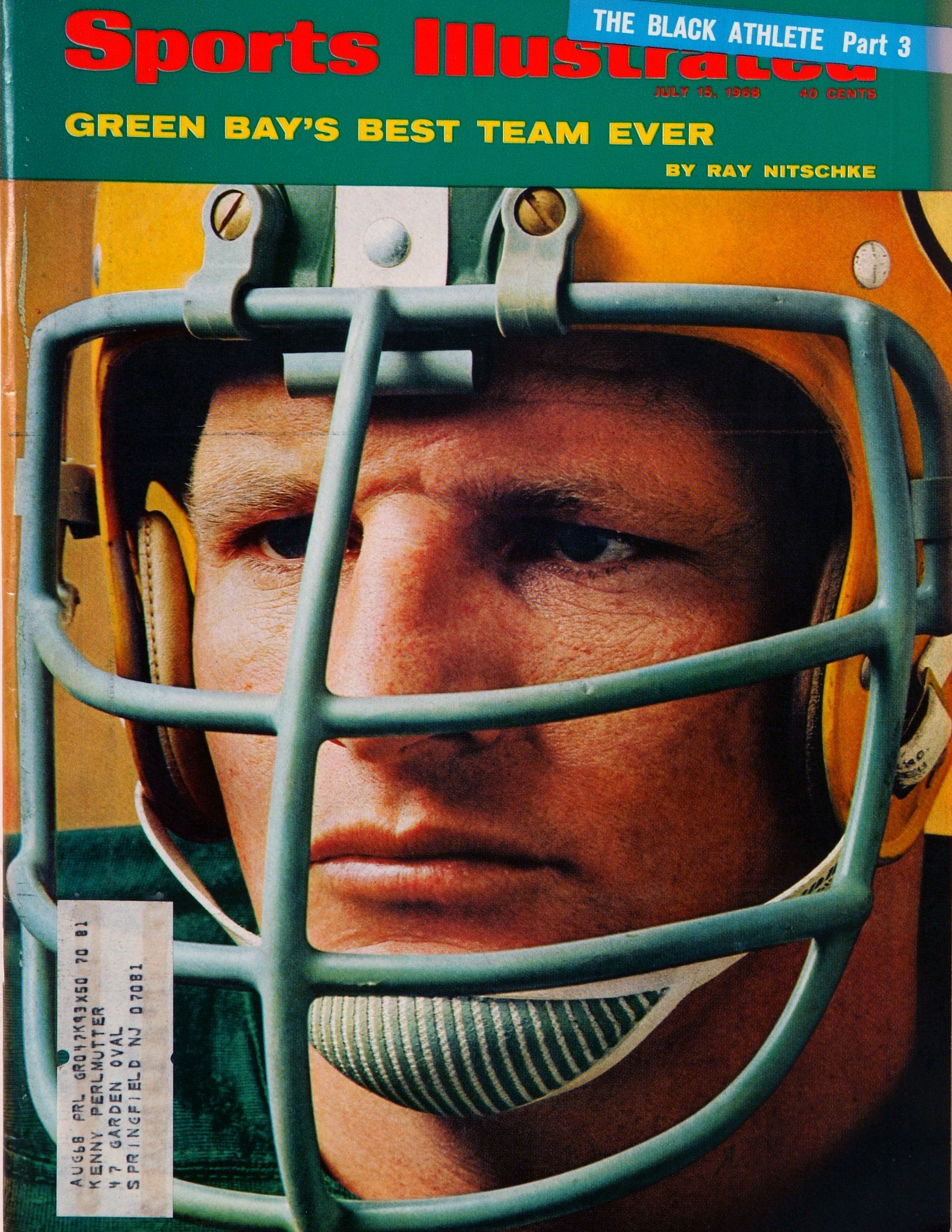
Ray Nitschke
July 29, 2024
Forty-six years ago today, Ray Nitschke was inducted into the Pro Football Hall of Fame in Canton, Ohio.
Other stars who joined the former Fighting Illini great in the Class of 1978 included Lance Alworth, Weeb Ewbank, Alphonse “Tuffy” Leemans and Larry Wilson.
Nitschke was born in Elmwood Park, Illinois. Due to the death of his father when Ray was three years old and the death of his mother shortly after his 13th birthday, he was raised by his older brother.
An all-state quarterback at Proviso East High School in 1953, Nitschke accepted a scholarship offer from the University of Illinois. Besides playing linebacker, he also was a rugged fullback, once scoring four touchdowns in a game against Iowa State.
The Green Bay Packers chose Nitschke as the 36th overall pick in the 1958 NFL Draft. He eventually became the anchor of a Packer defense that helped the franchise win five NFL championships and the first two Super Bowl games. Nitschke, the owner of retired Packers jersey No. 66, was named the NFL’s greatest linebacker in 1969.
In 1999, The Sporting News ranked him No. 18 when it chose the top 100 players in NFL history. Nitschke died at the age of 61 in 1998.
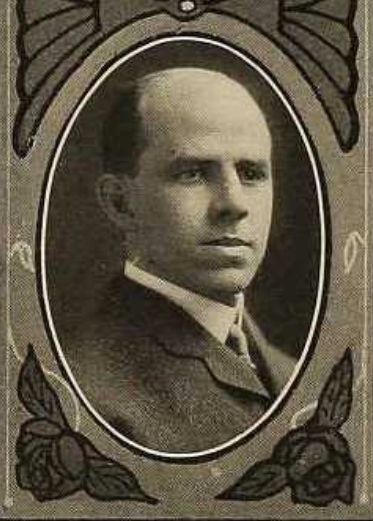
Harry Coffeen
July 27, 2024
Born on July 27, 1877, in Champaign was former Fighting Illini football and track letter winner Harry Coffeen.
The graduate of Champaign High School matriculated to the University of Illinois where he played football for head coach George Huff. In 1896, Coffeen played in Illinois’ very first Big Ten football game against Chicago and also participated in UI’s first Big Ten victory versus Purdue in 1897. He captained the Illini track and field in 1896.
Following his graduation, he attended graduate school at the University of Pennsylvania to study astronomy. Coffeen returned to Illinois in 1900 to teach engineering drawing, then moved on to Armour Institute in Chicago. At Armour, he was faculty manager of athletics and founded a chapter of Tau Beta Pi fraternity.
Coffeen eventually became a life insurance specialist for the Northwestern Mutual Life Insurance Company, rising to president of the national association of agents of that company. He also served as president of Illinois’ Alumni Association for one year.
Coffeen passed away on September 14, 1924, in Chicago, at the age of 47.
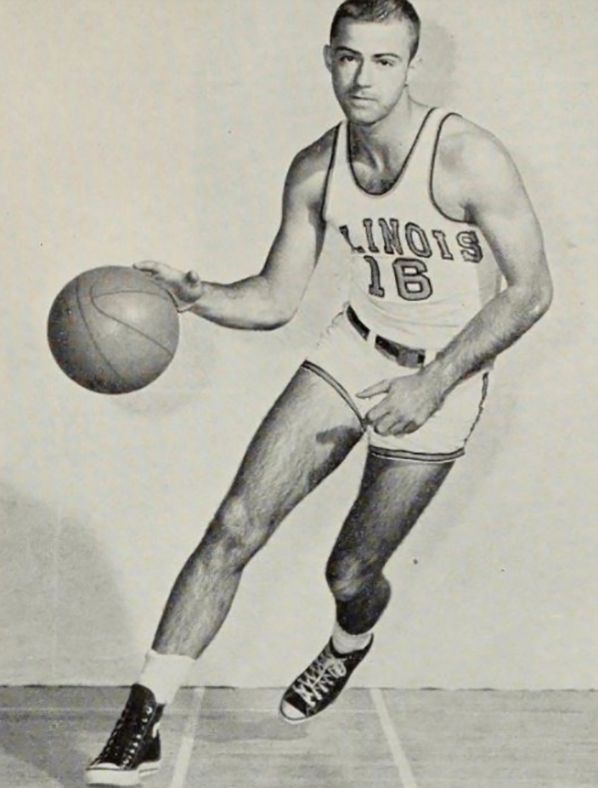
Jim Wright
July 24, 2024
Though Illini fans more familiarly associate Jim Wright with Illinois basketball, few know that the longtime Urbana resident also was a two-time Big Ten pole vault champion.
He contributed to UI’s 1953 outdoor track and field team title with a winning vault of 13-feet, then both he and the team duplicated those championships the following season as well.
The Lawrenceville High School graduate wore jersey number 16 for Coach Harry Combes’ Illini basketball team. Wright earned three additional varsity letters at Huff Gym. As a sophomore in 1951-52, he and his UI teammates won the Big Ten title and advanced to the NCAA’s Final Four. Illinois’ ’52-53 squad finished second in the conference standings.
In 1953-54, Wright’s senior season, he became a starter alongside John Kerr, Paul Judson, Bruce Brothers and Max Hooper. Wright was the Illini’s third-leading scorer, averaging 8.4 points per game.
Following two seasons of military service, Combes brought Wright on in 1958 to become his second assistant coach. He served a total of 13 seasons for Combes, heading up Illinois’ scouting operation and coaching UI’s freshman team. Wright’s coaching highlight came in 1963 when the Illini won the Big Ten title.
When Harv Schmidt became Illinois’ coach in 1967, he retained Wright as his assistant until 1972. Wright began his C-U based insurance company in 1954 and continued it for a total of 58 years, most recently on South State Street in Champaign. His wife, Barbara, operated Wright Real Estate for several years.
They have two children, Jim, who resides in Gainesville, Fla., and Susan who lives in Jacksonville, Fla., plus five grandchildren. Jim and Barbara winter at Amelia Island in Florida. Today, Jim celebrates his 92nd birthday.
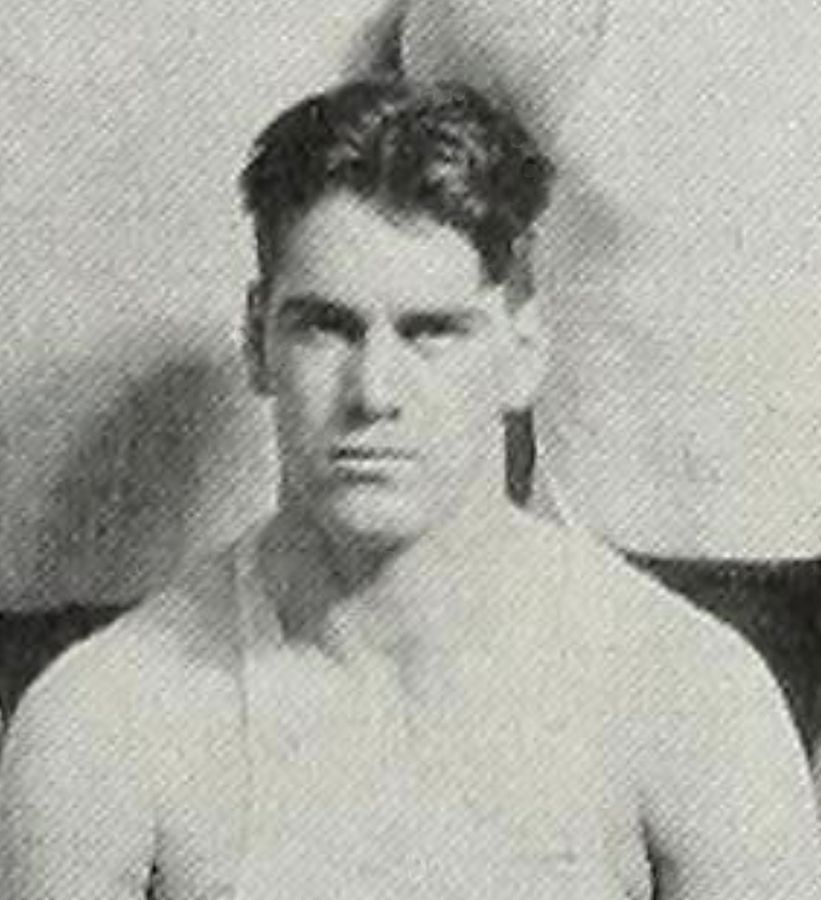
Ralph Webster
July 19, 2024
Born on this date in 1906 was Fighting Illini wrestling’s first-ever All-American, heavyweight Ralph Webster.
A three-time letter winner from 1926-28 for Coach Paul Prehn, the Raccoon, Ind. native helped Illinois win three consecutive Big Ten championships. Webster’s Illini teams won 17 of its 19 dual meet matches during those seasons.
Though Webster never won an individual conference title, he accomplished his greatest singular fame at the first NCAA Championships in 1928, hosted in Ames, Iowa. After pinning Ralph Freese of Kansas in the semifinal match, he was pitted against Oklahoma State’s Earl McCready. Unfortunately for Webster, McCready won by fall in just 19 seconds.
Webster majored in Athletic Coaching at the University of Illinois, then became a lifetime employee of the Columbus (Ohio) Board of Education. Initially, he was a teacher and multi-sport coach at Columbus East High School. His greatest athlete at East High was Ohio State Buckeyes Hall of Famer Bill Willis, who Webster originally suggested to play for Coach Ray Eliot at Illinois. Unfortunately, OSU coach Paul Brown intervened and the rest, as they say, is Buckeye history.
Webster moved onto become the longtime athletics director of Columbus Walnut Ridge High School, retiring in 1974. He was inducted into the Ohio Coaches Hall of Fame in 1992.
Webster died on Feb. 28, 1976 in Bexley, Ohio.
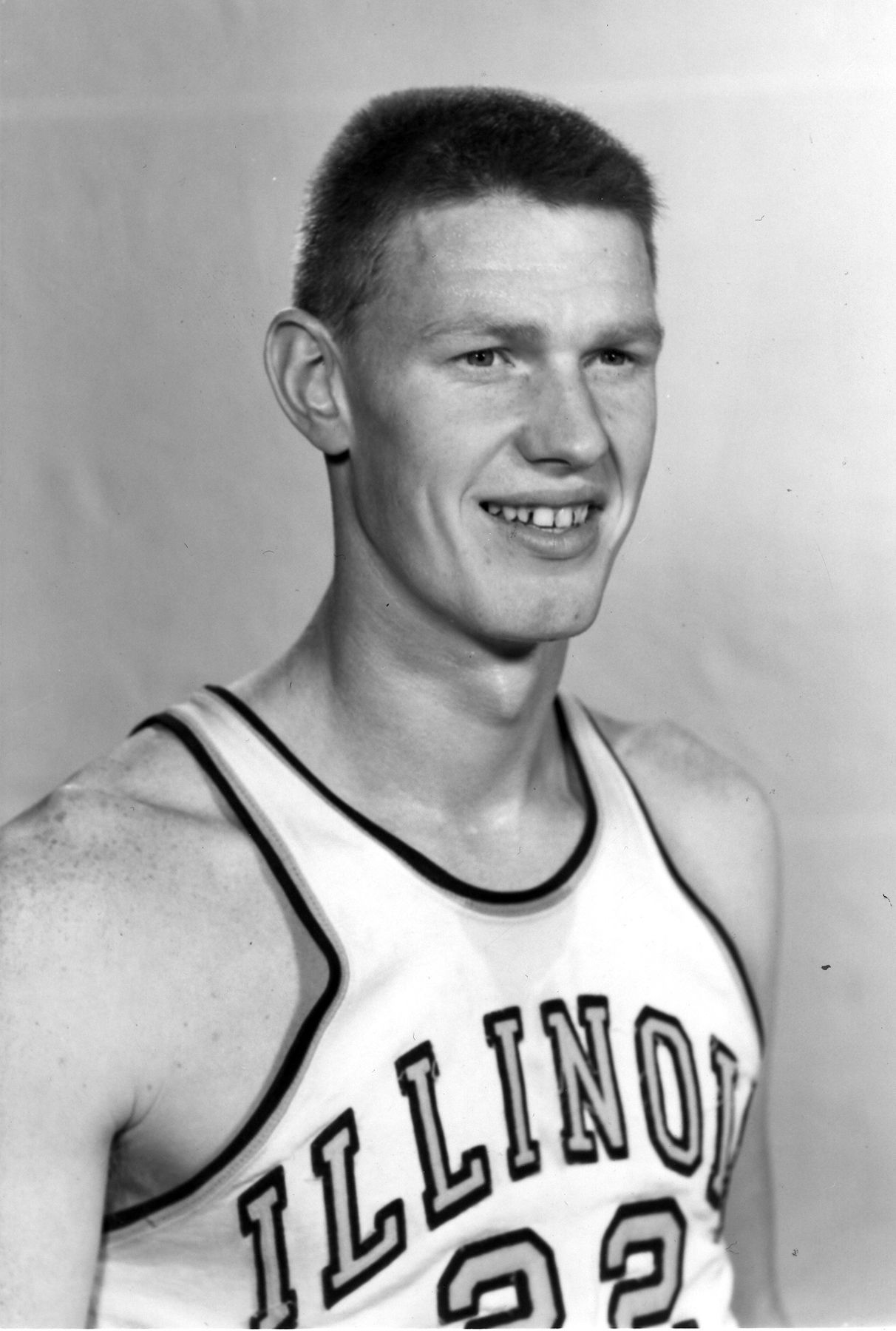
Johnny "Red" Kerr
July 17, 2024
Today marks the 92nd anniversary of the birth of University of Illinois basketball legend John Graham “Red” Kerr. He was a member of the second class inducted into the Illini Athletics Hall of Fame (2018).
A person living today would need to be in his mid-to-late 70s to be able to remember the incredible career Kerr enjoyed as an Illini player or to be in his 60s to be able to recall his amazing consistency as an NBA star.
Today’s Illini Legends, Lists & Lore will attempt to refresh the memory of those senior citizens and to enlighten folks younger than them as to just how outstanding a basketball career Johnny “Red” Kerr had.
Did you know ...
•An eight-inch growth spurt before and during Kerr’s senior year at Chicago’s Tilden Technical High School changed his focus from soccer to basketball. Kerr had initially intended to attend Bradley University but changed his mind to play for the Illini following a visit from Irv Bemoras. Kerr ultimately was inducted into the Illinois Basketball Coaches Association.
•Kerr’s senior season as an Illini player, he averaged a school-record 25.3 points per game, passing Bemoras as UI’s career scoring leaders. Kerr’s career total of 1,299 points would be eclipsed until nine years later (by Dave Downey). The Chicago Tribune selected him as the Big Ten’s Most Valuable Player.
•The Syracuse Nationals chose Kerr as the sixth pick in the 1954 NBA Draft. The first five players selected included top pick Frank Selvy of Furman, then Bob Pettit, Gene Shue, Dick Rosenthal and Togo Palazzi.
•Playing the same position as Bill Russell and Wilt Chamberlain, Kerr played in the NBA All-Star Games in 1956 (4 points/8 rebounds), 1959 (7/9) and 1963 (2/2).
•Kerr averaged 11.15 rebounds for his game, a number that ranks 27th on the current all-time list. Just ahead of him on the list in 26th place is Kareem Abdul-Jabbar with 11.18 per game. Immediately following Kerr on the list are Hakeem Olajuwon (11.11), Dave DeBusschere (10.99) and Shaquille O’Neal (10.85).
•His NBA career ended on Nov. 4, 1965. His final career totals as a professional player included 905 games, 12,480 points and 10,092 rebounds. Kerr currently ranks among the top 60 on the NBA’s all-time scoring list.
•Kerr was a true NBA iron man, playing in a record 844 consecutive games. He held the record for 17 years, finally handing over his honor to Randy Smith on Nov. 3, 1982.
•On May 3, 1966, Kerr was named head coach of the Chicago Bulls. Though his first Bulls team had a win-loss record of 33-48, Chicago became the first expansion team to make the NBA playoffs in its inaugural season. Kerr was named NBA coach of the Year and is the only coach to receive the award after his team finished with a losing record.
•Players that Kerr tutored during his two seasons as the head coach of the Chicago Bulls (1966-67 and ’67-68) and the Phoenix Suns (1968-69 and ’69-70) include Jerry Sloan, Bob Boozer, Gail Goodrich and Dick Van Arsdale.
•He became the Chicago Bulls’ color commentator in 1975, serving alongside play-by-play announcer Jim Durham. Kerr remained in that role through the 2007-08 season, calling all six of the Bulls’ six championship campaigns.
•Kerr passed on Feb. 26, 2009, only hours after the death of fellow Bulls legend Norm Van Lier.
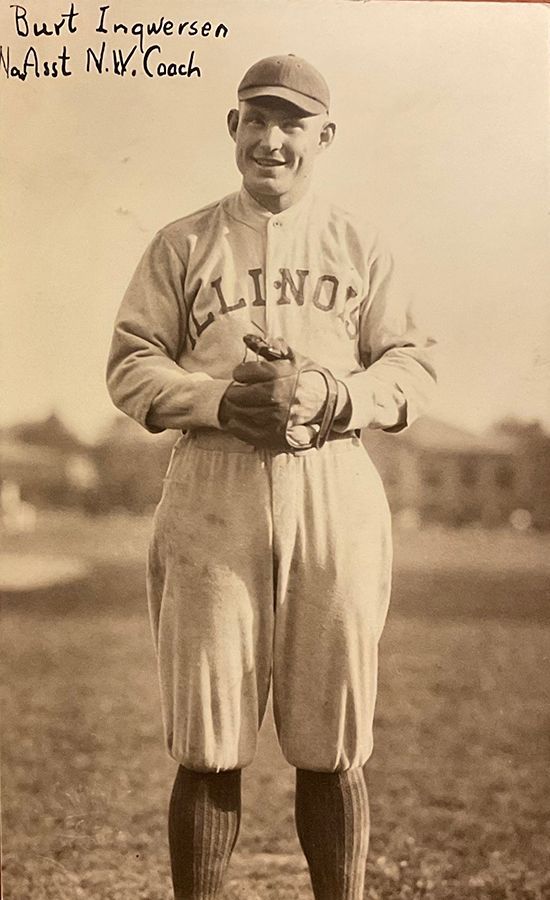
Burt Ingwersen
July 15, 2024
Fifty-five years ago on this date in Fighting Illini history—July 15, 1969—University of Illinois legend Burt Ingwersen died at the age of 70.
Illinois’ first nine-letter winner, the Bryant, Iowa native won monograms in 1917, ’18 and ‘19 for Coach Bob Zuppke as an All-Big Ten and second-team All-America tackle.
George Halas, his Illini teammate, said Ingwersen had “the greatest spirit and desire of any football player I’ve ever known.” Illinois claimed the conference title in his junior season and the Big Ten and national championships in his senior year.
Ingwersen was a first baseman for Coach George Huff’s Illini baseball team in 1918, ’19 and ’20 and a forward for Coach Ralph Jones’s basketball squad during that same span.
Earning a UI civil engineering degree in 1920, he was hired by the Iowa Highway Commission. Ingwersen also played for Halas’s Decatur Staleys, forerunner of the Chicago Bears. Huff brought Ingwersen back to Illinois in 1921 as the school’s freshman coach in the three sports he’d previously lettered. He was Red Grange’s first collegiate coach.
When former Illini football letter winner Paul Belting was hired at athletics director by the University of Iowa in March of 1924, Belting’s first item of business was to find a replacement for football coach Howard Jones. He began negotiating with Notre Dame’s Knute Rockne to come to Iowa City. However, it turned out to only be a plot by Rockne to get a raise. When the Fighting Irish administration complied, Belting turned to the 26-year-old Ingwersen. In his first of eight years as the Hawkeyes’ head coach (1924-31), Ingwersen’s team had a 6-1-1 record, including a scoreless tie against Ohio State and a victory over Michigan. In five of his next seven years, Iowa had three winning teams and a pair of .500 ledgers, but he was fired following a 1-6-1 record in 1931.
Ingwersen then served as assistant coach at LSU and Northwestern, then entered the Navy in 1943, serving as a lieutenant commander and athletic director at North Carolina Pre-flight School in Chapel Hill.
He returned to Champaign-Urbana in 1945, helping Coach Ray Eliot teams win Big Ten titles in 1946, ’51 and ’53 as UI’s offensive and defensive line coach. When Eliot was replaced by Pete Elliott in 1960, Ingwersen continued in that role for seven more seasons, including the 1963 Big Ten championship campaign.
Following his retirement in 1966, Ingwersen remained active in Illini athletics, working with the grants-in-aid program.
He was married for nearly 45 years and had one son.
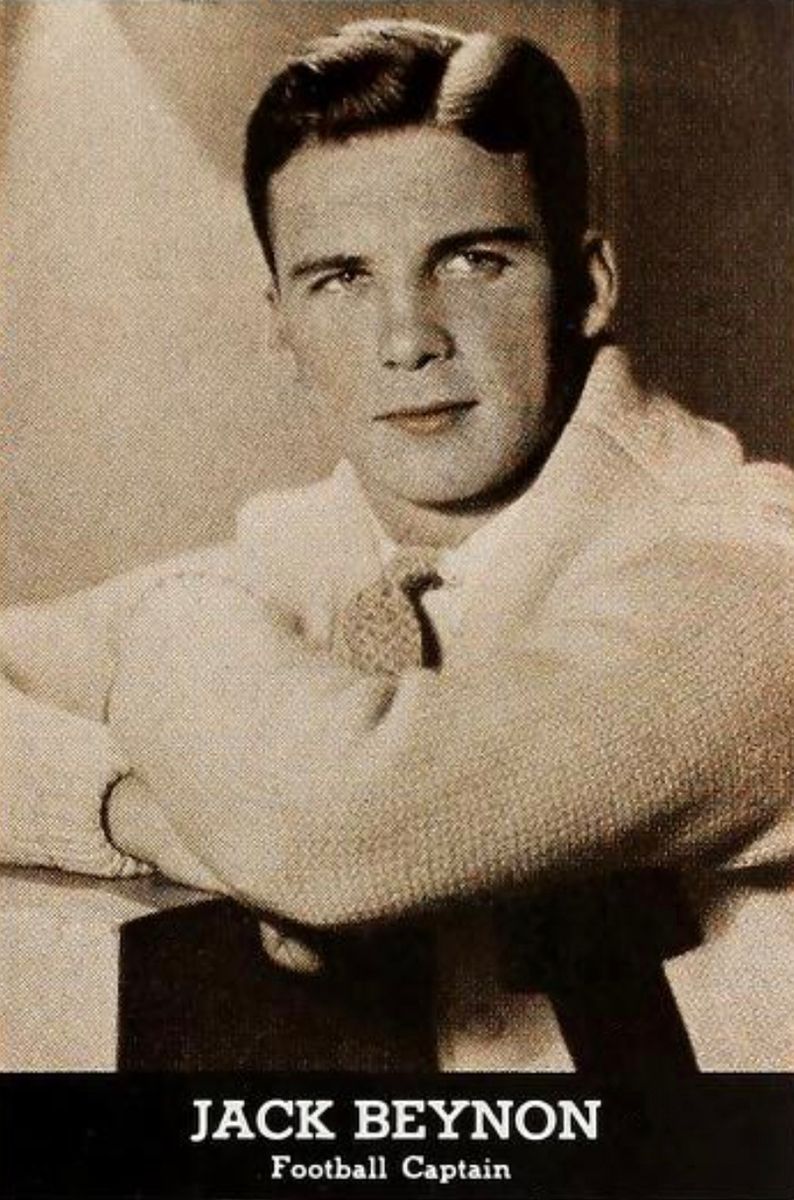
Jack Beynon
July 12, 2024
Over the years, Rockford has sent a legion of special athletes to the University of Illinois, though few measure up to the accomplishments of 1930s Fighting Illini star John “Jack” Beynon.
Beynon was a three-sport star for Rockford High School, but he was best known as the star quarterback for the Rabs’ powerhouse 1930 football team. Outscoring its opponents by a cumulative score of 279-18, the talented signal caller ran for 20 touchdowns and passed for four more, including three to Rockford captain and future Illini teammate Bart Cummings.
As a player for Coach Bob Zuppke, Beynon helped the Illini rebound from back-to-back losing seasons in 1930 and ‘31. Coordinating a flea flicker-type offense that was based on principals of laterals and reverses, Beynon’s senior squad in 1934 raced to victories in each of its first six games and ended with a 7-1 mark. The highlights included a 14-13 win at Memorial Stadium versus Ohio State.
The game-winning touchdown against the Buckeyes in ’34 was eventually dubbed by scribes as the Flying Trapeze play. Starting at OSU’s 36-yard line, Illini fullback John Theodore took the ball on a direct snap and faked a dive into the line. Just before reaching the line of scrimmage, Theodore tossed a lateral to guard Chuck Bennis. Bennis dropped back and fired another lateral to halfback Les Lindberg, who sprinted to the right, then spun and fired a 25-yard cross field lateral to Beynon. The Illini captain, who had gone into the OSU secondary as though he was a potential receiver, had backtracked behind UI’s line of scrimmage. Beynon then tossed a perfect arching pass into the hands of Gene Dykstra for the deciding 36-yard TD.
Also a two-time letter winner for Coach Craig Ruby’s Illini basketball squad, Beynon was an iron horse for Zuppke’s football team in 1934, playing an estimated 297 of the 300 minutes during Illinois’s five Big Ten Conference games. He was rewarded with first-team all-league honors and second-team All-America kudos. Beynon played in the College All-Star game on a team that included future United States President Gerald Ford from Michigan.
He rejected a $150 per game offer to play for George Halas’s Chicago Bears to instead attend law school. From 1943-46, Beynon’s legal career was interrupted by a three-year Army stint during World War II.
Beynon ultimately become Winnebago County’s very first public defender in 1966. Five years later, he was appointed as an associate judge. In 1981, he became a Circuit Court judge in Rockford’s 17th district.
Jack Beynon, who was born on July 12, 1913 in Chicago, died on Oct. 17, 1989 at the age of 76.
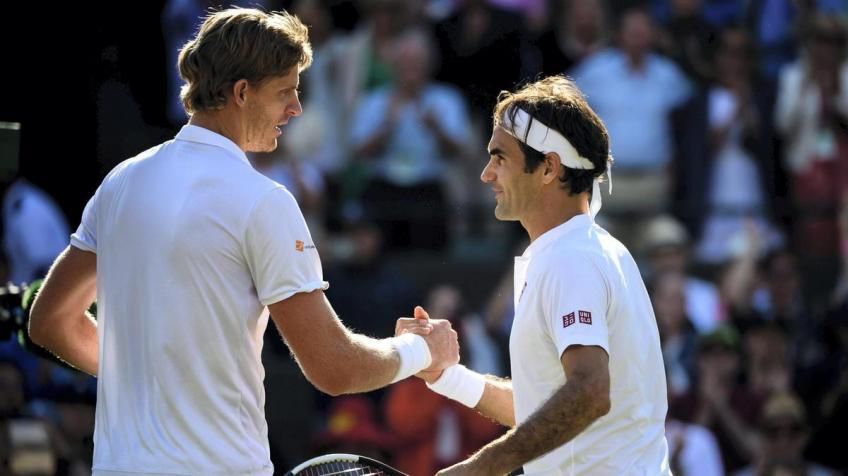
Kevin Anderson vs. Roger Federer
July 10, 2024
Six years ago this week - July 11, 2018 - for a total of four hours and 14 minutes, the tennis world was captivated by the 2018 Wimbledon quarterfinals dogfight between Fighting Illini alumnus Kevin Anderson and Roger Federer.
Predictably, experts pointed to past statistics and predicted that the match at the All England Club wouldn’t be close. After all, Federer hadn’t lost a single set in more than two year—34 in a row—and Anderson had never taken a set off of Federer in any of their four previous matches.
In the first set, Federer breezed past his six-foot-seven-inch opponent, winning 6-2. He dismantled Anderson’s typically stellar service game with three service breaks and held his own serve to love. In just 26 minutes, Federer disarmed both Anderson’s serve and his wicked forehand stroke.
Despite being schooled in set one, Anderson told the media corps afterwards that he just “tried to keep fighting. I kept telling myself that I have to keep believing that today is going to be my day.”
The lanky South African displayed remarkable resiliency in the second set, breaking Federer’s serve for the first time in a year and charging off to a 3-0 lead. However, the Swiss star managed to gather himself at the changeover and rallied for a 7-6 victory to take a 2-0 lead.
Except for Anderson himself, nary a soul expected that the former Illini star would rally against Federer. Yet Kevin remained quietly confident.
“Down two sets to love, I really tried my best to just keep fighting,” he said. “If you go out there with doubts, it’s not going to go your way.”
In set three, Federer held a match point with Anderson serving at 4-5. Kevin attacked with his forehand and got a huge break with Federer mishit a backhand passing shot. That play and a few unreturnable serves resulted in a 7-5 Anderson victory.
Said Federer after the match to the press, “I’m up two sets to one and so I wasn’t thinking of losing.”
But the quietly confident Anderson wasn’t about to concede anything either and he continued to play with a nothing-to-lose attitude. In fact, he was playing the best tennis of his life, making Federer play much faster than his normal pace. Anderson’s 6-4 victory the match at two sets apiece.
It would prove to be a legendary fifth set, staying even at 4-4, 8-8 and 10-10. At 11-11, Federer suffered a deadly error, making his first double fault of the match to give Anderson a break point. Anderson launched a 128 miles per hour serve to Federer’s backhand and the return sailed well out of bounds. Kevin Anderson humbly approached the net to shake Federer’s hand. The king of grass graciously patted Anderson’s chest in defeat and victory belonged to the former Illini.
“In the fifth set, I was really in the flow of the match,” Anderson said. “Beating Roger Federer here at Wimbledon will definitely be one that I’ll remember, but now I’ve got to get ready for my next match.”
Anderson, the eighth seed, made it past American John Isner in the semifinals. That match lasted more than six hours an included a 26-24 final set.
“I’m definitely not feeling as fresh now as I was coming into the week,” said Anderson in a major understatement.
Unfortunately, Anderson’s luck ran out in the Wimbledon finals, losing in straight sets to Novak Djokovic, 6-2, 6-2, 7-6.
“Novak beat up on me pretty bad in those first two sets,” Anderson told the crowd in his post-match address at Center Court. “I came within a point or two of pushing it to a fourth set, but Novak is the true champion of our sport. Hopefully, within the next 20 years, another South African will be standing here saying that they saw me playing here and that I served as an inspiration for them.”
Said Djokovic after the final match, “Kevin has had an incredible run. In today’s third set, he was the better player.”
Without question, the five-day period from July 11 through 15, 2018 will go down as the finest moment in Kevin Anderson’s career.
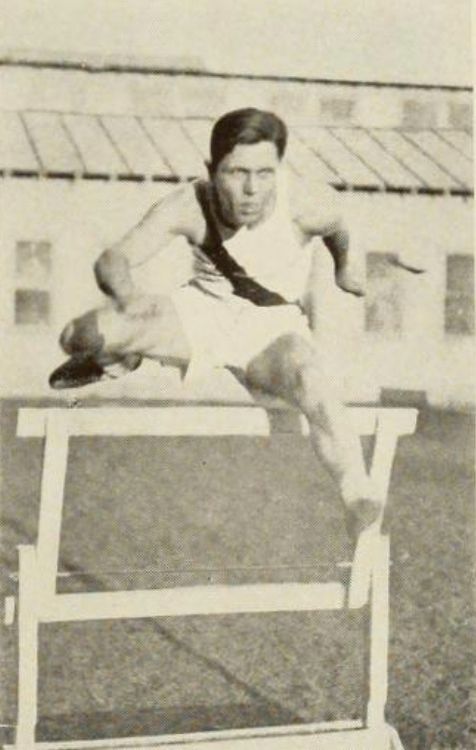
Franklin "Pitch" Johnson
July 8, 2024
Letterman, captain, record-holder, Olympian, Hall of Famer … Franklin Pitcher “Pitch” Johnson was all of these during a storied career that began with Coach Harry Gill’s University of Illinois track and field team.
One-hundred years ago today—July 8, 1924—Johnson enjoyed one of his proudest moments, racing by himself at the Stade Olympique near Paris, France. The unusual circumstance occurred in the seventh qualifying heat of the 110-meter hurdles of the Olympic Games when every other competitor except the native St. Louisian scratched. Qualifying for the semifinals with a run of :16.6, Johnson then participated in the first of three heats, but his time of :15.8 ultimately wasn’t good enough to make the finals.
A letter winner at Illinois in 1922, ’23 and ’24, Johnson captained the Illini during his senior season, leading the Orange and Blue to a sweep of the Big Ten indoor and outdoor championship meets. He equaled the world record in the 110 hurdles that season, posting a time of 14.8. The Illini also swept the conference crowns in Johnson’s sophomore season.
Upon returning from Paris, Johnson assisted Gill in coaching the 1924-25 Illini. In 1928, he became head coach at Drake University. He led the Bulldogs to ten conference championships and ultimately was inducted into the Drake Relays Hall of Fame. Johnson moved on to become Stanford’s head coach from 1941-43. When World War II ended in 1945, he went to the Philippines and Japan for the U.S. Army to organize and conduct the Pacific Army Olympics. Johnson entered private business in Southern California in 1947. In 2009, 42 years after his death in 1967, he was selected by the U.S. Track & Field and Cross Country Coaches Association for that organization's hall of fame.
Johnson and his wife, Mary, had two sons, Franklin Jr. and Martin, both of whom competed in track at Stanford. Pitch Jr. was a pioneer in Silicon Valley venture capital and became a multi-millionaire through his company, Asset Management Company.
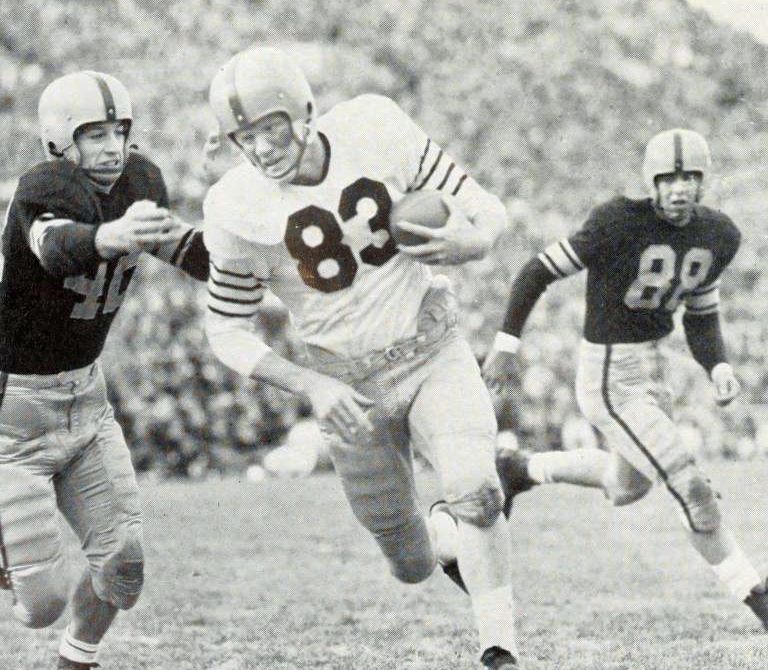
John "Rocky" Ryan
July 5, 2024
John “Rocky” Ryan, one of Fighting Illini football’s most colorful players on Coach Ray Eliot’s early 1950s teams, was born 92 years ago today.
A 1950 graduate of Tolono’s Unity High School, the Rocket football teams on which Ryan played never lost a game. He also lettered in basketball and won the state of Illinois’s pole vault championship his junior year.
At 6-2 and 190 pounds, Ryan became a record-setting receiver for the Illini. As a sophomore in 1951 for the Big Ten champs, one of his two receptions that season was a six-yard touchdown catch to close out UI’s 40-7 Rose Bowl victory over Stanford.
Statistically, Ryan’s best season at Illinois came in 1952. He caught a school-record 45 passes for 714 yards and five touchdowns, including a 78-yard TD against Washington on Oct. 11, 1952. The performance earned Ryan second-team All-Big Ten honors and honorable mention All-America laurels.
Ryan was involved in an incident following Illinois’s Nov. 8, 1952 game at Iowa. Immediately following the conclusion of the Illini’s 33-13 victory, Hawkeye fans began to throw apples at UI’s player as they were leaving the field. One unfortunate Iowa supporter’s jaw was broken by a powerful Ryan punch following the fan’s advancement on the Illini player. The episode played a role in the two schools not playing a football game against each other for 15 years.
As a senior in 1953, the big redhead helped lead Illinois to a share of the Big Ten title with 16 receptions for 308 yards and four TDs. Ryan ended his career as the Illini record holder for catches (63), receiving yards (1,041) and receiving touchdowns (9).
He was a second-round pick by the Philadelphia Eagles in the 1954 National Football League Draft (21st overall pick), but his professional career was delayed by service in the United States Army.
Ryan played three NFL seasons, primarily with the Eagles, starting nine of the 28 games in which he played. Ryan’s final four pro games were as a member of the Chicago Bears. Altogether, he caught six passes for 188 yards and had two interceptions for 55 yards.
Upon retirement from football, Ryan worked in Champaign-Urbana for Illinois Bell, Prudential Insurance and JM Jones/SuperValu. He and his wife, Lucille, had four children and 10 grandchildren. Many members of the family still reside in the Twin Cities.
Rocky Ryan died on Nov. 3, 2011, at the age of 79.
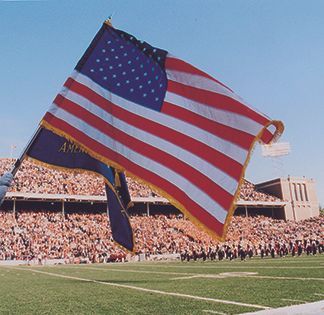
"Fourth of July" Illini
July 3, 2024
Happy 248th birthday to America on Thursday. On this patriotic day, we salute the “Fourth of July” Fighting Illini. Selected as the honorary captain of this patriotic unit is basketball legend Marcus Liberty.
ESPN’s Chris Berman didn’t help us with our research but here are our other “Independence Day” honorees:
Johnny “Red, White & Blue” Kerr, basketball, 1952-54
Harry “Thomas” Jefferson, football, 1954-56
Gimel President, football, 2016
Kameno “Liberty” Bell, football, 1989-91
Wayne “Let Freedom” Ring, golf, 1945-47
Jenna “Independence” Hall, softball, 2003-06
Casey “George” Washington, football, 2019-21
Richard “Benjamin” Franklin, fencing, 1976-77
Betsy “Ross” Nagel, swimming, 1997-2000
Chesley Freeland, track, 1909
“Uncle Sam” Rebecca, football, 1950-51
Don Freeman, basketball, 1964-66
Susan Land (of the Free), tennis, 1994-97
Alexander “Hamilton” Palczewski, football, 2018-21
Jason Bill (of Rights), track, 2003-06
Jolette Law, basketball coach, 2007-12
Kenneth “Patriotic” Song, fencing, 1986-89
Miller Pflager, soccer, 1933-34
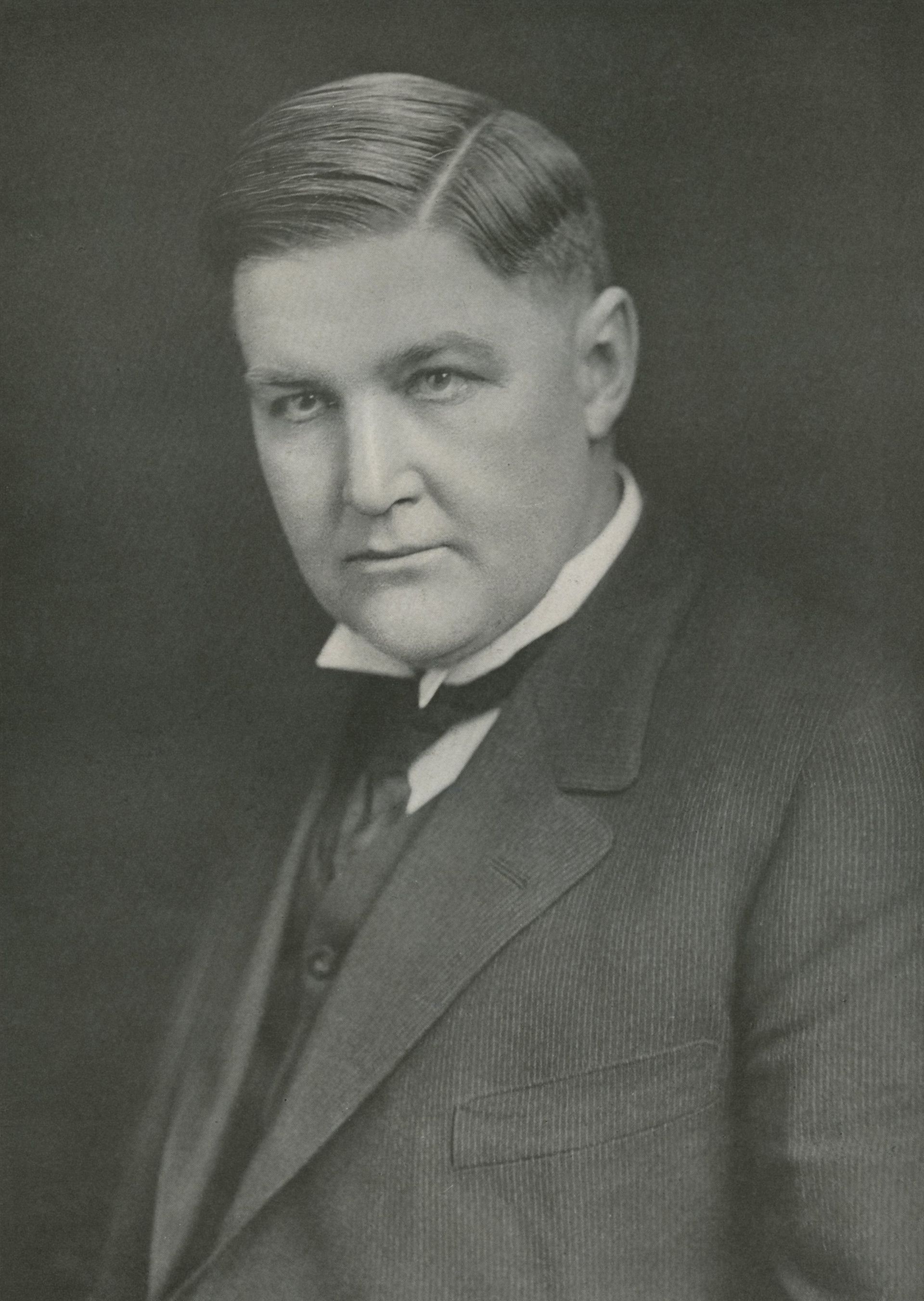
George Huff & The Anti-Betting Campaign
July 1, 2024
On May 14, 2018, the United States Supreme Court nullified a 1992 federal law that barred individual states for deciding for themselves whether to allow wagering on athletic events. If the old idiom was accurate, it was a day the University of Illinois’s “Father of Athletics” George Huff rolled over in his grave.
L. M. “Mike” Tobin, UI’s publicity director during Huff’s reign as athletics director, chronicled his boss’s efforts in a series of notes he wrote to preserve Illini history.
Just a month after the infamous “Black Sox Scandal” at the 1919 World Series, Huff personally witnessed the wagering frenzy when the Fighting Illini football team traveled to Columbus for its November 22 date against Ohio State. The lobby of Illinois’s own hotel was converted into a betting ring on the game, a contest won by the Illini, 9-7. Huff’s experience in Ohio ultimately was transformed into his own personal campaign against sports wagering.
“When gambling or betting is allowed to take hold of a sport, crookedness of some sort is bound to arise,” said Huff. “Betting on the success of the Orange and Blue defenders should never be tolerated. Leaders of college athletics here should do their utmost to prevent such a practice creeping into our university. I have always been opposed to student gambling and wish to see it entirely banished, for it is a practice out of keeping with the high ideals and standards of students at Illinois.”
UI’s student newspaper, the Daily Illini, joined forces with Huff and began an anti-betting editorial campaign during the fall of 1920.
“The game of football has not been reduced to the level of baseball’s present status,” the DI wrote. “There is no denying, however, that gambling has hurt football, is hurting it on the Illinois campus today, and if unchecked can proceed to the sport’s ruin.”
Soon, Dean Charles Thompson of UI’s College of Commerce joined the effort, crystallizing sentiment against betting.
“Student opinion is the only thing that can save football,” Thompson said. “If the students would get together and ride the first professional gamblers out of town on a rail, they would soon be freed front the taint of gambling on football. The worst thing about it is the constant temptation the football players themselves be subjected to. Five thousand dollars would look very big to a player who was having a hard time making his way through school.”
Prior to Illinois football’s 1920 season finale in Champaign against Ohio State, Huff addressed the Champaign Rotary Club.
“We want no such disgraceful scenes as were enacted at last year’s game in Columbus,” Huff said. “I believe there is a strong sentiment among students against betting and the business men of Champaign and Urbana should also do their part. Beyond a doubt, we can deal a body blow to gambling on football games.”
The athletic department distributed a placard to help the crusade. It read as follows:
IN ORDER TO DO ITS PART TOWARD PROTECTING COLLEGE SPORT FROM HARMFUL INFLUENCE, THIS PLACE WILL REFUSE TO HOLD BETS OF UNIVERSITY OF ILLINOIS ATHLETIC CONTESTS!
Signs were displayed in every local hotel, billiard hall and other places that might have been asked to back either Illinois or the opposing team.
The University Pan-Hellenic Council joined the drive as well, publishing a resolution regarding gambling, which read: “Resolved that the fraternities of the University of Illinois stand opposed to gambling on all University athletic contests; that any organized house violating this rule be suspended from the council for a period of one year; and that copies of this resolution be sent to the inter-fraternity councils of the Big Ten Conference.”
At the season-ending football banquet on November 29, 1920, Huff thanked those who had helped in the campaign, saying, “The anti-betting campaign has produced remarkable results.”
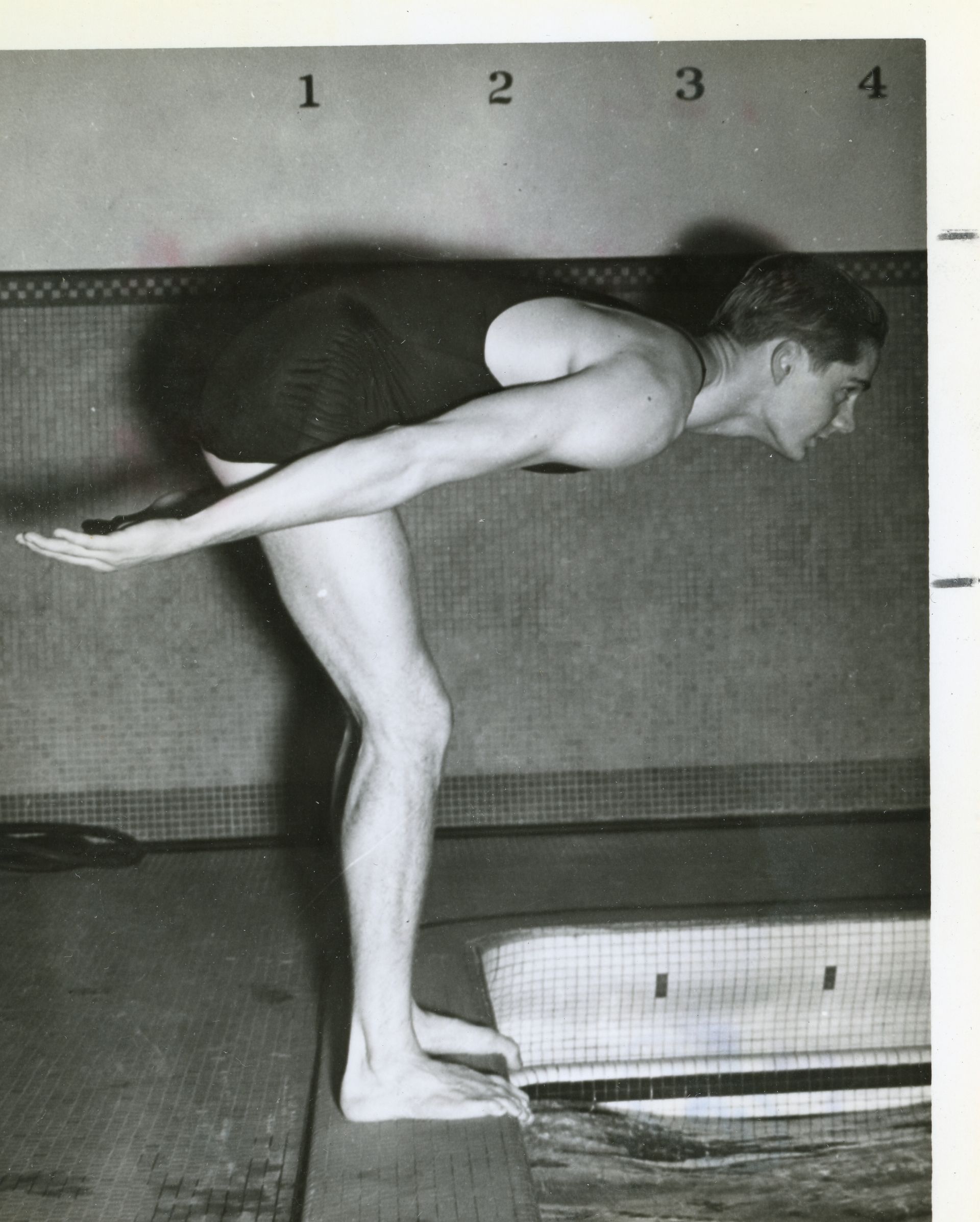
Charles Flachmann
June 21, 2024
One of the University of Illinois’ most brilliant athletes during the 1930s was swimmer Charles Flachmann.
Born June 21, 1913, in St. Louis, Mo., he starred for Coach Ed Manley’s Fighting Illini as a freestyle sprinter. Flachmann lettered in 1933, ’34 and ’35, winning NCAA 50-meter free titles as a junior (:23.8) and senior (:23.0). He also was the NCAA’s 100-meter champ in 1935 (:52.4).
Flachmann dominated the ‘35 Big Ten meet, leading the field in dash events and as anchorman on the record-setting 440 yard relay team. He was an art major at Illinois.
In 1944, during World War II, Flachmann served as a coordinator of swimming for the 7th Army Air Force in the Central Pacific. He taught water survival courses for nurses who evacuated wounded soldiers over frequent flights across the Pacific Ocean.
When Flachmann returned to civilian life, he worked as an insurance broker in St. Louis and also was an amateur artist. He died at the age of 69 in 1983.
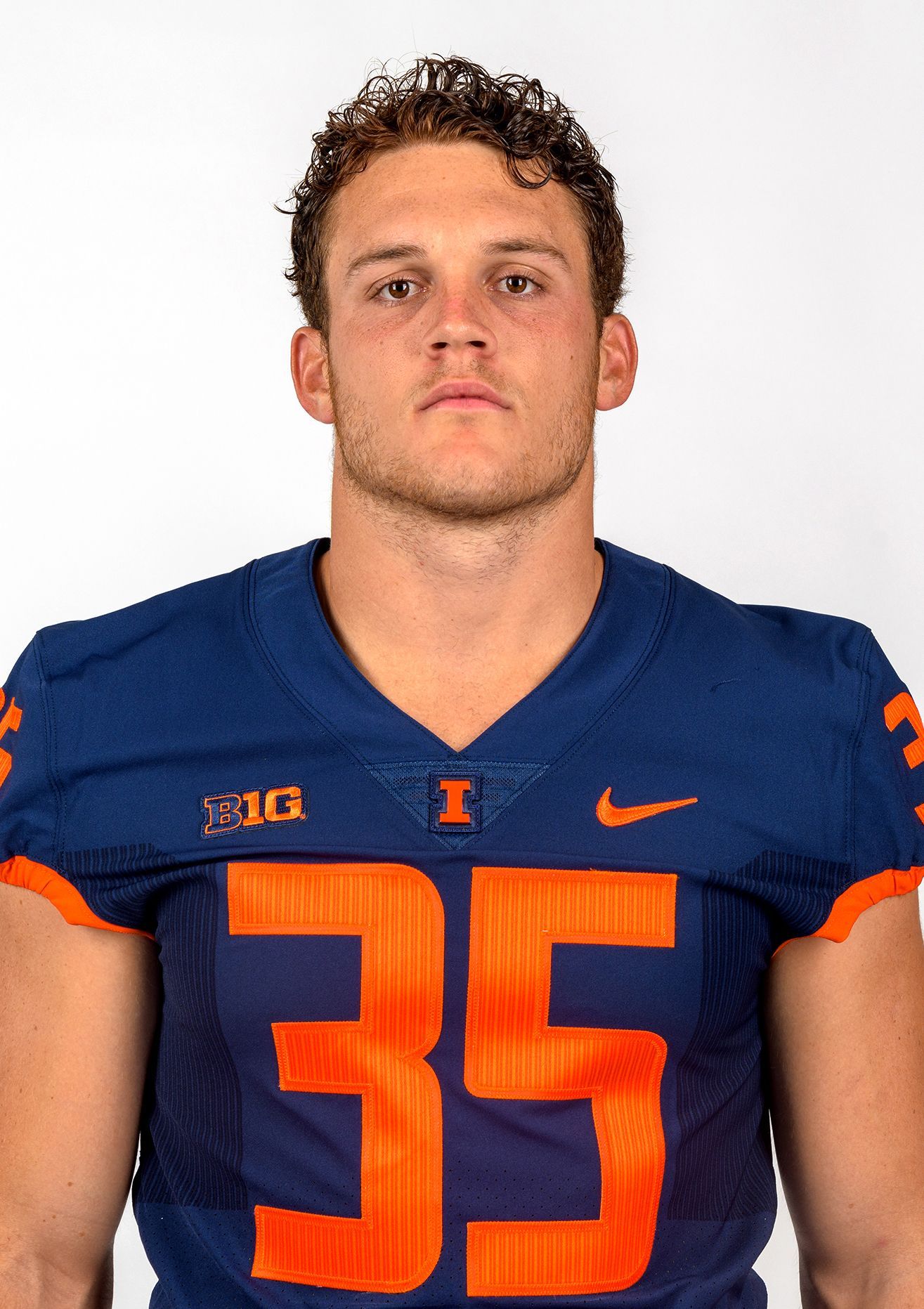
Jake Hansen
June 19, 2024
Had it not been for a torn ACL in game six of his senior season, former Fighting Illini linebacker Jake Hansen just might have concluded his collegiate career on top of Big Ten football’s list for forced fumbles.
The native of Tarpon Springs, Fla., who celebrates his 26th birthday today, was on a pace to not only leave Illinois as the school’s all-time leader in that category, but he also was just three away from tying the all-time Big Ten record. With 12 forced fumbles to his credit, Hansen needed to jar only one more ball loose from an opponent’s grasp to tie Hall of Famer Simeon Rice for the all-time Illini mark.
However, an unfortunate physical setback in 2021 against Wisconsin wiped out all of those very realistic statistical objectives.
Among all-time Illini, Hansen was in celebrated defensive company, having notched one more forced takeaway than future NFL star Whitney Mercilus (11) and two more than former teammate Stanley Green (10).
Former Coach Bill Cubit’s staff first noticed Hansen’s potential at Florida’s East Lake High School, though Jake had already pledged his future to Iowa State. When a Cyclone coaching change took place and Lovie Smith assumed duties as the Illini head coach, the course began to shift for both Jake and his dad, former BYU star Shad Hansen.
“When you’re a defensive player—especially a linebacker—there’s no better person to play for than Lovie,” the elder Hansen remembered. “From Jake’s perspective, it was like hitting the lottery.”
Illinois’ No. 35 saw action in every game that freshman season (2016), but his spirit was deflated the following August when he suffered a season-ending knee injury in fall camp.
“I’m not a very patient person,” Hansen said, “so I had to wait for my time. It gave me a chance to see the game from a different perspective.”
Months and months of therapy got Hansen back on the field for the 2018 season opener against Kent State and he responded with an eye-popping effort, totaling a school-record-tying six tackles for loss among his 15 stops. At the season-ending banquet, Hansen was presented with the Bruce Capel Award for courage, dedication and accomplishment.
In 2019, Hansen earned All-Big Ten honorable mention from both the coaches and the media, despite missing the final four games with an injury. In the COVID season of 2020, he continued to elevate his play, leading the nation in forced fumbles (7) and graduating to second-team All-Big Ten. Figuring that his draft status was at its peak, Hansen announced plans to leave the college ranks and begin training for a spot in the NFL. A conversation with new Illini head coach Bret Bielema convinced to return to Illinois for a sixth season in 2022.
Unfortunately, in game six against Wisconsin, Hansen tore his ACL, prematurely ending his collegiate career. He continued his classwork and graduated in December of 2021 with a Master’s degree in Recreation, Sport, and Tourism.
In two seasons with the NFL's Houston Texans, Hansen has appeared in 25 games and compiled 37 tackles.
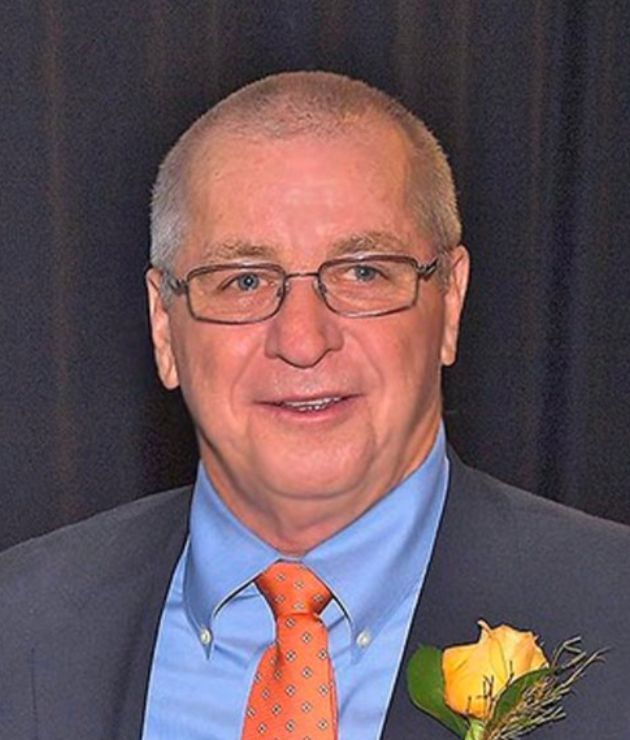
Andy Dixon
June 14, 2024
Thirty-nine years ago today - June 14, 1985 - Andy Dixon was promoted to head equipment manager at the University of Illinois, succeeding Marion Brownfield.
A former national speed skating champion, Dixon was an all-state football player at Champaign Central High School under Coach Tom Stewart. In Central’s 1970 victory over Danville Schlarman, Dixon rushed for 187 yards and three touchdowns.
He was recruited to Wyoming in 1972 by his first coach, Fritz Shurmur, and later played for Coach Fred Akers. Dixon was the Cowboys’ leading rusher in 1973, averaging 5.4 yards per attempt on 90 carries. He was the team’s top scorer in 1975, a season when he also co-captained Wyoming. After graduating from UW with a bachelor’s degree in education, the NFL’s Dallas Cowboys gave him a free agent tryout.
Dixon taught and coached for three years at Cheyenne Central High School in Wyoming and for one additional year in Las Vegas. Brownfield hired him as the Fighting Illini’s assistant equipment manager in 1981. Twenty one years later, in 2002, Dixon was honored as the Athletic Equipment Manager Association’s National Equipment Manager of the Year. He retired in 2010.
He and his wife, Cheryl, have two daughters, Whitney and Andrea, and are residents of Champaign.
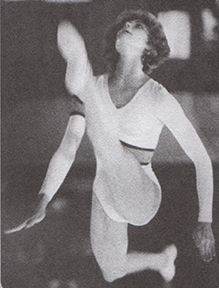
Karen Brems
June 12, 2024
In 1983-84, University of Illinois women’s gymnast Karen Brems became the first Fighting Illini athlete to be named as the school's Athlete of the Year and the Big Ten Conference Medal of Honor Award winner in the same season.
As a youngster in Urbana, she idolized gymnasts like Olga Korbut and Nadia Comaneci, dreaming of herself becoming an Olympic competitor one day.
Under the tutelage of Coach Bev Mackes at Illinois, Brems qualified for the NCAA Championships as a sophomore in 1982, but eventually realized that she would probably fall short of her aspirations to become an Olympian.
“I thought I was pretty much done in competitive sports,” she said.
Brems continued to be a fitness enthusiast, so she took up running and cycling, then competing in triathlons. Cycling turned out to be much kinder to her body and she quickly advanced from regional and national meets to the Tour de France and world championship competition. In 2000, Brems accomplished her Olympic dream, competing in the Sydney, Australia games.
At the 2016 USA Cycling Cyclocross National Championships in Asheville, N.C., Brems won the Master Women’s 50-54 title, riding for SunPower Racing.
Celebrating her birthday on June 13th, she now lives in Palo Alto, Calif., working for Hewlett Packard as a software engineer.
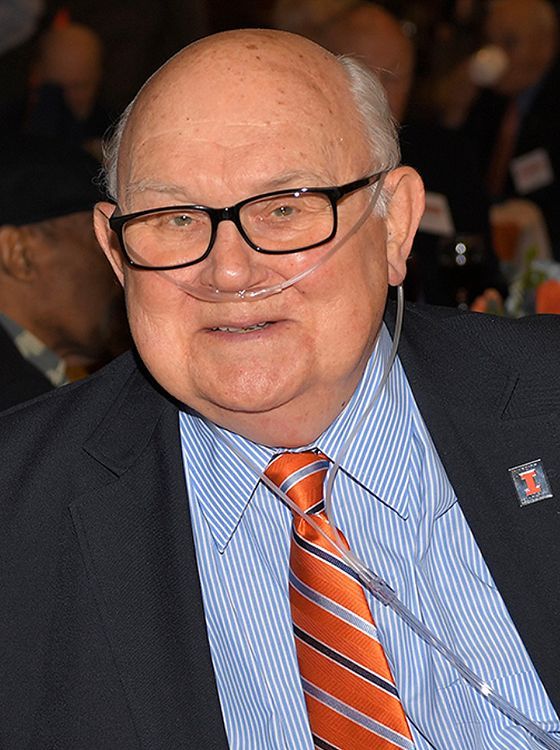
Charlie Finn
June 10, 2024
Champaign’s Charlie Finn was one of those individuals who easily qualified as an Illini “Super Fan”, but the man who would have celebrated his 91st birthday today always took his pride a couple of inches further than most.
A four-year manager for Coach Ray Eliot’s Illinois football teams and the squad’s senior manager in 1954, the Gibson City native directed a student staff of 18 individuals that served 140 players. They executed a wide variety of responsibilities, assisting the coaches and equipment staff with the organization of practices and games.
During Finn’s years at Illinois, the Illini won the Big Ten and national championships in 1951, registered a 40-7 victory over Stanford in the ’52 Rose Bowl, and claimed another conference title in ’53.
Following his graduation from Illinois in 1955 with a marketing degree and two years of active duty in the Army, he began a long career in the furniture business, including five years with his family’s company in Gibson City, then nearly 30 years with Kroehler Manufacturing in Naperville, on the West Coast, in Minneapolis, Dallas and Westerville, Ohio. When Kroehler went out of business, he became a partner in a company called Professional Furniture Marketing.
Finn was always a very active supporter of his alma mater, serving as a member of the Dean’s Business Council. He received the Alumni Association’s Loyalty Award in 2004. Finn was a season ticket holder for 35 years and was a member of the DIA’s Loyalty Circle for 10 years.
On August 23, 2013, his play “Red Grange: The Galloping Ghost Returns to the Virginia Theater” was presented in Champaign.
Finn and his wife of 64 years, Blanche, had two children and two grandchildren. Charlie died in December of 2018.
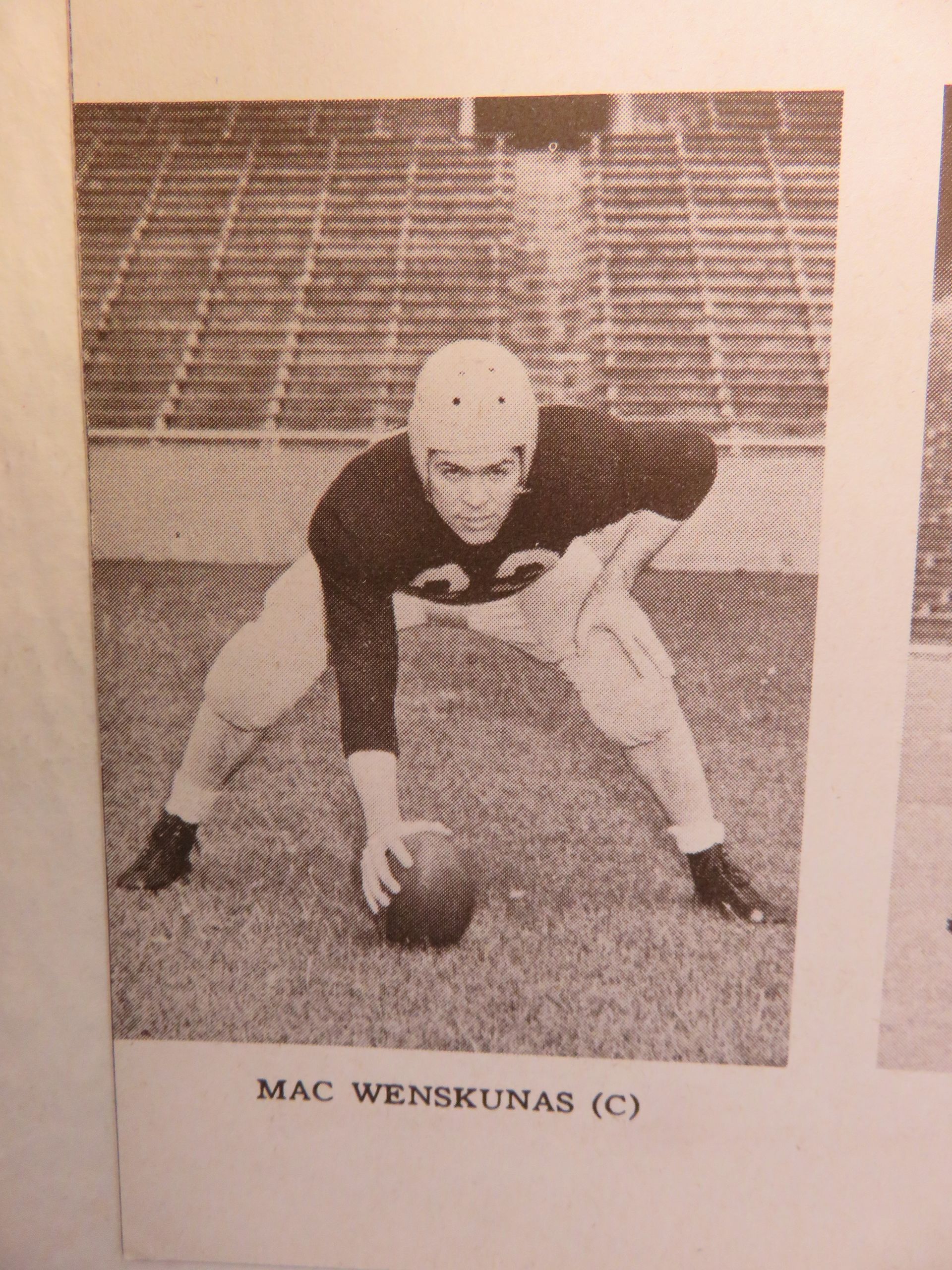
Mac Wenskunas
June 7, 2024
Some 67 years after his death in a tragic automobile accident, Georgetown, Illinois’ Michael “Mac” Wenskunas remains as his Vermilion County hometown’s most famous native son.
Born June 8, 1922, Wenskunas was a two-sport star at Georgetown High, winning all-state honors as a football halfback in his senior year (1939). He remained out of school until 1941 when he enrolled at the University of Illinois and joined Coach Bob Zuppke’s final Illini team.
Wenskunas played defensive center at just 181 pounds for rookie coach Ray Eliot’s 1942 squad, and was twice named “Big Ten Center of the Week.” He enlisted in the Marines following that sophomore season and was sent to the University of Notre Dame for training. He eventually was commissioned as a second lieutenant at Quantico, Va.
“Old 23”, as his teammates called him, Wenskunas returned to the U of I in time for the Illini’s 1945 season. He played virtually all 60 minutes in every one of Illinois’s nine games and was named UI’s Most Valuable Player.
As UI’s senior captain in 1946, Wenskunas helped the Illini win six of their seven Big Ten games and capture the Big Ten crown. Illinois went on to defeat UCLA in the Rose Bowl, 45-14, finishing fifth in the Associated Press’s final ranking. So popular was Wenskunas that Illinois’s Oct. 5, 1946 game at Memorial Stadium was “Mac Wenskunas Day.”
A 25-year-old Wenskunas became head football coach at Quincy College in 1947. His three Quincy teams went 4-3 (1947), 7-2 (1948) and 8-1 (1949). Wenskunas was inducted into Quincy’s Hall of Fame in 1974.
In 1950, Wenskunas became head coach at North Dakota State. He was relieved of his duties after four seasons, going 11-21-1.
He then became a salesman for the Josten Jewelry Company and lived with his wife and four children in Decatur.
On Aug. 3, 1957, Wenskunas, his wife, and three others were killed in a two-car collision near Boody, Ill. He’s buried at Calvary Catholic Cemetery in Decatur.
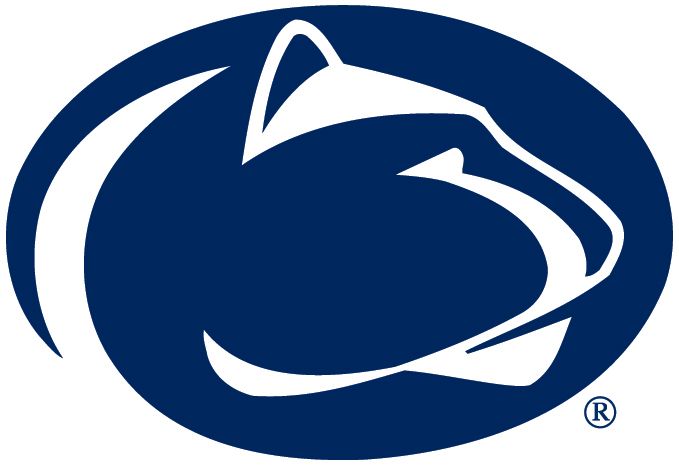
Penn State Joins the Big Ten
June 5, 2024
On this date 34 years ago—June 5, 1990—it was announced that Pennsylvania State University had joined the Big Ten Conference.
Just four months into his first term of commissioner of the conference, Jim Delany first seriously entertained the suggestion brought to him by then University of Illinois President Stanley Ikenberry, a Penn State graduate. Delany’s sister had attended Penn State as a graduate student, so he knew of PSU’s reputation as a strong academic institution and its rich history in athletics.
“The Big Ten hadn’t changed since Michigan State became a member in 1949,” said Delany, “but I thought the opportunity to expand towards the east coast was a no brainer.”
Following months of study and discussion, the process climaxed with a vote at a meeting in Iowa City. It was unanimous: Penn State was in.
“History has since proven that it was a tremendous fit for both sides,” said Delany.
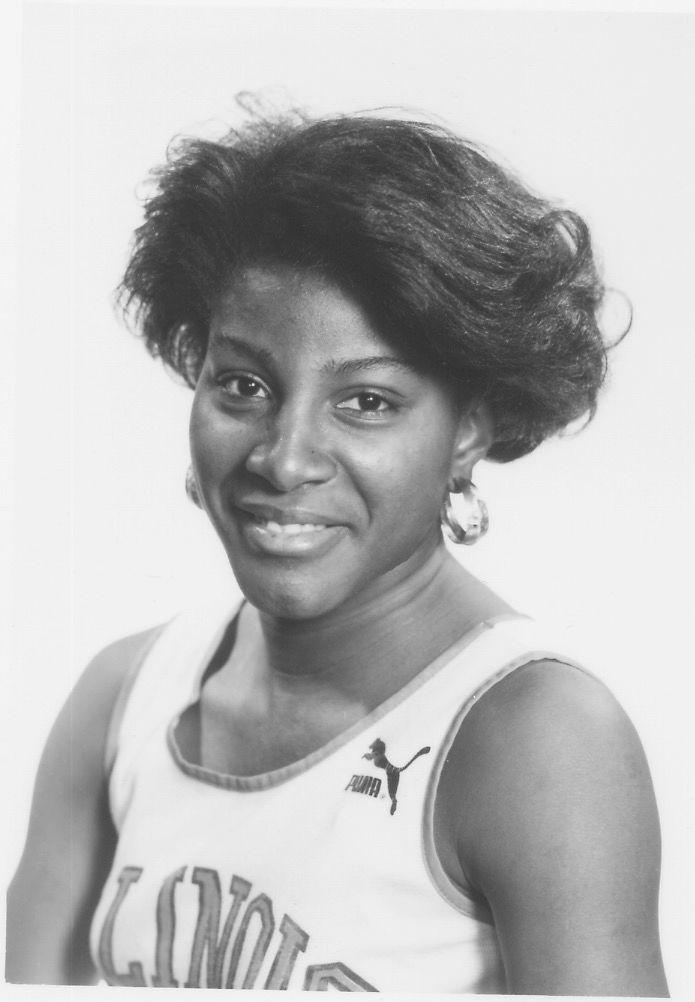
Renee Carr-Foster
June 4, 2024
Former Fighting Illini track and field standout Renee Carr-Foster, whose name is sprinkled throughout the University of Illinois record book, celebrates her birthday on June 4th.
A star sprinter at Science Park High School in Newark, N.J., Coach Gary Winckler helped her become a five-time All-American and a 14-time Big Ten champion. Carr-Foster, Celena Mondie-Milner and Leticia Beverly helped Winckler’s 1989 Illini capture Big Ten indoor and outdoor team championships. Carr-Foster also starred for Illinois’ 1988 conference champs.
She left Illinois as the school record-holder in the 400-meter dash (53.88 in 1990) and was a member of the top 4z100 and 4x400 relay squads.
Now married and living in Piscataway, N.J., Carr-Foster’s daughter, Janee, ran track at Montclair State.
Renee Carr-Foster’s Big Ten titles:
1986 (outdoors) … 4x100m relay
1987 (indoors) … 4x400m relay
1987 (outdoors) … 4x100m relay and 4x400m
1989 (indoors) … 400m dash and 4x440y relay
1989 (outdoors) … 400m dash, 4x100m relay and 4x400m relay
1990 (indoors) … 400m dash and 4x400m relay
1990 (outdoors) … 400m dash, 4x100m relay and 4x400m relay
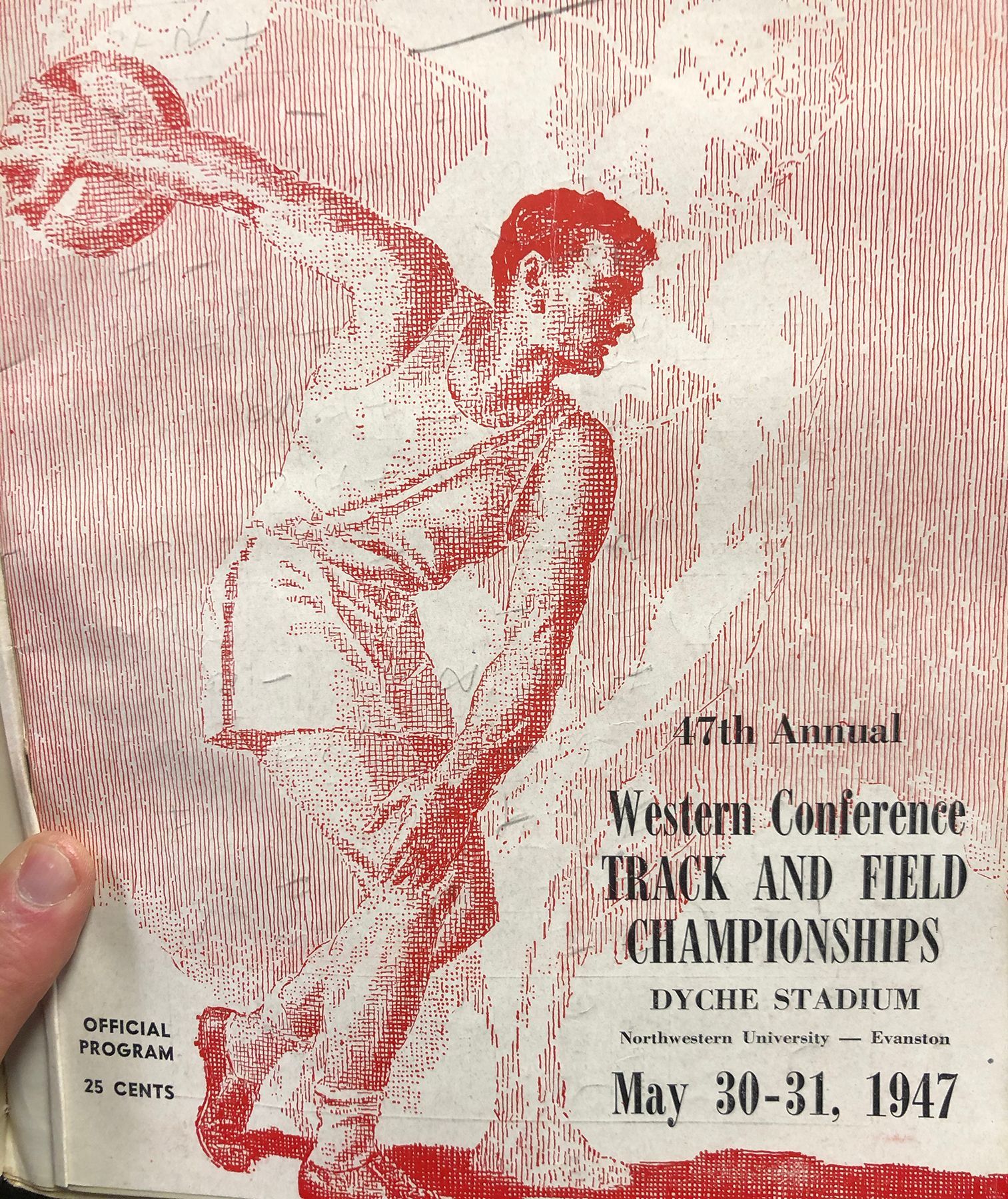
1947 Big Ten Track & Field
May 31, 2024
Seventy-seven years ago today—May 31, 1947—Fighting Illini teams capped a fabulous athletics season with a historic 39-point victory at the Big Ten Championships by Coach Leo Johnson’s track and field squad.
In capturing its third consecutive outdoor title, Illinois athletes claimed six individual titles and tied for a seventh. The Illini rolled up 69 ½ points, more than doubling the total of runner-up Wisconsin’s 30 ½ points. The only more significant margin in Big Ten track history was recorded 41 years earlier in 1906 when Michigan out-distanced Chicago by 42 points.
Performing in front of a crowd of 10,000 spectators at Northwestern’s Dyche Stadium, the Illini’s most disappointing moment came in the first event—the mile run—when Wisconsin’s 18-year-old freshman Don Gehrmann dethroned UI’s 1946 champ Bob Rehberg, the second-place finisher.
The second race—the 440-yard dash—was won by Illini senior Herb McKenley who circled the track in a time of :47.4. Moments later, McKenley placed fifth in the 100 dash, but teammate Bill Mathis more than made up for his teammate’s disappointing finish with a winning time of :09.8.
McKenley bounced back with a victory in the 220-dash (:21.5), while teammate Bill Cook placed fourth in the race.
In high jump competition, Illinois’s Dwight “Dike” Eddleman cleared the bar at 6’5 ¾”, an inch higher than Wisconsin’s Gil Hertz and Tom DeYoung. UI’s Harry Anderson achieved his best outdoor jump in two years (6’3 ¾”), tying for fourth place.
The two-mile run saw Illini senior John Twomey beat Indiana’s Don Snyder, finishing in a time of 9:33.5.
Champaign native and future Illini Hall of Famer Bob Richards tied for the pole vault title with Northwestern’s Billy Moore and Wisconsin’s Tom Bennett with a jump of 13’8”.
The day’s best race was in the mile relay, the meet’s final event. Charles Beile opened for Illinois and gave UI second-leg McKenley the baton in fifth place. The Jamaican regained lost ground and handed the stick to LeRoy Vranek for the third lap. Rehberg, the Illini anchor, outraced Ohio State’s Ed Porter in the final 440 yards, nipping his Buckeye rival by a yard at the tape to win the title.
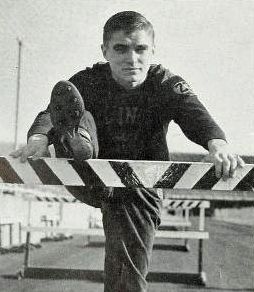
1954 Big Ten Track & Field
May 29, 2024
Seventy years ago today - May 29, 1954 - Illinois’ Willard "Will" Thomson and Willie Williams each won two events and led Illinois to the Big Ten Track and Field Championship at Purdue University. The Illini out-distanced second-place Michigan, 57 to 40 1/7.
Thomson captured titles in the 120 high hurdles (:14.4) and the 220 low hurdles (:24.1) while Williams was victorious in both the 100 dash (:09.8) and the 220 dash (:21.9).
As one of Galva, Illinois’ most accomplished athletes, Thomson eventually became a national champion for Illinois in the 120 hurdles and won a total of six Big Ten hurdles championships under the tutelage of Coach Leo Johnson.
Soon after Thomson’s graduation from the U of I, he began his career with General Motors in Dayton, Ohio. However, in 1957, Thomson returned to his hometown to work in his grandfather’s company, Dixline Corporation. Eventually, Will replaced his father, Willard, and spent 45 years as president and chairman of the company, one of the city’s oldest businesses.
In 2010, Will Thomson was named as Galva’s Citizen of the Year by the Galva Chamber of Commerce.

Cam McDonald
May 27, 2024
Cam McDonald, one of only three five-time varsity letter winners in Fighting Illini baseball history, marks his 24th birthday today.
The multi-positional standout from Ladd, Ill. and graduate of Spring Valley Hall High School will be best remembered for his iron-man durability, starting 219 of the 220 Illini games in which he appeared. The only game McDonald didn’t start came on Feb. 21, 2020 against Western Carolina when he entered the lineup as a pinch hitter.
His Illinois career also was highlighted by setting a new program record for reaching base safely in 63 consecutive games (May 8, 2021 through May 27, 2022). During that amazing span, he hit .345 and earned 71 bases on balls.
McDonald broke into the collegiate ranks with a bang in 2019, starting all 57 Illini as a freshman. A .281 batting average and a team-high 34 RBI landed him a spot on the All-Big Ten rookie team.
After slumping during the COVID-shortened 2020 season, he raised his batting average 100 points (.249) in 2021, starting all 44 games and playing flawlessly in the outfield on 96 chances.
McDonald’s junior year performance in 2022 was spectacular, hitting .363 with seven home runs and 59 runs batted in through 53 starts. His average over Illinois’ last 24 games that season was .444, earning him second-team All-Big Ten honors.
In the recently concluded 2023 campaign, McDonald collected at least one hit in 41 of UI’s 53 games, batting .286. He wound up with a .289 career average.
McDonald’s name will be sprinkled amongst the top performers in multiple Illini career categories, including hits (eighth with 254) and RBI (ninth with 162). His 44 career doubles and 364 total bases finished just shy of making those top ten registers.
Academically, McDonald received his bachelor’s degree a year ago in Recreation, Sport and Tourism. In 2023, he received his graduate certificate in Strategic Leadership and Management.
Illini Career Hits Leaders
1. 297, Tim Richardson (1980-83)
2. 289, Craig Marquie (1997-2000)
3. 286, Andy Schutzenhofer (2000-03)
4. 268, Dave Payton (1984-87)
5. 263, Dusty Rhodes (1995-98)
6. 257, Todd McClure (1996-99)
7. 256, Brian McClure (1993-96)
8. 254, Cam McDonald (2019-23)
9. 250, Ryan Hastings (2004-08)
10. 247, Branden Comia (2019-23)
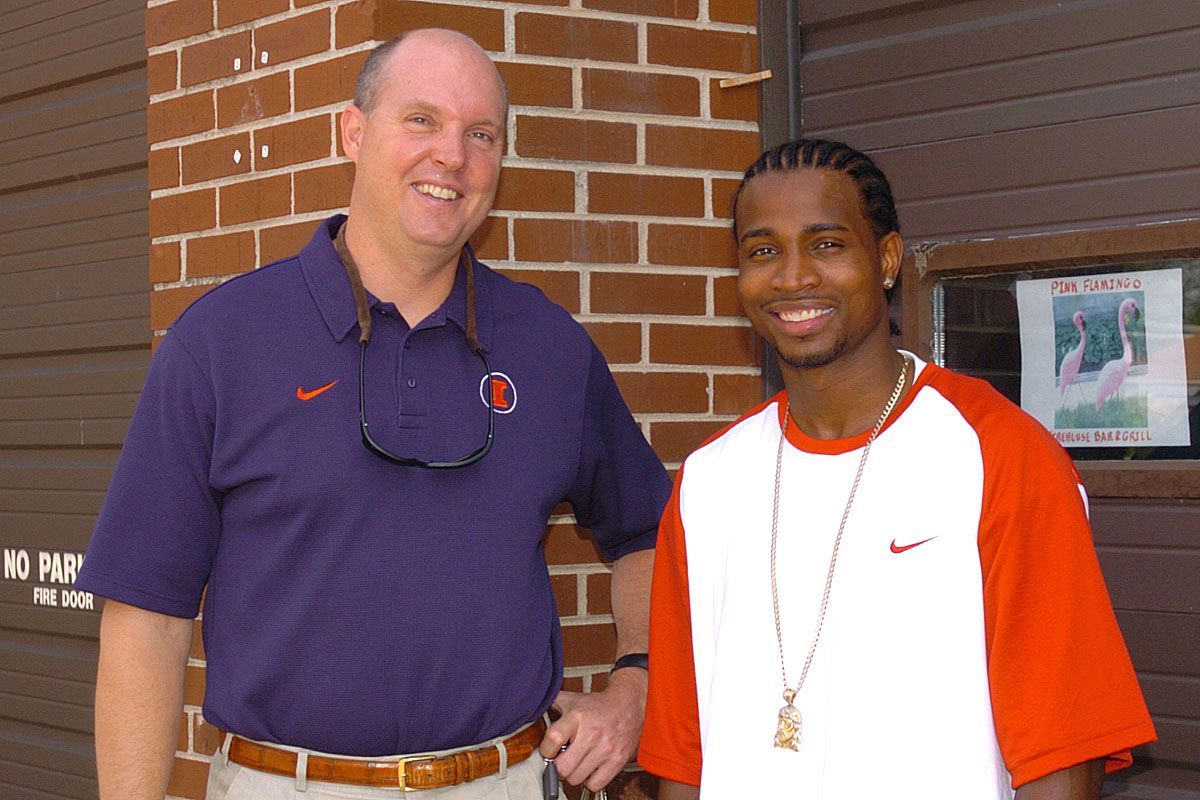
Kent Brown
May 24, 2024
Happy 61st Birthday to Kent Brown, University of Illinois' former Associate Athletics Director for Communications. The 1981 graduate of Atwood-Hammond High School earned both his bachelor’s (journalism) and master’s degrees (sports management) from Illinois and became assistant director of sports information for the Illini in 1989. In 1996, Brown was named sports information director at Kansas State, working with Coach Bill Snyder’s nationally ranked football team. At KSU, his efforts helped quarterback Michael Bishop finish second in the 1998 Heisman Trophy balloting. Brown returned to Champaign-Urbana in 2000 to head up Illinois’ communications office. Among the athletes he helped promote include Dee Brown, Frank Williams, Deron Williams and Brian Cook.
Kent Brown’s Top 10 Illini Media Personalities:
1. Bill Self – “Never witnessed anyone who handles media like him.”
2. Nathan Scheelhaase – “Was team spokesman for four years, through thick and thin.”
3. Dee Brown – “Loved the attention and had more fun with the media experience than anyone I’ve been around.”
4. Brit Miller – “Folksy, home-spun charm with everyone he spoke to. Watch ‘The Journey’.”
5. Simeon Rice – “We think he made up words whenever doing interviews.”
6. J Leman – “He’s honest and has a big personality.”
7. John Groce – “Very close to Bill Self in terms of a coach knowing how to play the media game.”
8. Lucas Johnson – “Made life fun for everyone (except for Lute Olson), including media.”
9. James Augustine – “Not the biggest personality during his era, but his goofiness played great with the media.”
10. Kendall Gill – “Took media seriously, yet was friendly and accommodating.”
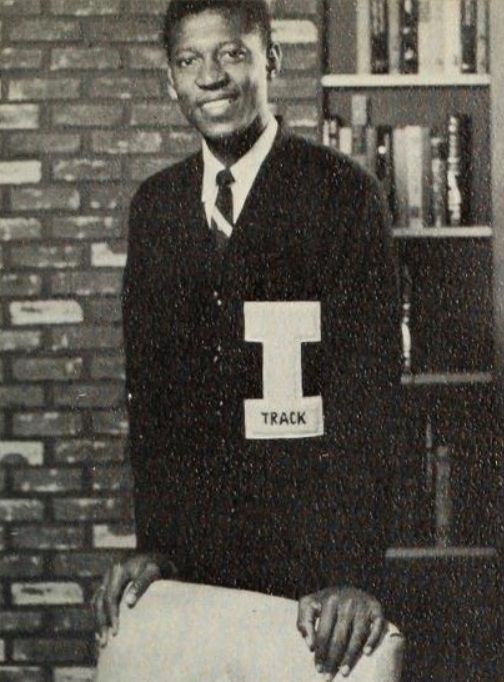
George Walker
May 22, 2024
On this date 76 years ago – May 22, 1948 – Fighting Illini speedster George Walker came within a whisker of a world record in one event and was victorious in two others as Illinois defeated Michigan State in a dual meet at Memorial Stadium.
The 5-foot-11, 165-pound senior from Chicago won the 100-yard dash (:09.7), the high hurdles (:14.3), and then the 220-yard low hurdles in an Illinois and Stadium record time of :22.6. Only the legendary Jesse Owens’ world record time of :22.5 was faster than Walker’s performance at that time.
Exactly one month later in Evanston, at a Big Ten-Pacific Coast Conference all-star track meet, Walker teamed with Indiana’s Tom Mitchell, Ohio State’s Dick Maxwell and Northwestern’s Bill Porter to set a new world mark in the 480-yard shuttle hurdle relay event (:56.8).
Walker, who competed for Coach Leo Johnson at Illinois from 1945-48, was an instant success for the Illini as a freshman. He won both the low and high hurdles at the 1945 Big Ten indoor meet, then the 100 dash and both hurdles events outdoors. At the NCAA meet that year, Walker captured individual titles in the 120 highs (:14.9) and the 220 lows (:24.0).
As a senior in 1948 at the NCAAs, he won the 400-meter intermediate hurdles event (:52.4) and placed sixth at 110 meters.
At the 1948 Olympic Trials at Northwestern’s Dyche Stadium, Walker barely missed qualifying for the Americans in the 400-meter hurdles.
He recorded a master’s degree from the UI in 1950, then was hired by St. Augustine’s College in Raleigh, N.C. At the historically black institution, Walker served as chairman of the department of health and education and as the head track coach and athletic director. During his 11 years at St. Augustine, Walker also coached boxing and wrestling and served as an assistant coach in football and basketball.
In 1966 when his father fell ill, Walker returned to his hometown of Robbins, Ill. to become assistant principal of the Posen-Robbins School District. He served in that capacity until the late 1980s.
Walker died in October of 2003 at the age of 77.
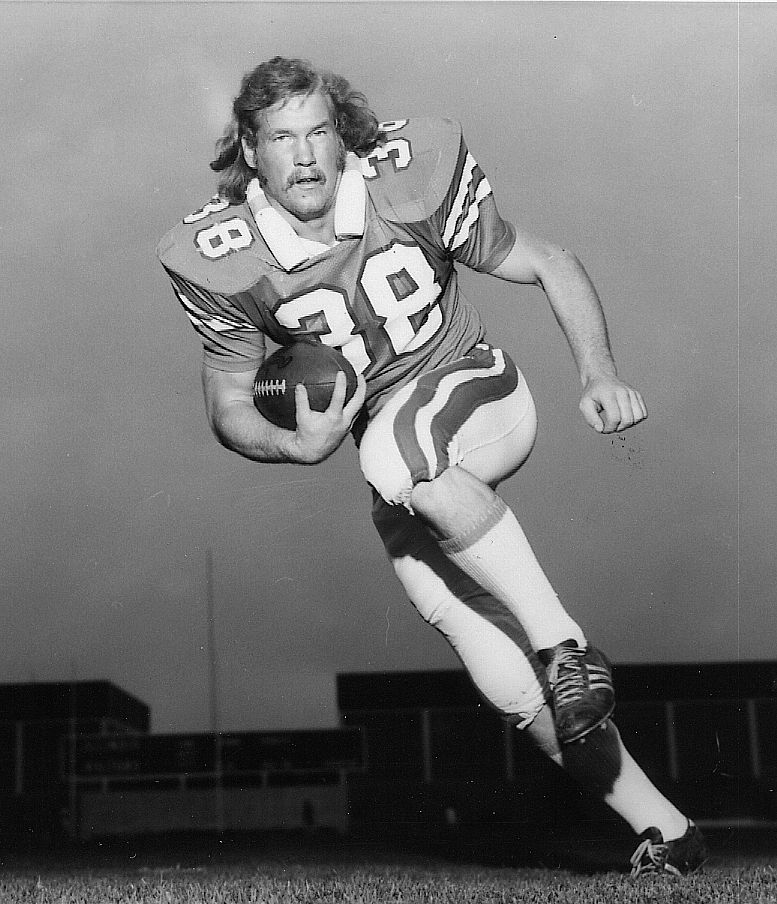
Steve Greene
May 17, 2024
Steve Greene, former University of Illinois football star and UI Director of Development, celebrates his 70th birthday today.
A four-year letter winner under head coach Bob Blackman from 1971-75, he wrapped up his career with 1,228 rushing yards, a total that ranked 12-best at the time his eligibility ended. Greene’s best single effort was a 121-yard game against Indiana.
The 1976 UI graduate serves more than 20 years with Illinois’ Office of Athletic Development. Greene’s first 13 years as a staff member were spent in Chicago where he managed the I Fund office. He also was Director of Development for the athletic department.
Today, the Mahomet resident is an independent management and fundraising consultant.
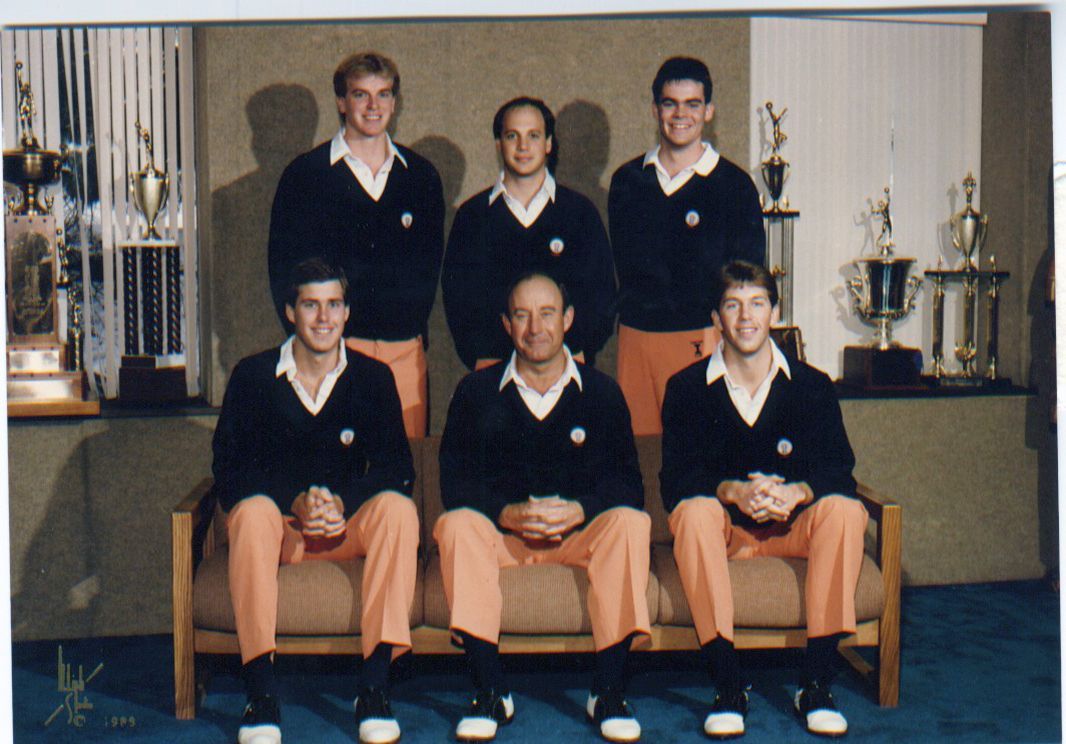
1988 Big Ten Golf Champs
May 15, 2024
On this day in University of Illinois men’s golf history - May 15, 1988 - Coach Ed Beard’s Fighting Illini breezed to the school’s first Big Ten team title in 47 years, outdistancing runner-up Ohio State by 20 strokes.
The victory at Savoy’s 6,596-yard Orange Course snapped a streak of six consecutive first-place finishes by Ohio State. Illinois’ team win capped a sensational improvement from last place just three seasons earlier in 1985.
The Illini quintet of seniors Mike Small and Don Edwards, junior Steve Stricker, and sophomores Kevin Fairfield and Heath Crawford overwhelmed a Buckeye squad that was led by Chris Smith and Anthony Adams.
Stricker’s four-round, nine-under-par total of 279 won medalist honors and included a round of 69 and three of 70 strokes. He was 14 shots better than Smith and teammate Small.
The final day of competition was made much more difficult by extremely windy conditions.
“I remember the wind blowing over tents,” Beard said. “Steve and Mike both played the last nine holes in a gale, but we were used to it.”
Small agreed with his coach, saying “I think the wind got to other teams and really messed them up.”
Illinois, which last won the Big Ten championship in 1940 and ’41, collected its seventh team title altogether.

Josh Klimek
May 13, 2024
Josh Klimek, whose name is most closely associated with home runs in the Fighting Illini baseball record book, set a Big Ten record in another category 28 years ago today.
In a May 20, 1996 game against Chicago State, Cougar pitchers wisely avoided the UI slugger by walking him an Illinois Field record four times. This, of course, occurred during a season in which Klimek would slam a record 26 home runs, seven more than the 19 that Forry Wells had hit in 1994 and the 19 that Scott Spiezio belted in 1992.
A multi-sport star at St. John Vianney High School in St. Louis, Klimek had baseball scholarship offers from Michigan State, Clemson and UCLA, and a combined baseball/soccer offer from St. Louis University.
During his big season in 1996, Klimek said he remembered no one particular home run above the other.
“What stood out to me were the hot streaks I got in,” he said. “ I think I had a stretch of six or seven games where I hit at least one. I was always more of a gap-to-gap hitter with some decent power, but never hit with this much power in one season.”
In eight minor league seasons, primarily spent with the Milwaukee Brewers organization, Klimek hit 80 home runs but, at age 28, decided to leave baseball before he was able to reach the majors.
“Once you start reaching that certain age and haven't made it yet, your chances diminish,” he said. “I could have continued to play but I had a semester at the U of I to complete in order to graduate. It was something I really wanted to do and it was going to be easier the younger I was.”
Klimek was able to complete his degree in sports marketing. He's worked at Midwest Bankcentre in St. Louis since 2003.
Klimek’s favorite home run hitters:
1. Darryl Strawberry – “He was my guy growing up. Smooth swing with power.”
2. Ken Griffey Jr. – “Sweet lefty swing.”
3. Albert Pujols – “Best all around hitter of my generation. Consistent.”
4. Mark McGwire – “Pure power, with or without help.”
5. Barry Bonds – “Great short swing.”
6. Stan Musial – “I admired the way he modestly played the game.”
7. Fred McGriff – “Nice lefty swing.”
8. David Ortiz – “His massive hack/swing and glowing personality.”
9. Chipper Jones – “Great switch hitter with power from both sides of the plate.”
10. Alex Rodriguez – “Great all around hitter.”
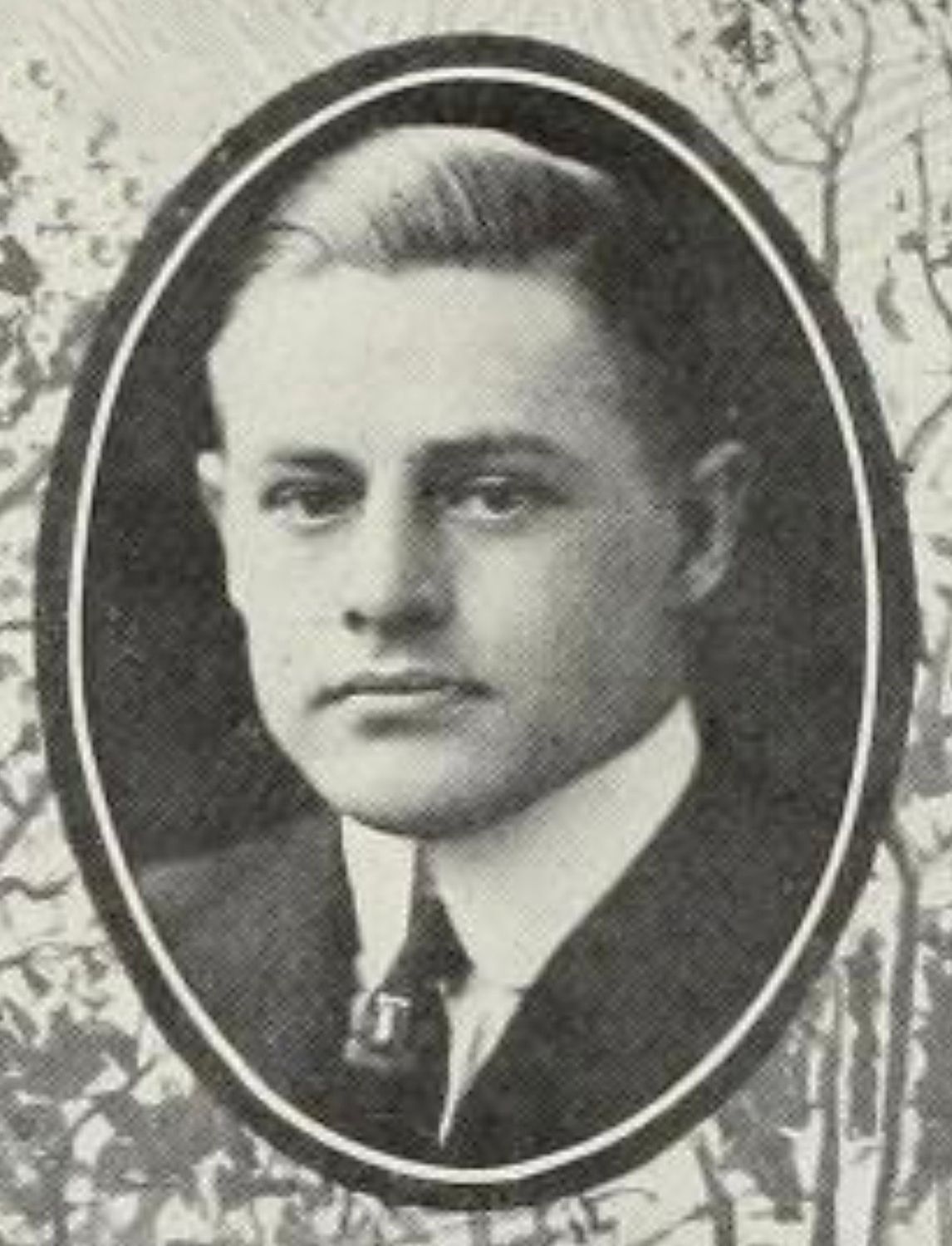
William Woolston
May 10, 2024
Sixty-seven years ago today—May 10, 1957—Dr. William H. Woolston died at the age of 67 in Albuquerque, N.M.
“Woolie”, as he was known by his University of Illinois football and basketball teammates, was a native of Geneva, born in January of 1890. He transferred to Illinois after a year of initially attending Cornell University.
On the gridiron, Woolston was a talented halfback and fullback for Coach Arthur Hall, and also was the team’s punter and placekicker. As a 20-year-old sophomore in 1910, he was an integral member of the undefeated, unscored-upon Big Ten champs. Woolston captained the 1912 Fighting Illini and received second-team all-conference honors that year.
In basketball, he lettered as an Illini guard for Coach T.E. Thompson in 1910-11 and ’11-12, captaining the latter squad.
After graduating from Illinois in 1913 with a degree in science, Woolston studied medicine at Northwestern University. He interned at Chicago’s St. Luke’s Hospital, then served at Cook County Hospital. In 1917, Woolston became a lieutenant for the U.S. Army Medical Service in France during World War I. He also was a professor at the University of Chicago’s School of Medicine.
While working in the Chicago hospitals, Woolston was exposed to and diagnosed with tuberculosis. He suffered a series of acute pulmonary hemorrhages and, in an attempt to improve his health, moved to Albuquerque, N.M. in 1922 to begin a distinguished surgical practice. Dr. Woolston, known as “Uncle Billy” to his colleagues at Presbyterian Hospital, practiced general surgery and gynecology. Later in life, he was President of the Southwestern Medical Association.
He had an unusual habit of whistling in the operating room so that he could obstruct his air column, inflating his lungs to absorb additional oxygen.
Woolston and his wife, Alice, were beloved residents of Albuquerque. Their son, Timothy, became a respected attorney in the community, serving in that capacity for 50 years.
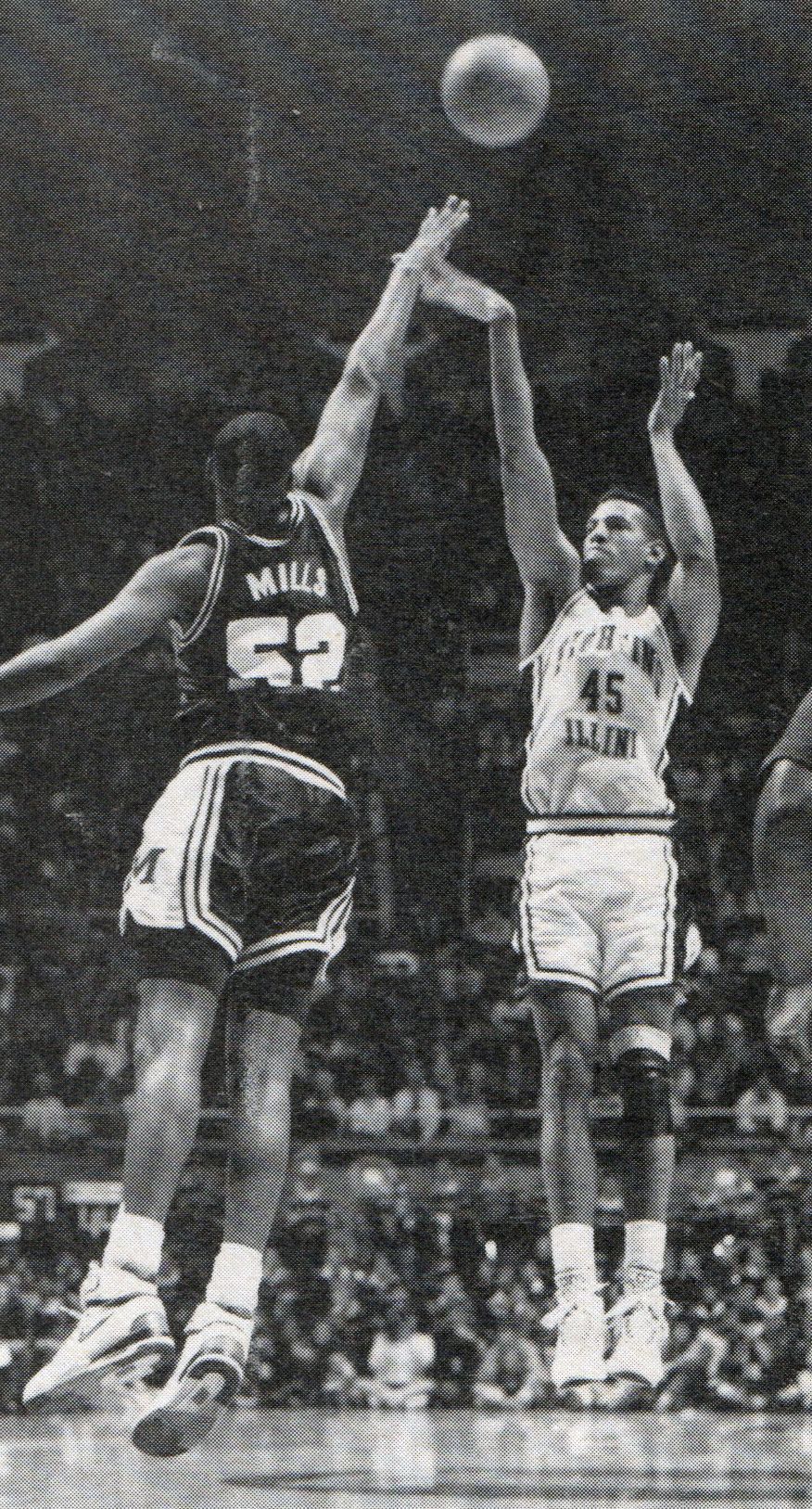
Lowell Hamilton: By the Numbers
May 3, 2024
Happy 58th Birthday to former Flying Illini starter Lowell Hamilton. From 1985-86 through 1988-89, his Illini basketball teams compiled an overall record of 99-33 and 50-22 in Big Ten contests. Hamilton’s ’88-89 Illini made it to the Final Four with a 31-5 record.
Ranked as the nation’s top high school player by Street & Smith Magazine, Hamilton struggled as an Illini freshman. Averaging just 3.7 points and 1.7 rebounds, he came off the bench in each of the 24 games in which he appeared in ’85-86.
Hamilton started 22 of Illinois’s 31 games as a sophomore, averaging 10.8 points and 3.9 rebounds.
As a junior, he split time with Jens Kujawa at center, starting only six of the 33 contests in which he played.
Hamilton enjoyed his greatest success as a senior, averaging 13.6 points, ranking behind Nick Anderson (18.0), Kenny Battle (16.6) and Kendall Gill (15.4). Co-captaining the Flying Illini with Battle, he scored at least 10 points in 27 of his team’s 36 games that year.
Today, he’s a physical education teacher and the junior varsity basketball coach at Tallulah Falls High School in northeast Georgia. Hamilton and his wife, Adrianna, have three children.
Lowell Hamilton’s career, by the numbers:
1 Number of three-pointers he scored at Illinois (of three career attempts).
8 Hamilton was one of eight children in his family.
9 Seasons he played professionally overseas (Turkey, Greece and Israel).
11.6 His points per game average in UI’s five 1989 NCAA Tournament games.
12 Top single-game rebounds performance (at Indiana, 3/4/89).
13.9 His scoring average as a senior at Illini home games.
20 Hamilton is one of only 20 Illini players who averaged at least 10 points per game during a four-year career.
24 His single-game high-point game (vs. LSU, vs. Georgia Tech and vs. Iowa, all during the 1988-89 season.
45 Jersey number at Illinois.
.534 His shooting percentage from the field as an Illini.
.694 Illinois basketball’s winning percentage in Big Ten games during his four seasons.
.892 Providence St. Mel High School’s winning percentage during Hamilton’s four years as a starter.
1,241 Total points he scored during his Illini career, 29th on UI’s list of top point producers.
1985 Year he was selected as the Chicago Sun Times Class A Player of the Year.
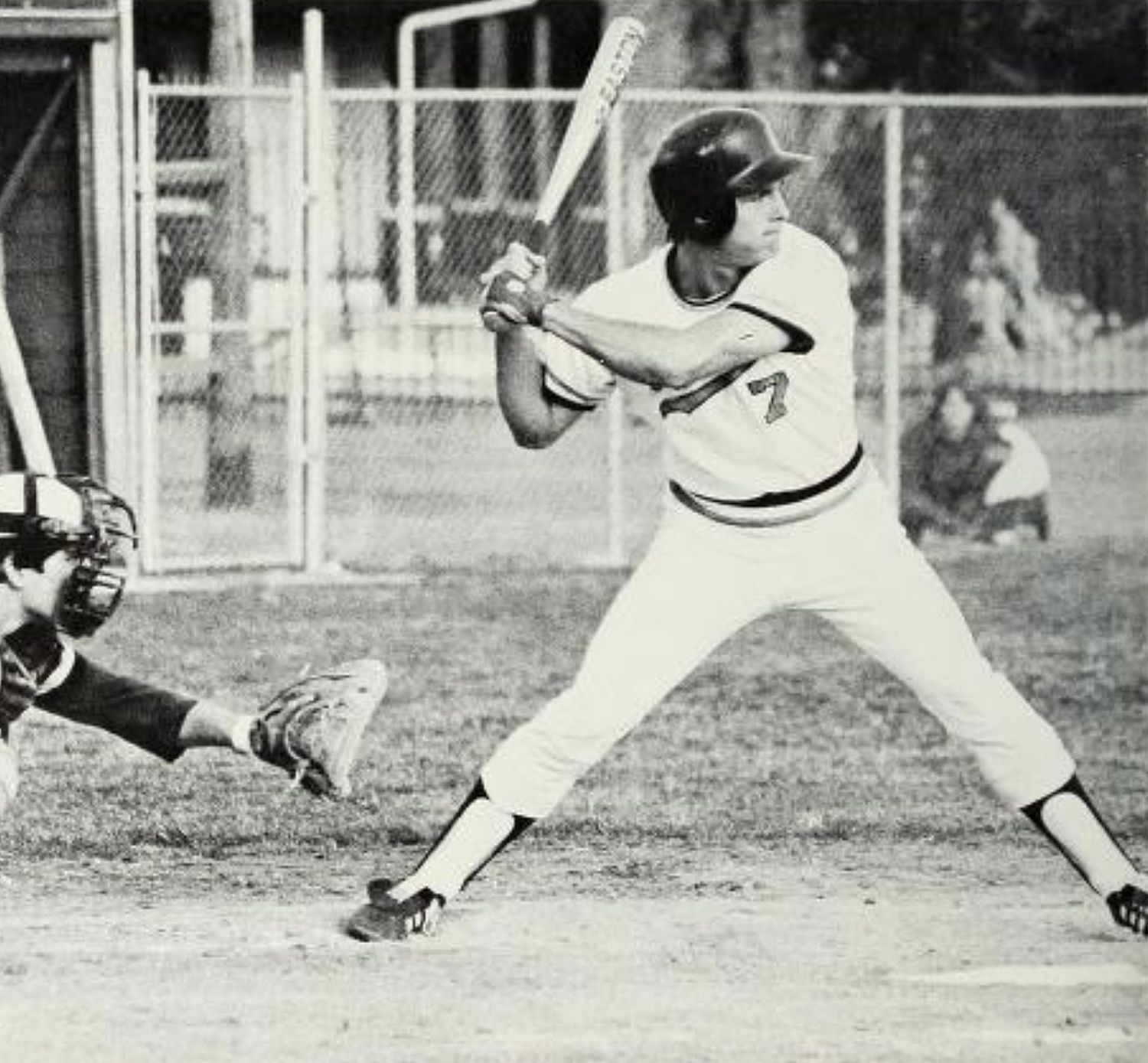
The 1981 Illini Baseball Team
May 1, 2024
Forty-three years ago this week—May 3, 1981—the Fighting Illini baseball team swept Northwestern in a Big Ten-ending series. The 4-1 and 6-0 victories gave Illinois a final conference record of 11-3, enough to send it into the first-ever Big Ten playoffs.
Todd Schmitke supported Randy Conte’s three-hit gem in the opener with a two-RBI single. In the second game, Dave Wuethrich hurled a complete-game shutout. The two wins lifted Illinois’ record to 34-23, breaking a single-season record of 32 set by UI’s 1928 team.
When Coach Tom Dedin made a preseason prediction that his ’81 Illini baseball team would win the Big Ten’s West Division, many followers arched their eyebrows and had a cynical snicker. And coming off an 18 and 33 record in 1980, who could blame them. Illinois’ 4-13 spring-training record, which included eight games against Oklahoma and Oklahoma State, made the skeptics’ doubt grow even more, but it didn’t dampen Dedin’s enthusiasm. Once the Illini began their home schedule, their confidence grew with each passing game.
Riding a talented group of hitters and a staff of adept pitchers, the Illini won 15 of its next 17 games. The top half of the lineup, including Tim Richardson (.372), Todd Schmitke (.362), Brian Bock (.347), Brian White (.312) and Dave Rear (.300), combined for 33 home runs and 178 RBI.
Once it got on base, the team stole a team-record 113 bases. UI’s pitching staff, including right-handers Dave Wuethrich (8-3), Dennis Johnson (5-1) and Randy Conte (8-5), were nearly unbeatable in Conference games and freshman Jeff Innis supplied terrific relief pitching.
The Illini finished 11-3 in the West, but stumbled in the Big Ten playoffs.
“This group has learned how to win,” said Dedin. “They gave us a hell of a year.”
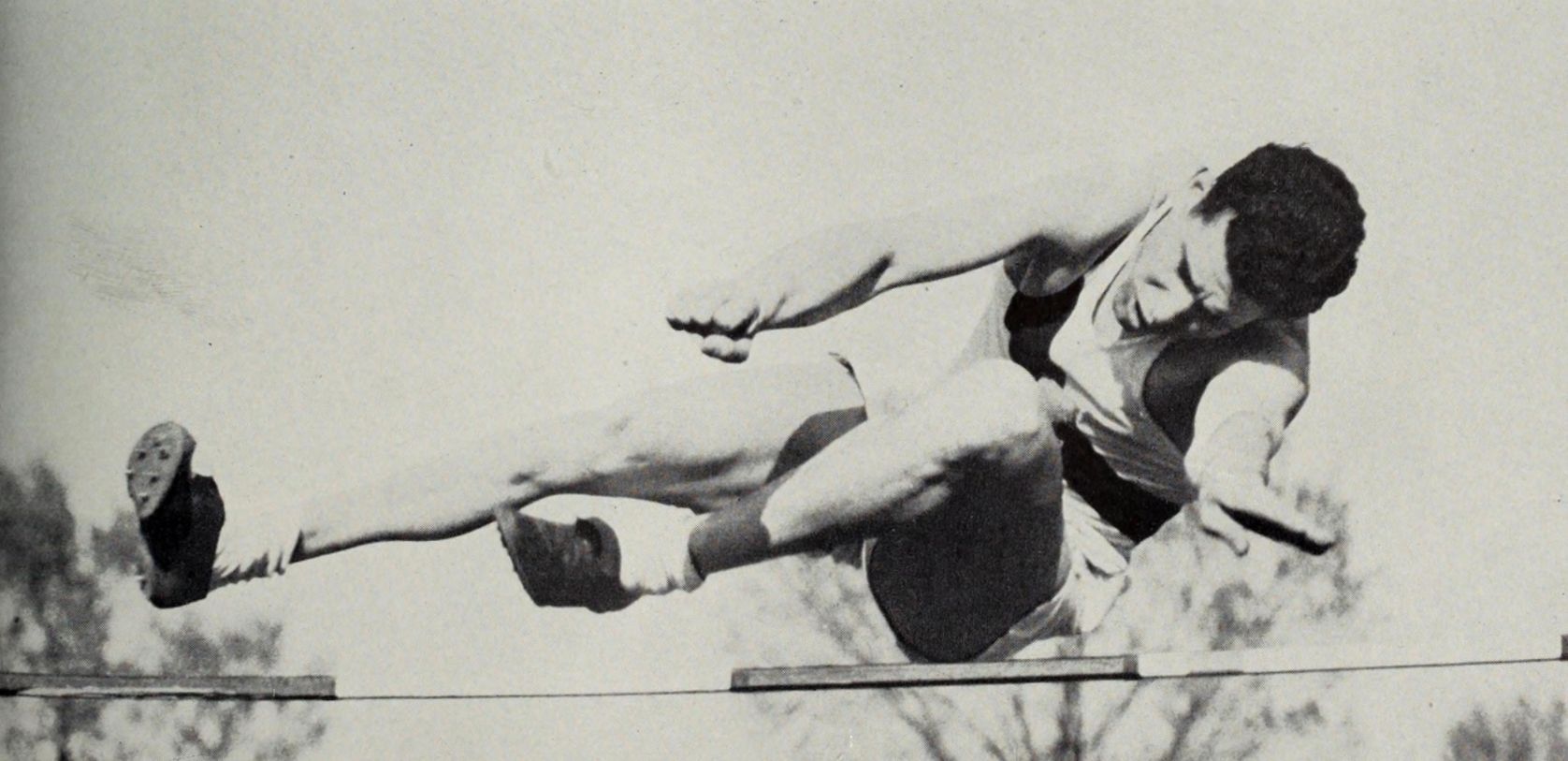
Illini & The Drake Relays Hall of Fame
Apr. 29, 2024
On this date 47 years ago—April 29, 1977—Fighting Illini track and field legends Harry Gill and Leo Johnson were among six charter class members inducted into the Drake Relays Coaches Hall of Fame. They joined Wisconsin’s Tom Jones, Texas’s Clyde Littlefield, Drake and Kansas’s Bill Easton, and Drake’s Major John Griffith. Griffith latter would later serve as the first Commissioner of the Big Ten Conference (1922-24).
Gill, a native of Orillia, Ontario, Canada, came to the University of Illinois from Beloit College. He guided Illini track and field fortunes from 1904-29, then again from 1931-33. In 1921 he organized the very first NCAA championship in any sport, and his Illini won the inaugural event in addition to a second title in 1927. Gill died in 1956 at the age of 80.
Johnson, Illinois’ head coach from 1938-65, was a football and track star at Decatur’s Millikin College, then returned to serve as head coach of all of Big Blue sports in 1923. He guided Fighting Illini teams to 17 Big Ten titles and three national championships. Johnson died in 1982 at the age of 88.
The complete list of eleven Illini coaches and athletes in the Drake Relays Hall of Fame (established in 1959):
1959 - Harold Osborn, High Jump and Decathlon
1959 - Dwight “Dike” Eddleman, High Jump
1963 - Lee Sentman, Illinois, Hurdles
1966 - George Kerr, Illinois, 880
1967 - Milton Angier, Illinois, Javelin
1977 - Harry Gill, Illinois, 1904-33
1977 - Leo Johnson, Illinois, 1938-65
1987 - Charlton Ehizuelen, Illinois, Long Jump/Triple Jump
1991 - Gary Wieneke, Illinois, 1975-2003
2010 - Perdita Felicien, Illinois, 100mH/Relays
2010 - Gary Winckler, Florida State/Illinois, 1982-2008
2019 - Celena Mondie-Milner, Illinois, Sprints/Relays
2019 - Mike Turk, Illinois, 2011-present
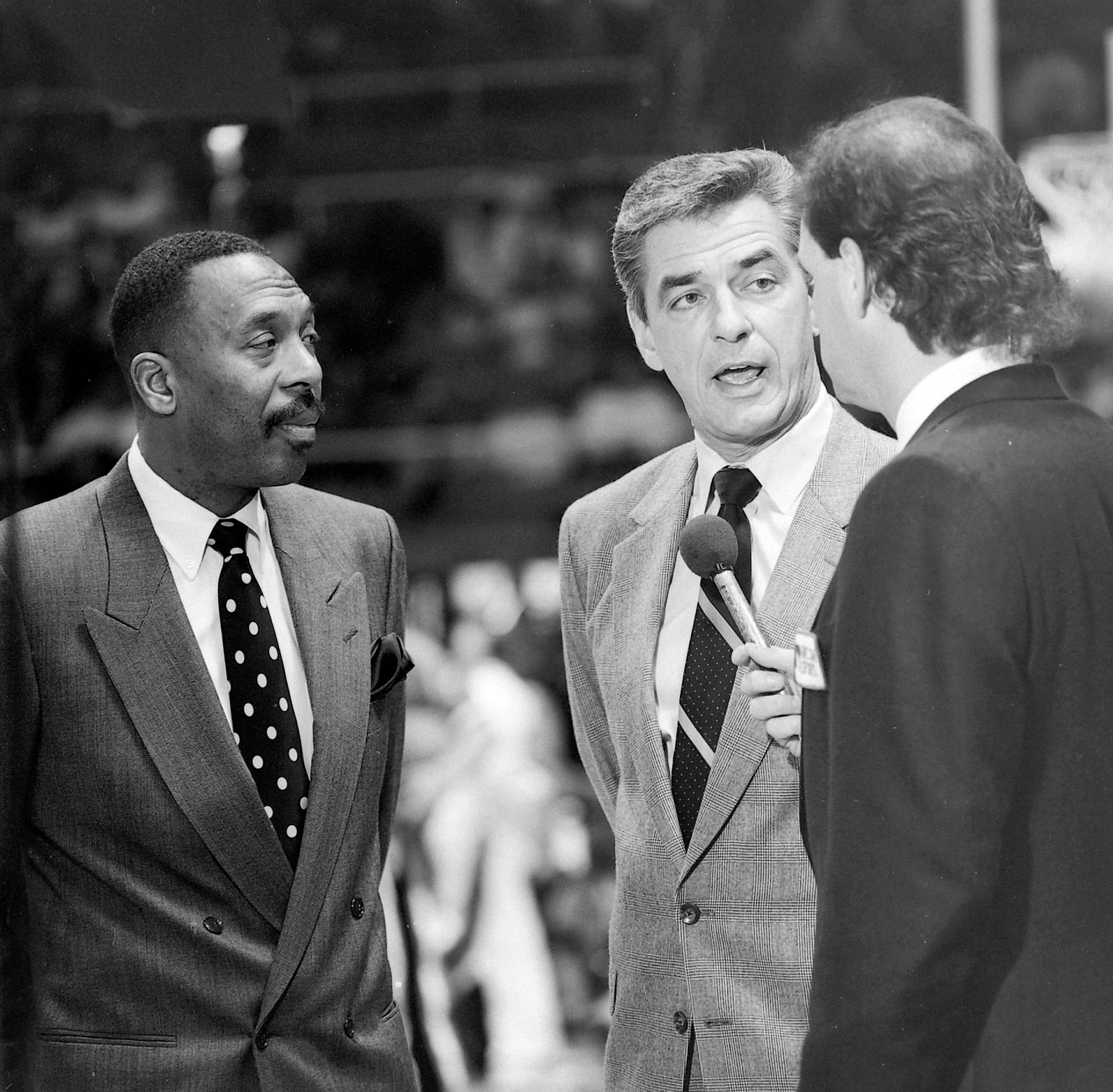
Jimmy Collins & Dick Nagy
Apr. 26, 2024
On the same month and day, but four years apart, two of Illinois basketball’s greatest assistant coaches were hired by Lou Henson.
On April 26, 1979, Dick Nagy joined Tony Yates as a Henson assistant, replacing Les Wothke who had left Illinois to become head coach Western Michigan. Nagy needed no introduction to Henson or his basketball philosophies. He had played for Henson at Hardin-Simmons and was the captain of Henson’s final squad in Abilene in 1996. At the time, Nagy was just three years out of high school ball in Syracuse, N.Y. From the 1979-80 season through the ’95-96 season, he helped Henson’s Illini post winning Big Ten records in 14 of those 17 campaigns. During that span, Illinois won one Big Ten title, placed second three times, and finish third four times. Nagy went on to serve as Jimmy Collins’ assistant at UI-Chicago for five additional seasons and helped the Flames achieve their first-ever NCAA Tournament appearance.
It was on April 26, 1983 that Collins was named to the Illini staff. Like Nagy, Collins also was a native of Syracuse and a former Henson pupil. Collins was a senior All-America guard at New Mexico State in 1970, the year NMSU made its only NCAA Final Four appearance. He then was drafted 11th overall in the 1970 NBA Draft and played two seasons. Collins joined Henson’s Aggie staff as a graduate assistant coach in ‘72, then moved to Chicago four years later. He was a probation officer in Chicago when Henson hired him to replace Tony Yates. In Collins’ very first season at Illinois—1983-84—Illinois tied for the Big Ten title. Though the Illini wouldn’t again reach that championship level over the next dozen seasons, UI placed second twice, third three times, and fourth four times. Collins became UIC’s head coach in 1996-97 and continued in that role for 13 more years. The Flames made three NCAA Tournament appearances and qualified for the NIT one other time.
Jimmy Collins and Dick Nagy’s Top Ten Memories of the 1988-89 Season
1. Mar. 26 vs. Syracuse: The Illini earned a spot in the Final Four.
2. Dec. 19 vs. Missouri: Kenny Battle scored 28 points as UI improved its record to 18-0. Illini overcame an 18-point deficit.
3. Mar. 4 at Indiana: Nick Anderson hit a miracle three-pointer at IU’s Assembly Hall.
4. Mar. 24 vs. Louisville: Illinois won its 30th game behind Anderson’s 24 points.
5. Jan. 22 vs. Georgia Tech: Illini earned No. 1 ranking with a two-overtime victory.
6. Dec. 22 at LSU: Illini crushed the Tigers by 27 points in Baton Rouge, scoring a school-record 127 points.
7. Mar. 11 at Michigan: UI won a school-record 27th game at Ann Arbor.
8. Feb. 9 vs. Ohio State: Stephen Bardo held Buckeye star Jay Burson to nine points.
9. Jan. 25 vs. Indiana: Illini snapped league-leading Indiana’s 13-game victory streak.
10. Mar. 8 vs. Iowa: Lowell Hamilton, Battle and Anderson played their final home game. Kendall Gill returned to the Illini line-up.

Ray Poat
Apr. 24, 2024
Eighty-seven years ago—Apr. 18, 1937—Illini right-hander Ray Poat, a sophomore from Chicago’s Lindblom High School permitted only 28 Ohio State Buckeyes to bat in a nine-inning, 10-strikeout, 3-1 Illinois victory. Three days later, he turned in another spectacular performance against the University of Chicago, striking out a dozen Maroon batters and allowing just two hits in a 7-0 Illini win.
In his only full season with Coach Wally Roettger’s Illini varsity squad, Poat posted a perfect 9-0 record, racking up 69 strikeouts against only 12 walks in nearly 76 innings on the mound. Though he may have taken a back seat to teammate and future Hall of Famer Lou Boudreau in the newspaper clippings, it was the six-foot-two-inch Poat who earned Big Ten Most Valuable Player honors for the conference champs.
Poat’s father—Joseph Vander Poaten—had emigrated from the The Netherlands shortly before Ray’s birth on Dec. 19, 1917. Upon his arrival at New York City’s Ellis Island, United States officials shortened the family name to Poat. The family eventually settled in Chicago’s Hyde Park neighborhood where Ray became an acclaimed hurler for the Lindblom Eagles. Once he got to the University of Illinois, he pledged to the Phi Kappa Psi fraternity and majored in chemical engineering.
In the early portion of his junior year (1939), Poat had season-ending surgery for a chipped bone in his right elbow, ultimately marking the end of his collegiate career. Shortly after the end of the season, he got married, hastening his urgency to sign a contract with the Cleveland Indians organization.
After posting a 15-4 record with Leaksville-Draper-Spray of the Class D Bi-State League, Poat was promoted to the Cedar Rapids Raiders. There he went 29-14 over the next two seasons, prompting his call up to the Indians in 1942, where former Illini teammate Boudreau would be his manager.
Poat made his Major League debut on Apr. 15, 1942 against the Detroit Tigers, but allowed four runs on eight hits in three innings. A week later, the Indians optioned him to Indianapolis of the American Association. At Indy, he compiled a 15-8 record and was recalled to the big club in September. Facing the White Sox on September 8 at Comiskey Park—a stadium located just a few blocks away from his childhood home—Poat got his first win, tossing a 10-0 shutout in front of friends and family.
He stayed with the Indians in 1943 and ’44 but went just 6-13. Poat took a leave of absence from baseball in 1945 to help support the World War II effort, working as a chemist in a Chicago-based government facility. He returned to pitch after the war, though at the minor league level. Two fairly successful seasons got Poat an invitation to join Manager Mel Ott’s New York Giants in August of ’47. He finished the year with a 4-3 record and a 2.86 ERA and the Giants doubled his salary to $12,000. Poat pitched another season and a half for New York before being traded to the Pittsburgh Pirates in June of 1949. Another trip to the minors prompted Poat to end his baseball career at the age of 32 and he moved his family back to the Chicago area where he began a chemistry career with the Corn Products Refinery in Argo, Ill.
In portions of six big league seasons from 1942-49, Poat had a record of 22 wins and 30 losses in 116 appearances, striking out 178 batters in 400 innings.
He passed away in April of 1990 at the age of 72 and is buried in Oak Lawn.
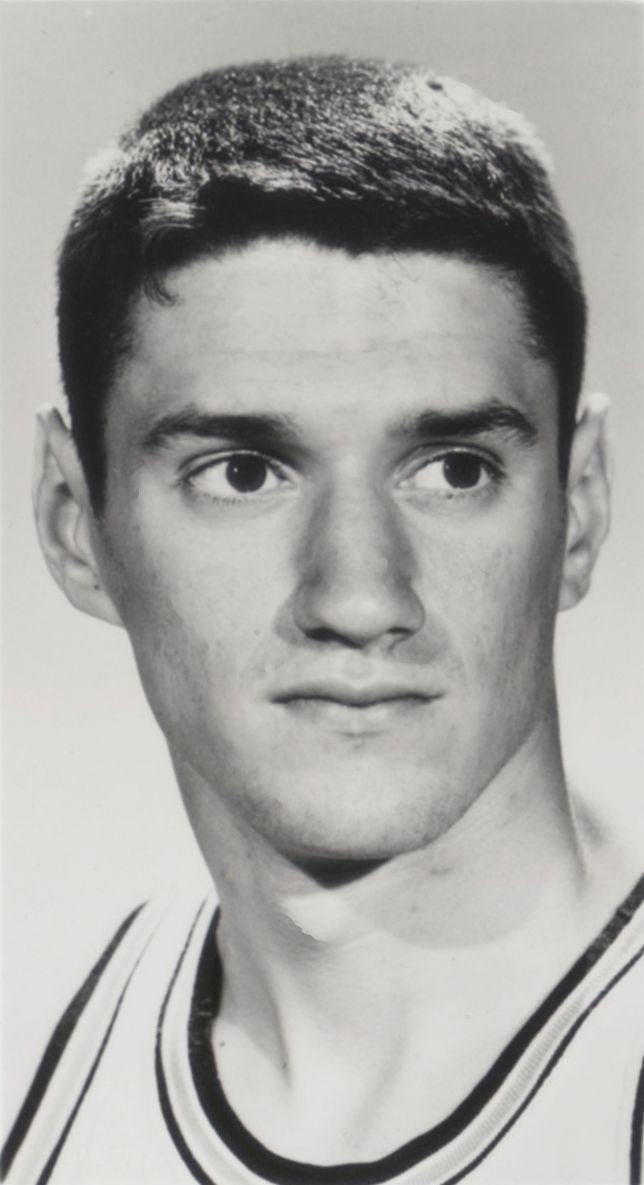
Rick Howat
Apr. 22, 2024
Fifty-three years ago today—April 22, 1971—Rick Howat became only the second Fighting Illini player named as an Academic All-American, joining Dave Scholz who was similarly honored in 1968 and ’69.
Among those joining Howat on the 1971 Academic All-America team were UCLA’s Sidney Wicks, Kansas’s Bud Stallworth and South Carolina’s John Roche.
Howat, who led the state in scoring at Downers Grove North High School with a 32.7 points per game average in 1967, lettered in 1969, ’70 and ’71 under Coach Harv Schmidt. He was a starter in his final two seasons at Illinois, playing alongside Randy Crews, Greg Jackson, Nick Weatherspoon, Mike Price and Nick Conner.
Howat was particularly instrumental as a senior, captaining the team, averaging 20.7 points per game, earning second-team All-Big Ten honors, and being voted the squad’s Most Valuable Player. In a two-point Illini home-court victory against Wisconsin that season, he scored a career-best 31 points, including UI’s last 10. Eighteen days later, at the Chicago Stadium, Howat’s 30-point performance helped Illinois top Austin Carr and Notre Dame in overtime.
He graduated from the U of I with a business degree with a 4.4 grade point average (5.0 scale). Howat was chosen by the Milwaukee Bucks in the 1971 NBA Draft, but instead made a six-year commitment to serve in the Army reserves. After service, he returned to Illinois to receive a master’s degree in teaching.
Howat joined the staff at Addison Trail High School in 1974, teaching American history and government. He coached the Blazers’ sophomore team for five seasons, then became ATHS’s head coach for the next 15 years, winning a pair of conference titles. Howat left coaching in 1995, but returned six years later to become the freshman coach at Hinsdale Central (2001-06).
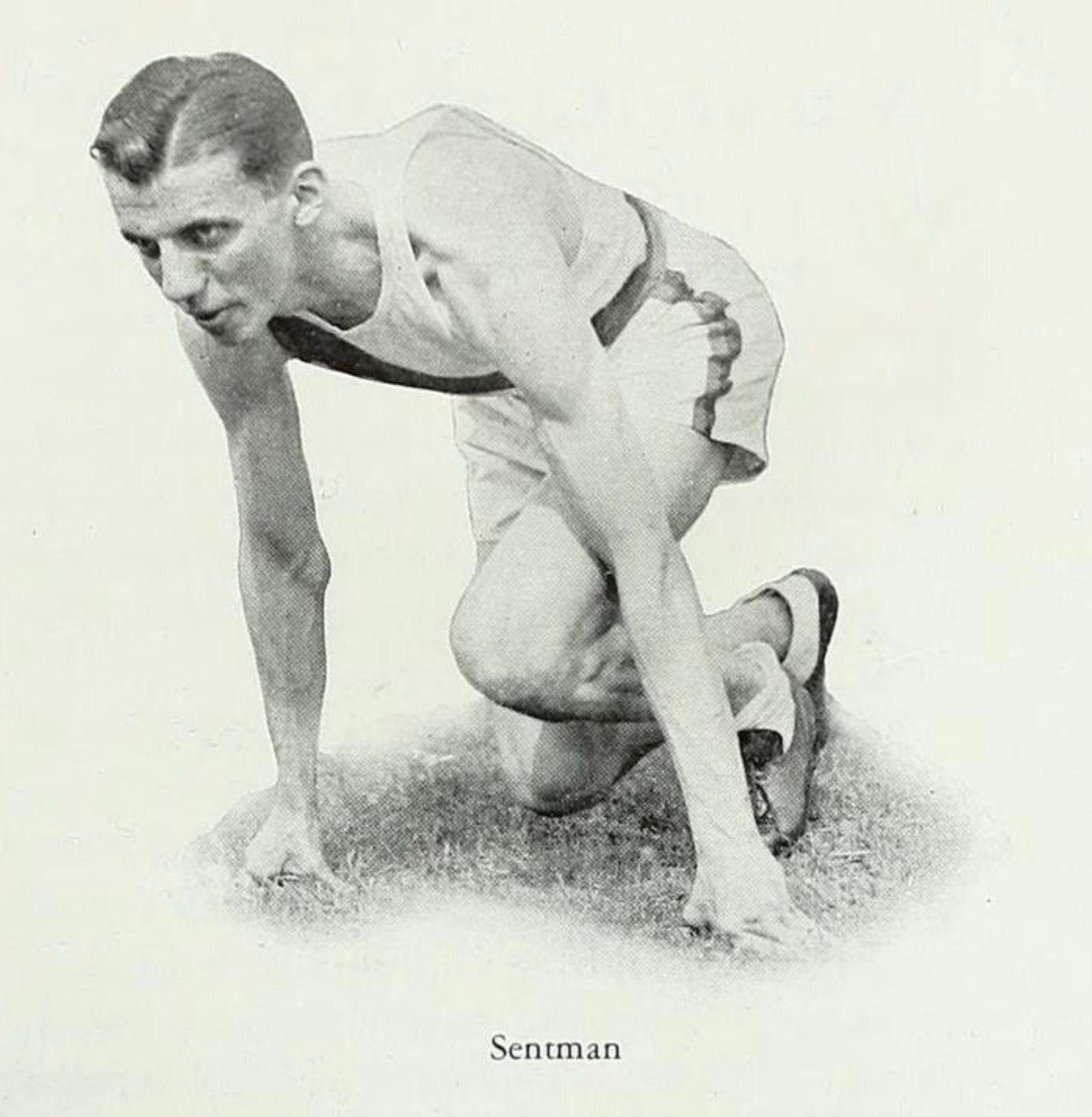
Lee Sentman
Apr. 19, 2024
Ninety-four years ago today—April 19, 1930—Lee Sentman set one world record and a quartet of other Fighting Illini athletes matched another at the Kansas Relays in Lawrence, Kan.
With a crowd of 20,000 fans looking on and with University of Illinois legend Avery Brundage serving as the meet’s referee, Decatur junior Lee Sentman led off the record-setting day with an all-time mark of :14.6 in the 120-yard high hurdles. He glided flawlessly over the ten 42-inch high barriers, finishing well ahead of Iowa’s George Saling.
Later in the day, Illinois’s 440-yard sprint relay unit—made up of senior Ernest Useman, junior James Cave, junior Charles Dickinson and senior James Paterson—ran the 440 yards in an all-time college record time of 41 seconds flat. Their clocking tied the world mark.
Sentman is one of the University’s most unheralded athletes ever. In addition to his sterling performance in Kansas 90 years ago, he also tied the collegiate record in the 220 low hurdles at the 1930 NCAA championship meet and tied the world mark at 120 yards at the 1931 Big Ten meet. When he died in 1996 at the age of 86, Sentman’s time of 7.4 seconds in the 60-yard high hurdles, set in 1931, remained as the sixth-fastest time ever recorded at an Illini athlete in that event.
Exceptional in the classroom as a civil engineering major, Sentman was awarded the Big Ten Conference Medal of Honor in 1930. During World War II, he served as an executive officer to the chief of construction at General Dwight Eisenhower’s headquarters.
Sentman and his wife, Esther, eventually settled in Champaign where he became a renowned construction executive. Their son, Lee Sentman III, was an Illini fencer and in 1958 also was accorded the Conference Medal of Honor award.
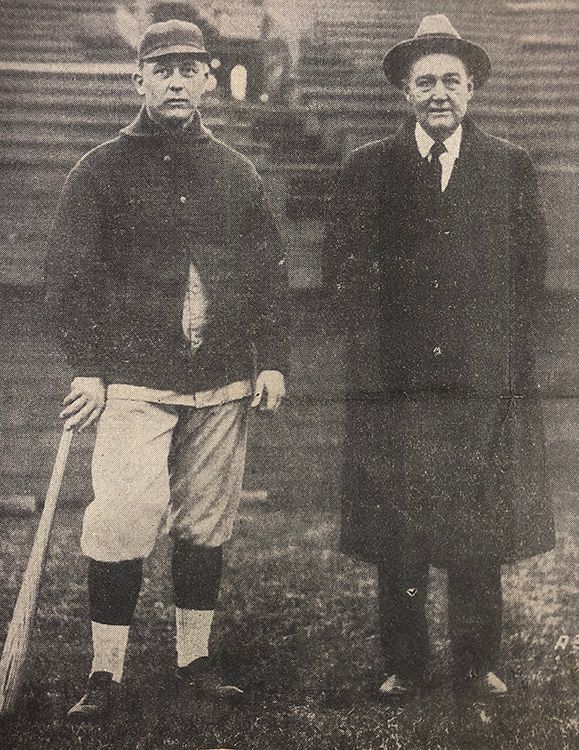
George Huff
Apr. 17, 2024
One-hundred-seventeen years ago today—Apr. 17, 1907—on the day of his departure to Boston to become manager of the Red Sox, Illini baseball coach George Huff was honored between innings at Illinois’ season-opening home victory against Wabash.
Reported the Champaign Daily Gazette, “Illinois Field rang with cheers for ‘G”. He responded with well-chosen words. He didn’t need to tell us that he hated to leave. That was self-evident. Coach Huff left last evening for his new field of work, the highest hopes, best wishes and sympathies of the entire Illini aggregation going with him. The team’s winning its first college game of the season shows promise of a prosperous season. ‘G’ has given the men a good start and the vital part of the training of this year’s team in over.”
After only 14 days in Boston, with his team compiling a mediocre 2-6 record, Huff came to grips with the fact that he wasn’t enjoying his new job. His grand experiment with professional baseball ended when handed in his resignation and boarded the first westbound train he could catch back to Illinois. Never again did the thought of managing in the "bigs" cross his mind.
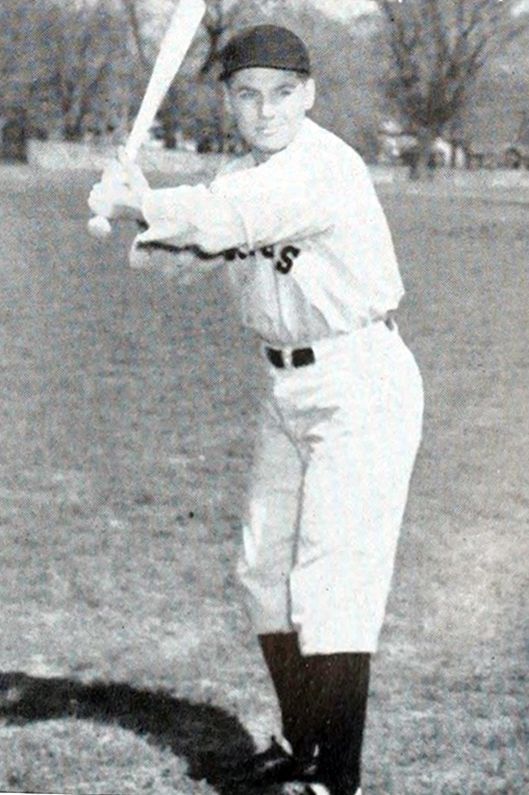
Top Big Ten Batting Averages
Apr. 15, 2024
In 1946, Illinois’ Lee Eilbracht compiled an Illini record .484 average in nine conference games, collecting 15 hits in 31 at bats, and claiming the Big Ten batting title.
The all-time Big Ten record for single-season average was established in 1961 by Michigan’s Bill Freehan, a future 11-time Major League all-star player for the Detroit Tigers. Freehan’s .585 average is considerably better than the second-best mark on the conference list.
Top Big Ten averages (since 1939):
.585 … 1961 - Bill Freehan, Michigan, 1951
.532 … 1998 - Jason Trott, Ohio State, 1998
.514 … 1985 - Randy Wolfe, Michigan, 1985
.500 … 1950 - Bill Skowran, Purdue, 1950
.500 … 1983 - Fred Erdmann, Michigan, 1983
.500 … 1995 - Scott Weaver, Michigan, 1995
.485 … 1955 - George Smith, Michigan State, 1955
.484 … 1946 - Lee Eilbracht, Illinois, 1946
.476 … 1991 - Mike Smith, Indiana, 1991
.475 … 1980 - John Hotman, Iowa, 1980
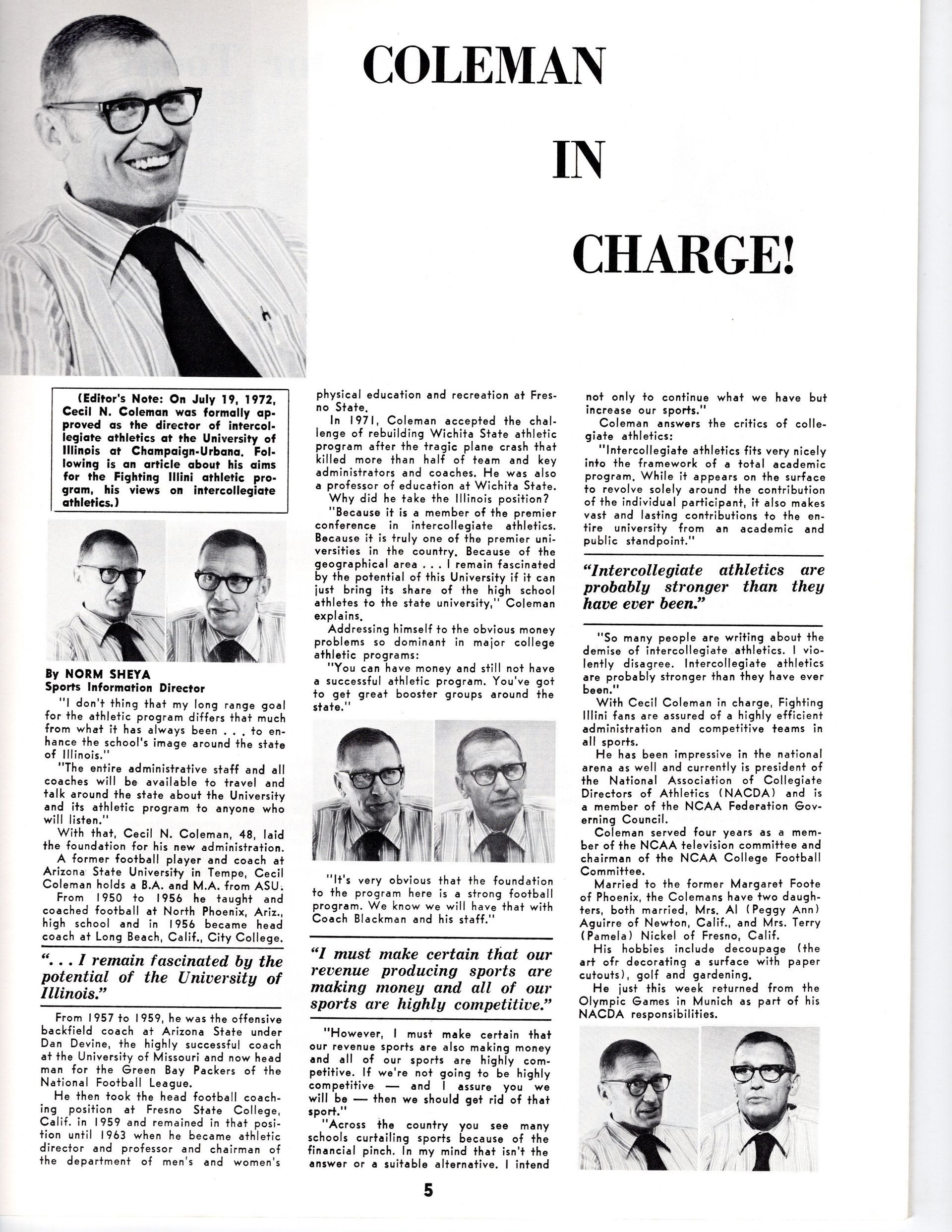
Cecil Coleman
Apr. 12, 2024
Born on this date in 1924 was former University of Illinois athletic director Cecil Coleman.
He assumed those duties on Aug. 1, 1972, replacing Gene Vance.
Coleman was hired from Wichita State University after one year in that role. His task at Illinois was to keep the athletic department’s $2.47 million budget in order and to monitor the department from running astray of NCAA rules and regulations.
Among the men the former Fresno State head football coach and athletic director hired were Gene Bartow and Lou Henson in basketball, and Gary Moeller in football. When the United States Congress passed Title IX regulations in 1972, mandating equal opportunity for women, Coleman hired Karol Kahrs to oversee the assignment of bringing women’s athletics under the Athletic Association’s umbrella. In 1974, he presented Kahrs with an initial budget of $82,500 for UI’s seven-sport women’s program.
Coleman was released from his duties by Illinois in April of 1979. He became the first commissioner of the Midwestern City Conference in 1980, a basketball league that included Loyola of Chicago, Butler and St. Louis. The MCC eventually evolved into the Horizon League and, today, that conference’s highest individual award is the Cecil Coleman Medal of Honor.
Following a short illness, Coleman died in February of 1988 in Urbana at the age of 63.
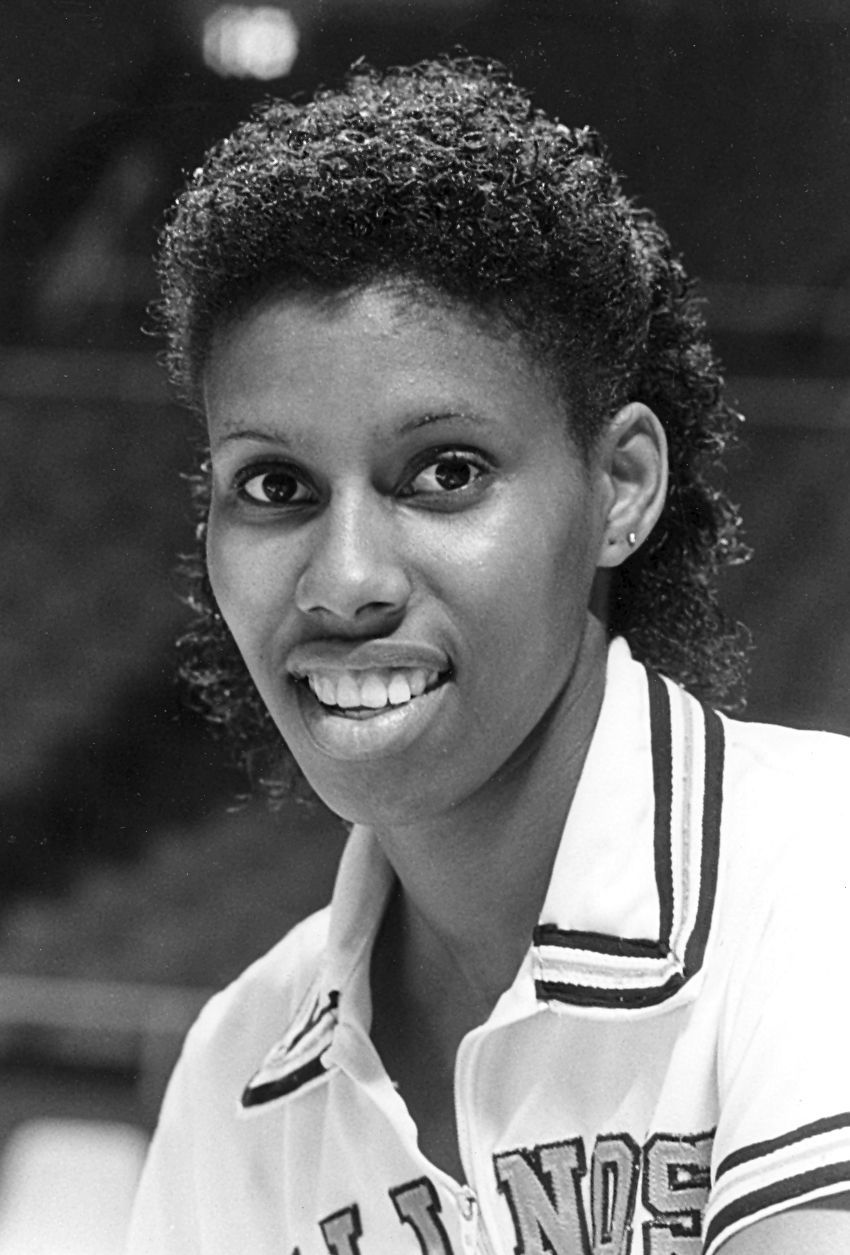
Kendra Gantt
Apr. 8, 2024
From Kansas City to Peoria to Kuwait City … that’s been the trajectory of former Illini women’s basketball player Kentra Gantt’s life through her first 61 years. Today is her birthday.
Recruited to the University of Illinois in 1981 by Coach Jane Schroeder, the former Peoria Richwoods High School all-star flourished from 1981-85.
Gantt averaged 10.4 points and 7.5 rebounds as a freshman, 21 points and 8.6 rebounds as a sophomore, 13.8 points and 6.0 rebounds as a junior, and 8.6 points and 5.8 rebounds as a senior. She finished with 1,526 points and 803 rebounds, both ranking second on Illinois’s career lists.
One Illini record Gantt still holds today is the single-game mark for points. As a sophomore on January 3, 1983, against Kent State, she scored 32 points in the first half on 15-of-17 shooting, then tallied 17 more in the second half for a record 49 total points.
“Everything I threw up went in,” Gantt remembered. “I could have done back flips and cartwheels, and the ball still would have gone in.”
She graduated from Illinois with degree in speech communications, but fulfilled her lifelong fantasy in January of 1987 by enlisting in the Army.
“I always wanted to wear a maroon beret and jump out airplanes,” Gantt said.
Her unit helped capture Panamanian dictator Manuel Noriega in 1989, then she served as the only female in an all-male platoon in Operation Desert Storm, better know as the first Gulf War. Gantt was a member of the Air National Guard from 1992-95.
She began a five-year career as a professional wrestler in 1995, training at one point with the Ultimate Warrior.
In 2000, Gantt was employed by the United States Department of Veteran Affairs in Fayetteville, North Carolina, then became an independent government contractor three years later, moving to Iraq. There she served as a bodyguard, protecting workers who were reinstalling power and lights in the dangerous, war-torn country.
Following a year’s respite in Peoria in 2004, Gantt was employed by URS Corporation in Kuwait City, specializing in logistics. She’s been based for the last 14 years at Camp Arifjan, a U.S. installation that serves the Air Force, Navy, Marine Corps and Coast Guard.
In 2022, she was inducted into the Illinois Basketball Coaches Association Hall of Fame.

Stephen Bardo
Apr. 5, 2024
Happy 56th Birthday to Flying Illini alum Stephen Bardo.
The son of Dr. Harold Bardo, former Southern Illinois University athlete and longtime director of SIU’s Medical/Dental Education Preparatory Program, was recruited to Illinois by Lou Henson.
The former Carbondale Terriers star was a member of a class that included Kendall Gill, Larry Smith, Jeff Finke, Phil Kunz and Jim Green. Henson started Bardo in the last eight games of his freshman season (1986-87), then 21 times as a sophomore.
As a junior in 1988-89, he was a key member of the 31-5 Illini team that made it all the way to the Final Four. Including his senior campaign that saw Illinois go 21-8, his four Illini teams had a cumulative record of 98-31 (.760). Bardo was the Big Ten’s Defensive Player of the Year in ’88-89 and earned third-team All-Big Ten honors his senior year.
He was a second-round pick of the Atlanta Hawks in the 1990 NBA Draft and played portions of three NBA seasons, then several more overseas.
Bardo was the radio analyst for the Illini from 2000-05 and, today, serves as an analyst for the Fox Network.
His top scoring games as an Illini:
20 points vs. Michigan (1/15/90)
18 points vs. Purdue (2/21/90)
17 points at Iowa (2/5/89)
17 points vs. Austin Peay (12/8/87)
16 points at Indiana (3/11/90)
16 points vs. Indiana State (12/8/89)
16 points vs. Georgia Tech (1/22/89)
16 points at Minnesota (2/12/87)
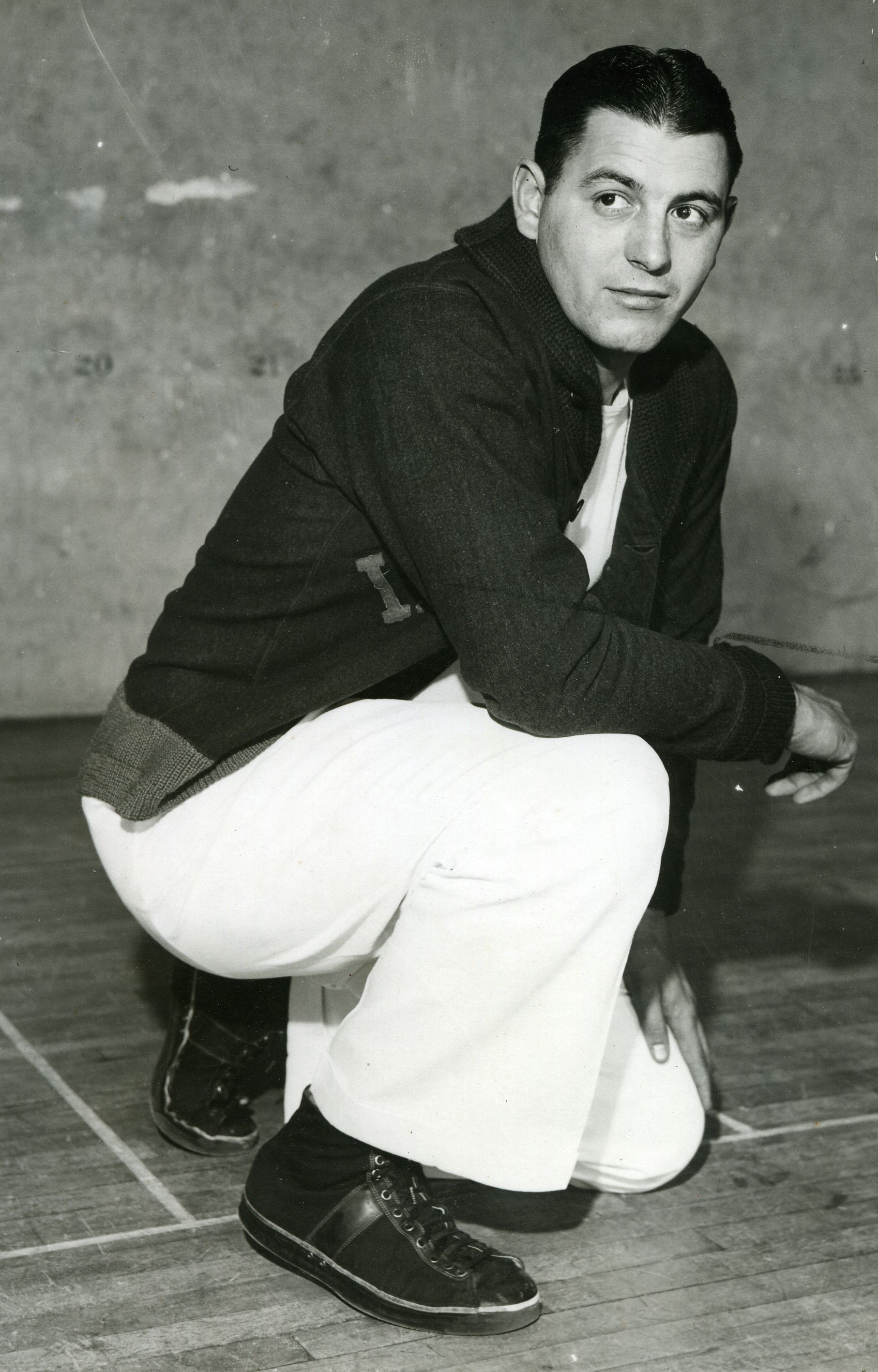
Doug Mills
Apr. 3, 2024
Eighty-eight years ago today—Apr. 3, 1936—Doug Mills 28-year-old assistant coach signed a contract to become the University of Illinois’ ninth head basketball coach.
Replacing Craig Ruby, who had tendered his resignation two months earlier to athletic director George Huff, Mills’ annual compensation of $4,000 was approximately one-tenth of one per cent of the amount that Brad Underwood agreed to this past week.
In his deal with Huff, Mills retained his post as UI’s freshman football coach. Newspaper reports indicated that another Ruby assistant, Wallie Roettger, also was a finalist to direct the Illini basketball program.
From 1927-30, Mills’ career as an Illini football and basketball athlete was highlighted by both individual and team success. He was a two-time all-conference basketball player for Ruby and a three-year letter winner on the gridiron for Bob Zuppke, leading his teammates to a pair of Big Ten football titles.
As Illinois’ first-year coach, Mills’ 1936-37 squad included star forwards Lou Boudreau and Harry Combes. That season, the Illini had a Big Ten best 10-2 record and an overall mark of 14-4. Although Illinois didn’t win any conference titles over following four seasons, he was busy building a winner. Mills was struck recruiting gold in the state of Illinois when he enticed Andy Phillip from Granite City, Ken Menke from Dundee, Art Smiley from Waterman, Gene Vance from Clinton and Art Mathisen from Dwight. The quintet, known collectively as the “Whiz Kids”, were simply magical in 1941-42 and ’42-43, winning consecutive Big Ten championships.
Altogether, over 11 seasons, Mills’ Illini teams won nearly 70 per cent of their games. In nine of those seasons, Illinois had a winning Big Ten record, including a perfect 12-0 mark in 1942-43.
Following the 1946-47 season, Mills stepped down from his basketball duties to devote full-time attention as Illinois’ athletic director, a job he inherited in 1941 at the age of 33.
The final years of Mills’ administration were marred by a Big Ten investigation of Illinois’ football and basketball programs, and he gave up his post in November of 1966.
Suffering from ill health, Mills died on Aug. 12, 1983 at the age of 75. He was buried at Roselawn Cemetery in Champaign.
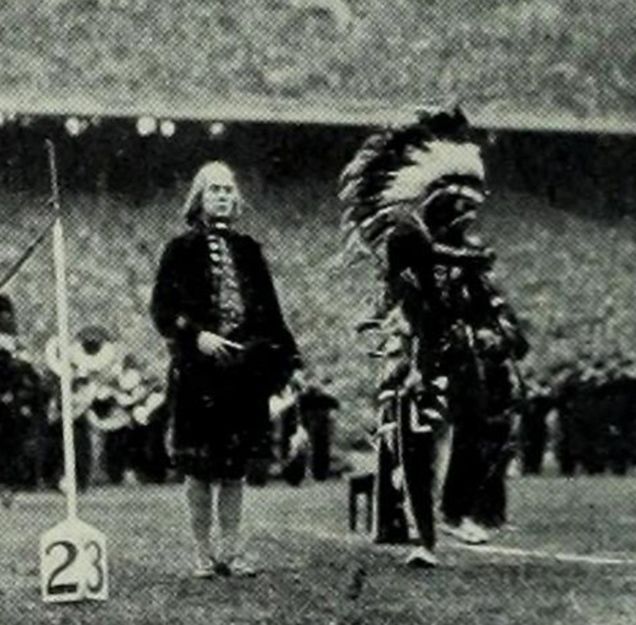
Lester Leutwiler
Apr. 1, 2024
Today marks the 117th anniversary of the birth of Lester Glenn Leutwiler, the first man chosen to portray Chief Illiniwek at the University of Illinois.
The UI sophomore from Urbana was the son of Oscar Leutwiler, longtime head of UI’s Department of Mechanical and Industrial Engineering. Leutwiler, an Eagle Scout, was interested in Indian lore.
In his recollection of the final portion of that first performance On Oct. 30, 1926, Leutwiler wrote, “As the band marched into the formation (spelling out the word “Penn”), the band stopped in the center of the field and played ‘Hail Pennsylvania’ while the Chief saluted the Penn rooters. William Penn, impersonated by George Adams (the Illini drum major), came forward and accepted the gesture of friendship. Together, we smoked the peace pipe and walked arm in arm across the field to the Illinois side, amidst a deafening ovation.”
Leutwiler’s performance was so well received that he was asked to continue his performances at future Fighting Illini football games.
The tradition continued until Feb. 21, 2007, when Chief Illiniwek was retired by the University.
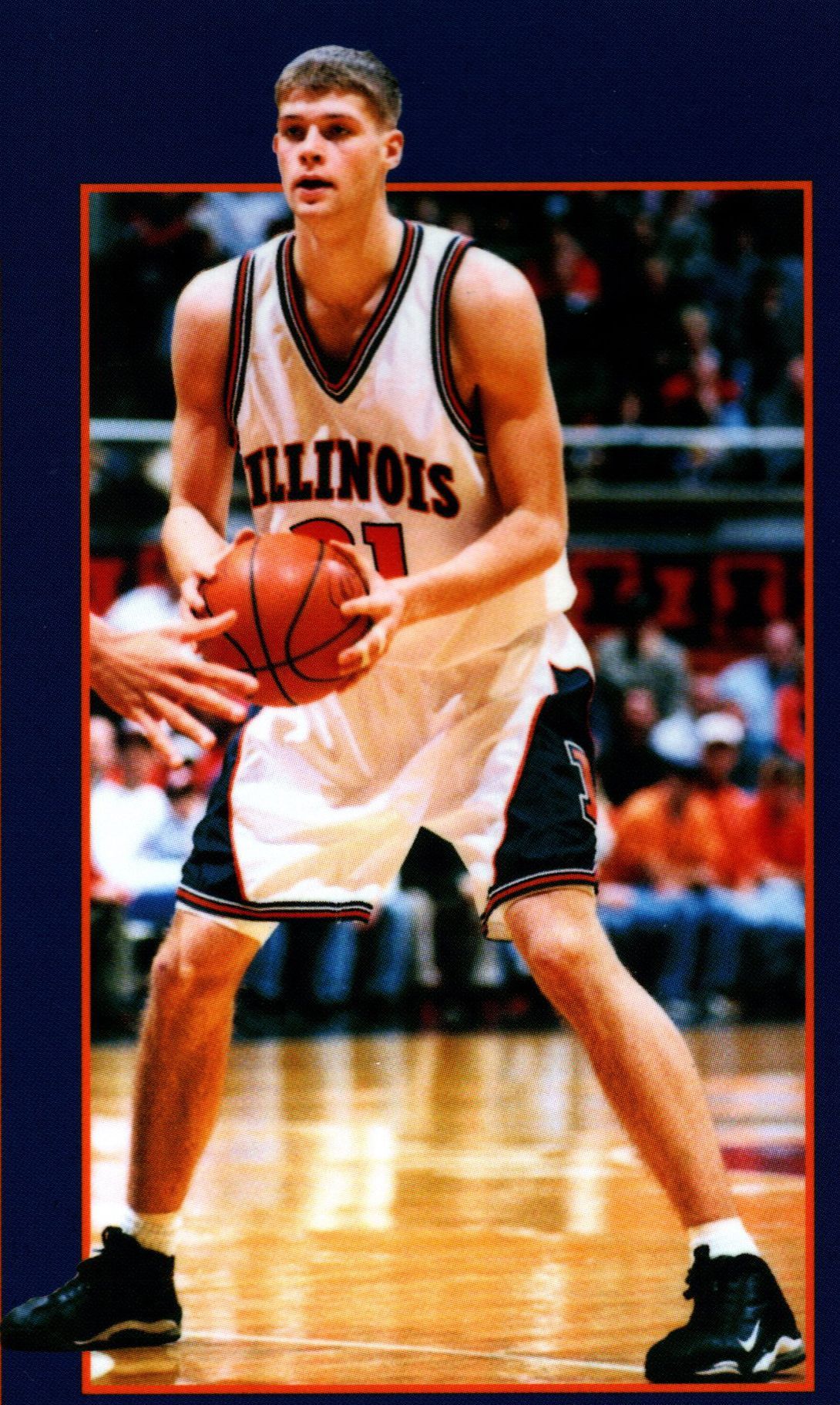
Robert Archibald
Mar. 29, 2024
Today (Mar. 29) would have been former Fighting Illini basketball star Robert Archibald’s 44th birthday. He died suddenly on January 23, 2020.
Born in Paisley, Scotland, he was the son of Scottish legend Bobby Archibald. Robert began his basketball career with Queen Anne High School, but concluded his prep years at Wildwood, Missouri’s Lafayette High School when his father relocated the family to the United States.
Coach Lon Kruger recruited the 6-foot-11-inch Archibald to Illinois, but success came slowly. In his first two seasons—1998-99 and 1999-2000—Archibald scored in double figures only three times in 62 games. As a junior, his skills sharpened significantly and he became Illinois’s leading scorer (7.2 points per game) and rebounder (4.5 rebounds per game) off the bench. He also averaged 1.13 blocked shots in Big Ten games, ninth best among conference players. By far, Archibald’s greatest highlight that third season came in the team’s final game of the year. He scored 25 points and grabbed seven rebounds against Arizona in the NCAA Midwest Regional Finals and was named to that region’s all-star team.
Archibald’s senior campaign was clearly the best of his career, averaging 10.6 ppg , 5.5 rpg, 1.3 assists and 1.1 blocks for the 2002 Big Ten co-champs. League coaches named him to their third-team all-conference unit and the media gave him honorable mention.
The Memphis Grizzlies selected Archibald in the second round of the 2002 NBA Draft, becoming the first Scot ever to be chosen. After appearing in only 12 games as a rookie, he was traded to the Phoenix Suns. In December of 2003, within the course of a week, Archibald was dealt to the Orlando Magic and then to the Toronto Raptors.
In 2004, he transferred his professional game to Europe, performing over eight seasons in Spain and Ukraine. Perhaps Archibald’s premier basketball moment came in 2012 where he played for Great Britain at the London Olympics. The Brits lost consecutive games against Spain (79-78), Brazil (67-62), the Russian Federation (95-75) and Australia (106-75).
He returned to the state of Illinois and, benefitting from the economics degree he earned from the University of Illinois, became an agent for State Farm Insurance in Elmhurst.
Following his death, his family created the Robert Archibald Student-Athlete Health and Wellness Fund.

Tug Wilson - Big Ten Commissioner
Mar. 27, 2024
Kenneth “Tug” Wilson was an outstanding Illini athlete who went on to compete in the Olympics, a successful coach and a renowned scholastic administrator, but his highest profile in nearly 83 years of life was as the second Commissioner of the Big Ten Conference.
Born in Atwood, Ill., on this date in 1896, it was in March of 1945, following the death of Major John Griffith, when Wilson was elevated from his role as Northwestern University’s Director of Athletics to one of college athletics’ most prominent positions.
Wilson was attending a meeting of the ten athletic directors at Chicago’s Sherman Hotel where the conference’s office was located. In the 1967 book entitled The Big Ten that he authored with Jerry Brondfield, Wilson described the scene he encountered.
“The scheduled December meet in 1944 was a dramatically sad one,” Wilson wrote. “Major Griffith had not been in the best of health, but insisted on conducting the meeting, and at the end of the day the directors were going to join the faculty representatives at the University Club for dinner. L.W. St. John (Ohio State’s athletic director) and I were waiting in the (hotel) lobby for the Major to come downstairs. After a long wait, Saint asked me to go up and see what was keeping him. The Major’s door was open. I walked in and found him dead on the floor. It was a terrific shock, for he had been my best friend through many years. The meetings were cancelled and the following Monday the ten directors carried Major Griffith to his grave.”
Shortly after Griffith’s funeral, athletic directors St. John, Guy Mackey of Purdue and Doug Mills of Illinois proposed that Wilson be promoted to replace Griffith as head of the conference. League faculty representatives approved the directors’ recommendation the following March and Wilson assumed the role two months later.
Under Wilson’s direction of the Big Ten from 1945 to 1961, he guided the league out of World War II and into the modern era. These were some of the moments the conference experienced during Wilson’s commissionership:
1945-1961: Big Ten teams dominated the NCAA swimming and diving championships, winning 14 of the 17 team titles during Wilson’s period as commissioner.
1946: The University of Chicago formerly withdrew from the Conference.
1946: Big Ten officials voted to enter an agreement with the Pacific Coast Conference to establish an annual match-up in the Rose Bowl football game. Illinois defeated UCLA in the first meeting (Jan. 1, 1947).
1946 and 1947: Illinois won NCAA titles in track and field (followed by Minnesota in 1948).
1947 and 1948: Michigan football was the national champion.
1948: It was voted that Michigan State College be admitted to conference membership.
1952: Michigan State football was the national champion.
1953: Michigan won the Big Ten’s first NCAA title in baseball. (followed by Minnesota in 1956 and 1960).
1954: Ohio State football was the national champion.
1957: Michigan won the conference’s first NCAA title in tennis.
1959: A new recruiting regulation is enacted to allow member schools to pay travel expenses for a prospect’s campus visit.
1960: Led by Jerry Lucas, Ohio State won the NCAA basketball title.
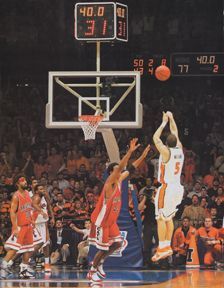
Illini Basketball's Most Exciting Game Ever
Mar. 25, 2024
Tomorrow marks the 19th anniversary of what most Fighting Illini basketball fans refer to as the most exciting game ever.
On March 26, 2005, with a berth in the Final Four on the line, top-ranked Illinois and No. 9 Arizona battled in a game for the ages at the Allstate Arena in Rosemont. Trailing 75-60 with four minutes left, Illinois staged an improbable 20-5 run, sending the game into overtime.
In OT, a combination of two three-pointers by Deron Williams and one two-pointer by both Roger Powell and Luther Head accounted for one point more than Lute Olson’s squad, with the Illini prevailing by a score of 90-89.
As one sportswriter wrote afterwards, “Keep the bus running, and point it toward St. Louis.” The Illini heroes, in no particular order, included:
Roger Powell—scored 16 points, including a huge dunk in overtime.
Luther Head—despite a sore hamstring, he tallied 20 points, including five three-pointers, and made four crucial steals.
Deron Williams—hit a game-tying three-pointer with 38 seconds remaining in regulation, ending with a team-high 22 points and 10 assists.
Jack Ingram—made two game-changing steals, including one that led to Williams’ electrifying game-tying shot.
Dee Brown—among his game statistics were 15 points, seven assists and three steals.
James Augustine—scored only four points, but his defensive play in the middle was a key to the victory.
Rich McBride—hit one of his two three-point tries.
Warren Carter—made both of his free throw attempts and grabbed two rebounds in just three minutes of play.
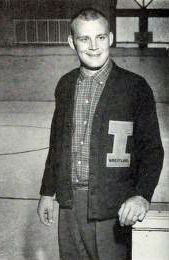
Bob Norman
Mar. 20, 2024
Sixty-six years ago today—March 22, 1958—heavyweight Bob Norman became only the second Fighting Illini wrestler to win back-to-back NCAA individual championships. What’s even more amazing is that he achieved his accomplishments in his only two varsity letter-winning seasons at Illinois.
As a scrawny 125-pound freshman in 1946 at Cicero’s Morton High School, Robert James Norman originally planned to be a swimmer, but his times weren’t good enough to make the team. A friend suggested that he go out for wrestling. A significant growth spurt between his freshman and sophomore years—12 inches and 50 pounds— and the expert tutelage of Morton coach Bill Vohaska, a former Illini two-sport star, transformed Norman into the school’s first-string heavyweight and a starting lineman with the football team.
Upon his graduation from high school, Norman enlisted with the Marine Corps, training in Quantico, Va.
When his service ended, the 22-year-old enrolled at the U of I to study agriculture. Norman played briefly for Coach Ray Eliot’s Illini football team, but a serious knee injury abruptly ended his gridiron career.
Norman recuperated for the next several months and eventually knocked on the door of Illini wrestling coach Buell “Pat” Patterson to offer his services. Fortunately, this meeting precipitated Norman’s pathway into three different Halls of Fame.
He sparkled early and often for the 1957 Illini, capturing his first Big Ten title in the conference meet in Evanston. At the NCAA Championships in Pittsburgh, Norman rumbled to the heavyweight finals with convincing victories against opponents from Kent, Oklahoma A&M and Maryland. He faced future Green Bay Packers Hall of Famer Henry Jordan of Virginia in the title match and triumphed again, this time by a 6-1 score.
Norman’s 1958 performance was equally brilliant. Shortly after winning his second consecutive conference crown in Champaign, he took an unblemished 17-0 record to the NCAA Championships in Laramie, Wyo. Consecutive wins over foes from Utah State, Oklahoma State and BYU placed Norman against Oklahoma’s Gordon Roesler, the 1956 national champ. In that match Norman won by a score of 7-4.
The 27-year-old Illini senior finished with a career collegiate record of 36-0-1, including a phenomenal 22 pins.
Norman was voted into the Illinois Wrestling Coaches Association Hall of Fame in 1977 and the Amateur Wrestling Hall of Fame in 1978. He was inducted into the University of Illinois Athletics Hall of Fame last year.
Norman went on to work as a state highway engineer and as the owner of a carpentry business. His son, Tim, lettered three times with the Illini football team (1977, ’78 & ’80) and his grandson, Jake, lettered for UI’s wrestling team from 2007-10. Now 88 years old, Bob Norman resides in Delavan, Wis.
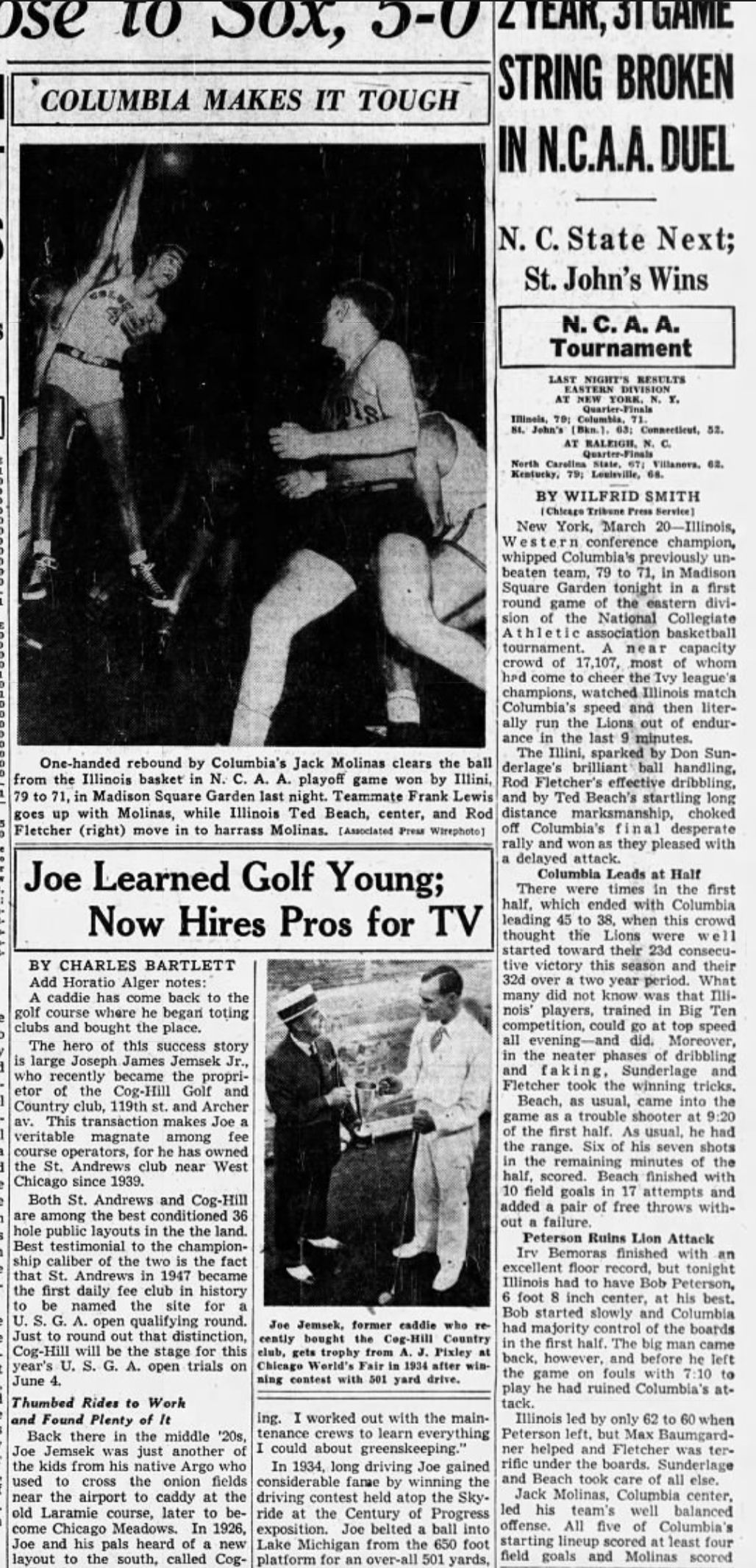
Illinois Beats Undefeated Columbia
Mar. 20, 2024
It was a winning streak that stretched 32 games and 398 days, but it all ended in the first round of the NCAA Tournament at the world’s most famous arena, and at the hands of the Fighting Illini basketball team, 73 years ago today—Mar. 20, 1951.
The Columbia Lions, playing under 29-year-old acting head coach Lou Rossini, were one of the hottest of the 16 teams selected for the national collegiate playoff. Not only did the Lions stand at No. 3 in the Associated Press rankings, they entered the tournament as the school’s only undefeated team (23-0) and the first Ivy League team to finish its regular season unbeaten (12-0). Their average margin of victory was slightly more than 20 points per game.
Coach Harry Combes’ Illini club was ranked fifth by AP and 14 of its last 15 regular season games but had lost at Kansas State six days earlier in what Illinois’ record book refers to as an NCAA “warmup” game.
Predictably, the crowd of 17,107 at Madison Square Garden—located just four miles from Columbia’s campus—was overwhelmingly pro Lions. The majority of the fans cheered wildly as the first half ended in a 45 to 38 Columbia lead. The Lions maintained their lead until less than 10 minutes remaining when Illinois finally slipped ahead, 59-57. A final Lions’ scoring drive pulled them within two points at 73-71, but UI guard Rod Fletcher’s drive to the basket gave Illinois a bit of breathing room en route to a 79-71 final score.
Don Sunderlage’s brilliant ball handling helped him score a game-high 25 points for the Illini and Ted Beach added 22 more on 10-of-17 long-range shooting.
Two nights later, the Illini defeated North Carolina State, 84-70, setting up a match against top-rated Kentucky on Mar. 24. In that one, UI fell to the Wildcats in the final 12 seconds, 76-74, ending the Illini’s dream for a national title.

Glenn Butzer
Mar. 19, 2024
March 19th marks the 136th anniversary of the birth of Glenn Butzer, the captain of the University of Illinois’ only undefeated and unscored upon football team.
The All-America and two-time All-Western guard was a premier defender and, in additional to being an elite blocker, occasionally served as a ball carrier for Arthur Hall. “Whist”, the nickname by which he was known to his teammates, was a native of Hillsdale, located in northwestern Illinois.
Butzer first lettered in 1908 and ’09 for the Fighting Illini, but his greatest fame was realized in 1910. That squad became only the second conference team and just the 13th in college football history to achieve a perfect record and not yield a single point to its opponents.
In succession, Illinois defeated Millikin (13-0), Drake (29-0), Chicago (3-0), Purdue (11-0), otherwise undefeated Indiana (3-0), Northwestern (27-0) and Syracuse (3-0). That 1910 season was when the University celebrated its very first Homecoming at old Illinois Field.
The three Illini teams (1908-09-10) for which Butzer lettered compiled a cumulative record of 17 victories, three losses and one tie.
After graduating from Illinois in 1911, Butzer enjoyed a respectable professional career, including a 19-year stint as the superintendent of roads in Illinois’ Livingston County. A generous man, the longtime Pontiac resident often gave summer jobs to U of I students.
A giant of a man in his day, Butzer tipped the scales at nearly 250 pounds, but his health took a fatal turn in 1933. At the age of 46, he passed away from a long bout with cancer.
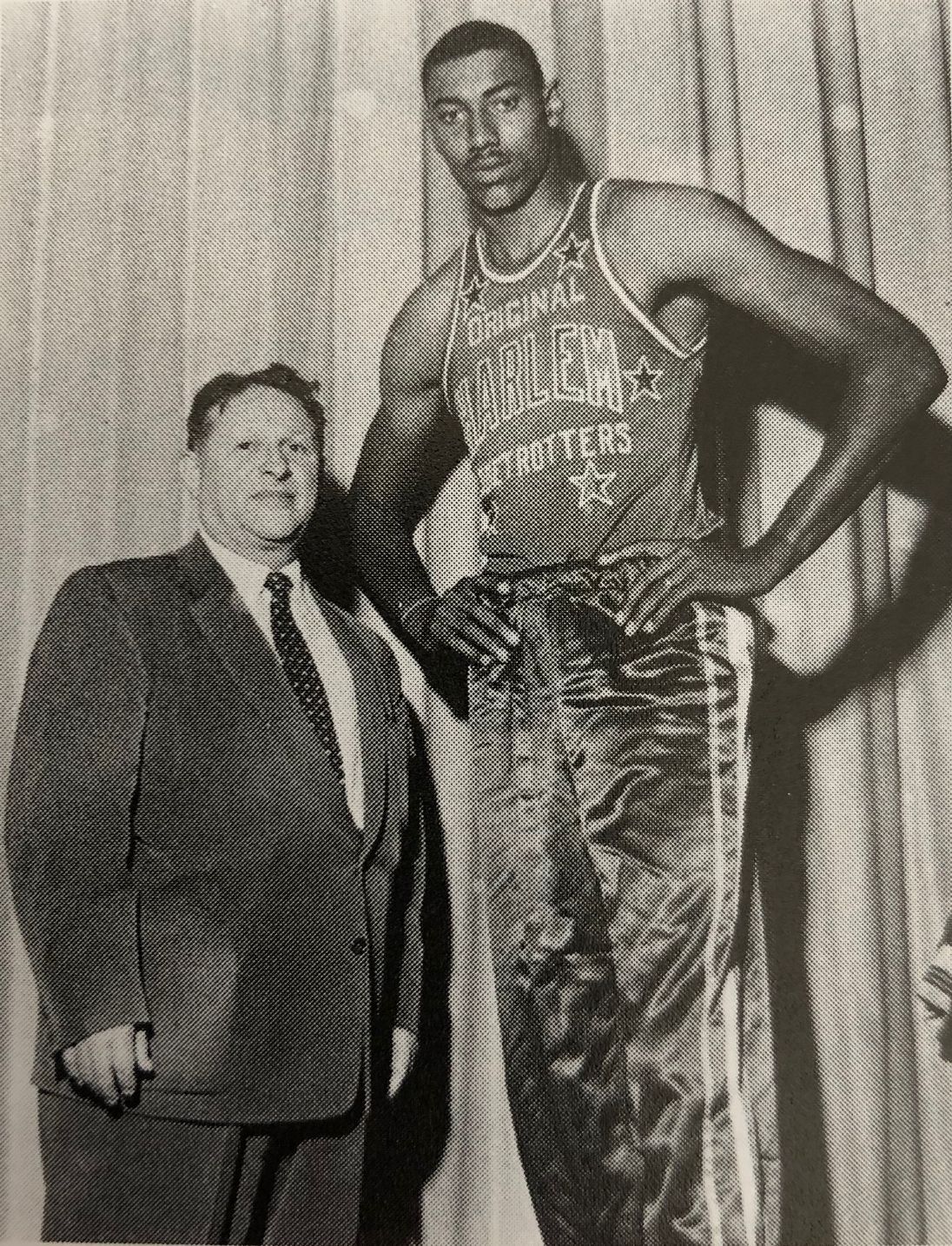
Abe Saperstein
Mar. 15, 2024
Fifty-eight years ago today - Mar. 15, 1966 - Abraham M. “Abe” Saperstein died at the age of 63.
Though he never played varsity sports, he attended the University of Illinois during the same period of history that George Huff headed the UI athletic department.
Despite only standing slightly more than five feet tall, the British-born Saperstein competed in baseball, basketball and track as a high school student in Chicago, but was said to have never been given a tryout for Illinois’ basketball team. He later played guard for the Chicago Reds, a semi-pro team, from 1920 to 1925.
Saperstein began his role as coach and promoter in 1927 when he directed the Savoy Big Five, named after Chicago’s famous Savoy Ballroom. Renamed the Harlem Globetrotters a year later, his all-black barnstorming team initially played serious basketball and dominated games across the country, winning 397 games and losing just 32 in their first three years. When it became increasingly difficult to locate willing opponent, Saperstein conceived the idea of a fancy and comedic style of play. Basketball upheld racial barriers through the end of the 1940s and did not allow blacks to mix with whites, but because the Globetrotters were perceived by the public as entertainers and not athletes, they were able to gain entry into venues heretofore disallowed.
The demand for the Globetrotters was enormous in the 1950s and Saperstein eventually fielded three separate units in the United States, plus an all star international squad.
Saperstein was enshrined in the Basketball Hall of Fame five years after his death in 1966.
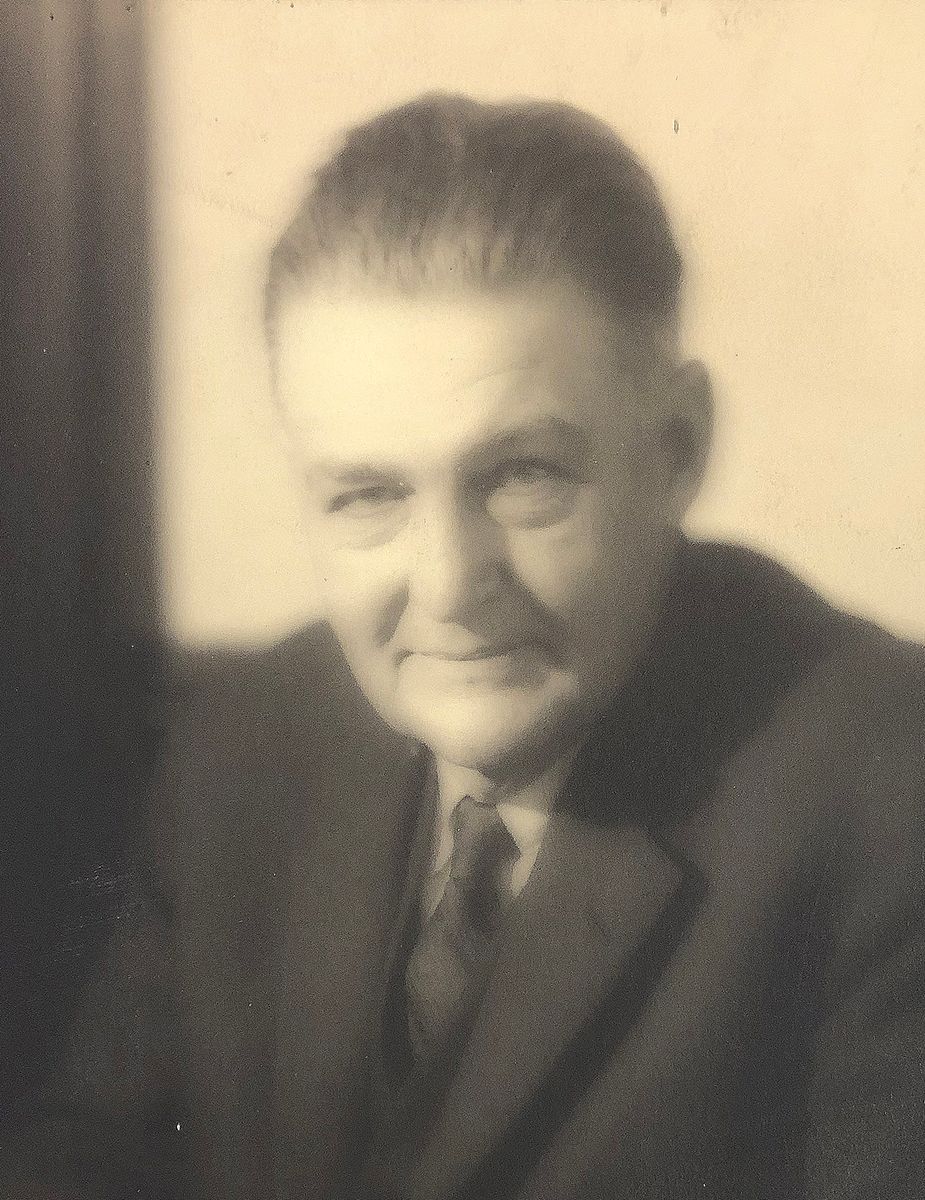
George Huff
Mar. 13, 2024
Longtime Champaign News-Gazette sportswriter Eddie Jacquin remembered George Huff:
“’G’ Huff was just one of the folks. He was a plain man of simple habits and honest frankness. He liked the open country and in later years his greatest joy was to go with his family for a trip in the car. Persons entering his office never had to worry about their reception. He would peer over his glasses at someone waiting outside his office. ‘Are you waiting for me?’, he would exclaim, raising his voice almost to a shout. ‘Well, come in!’, he would say, beckoning with his left hand. ‘G’ Huff never rode the fence. If a decision was to be made, he would make it. He might say, ‘Now, if I am wrong, I’ll take the blame, but that’s the way I see it.’ He didn’t believe in elaborate approaches to a subject, nor was he much for verbal perambulating. Simplicity was just a part of his nature. That seemed to have been a part of his success in coaching baseball. ‘These games are really not as hard as some of these boys make it out to be,’ he would say kindly. ‘If they would only use horse sense and do things the easy, natural way, rather than the different way.’ In his declining years, ‘G’ never missed an Illinois baseball practice when the weather was favorable and his health would permit. If it was a chilly day, he would ask to be driven close to the baseball field where he could look upon the youngsters playing the game he loved so well. He was a great lover of youngsters, and often made arrangements that boys of grade school age be permitted to see the varsity baseball games without charge.”
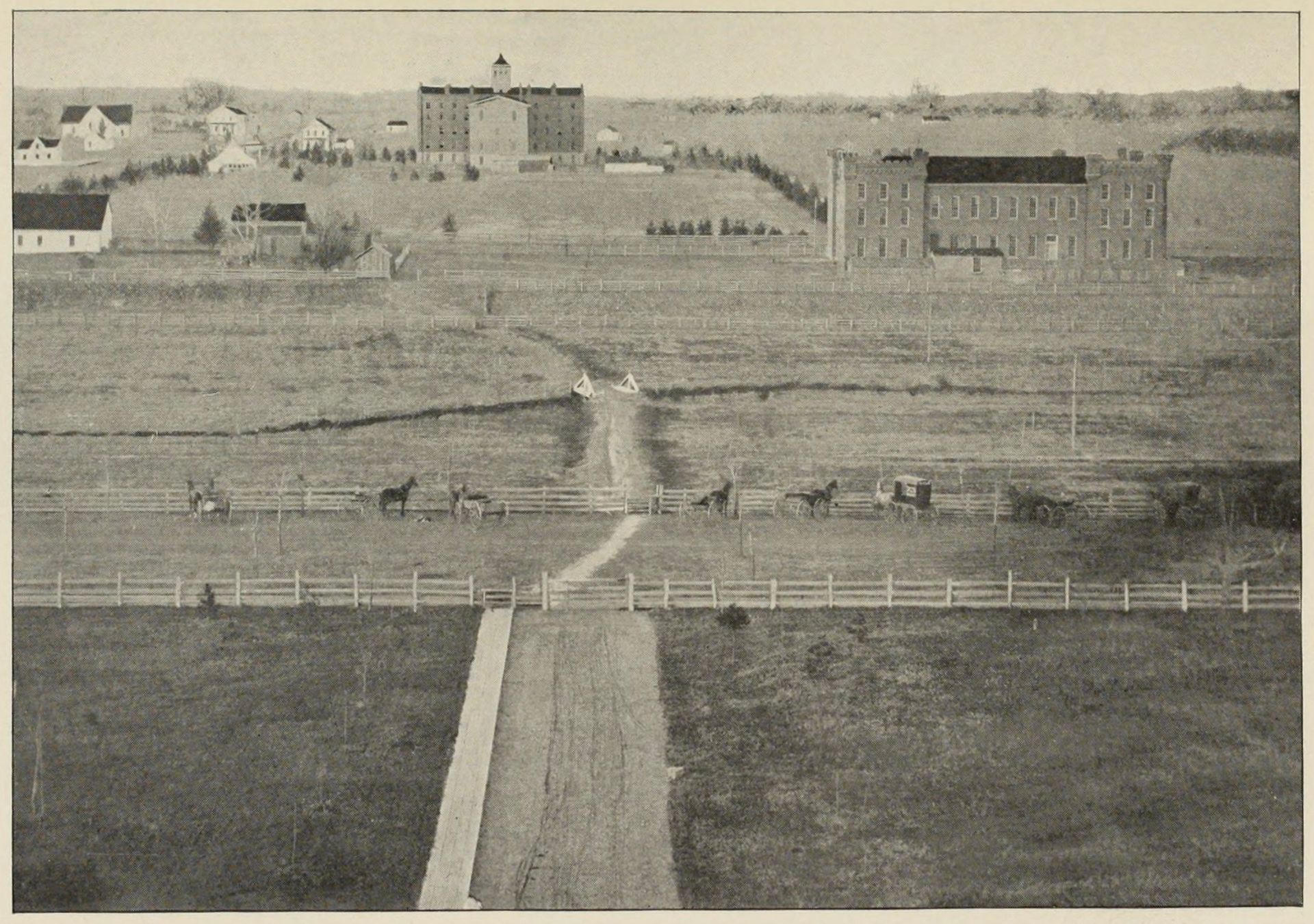
Happy Anniversary
Mar. 11, 2024
One-hundred-fifty-six years ago today—March 11, 1868—the Illinois Industrial University (University of Illinois) celebrated its opening of nine days earlier with inaugural ceremonies. President John Milton Gregory, both members of his faculty, 77 students and a bevy of town folk gathered in a large hall on the third floor of University Hall, known by its moniker “The Elephant.”
In “Hot Type”, a 2002 book authored by Tom Kasich, the weather outside was described as being miserable. The town’s newspaper, The Union & Gazette, colorfully described the conditions. “It seemed all the elements in nature had combined to make the day disagreeable and the occasion of a failure, for overhead it was dark and lowering, underfoot an almost unfathomable depth of mud, and between and lying loose was rain and water enough to make ducks or the student of hydraulics supremely happy.”
Inside, however the ceremonies were jubilant. Decorated in red, white and blue, a large portrait of George Washington hung over the speaker’s platform. Following a performance of the new University Anthem, speeches were presented by Gregory and Superintendent of Public Instruction Newton Bateman, then the crowd sang “America” and offered a series of toasts.
Other miscellaneous notes about the campus in 1868, plus events that were happening around the world 150 years ago:
• The University’s library opened with 1,092 total volumes, including 289 books about law and politics, 269 concerning history and biography, 240 general literature volumes, 104 books about education, 92 regarding science, 59 about philosophy, and 39 concerning agriculture.
• On May 16, 1868, then again on May 26, President Andrew Johnson was acquitted by one vote in an impeachment trial by the U.S. Senate.
• On May 30, 1868, Memorial Day was first observed in the United States.
• On July 28, 1868, following its ratification by the necessary three-quarters of U.S. states, the 14th Amendment, guaranteeing to African Americans citizenship and all its privileges, was officially adopted into the U.S. Constitution.
• On Nov. 3, 1868, Republican Ulysses S. Grant defeated Democrat Horatio Seymour in the presidential election.
• On Dec. 25, 1868, President Johnson granted an unconditional pardon to all Civil War rebels.
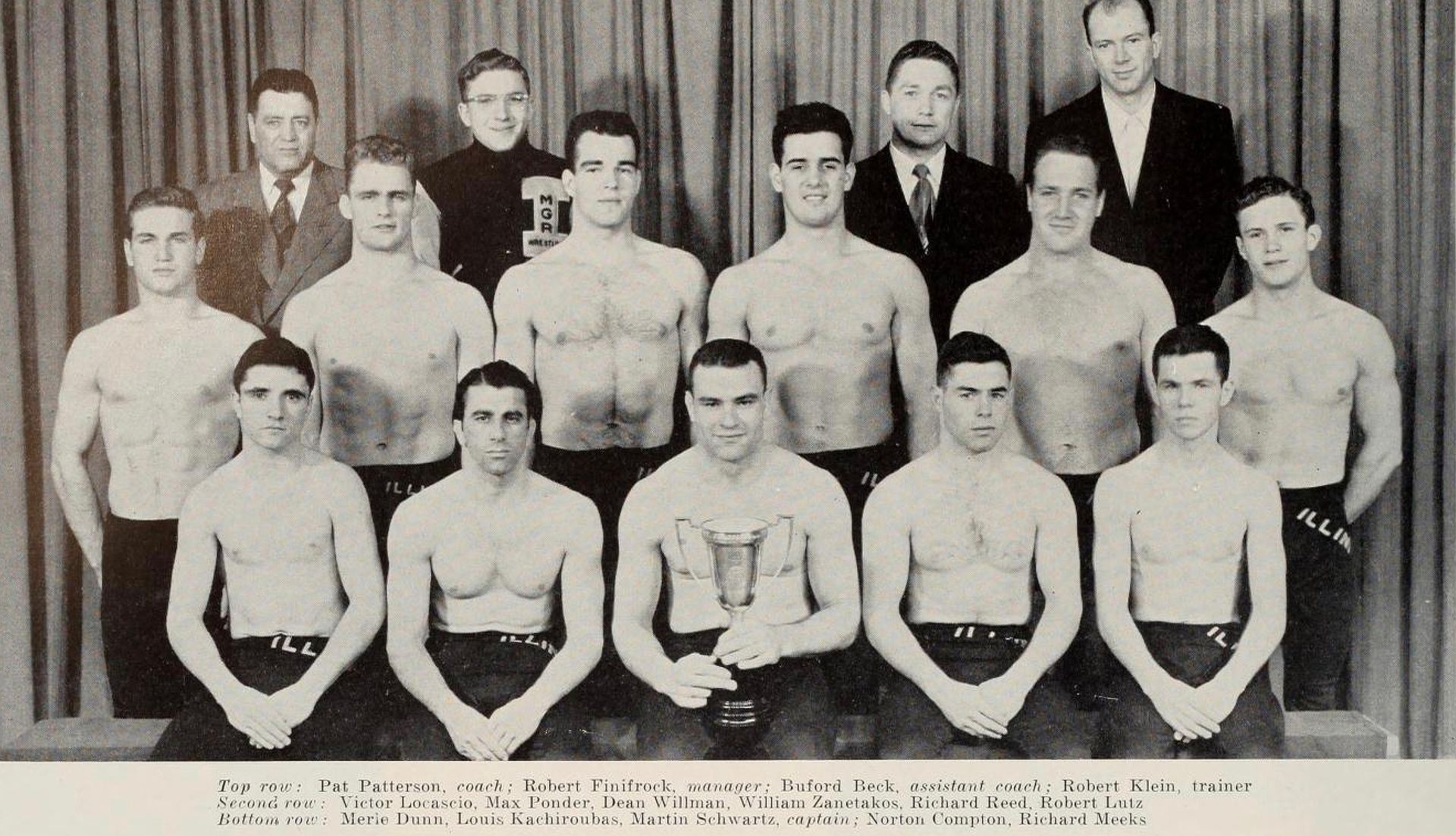
Championship Saturday - 1952
Mar. 8, 2024
Seventy-two years ago today—March 8, 1952—four University of Illinois teams ended their seasons winning Big Ten championships.
In Champaign, Coach Leon Johnson’s Illini track and field team stormed from behind to win the last four individual events and retain its second consecutive Big Ten indoor title. A sellout crowd of nearly 5,000 at the Armory watched freshman Ron Mitchell high jump 6-7 ¼ to break Dike Eddleman’s 1947 record.
Sophomore Henry Cryer won the half-mile race in a conference record time of 1:52.9. Other Illini titlists included Joe McNulty in the high hurdles, Dick Coleman in the pole vault and Willie Williams in the low hurdles. Illinois scored 59.6 points, edging Michigan with 52.
In Ann Arbor, the Illinois wrestling team topped host Michigan, 28-21. Coach B.R. Patterson’s Illini won their first title since 1947. Illinois wouldn’t win another wrestling team championship until 2005. The only Illini titleist was 137-pounder Norton “Pete” Compton.
At Bloomington, Ind., Coach Charlie Pond’s Illini men’s gymnastics team topped Michigan State, 94 ½ to 85 ½, to claim their third straight conference title. Illinois individual champions included tumbling and all-around winner Bob Sullivan, and side-horseman Frank Bare.
And, on the basketball court, Illinois lost at Wisconsin, 58-48, but still captured the Big Ten championship. Led by Johnny “Red” Kerr, the Illini finished with a 12-2 record.
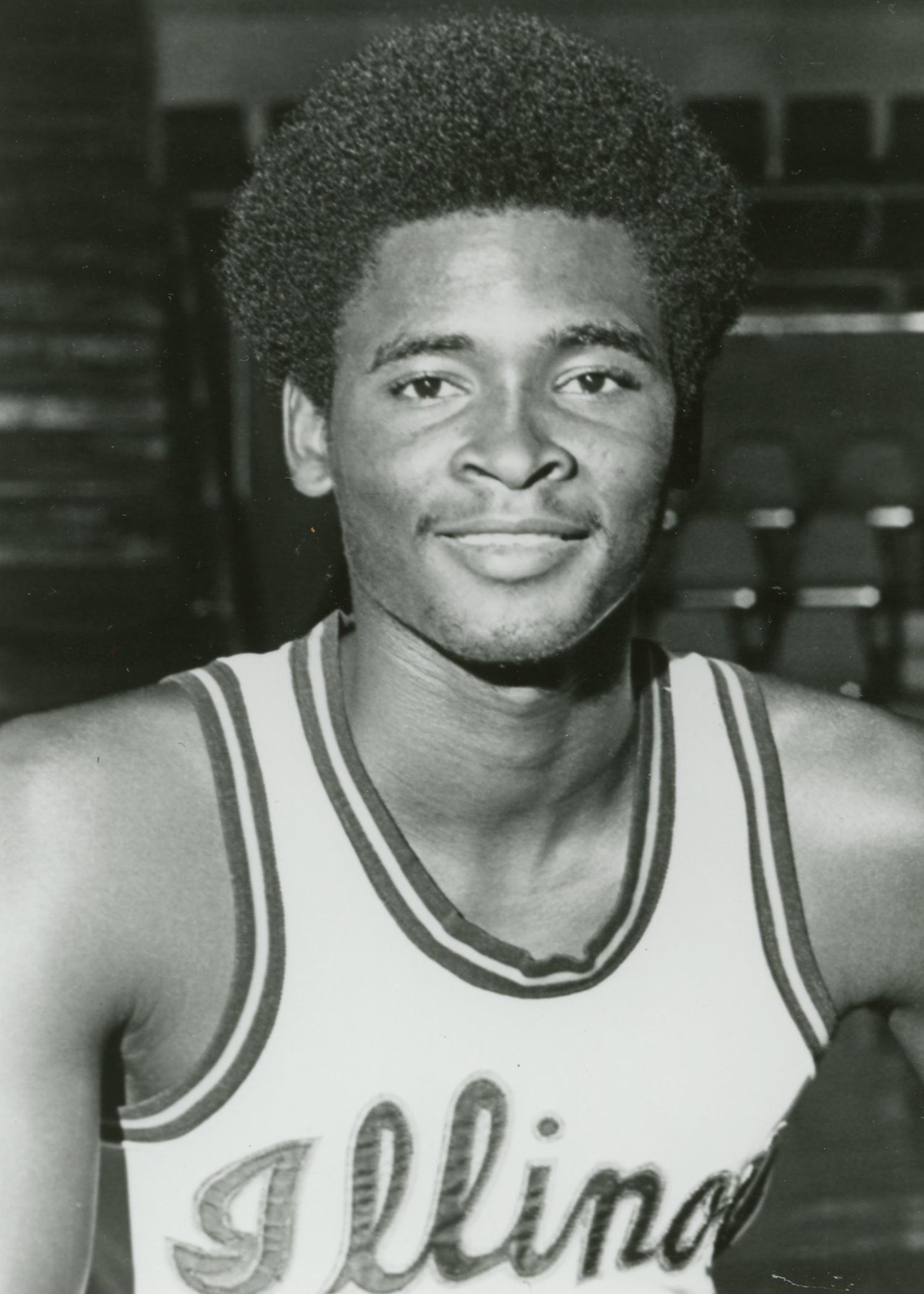
Audie Matthews
Mar. 6, 2024
Forty-six years ago today – Mar. 6, 1978 – University of Illinois basketball teammates honored senior Audie Matthews by choosing him as their Most Valuable Player for the second consecutive season.
That moment at the Fighting Illini basketball banquet climaxed what many 1970s recruiting experts figured would never happen in the first place: an African American star committing to play for an Illini roster that at the time was all white.
Matthews, who starred at Bloom High School and who had earned Parade Magazine first-team All-America honors alongside Moses Malone, Phil Ford and others, was being courted by more than a half dozen basketball powers, including UCLA. He ultimately pledged allegiance to new Illini coach Gene Bartow and assistant Tony Yates on May 14, 1974.
As a freshman, the 6-5 guard/forward struggled mightily, averaging just 3.8 points per game, well below the nearly 27 per game he posted a year before as a prep. Matthews was considerably more productive in his sophomore campaign, posting averages of 11.3 points and 5.3 rebounds. A factor in that improvement in 1975-76 was Lou Henson becoming his new head coach.
In Matthews’ third campaign, he took his game to a higher level. Despite averaging only 13 field goal attempts per game, the junior captain led the Illini in scoring (16.0 ppg). Matthews reached double figures in all but two of the 30 games he played, including five contests of 20 points or more. As a result, he was named his team’s MVP.
Matthews’ statistical numbers dipped a bit as a senior in 1977-78, primarily because of the more talented cast that surrounded him. Joining Audie in the scoring attack were Mark Smith, Eddie Johnson, Rich Adams, Neil Bresnahan, Levi Cobb, Rob Judson and Reno Gray. Starting all 27 games and averaging 12.1 points per game, Matthews was voted the squad’s best player for a second consecutive season.
He wound up his Illini career as the school’s No. 7 career scorer with 1,210 points. Only Nick Weatherspoon (1,481), Dave Scholz (1,459), Don Freeman (1,449), Dave Downey (1,360), John Kerr (1,299) and Rich Adams (1,223) tallied more. Matthews also wound up 12th on UI’s all-time rebounding list.
A sixth-round pick of the Detroit Pistons in the 1978 NBA Draft, he chose instead to play in Australia, first for Brisbane, then for Sydney. The 1980 Illinois Basketball Coaches Association Hall of Fame inductee has settled in Queensland, Australia where he is a businessman and operates basketball clinics.
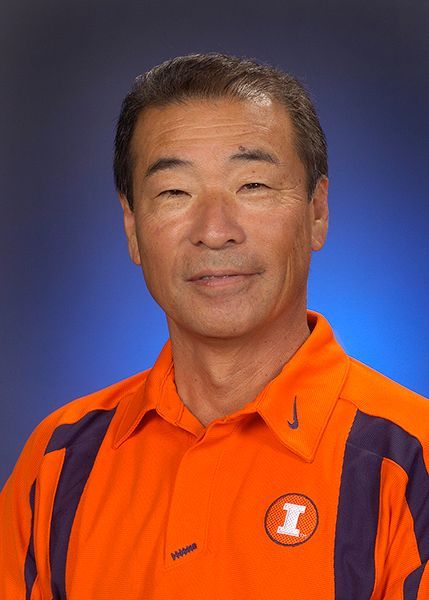
Yoshi Hayasaki
Mar. 4, 2024
Happy 77th Birthday to longtime Fighting Illini gymnastics coach and USA Gymnastics Hall of Famer Yoshi Hayasaki.
Born in Osaka, Japan, in 1947, he journeyed to America in 1965. The experiences he endured were captured by his daughter, Erika Hayasaki, in a 2015 story she wrote for Zócalo Public Square. The former News-Gazette intern, now Associate Professor of Literary Journalism at the University of California, Irvine, titled her feature “Somersaulting Into America.”
Seventeen-year-old Yoshi was invited to America in a letter from University of Washington professor and head gymnastics coach Eric Hughes. While on sabbatical in Japan, Hughes had scouted talent and spotted the 5-foot-3 Osaka city champion. If Yoshi could earn admittance to UW, the letter stated, he would be guaranteed a scholarship and could compete on the Huskies team.
Hayasaki’s parents, Miyo and Shoichi, knew little about the United States except for the bombs it had rained on their city during World War II, reducing their home to ashes.
“Still,” wrote Erika, “the thought of America electrified my dad.”
Said Yoshi, “I saw my future. It was like a blueprint.”
The Hayasaki family couldn’t afford to send their son to his new world on an airplane, so they instead sought out a cargo ship.
“On July 30, 1965,” Erika wrote, “shortly after graduating from high school, her father boarded the S.S. Idaho, which was transporting logs from Yokohama to Longview Washington. The trip cost $300.”
Yoshi’s sleeping quarters were in the bowels of the ship, just inches from where the waves of the Pacific Ocean slammed incessantly. He was seasick for most of the 12-day voyage.
Upon reaching the U.S. mainland, Yoshi enrolled as a foreign exchange student at a high school in Issaquah, Washington, to learn English and prepare for his college acceptance tests. At night, he stood in front of a mirror, practicing English words. It took three tries to pass the exam, but he finally was able to enroll at Washington.
Despite suffering an Achilles injury early on in his collegiate career, Hayasaki’s perseverance eventually paid dividends, winning NCAA all-around titles in both 1970 and ’71.
A second Achilles tear ultimately ended his career as an athlete, so he now had the difficult decision about whether to return to his roots in Japan. Hayasaki’s future came into focus in 1973 when University of Illinois athletic director Cecil Coleman offered him the opportunity to become head coach of the Illini.
It proved to be a wise choice. Recruiting internationally, Hayasaki’s program began its upward surge. In 1981, bolstered by Brazilians Gilberto Albuquerque and Gilmarico Sanches, and Finland’s Kari Samstein, the Illini won their first Big Ten title in 21 years. Eight years later, Hayasaki’s Illini captured the NCAA crown.
He retired from the U of I in 2009 and today teaches the sport at his private gym in Champaign, the Hayasaki Gymnastics Center.

'87 Illini upset Indiana
Mar. 1, 2024
Thirty-seven years ago today—March 1, 1987—a record 16,793 fans, all waving orange pom-pons, said goodbye to three Fighting Illini seniors and helped repel the nation’s third-ranked team.
ABC-TV, with Keith Jackson and Dick Vitale at the microphones, was in town for the Sunday afternoon clash between Coach Bob Knight’s league-leading and third-ranked Indiana Hoosiers and Lou Henson’s No. 14 Illini.
The Hoosier lineup was centered around eventual Big Ten Player of the Year Steve Alford. His supporting class included senior classmate Daryl Thomas, juniors Dean Garrett and Keith Smart, and sophomore Ricky Calloway.
Henson countered Alford with a star of his own in senior all-conference first-teamer Ken Norman. Seven-foot sophomore Jens Kujawa, seniors Tony Wysinger and Doug Altenberger, and freshman Stephen Bardo rounded out Illinois’s starting five.
The Illini had begun the Big Ten portion of their 1986-87 campaign with four consecutive wins, but it was five especially demoralizing losses in recent weeks that had placed extraordinary stress on Henson and his coaching staff. Particularly painful were a pair of massive come-from-behind overtime defeats at the hands of Gene Keady’s fifth-ranked Purdue Boilermakers and a third OT loss to Tom Davis’s No. 2 Iowa Hawkeyes. Those three losses came by a total of five points.
“Are you a bad coach when you lose to basketball teams ranked in the top six?” Henson asked the media at his weekly press conference.
Now came the visiting Hoosiers into Champaign-Urbana. Many Illini fans expected the worse, but their hometown favorites gave them plenty to holler about during the game’s first twenty-three minutes. Norman was Illinois’s hero in the early portion of the contest, scoring nineteen points during a 31-14 streak that turned a 26-19 deficit into a 50-40 advantage.
Predictably, Indiana rallied, leveling the score at 57-all with just seven-and-a-half minutes remaining. A “here we go again” air of despair set in with the Assembly Hall attendees, but those fears would soon turn into cheers.
As the game came down the stretch, Norman successfully stroked a 15-footer. Altenberger followed by hitting the target with a pair of three-point missiles and Kujawa converted a hook shot and two free throws to put the Illini on top, 69-65 with 1:47 remaining. IU’s Smart then slammed home an alley-oop pass from Alford to cut the lead in half.
When the Hoosiers rebounded Tony Wysinger’s off-target 16-footer, Knight called time out with :39 left to set up their final play. However, instead of going inside to the 6-foot-10-inch Garrett to tie the score, Knight daringly strategized a winning three-point shot for Alford. IU’s star successfully dribbled by Altenberger, but the 6-8 Norman alertly switched to guard Alford on his desperate heave beyond the arc. When the shot caromed off the rim, Bardo grabbed the rebound with :04 seconds left to ultimately secure the Illini’s 69-67 victory.
Said Henson afterwards, “Our seniors deserve most of the credit, but let’s not forget Kujawa’s four big points and the all-around play of Bardo.”
Illinois would go on to win in regular-season finales at Michigan and at Michigan State, but lost a one-point decision in its opening -round NCAA Tournament game against Austin Peay.
Indiana, on the other hand, wouldn’t lose again. Following its home-court victory six days later over Ohio State to clinch a share of the Big Ten title, Knight’s Hoosiers rattled off six consecutive wins in the Big Dance, including a 74-73 victory over Syracuse in the championship game in New Orleans.
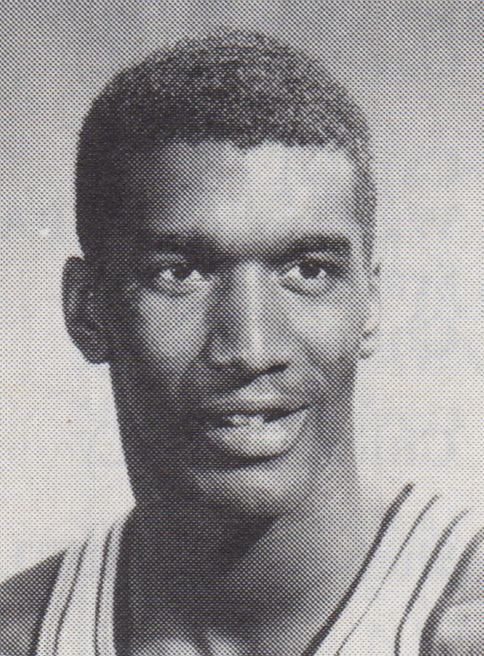
Rich Jones
Feb. 28, 2024
Fifty-eight years ago today—Feb. 28, 1966—behind a magnificent 30 points and 20 rebounds performance from Rich Jones, the Fighting Illini defeated Purdue, 98-81. The victory lifted Illinois’ record to 7-5, just two games behind league-leading Michigan.
Said UI coach Harry Combes about his talented second-year player, “Rich improved more his sophomore year than any Illinois player in history. If he takes up where he left off, he has a brilliant future ahead.”
Unfortunately, there would be only five more Illini games in Jones’ future. On Dec. 22, 1966, UI representatives met with Big Ten and NCAA officials in Chicago regarding irregularities in the athletic department’s financial aid program.
The very next day, the Conference suspended a dozen Illini football and basketball players, one of whom was Rich Jones. An investigation showed that Jones had received payments of $35 per month from a local businessman/booster.
Facing a two-year suspension, he transferred to his hometown to play for Memphis State. Jones sat out the balance of the 1966-67 season, then led the Tigers in scoring in ’67-68 and ’68-69.
Jones’ professional career began in 1969 with the Dallas/Texas Chaparrals, but he played only two games. The 6-6 shooting forward’s career flourished in Dallas from 1970-71 through ’72-73, averaging 16 points and eight rebounds. Jones played three more seasons in the ABA, two for San Antonio and one for the New York Nets. He continued to average 16 points per game from 1973-74 through ‘75-76. Jones spent his final season, 1976-77, in the NBA with the Nets after the two leagues merged.
Last December, he turned 77 years old.
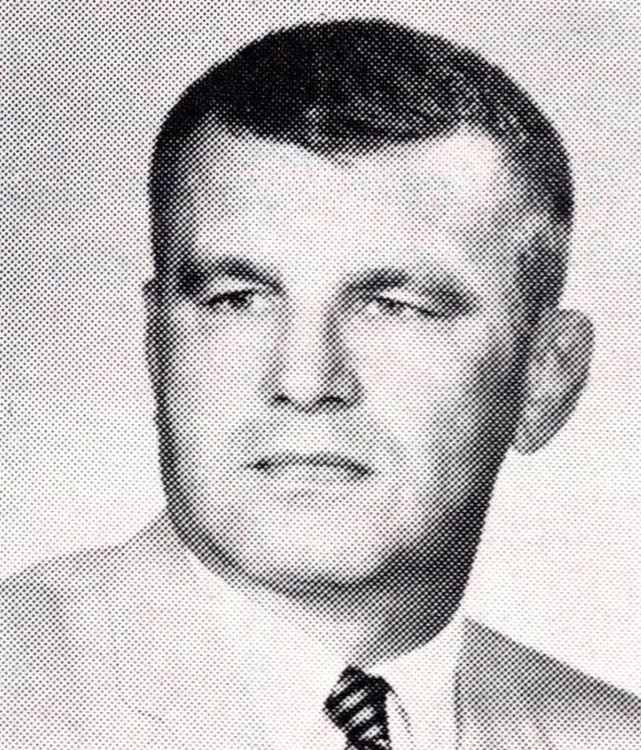
Jack Robinson
Feb. 26, 2024
He was a war hero, a University of Illinois athlete and graduate, a professional wrestler, a two-sport Fighting Illini coach, and a high school Hall of Fame honoree. Born 100 years ago today was former Fighting Illini head wrestling coach and assistant football coach Jack Robinson.
A prep star at Thornton Township High School in Harvey, Robinson was named to his posts in May of 1968 by then Illini director Gene Vance. Though Illinois’ wrestling program never achieved the success he had hoped for (overall dual meet record of 27-50-1), Robinson produced a number of successful athletes, including John Fregeau, Bruce Kirkpatrick, Randy Chirico, Darrell Robinson, Randy Sulaver, Mike Levanti and Andy Passaglia.
At the age of 19, Robinson enlisted in the U.S. Army’s Pathfinder School and asked to be assigned to World War II’s front line. He was sent to the Pacific and was one of the first 32 paratroopers to land in the retaking of the Philippines. Robinson also served in New Guinea and was with the first troops into Tokyo after the atom bomb was dropped.
After the war ended, he enrolled at the University of Illinois. Robinson graduated in 1950 as a physical education major and was a member of both UI’s wrestling and football squads. Immediately upon graduation, he joined Thornton Township’s faculty and coaching staff. His Wildcat wrestlers won four state championships, with more than 20 individual champions and 60 place winners. As a sideline job in the early ‘50s, Robinson was an undefeated pro wrestler who performed under the moniker “Little Samson.”
In 1960, Robinson became head football and wrestling coach at the newly opened Thornridge High school. His 1966 Falcons were undefeated and voted the mythical state champs.
Following his five years at the U of I, Robinson became defensive coordinator at Utah State, but returned to Thornridge in 1975 as athletic director. He came back to coaching in 1981 at Utah’s SkyView High School, then rejoined Utah State’s coaching staff under Chis Pella. Robinson returned to Utah’s high school ranks in 1986, leading Mountain Crest to the 3A championship, earning Coach of the Year honors. After retiring in 1987, he continued as a consultant for a short time.
In 1979, Robinson was inducted into the Illinois Wrestling Coaches and Officials Association Hall of Fame and in 2011was honored by the IWCOA with a Lifetime Achievement Award.
Robinson died at the age of 87 in June of 2011 in Saint George, Utah.
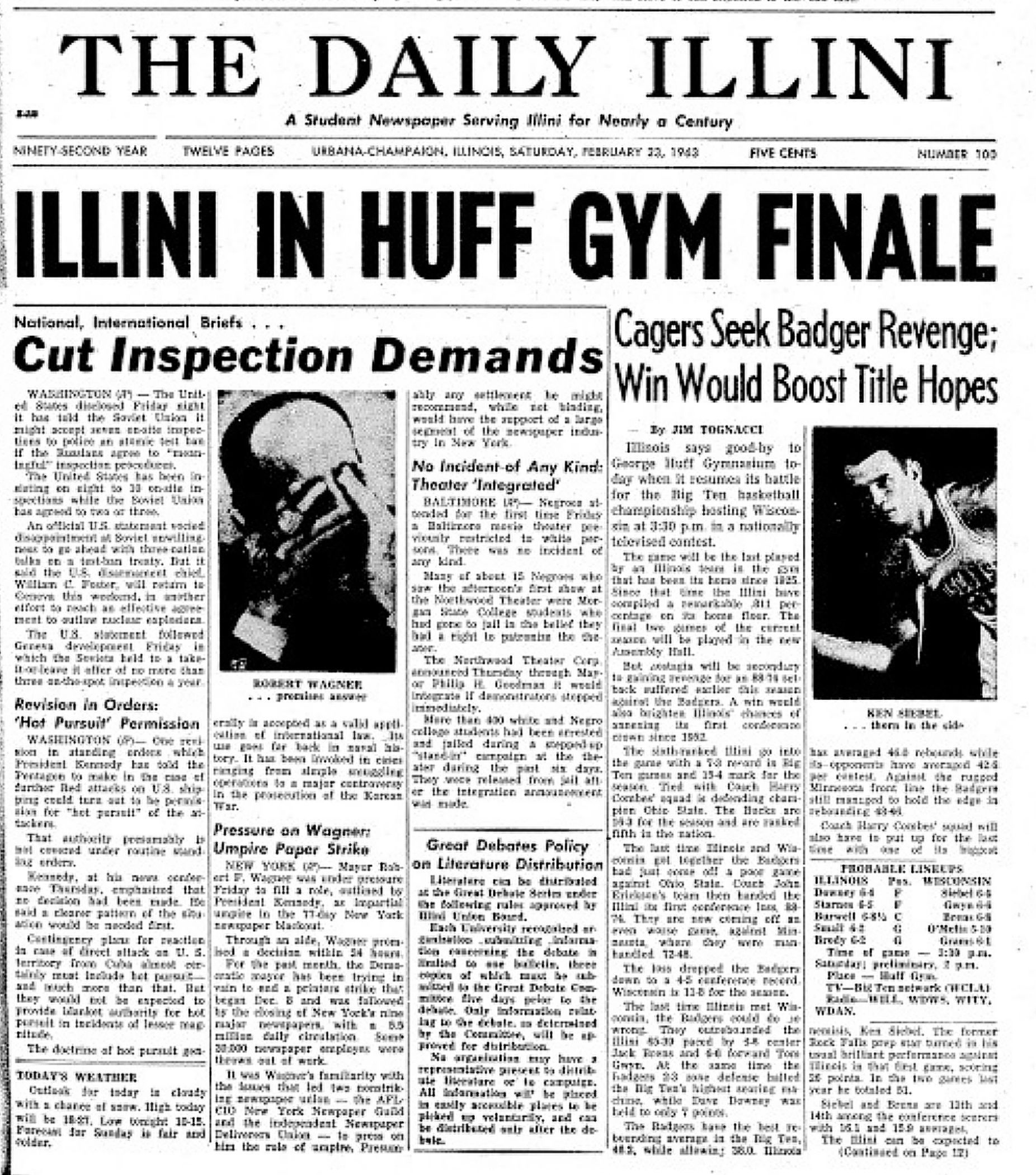
The Final Game at Huff Gym
Feb. 23, 2024
Sixty-one years ago today, in front of a capacity crowd on a Saturday afternoon, the sixth-ranked and Big Ten-leading Fighting Illini men’s basketball team played its 417th and final game at venerable Huff Gym.
Coach John Erickson’s Badgers, led by 6-4 forward Ken Siebel, scorched the nets at a .741 clip from the field in the first half to take a 44-41 lead over Illinois. The second half was a completely different story with the Illini outscoring Wisconsin, 48-33, en route to an 89-77 victory. Four of the five Illinois starters scored 17 points or more, led by Dave Downey’s 22 points and Bill Burwell’s 21.
Eagle-eye marksmanship by the Illini from the free throw line—a Big Ten-record 19-of-20 performance—was another defining factor. Bill Small’s free throw with 24 seconds left was the final point scored at Huff by the Illini men.
Illinois’s final game of the 1962-63 season occurred nine days later when it played at the Assembly Hall for the very first time. More than twice as many fans (16,137) were able to see the Big Ten co-champions at the Hall than the 6,912 who were in attendance at the Huff finale.
Illinois men’s basketball all-time records, decade-by-decade, at Huff Gym:
25-14 (.641) -- 1920s (1925-26 through 1928-29)
75-23 (.765) -- 1930s (1929-30 through 1938-39)
99-15 (.868) -- 1940s (1939-40 through 1948-49)
106-17 (.862) -- 1950s (1949-50 through 1958-59)
34-9 (.791) -- 1960s (1959-60 through 1962-63)
339-78 (.813) -- Total
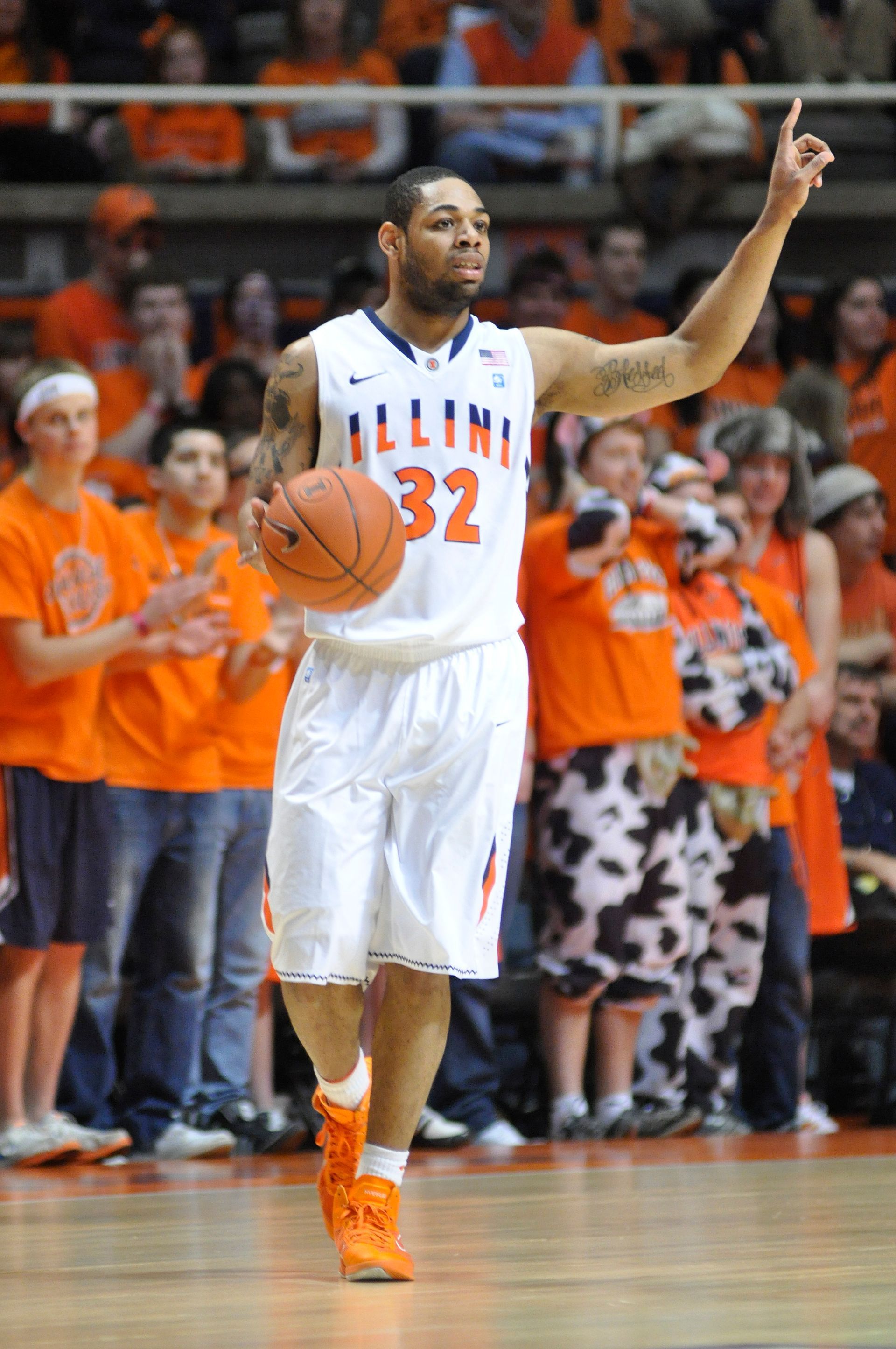
Demetri McCamey: By the Numbers
Feb. 21, 2024
Today, Demetri McCamey, who wore jersey number 32 from 2007-08 through 2010-11 for the Fighting Illini basketball team, celebrates his 35th birthday.
The name of the 6-3 guard from St. Joseph High School is mentioned throughout Illinois’s record book, including first on the lists for career games (139) and single-game assists (16).
McCamey, a first-team All-Big Ten selection by coaches and media as a junior and a third-team all-conference pick as a sophomore and senior, might well be slighted by historians when ranking Illini guards. As evidence, we present McCamey collegiate achievements, by the numbers:
2 – McCamey’s ranking on Illinois’s career assists list. Bruce Douglas compiled 765 assists, just 32 more than McCamey.
4 – Only Eddie Johnson (1,658), Dee Brown (1,512) and Cory Bradford (1,481) attempted more field goals than McCamey (1,404).
6 – McCamey converted all six of the 3-pointers he tried against Purdue on Mar. 14, 2008. He’s tied with Doug Altenberger (6-of-6 vs. Wisconsin on Feb. 7, 1987).at the top of UI’s list in that single-game category.
16 – On Feb. 20, 2010, at Purdue , he handed out an all-time Illini single-game record 16 assists.
22 – Number of times McCamey scored 20 points or more. Four other times he scored 19 points and seven other times he scored 18 points.
31 – In his 24th career game as an Illini freshman—against Indiana on Feb. 7, 2008—he scored what would prove to be the most points he’d score at Illinois.
87 – In the all-time record 139 Illini games he played, McCamey scored in double figures 87 times.
138 – His 138 career steals fell just outside of UI’s individual career top ten.
236 – McCamey’s 236 career 3-point field goals are more than Trent Frazier (230, through last the Feb. 12 game at Nebraska) Rich McBride (216), Brandon Paul (211) and Luther Head (209).
254 – In Illini history, only Deron Williams (264 in 2004-05) had more single-season assists than McCamey did as a junior in 2009-10 (254).
.583 – Illinois basketball’s winning percentage during McCamey’s four-year collegiate career. The Illini had a .625 winning percentage in McCamey’s final three seasons.
.798 – During his Illini career, McCamey was on the floor nearly 80 per cent of the time (4,374 of a possible 5,480 minutes).
1,718 – McCamey ranks seventh among UI’s career scoring leaders with 1,718 points.
4,374 – Only Dee Brown (4,698) logged more career minutes played than McCamey’s 4,374. Demetri fouled out only twice.
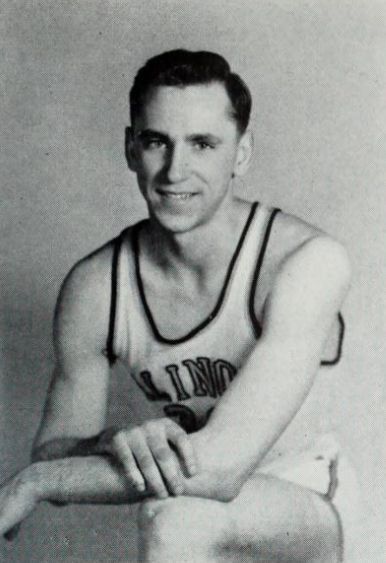
Howie Judson
Feb. 16, 2024
Today marks the 98th anniversary of the birth of former Fighting Illini baseball and basketball star Howard “Howie” Judson.
In basketball, the Hebron High School standout used his one-hand shot to win a berth on the state of Illinois’s prestigious all-state all-star squad. Joining Judson on that unit were future Illini teammates Dick Foley (Paris), Roy Gatewood (Salem), Bob Morton (Elgin), Jim Seyler (Centralia) and Gordon Gillespie (Kelvyn Park).
Coach Doug Mills’ back-to-back Big Ten champs had lost the “Whiz Kids” to service in World War II, so he needed to restock his lineup.
“My dad got a telephone call to find out if I could come down there and play basketball,” Judson said. “I told him I’d be there as soon as I could. So I got there and looked up Doug Mills and said ‘Here I am!’”
Freshmen Judson, Morton and Gillespie advanced directly to Illinois’s starting lineup for the 1943-44 campaign. That season, in game five against Coach Adolph Rupp’s powerful Kentucky squad, Judson scored 16 of Illinois’s 43 points in a two-point victory over the eventual 19-2 Wildcats.
“Oh, yes, that was one I’ll never forget,” Judson said. “Rupp told Mills after the game, ‘My God, where’d you get that kid?!?’”
The following season, he averaged 8.5 points per game, slightly better than his 8.0 average in ’43-44.
Though he admitted that basketball was his favorite sport, Judson’s strong suit athletically was as a baseball pitcher. In 11 career Big Ten Conference games on the mound, he struck out 97 hitters in 98 innings. The 6-1 righthander posted a 5-3 record in league contests.
Following Judson’s sophomore season at Illinois in 1945, he pitched in various summer leagues, most notably for the Sycamore Sons. That August, he was drafted into service with the U.S. Navy. Judson was honorably discharged three months after World War II ended.
In the spring of 1946, Major League Baseball scouts were closely watching Judson’s progress, including Chicago White Sox manager Ted Lyons. Despite being limited to only partial vision because an infection in his left eye, the twenty-year-old Judson was signed by the Sox and pitched for Waterloo. He finished with 16 wins and a 2.58 earned run average.
Judson made his big-league debut for the White Sox on April 22, 1948 against the Detroit Tigers and a lineup that included George Kell and Hoot Evers. He suffered the loss after giving up four hits and three runs in seven innings. He got his first pitching victory against Lou Boudreau’s eventual World Series champion Cleveland Indians on May 16 that year. Judson finished the season with a 4-5 record and a 4.78 ERA.
In 1949, despite lowering his ERA to 4.58, Judson lost 14 of his 15 decisions.
His ERA dropped below 4.00 in 1950 (3.94) and he emerged as a dependable reliever. His 46 mound appearances tied for third in the America League. Records of 5-6 (1951) and 0-1 (1952) followed for Judson with the White Sox, then he was traded to the Cincinnati Reds.
Judson appeared in only ten games for the Reds in 1953 (0-1 record) but got significantly more action the following season. In 37 appearances in 1954, he posted a 3.95 ERA in slightly fewer than 100 innings.
A back injury caused Judson to return the minors, and he wouldn’t again pitch in the big leagues. Ultimately, he hung up his spikes at the age of 33. His final statistics as a Major League pitcher saw him log 615 total innings, post a lifetime record of 17-37, and a respectable 4.29 ERA.
Judson and his wife, Martha, were married for 52 years before her death in 2007.
The former Hebron star is ten years older than two younger brothers—Paul and Phil Judson—who also lettered at Illinois, and is nearly thirty-two years senior to his nephew, Rob, a four-time Illini basketball letter winner. Howie’s great niece, Kristin Judson (Rob’s daughter), played basketball at Miami University.
A longtime resident of Winter Haven, Fla., he died on Aug. 18, 2020.
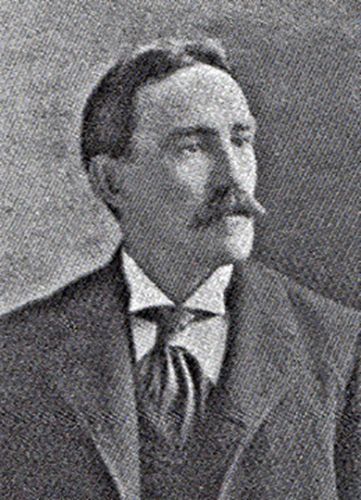
Jacob Kinzer Shell
Feb. 14, 2024
Dr. Jacob Kinzer Shell, a man instrumental in the founding of the Amateur Athletic Union (AAU) and the University of Illinois’s fourth athletic director, was born on this date in 1862 in Harrisburg, Pa.
After attending Central High School in Philadelphia., Shell became a talented football player at the University of Pennsylvania, lettering four times in the late 1870s and early ‘80s. He graduated with a degree in medicine and dentistry.
Shell was a multi-sport athlete, competing in track and field, baseball, lacrosse, golf, cricket, wrestling and boxing. He held national championships as a middleweight in the latter two sports in 1888 and ’89.
It was as a result of a boxing bout in which Shell’s opponent was given the title in an unfair decision that the AAU was formed in 1888, standing for pure amateurism against the questionable tactics of the National Athletic Association of America, then in full control of amateur athletics in the United States. For 34 years, Shell served as an official handicapper of the AAU’s Middle Athletic Association.
He initially held coaching and teaching positions at the University of Vermont, Shortlidge Academy in Concordville, Pa., and Swarthmore College. Shell coached Swarthmore’s football team from 1888-1898, compiling an overall record of 58-40-4.
On Sept. 23, 1898, Shell was hired by the U of I, being appointed director of the men’s gymnasium and professor of physical training/athletics director. In December of 1899, supervised by Shell, UI’s Athletic Association adopted a new constitution. That same month the Intercollegiate Athletic Conference, eventually known as the Big Ten, invited Indiana and Iowa to become members.
With Shell as director and George Huff as the coach, Illinois’s baseball team won its first conference championship on June 5, 1900. Just four days later, the University’s men’s gym caught fire and the Athletic Association lost a then staggering $7,000 worth of property. Among the items lost were most of the UI’s all-time championship banner and trophies.
Shell resigned his position at Illinois on May 29, 1901, to became athletics director at his alma mater. He remained in that position at the University of Pennsylvania until 1905. It is said that Shell had the record of never having missed one of the annual UP relay meets during his lifetime.
He and his wife, Emma were married for 56 years and had five children. Shell died at the age of 78 on Dec. 10, 1940, in Philadelphia.
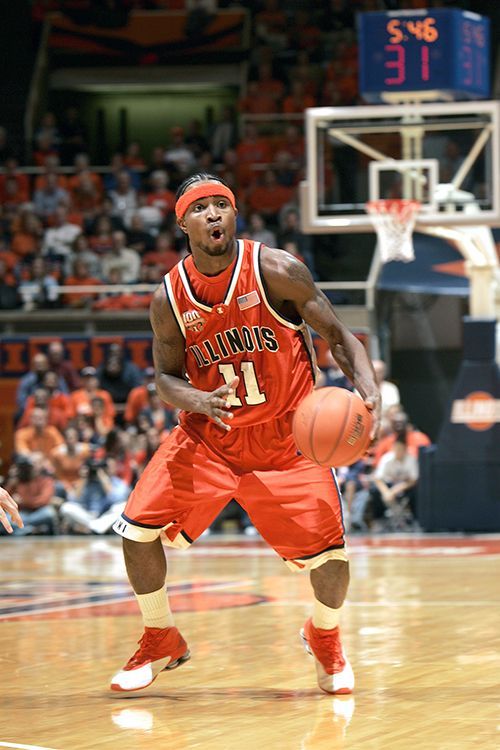
Jersey No. 11
Feb. 12, 2024
Nineteen years ago today, Dee Brown hit two long three-point field goals to seal top-ranked Illinois’ 70-59 victory at the Assembly Hall over No. 20 Wisconsin.
Dee Brown's 1,812 career points currently rank fourth on UI’s all-time list.
Others who have worn jersey No. 11 include:
John Orr, 1945
Jack Burmaster, 1947-48
Don Sunderlage, 1950-51
William Ridley, 1954-55-56
Roger Taylor, 1957-58-59
Ben Louis, 1966-67-68
Bob Windmiller, 1969-70
Dave Roberts, 1973-74-75
Tom Schafer, 1983-84
Rennie Clemons, 1991-92-93
Ayo Dosunmu, 2019-21
Alfonso Plummer, 2022
Niccolo Moretti, 2024
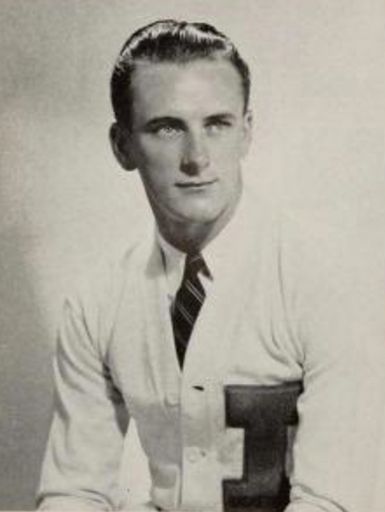
Bill Hapac
Feb. 9, 2024
Eighty-four years ago this week - Feb. 10, 1940 - Illinois defeated Minnesota, 60-31, at Huff Gym as the Illini’s Bill Hapac broke the Big Ten single-game scoring record with 34 points.
Scoring 13 field goals and eight free throws, he eclipsed the previous mark of 30 points by Indiana’s Ernie Andres (1938). Hapac’s record-breaking points came on a 35-foot bank shot. More than 100 of Hapac’s fellow townsmen from Cicero were in the crowd of 5,402.
Players who have since broken the Big Ten men’s basketball scoring record:
Sequence of the Big Ten men’s basketball single-game scoring marks since 1938
30 points Ernie Andres, Indiana, 1938
34 points Bill Hapac, Illinois, 1940
40 points Andy Phillip, Illinois, 1943
48 points Jerry Lucas, Ohio State, 1960
52 points Terry Dischinger, Purdue, 1961
56 points Jimmy Rayl, Indiana, 1962
57 points Dave Schellhase, Purdue, 1966
61 points Rick Mount, Purdue, 1970
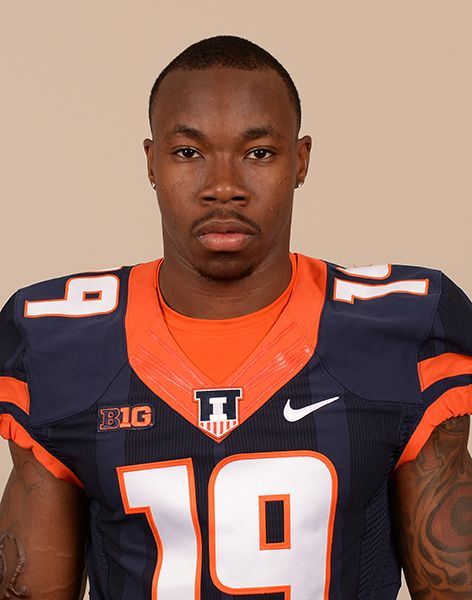
Justin Hardee
Feb. 7, 2024
Celebrating his 30th birthday today is former Fighting Illini football star Justin Hardee. Primarily playing wide receiver throughout his collegiate career at Illinois, Hardee now is a third-year player for the NFL’s New York Jets.
Recruited by Tim Beckman’s staff out of Cleveland’s Glenville High School, Hardee played a total of 49 games for the Illini in 2012, ’13, ’14 and ’16. He had 72 catches for a total of 841 yards, twice recording games of more than 100 receiving yards. Hardee’s most memorable performance came as a senior against Northwestern when he had nine catches for 125 yards. He also stood out in the classroom his final season, winning Academic All-Big Ten honors.
Hardee earned his bachelor’s degree from the University of Illinois in December of 2014, majoring in communications. He later achieved a pair of master’s degrees, one in sports management and one in education.
The NFL’s Houston Texans signed Hardee to a free agent contract in May of 2017, then he caught on with New Orleans’ practice squad in early September of that same year. Sixteen days later, he was promoted to the Saints’ active roster. In week nine of his rookie season, Hardee won NFC Special Teams Player of the Week honors when he blocked a punt and returned it for a touchdown.
Hardee played in all 16 of his team’s games each of the next two seasons, then resigned with New Orleans in March of 2020. A groin injury last November sidelined him for five weeks, but he got back into action in time for New Orleans’ NFL Playoffs run. The Saints beat the Chicago Bears in the Wild Card game, but fell to the Super Bowl bound Tampa Bay Buccaneers in the NFC divisional playoffs.
Hardee put his U of I degrees to work by opening a Papa John’s Pizza franchise on Tulane Avenue in New Orleans’ burgeoning medical district. He also has established a charity organization called the Hardee Cares Foundation. It supports Sarcoidosis awareness, honoring his mother who passed away from the disease.
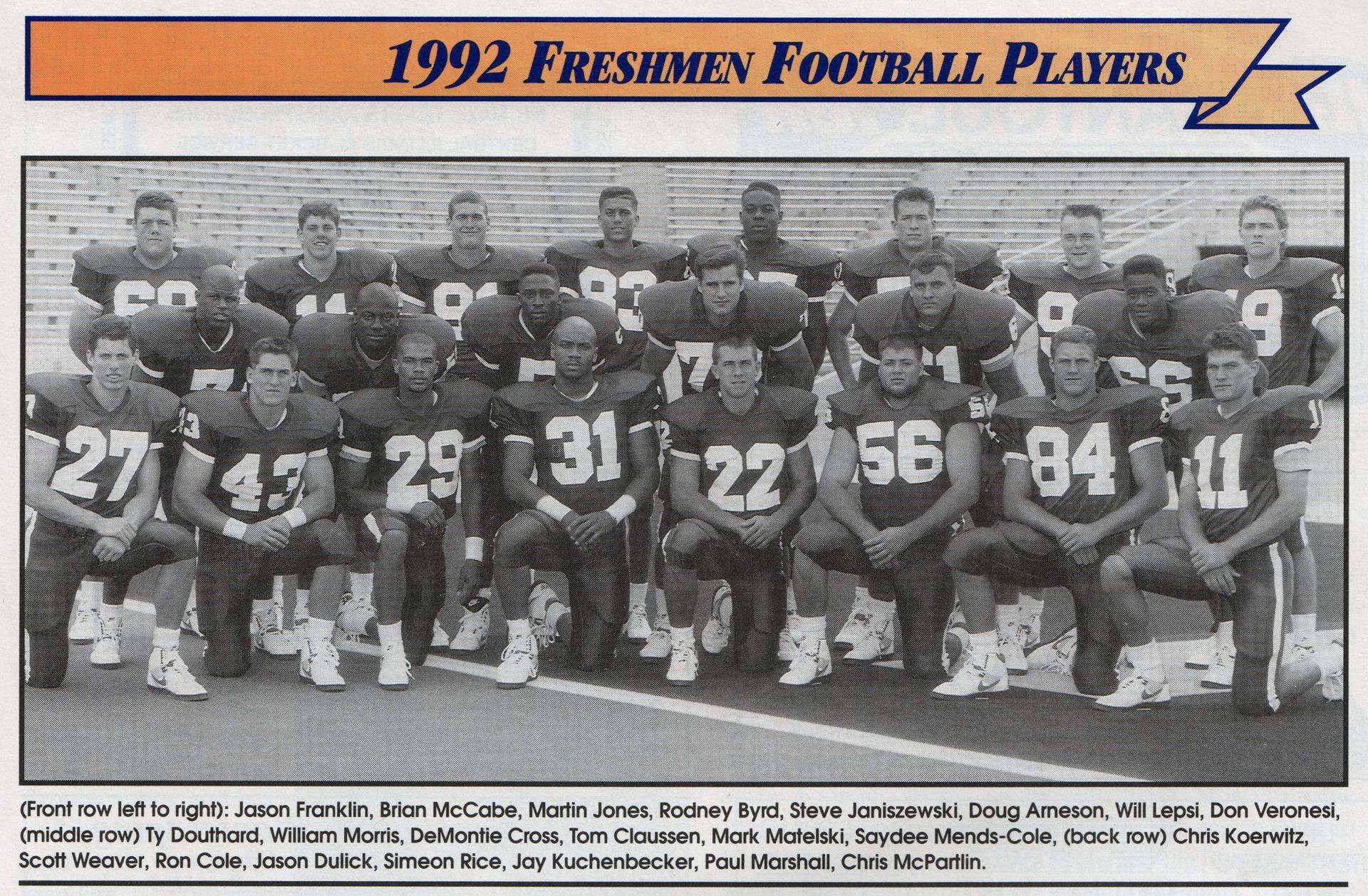
Football's 1992 Freshman Class
Feb. 5, 2024
Thirty-two years ago today—Feb. 5, 1992—new Fighting Illini football coach Lou Tepper celebrated the completion of his first recruiting class, a small but quality-filled 14-man group.
Announced that day by Tepper as one of the top prospects was East St. Louis High School running back Chris Moore, who had just completed a record-breaking senior campaign for the state champion Flyers. Unfortunately, Moore’s shortcomings in the classroom didn’t allow him to come to Champaign-Urbana and he instead attended NAIA member Culver-Stockton. Another Flyer, linebacker Dennis Stallings, also was signed by the Illini.
Besides Moore, two other highly acclaimed running backs who were inked by Tepper’s staff included Cincinnati LaSalle’s Ty Douthard and O’Fallon’s Rodney Byrd. Both Douthard and Byrd would go on to be four-time Illini letter winners.
Beaver Falls, Pa. quarterback Scott Weaver was the only signal caller signed by Tepper that day.
Supposedly, the final player to be offered a scholarship by Tepper that year was a Mount Carmel High School defensive lineman named Simeon Rice. Rice was influenced to join the Illini because former Caravan teammates J.J. Strong, Pete Gabrione and Charles Edwards who were already at Illinois. Rice rapidly moved up the depth chart and eventually became a four-time All-Big Ten performer, a two-time All-American, and the third pick in the 1996 NFL Draft.
Four of the 14 signees—Hazelwood East’s DeMontie Cross, Lyons Township’s Will Lepsi, Paducah, Ky.’s Saydee Mends-Cole, and Chicago Vocational’s William Morris —never lettered for Illinois. Three 1992 freshman walk-ons—Glenbard South’s Tom Claussen and Chris McPartlin, and Mount Carmel’s Don Veronesi—eventually did win monograms for the Illini.
Members of the 1992 freshman class that went on to letter for Tepper included:
Rodney Byrd (1993, ’94, ’95 & ’96) – The fullback from O’Fallon High School became an Illini co-captain in 1996 and wound up his collegiate career by playing in 44 games. Information regarding his whereabouts today is unavailable.
Tom Claussen (1996) – A defensive lineman from Glenbard South, Claussen lettered in his senior season at Illinois, accumulating 17 tackles in 10 games. No information was available as to what he’s doing today.
Ty Douthard (1993, ’94, ’95 & ’96) The former Cincinnati LaSalle running back concluded his Illini career with 1,851 rushing yards and 1,250 receiving yards. Today, he is an associate at World Financial Group in Greater Indianapolis and is a regular attender at Illini games.
Jason Dulick (1993, ’94, ’95 & ’96) A star at St. Louis University High, Dulick racked up big yardage as a wide receiver. In four seasons, he caught 169 passes for 2,004 yards and 15 touchdowns. He wound up his collegiate career as UI’s second-leading career receiver. Dulick is now a teacher and the head football coach at Gateway STEM High School in St. Louis.
Martin Jones (1994 & ’95) After encountering minor criminal charges during his time at Illinois, the former Cincinnati Aiken standout receiver left Illinois after two letter-winning seasons. Today, he is a real estate investor for MJ Investment Group in his hometown.
Chris Koerwitz (1994, ’95 & ’96) The Oshkosh, Wis. native played center for Lou Tepper, lettering three times. A middle school principal in Riverton, his son went on to play college football at SIU.
Jay Kuchenbecker (1995 & ’96) A product of York High School, Kuchenbecker started all 11 games at right guard in 1996. He’s now a real estate broker for Compass in Greater Chicago.
Paul Marshall (1993, ’94, ’95 & ’96) The Naperville North High School standout was a defensive line starter in his final 28 Illini games, totaling 88 tackles as a senior. Marshall now serves as director of sales for Fresenius Medical Care in Greater Phoenix.
Chris McPartlin (1994) A star at Glenbard South, McPartlin lettered in his junior season as a linebacker. Today, he directs Up Campus Student Living in Greater Chicago.
Simeon Rice (1992, ’93, ’94 & ’95) Rice impressed the coaching staff from his very first practice, eventually establishing new Illini records in every category for tackles for loss and quarterback sacks. He went on to a 12-year NFL career with the Arizona Cardinals, Tampa Bay Buccaneers, Denver Broncos and Indianapolis Colts. He’s now on the ballot for the Pro Football Hall of Fame. After football, Rice began a career in the entertainment industry, directing a feature-length film in 2015. He is a member of Illini athletics’ Hall of Fame.
Dennis Stallings (1994, ’95 & ’96) Stallings enrolled at Illinois in 1992 but did not actually play until 1994. He was a sixth-round pick in the 1997 NFL Draft and played three seasons for the Tennessee Oilers. Nowadays, Stallings works for Gastroenterology Care Specialists in Mount Julien, Tenn.
Don Veronesi (1993) A teammate of Simeon Rice at Mount Carmel, he lettered as a defensive back his sophomore season. Today, he owns Veronesi Carpentry Services in Crown Point, Ind.
Scott Weaver (1993, ’94, ’95 & ’96) Hailing from Joe Namath’s hometown in Beaver Falls, Pa., Weaver was an effective quarterback for Lou Tepper. In his four Illini seasons, he passed for 3,212 yards and 15 touchdowns. He’s now territory manager at Electrostim Medical Services in Grand Rapids, Mich.

Ray Demmitt
Feb. 2, 2024
Born 140 years ago on this date was University of Illinois baseball player Charles Raymond “Ray” Demmitt.
A native of Illiopolis, Ill., the 5-8, 170-pound outfielder lettered in 1905 and ’06 for coach George Huff. The ’05 Illini finished second in the Big Ten, then took the title the following season with an 8-3 league record.
Demmitt began his Major League Baseball career at the age of 25 in 1909 for the New York Highlanders (who became the Yankees in 1913). In his rookie season, he shared the outfield with Hall of Famer “Wee Willie” Keeler, batting .246 in 123 games. His four home runs in ’09 ranked sixth among American League hitters.
It was in 1909 that he appeared on one of the earliest sets of tobacco baseball cards. In mint condition today, Demmitt’s card now brings a price of more than $4,000.
On Dec. 16, 1909, he was traded to the St. Louis Browns. He only appeared in 10 games in 1910 and wouldn’t appear again on a big league roster for another four years.
In 1914 Demmitt played one game for the Detroit Tigers, then was purchased by the Chicago White Sox for $2,500. He hit .258 for the Sox, including a pair of home runs and 46 runs batted in. Demmitt only appeared in 10 games in 1915, being released early in the year. After a year in the minors, he caught on again with the Browns in 1917 and spent that year and two more in St. Louis. His 61 RBI in 1918 ranked seventh in the A.L.
Career-wise, he played in 498 big league games altogether, averaging .257 through seven seasons. Ray Demmitt died on Feb. 19, 1956 at the age of 72 and is buried in the Mount Pulaski Cemetery.

Luke Guthrie
Jan. 31, 2024
Happy 34th Birthday to former Fighting Illini golf star Luke Guthrie.
The two-time state champion from Quincy High School is one of only 15 men in Big Ten history to win multiple individual conference titles. Besides Guthrie, three other Illini players—Richard Martin, Steve Stricker and Nick Hardy—are included in that exclusive company.
Guthries two Big Ten wins were among seven career collegiate tournaments he captured.
Through 138 career rounds as an Illini golfer, Guthrie averaged just 72.08 strokes per 18 holes. In two of his four years, he averaged less than 72 a round (71.19 as a senior in 2012 and 71.36 as a junior in 2011).
Guthrie’s Illinois squad won the Big Ten team title all four of his letter-winning seasons and finished among the top 21 team in NCAA play each time. UI’s best placing, nationally, during his collegiate stint was when it tied for fifth place in 2011.
Guthrie’s college career was sprinkled with individual honors, including twice earning All-Big Ten first team and twice winning All-America accolades, including first-team laurels as a junior. He was awarded the Big Ten Conference Medal of Honor for proficiency in athletics and academics as a senior.
As a professional, Guthrie has won two tournaments. His victories at the Albertsons Boise Open and the WNB Golf Classic came in back-to-back September 2012 efforts. Guthrie has participated in four major tournaments, including two U.S. Opens (2013 and ’14) and the 2013 PGA Championship and British Open.
Guthrie and his wife, Kaitlyn, have a son and reside in Jacksonville Beach, Fla.
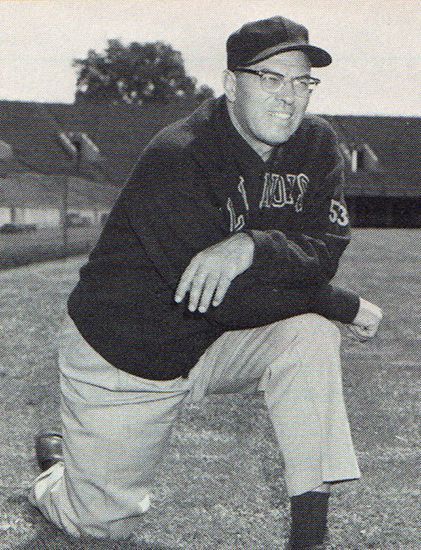
This Day in Illini History
Jan. 29, 2024
Sixty-one years ago today – Jan. 29, 1963 – University of Illinois alumni Red Grange and George Halas were among the 17 players, coaches and officials elected as charter members of the Pro Football Hall of Fame. This prestigious group also included Jim Thorpe, Curly Lambeau, Bronco Nagurski, Dutch Clark, Sammy Baugh and Ernie Nevers.
Other notable events on this date in Illini history:
Jan. 29, 1942: Ray Eliot was announced as Illinois’ new football coach, replacing Bob Zuppke.
Jan. 29, 1949: Illini basketball overcame a 20-7 deficit and beat Minnesota at Huff Gym, 45-44. It was the Gophers’ first loss in 14 games.
Jan. 29, 1979 – Linebacker Dick Butkus was unanimously selected as a Pro Football Hall of Famer. Others inducted that year were Johnny Unitas, Ron Mix and Yale Lary.
Jan. 29, 1981: Illinois defeated Michigan State in East Lansing for the first time in 10 years. Eddie Johnson led the Illini with 19 points.
Jan. 29, 1983: A career-high 29 points by Derek Harper led Illinois past host Michigan. It was Lou Henson’s first coaching victory at Ann Arbor in eight tries.
Jan. 29, 2003: Thirteenth-ranked Illinois beat visiting Michigan, 67-60, as Brian Cook scored 26 of his 30 points in the second half.
Jan. 29, 2005: Playing before more than 300 former players, coaches and administrators who were reuniting to celebrate the centennial season of Illinois basketball, the Illini defeated Minnesota by 23. Illinois improved its record to a perfect 21-0.
Jan. 29, 2009: No. 19 Illinois saw its 20-game winning streak against Minnesota come to an end, losing 59-36 at Williams Arena. It was the Gophers’ first triumph over the Illini since Feb. 3, 1999.
Jan. 29, 2014: Former Illini star Mannie Jackson presented a $3 million gift to the University of Illinois in support of a Basketball Hall of Fame in his name.
Jan. 29, 2021: No. 19 Illinois upset No. 7 Iowa at the State Farm Center, 80-75, in a game that featured 22 lead changes. Ayo Dosunmu (25 points) and Trent Frazier (24) paced the Illini.
Jan. 29, 2022: Da’Monte Williams’ follow-up dunk with 1:34 left put Illinois ahead of host Northwestern in a 59-56 Illini victory at Evanston.
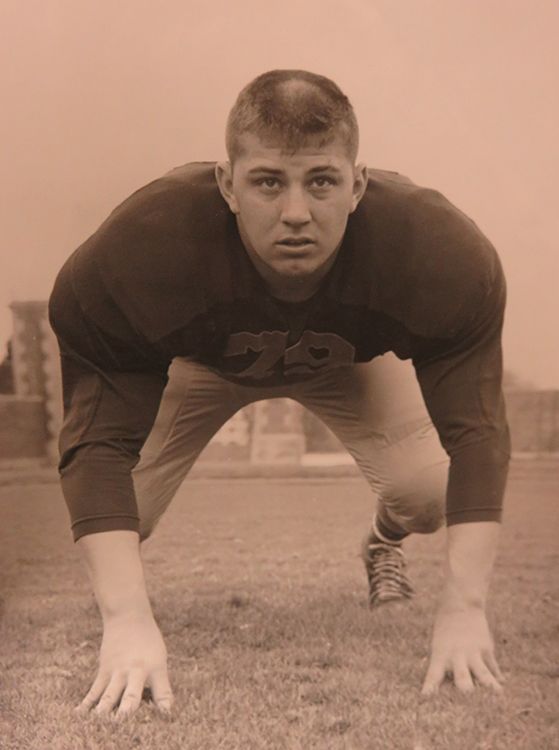
Joe Rutgens
Jan. 26, 2024
Today (Sunday) marks the 85th birthday of Joe Rutgens, one of the University of Illinois’ least publicized football stars.
Recruited by Ray Eliot in 1956 out of LaSalle-Peru High School, Rutgens was an outstanding 6-2, 245-pound tackle. He earned first-team All-Big Ten honors as both a junior (1959) and senior (1960) at Illinois.
Rutgens was a first-round pick in both the 1961 NFL and AFL Drafts, chosen third by the Washington Redskins and fourth by the Oakland Raiders. He chose to sign with Coach Bill McPeak’s Redskins, wearing jersey number 72 for nine seasons (1961-69).
Rutgens was chosen for the 1963 and ’65 Pro Bowls. He played for Coach Vince Lombardi in his final season as a pro.
In 2008, Rutgens was selected as one of the top 10 defensive lineman in Illinois history.
Today, he resides in Spring Valley, Ill. with his wife, Donna.
1961 NFL Draft – First Round
1. Tommy Mason, HB, Tulane Minnesota Vikings
2. Norm Snead, QB, Wake Forest Washington Redskins
3. JOE RUTGENS, T, ILLINOIS WASHINGTON REDSKINS
4. Marlin McKeever, LB, USC L.A. Rams
5. Mike Ditka, E, Pittsburgh Chicago Bears
6. Jimmy Johnson, B, UCLA San Francisco 49ers
7. Tom Matte, HB, Ohio State Baltimore Colts
8. Ken Rice, T, Auburn St. Louis Cardinals
9. Bernie Casey, B, Bowling Green San Francisco 49ers
10. Bobby Crespino, E, Mississippi Cleveland Browns
11. Billy Kilmer, QB, UCLA San Francisco 49ers
12. Herb Adderley, B, Michigan State Green Bay Packers
13. Bob Lilly, T, Texas Christian Dallas Cowboys
14. Art Baker, FB, Syracuse Philadelphia Eagles

Lee Eilbracht
Jan. 24, 2024
Seventy-two years ago today, Lee Eilbract was named acting head coach of the Fighting Illini baseball team, replacing Wally Roettger who had died the previous September.
Eilbracht lettered three years as a player (1943, ’46 and ’47). He had a celebrated career as Illinois’ head coach, compiling 515 victories against 393 losses and six ties in 27 seasons. He had 41 more wins than Itch Jones (474 in 15 years) and 201 more than George Huff (314 in 23 years).
Eilbracht’s Illini teams won four Big Ten titles. Fourteen of his Illinois players eventually went on to play Major League Baseball:
Ethan Blackaby: Milwaukee-NL (1962-64) … Career: .120 average, 0 HR, 1 RBI
Bob Burda: St. Louis (1962 & ’71); San Francisco (1965-66, 1969-70); Milwaukee-AL (1970); Boston (1972) … Career: .224 average, 13 HR, 78 RBI
John Felske: Chicago-NL (1968) and Milwaukee-AL (1972-73) … Career: .135 average, 1 HR, 9 RBI
Tom Fletcher: Detroit (1962) … Career: 1 game
Tom Haller: San Francisco (1961-67); Los Angeles-NL (1968-71); Detroit (1972) … Career: .257 average, 134 HR, 504 RBI
Jim Hicks: Chicago-AL (1964-66); St. Louis (1969); California (1969) … Career: .163 average, 5 HR, 14 RBI
Ken Holtzman: Chicago-NL (1965-71, ’78); Oakland (1972-75); New York-AL (1976-77) … Career: 174-150, 3.49 ERA
Dick Hyde: Washington (1955-60); Baltimore (61) … Career: 17-14, 3.56 ERA
Bobby Klaus: Cincinnati (1964) and NY Mets (1964-65) … Career: .208 average, 6 HR, 29 RBI
Gary Kolb: St. Louis (1960, 62-63); Milwaukee-NL (1964-65); New York-NL (1965); Pittsburgh (1968-69) … Career: .209 average, 6 HR, 29 RBI
Em Lindbeck: Detroit (1960) … Career: 2 games
Herb Plews: Washington (1956-59) and Boston (1959) … Career: .262 average, 4 HR, 82 RBI
Lou Skizas: New York-AL (1956); Kansas City (1956-57); Detroit (1958); Chicago-AL (1959) … Career: .270 average, 30 HR, 86 RBI
Ed Spiezio: St. Louis (1964-68); San Diego (1969-72) and Chicago-AL (1972) … Career: .238 average, 39 HR, 174 RBI
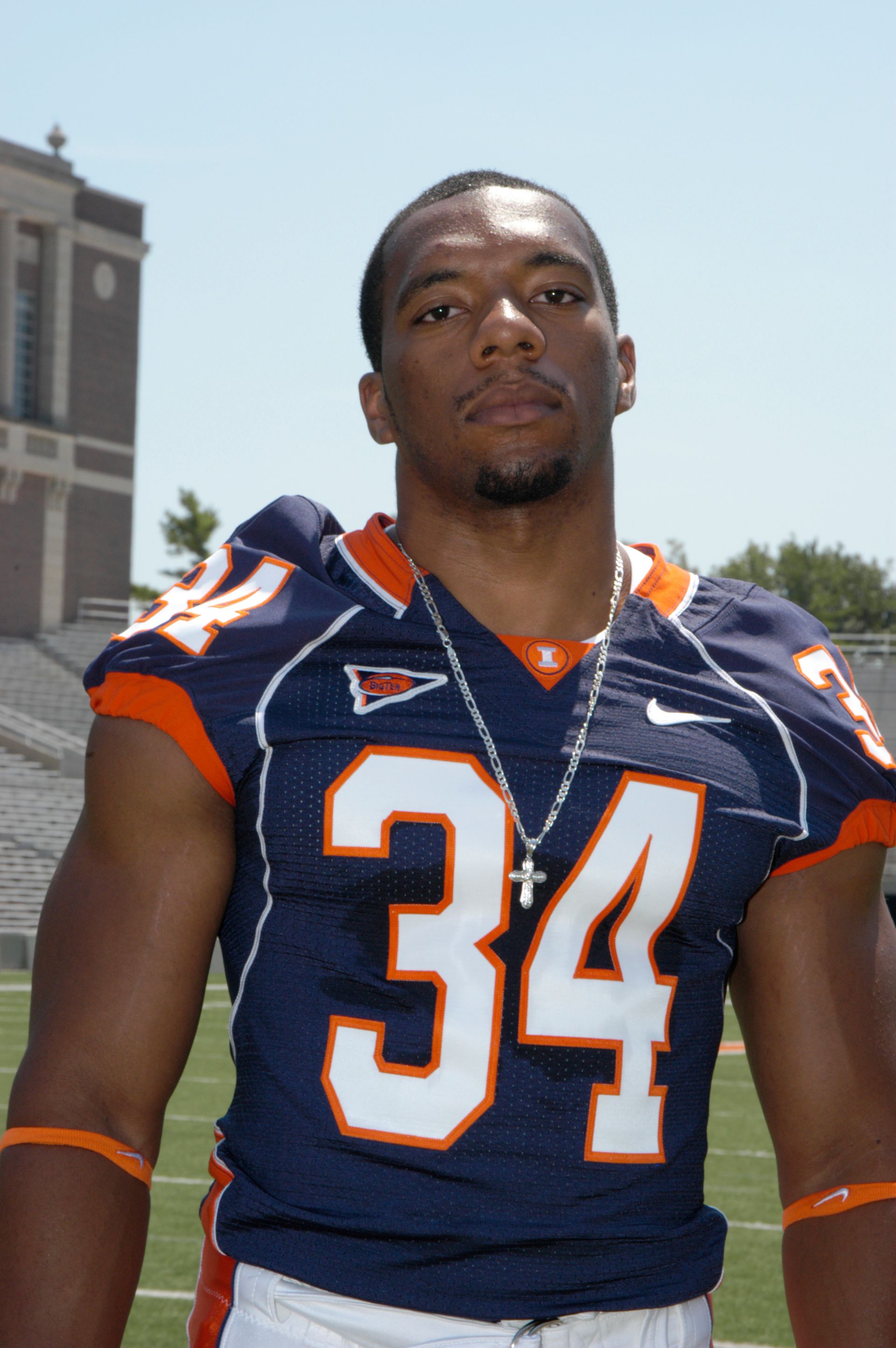
Walter Mendenhall
Jan. 22, 2024
During his two varsity-letter-winning seasons with the University of Illinois football team in 2005 and 2007, Walter Mendenhall didn’t establish any Illini rushing records. However, today, on his 38th birthday, no can say that his life hasn’t been a success story.
As the Executive Director of the not-for-profit Male Mogul Initiative, his Chicago-based program has changed the lives of hundreds of the Windy City’s young people.
Established in 2016, Mendenhall’s enterprise is a mentorship, leadership and entrepreneurial program that’s targeted at high school students of color. It allows participants to gain practical and applicable knowledge that can lead to success and productivity in a business, student organization or community. Mendenhall’s organization strives to build self-confidence, develop character, inspire academic excellence, and cultivate leadership skills.
“My passion is to motivate, educate and teach the youth of today how to be successful and how to discover their dreams,” Mendenhall said. “Very few people want to be on the front lines communicating and working with young people. Just knowing that there are lives and young minds that are waiting to be transformed and to be nurtured drives me. I realized that I had a gift for inspiring and motivating. The more you persevere, the more you work hard, the better you will become, and the more success you will gain.”
As a U of I junior in 2007, only receiving limited playing time, Mendenhall had sunk into a deep, dark depression.
"One night, I was laying in bed, contemplating taking my life because nothing was going right," he said. "I was like 'God, I need to know if you are really REAL right now because I don't know if I'm going to live to see tomorrow.' And, suddenly, I felt a presence and a calmness that I'd never felt before. That was when I realized that I was here for a bigger purpose and it was not necessarily to just play football.”
Mendenhall transferred from Illinois to Illinois State in 2008 in an effort to reach his athletic potential and accomplished his mission with the Redbirds, rushing for nearly 800 yards and 11 touchdowns.
Life challenged Walter Mendenhall IV from the beginning. His parents had divorced when he was a young child. His dad (Walter III) wasn't present in his life for a while and a variety of other obstacles were constantly jumping in Walt's path. With his mother (Sibyl) working as an accountant during the day and at a grocery store in the evening to make ends meet, nine-year-old Walt was often responsible for babysitting his younger brother (Rashard) and sister (Vanessa) in their tiny two-bedroom apartment in Skokie.
"I had a lot of responsibility at a very, very early age and had to grow up a lot faster than the average kid," he said. "I was mature at a very, very young age and saw the world a little bit differently than a lot of my peers."
When his mother left her accountant job to become a youth minister at a church on the far south side of Chicago, a decision was made that Walt and Rashard would spend the last two years of their Niles West High School career with their coach, Joe Galambos.
"Coach Joe helped us have an environment that was conducive for success," Mendenhall said. "He had two boys himself and showed us how a family unit is supposed to be. Coach Joe (an electrician by trade) also influenced my business mindset."
Energized by his mother's persistent message about education, Mendenhall began to build upon the sociology degree he had earned at the University of Illinois.
"The classes I took at Illinois exposed me to the way the world works in terms of capitalism, racism and classism," he said.
He completed his Master’s degree in 2013 and is now completing his Ph.D. in organizational leadership.
“My message for the youth of today is ‘Do not be the exception; change the rule’”, Mendenhall says.”
Younger brother Rashard, an Illini and NFL standout, credits Walt with “inspiring me with the leadership qualities he possesses.”
“Walt is the one who pushed me and showed me what drive was,” said Rashard.
With each individual he meets, Mendenhall quickly addresses three questions: Who are you? Why do you matter? What is your purpose?
"It's the foundation of everything I do," he explained. "When you don't know the answers to those three central questions, you're likely to make decisions that aren't conducive to your success."
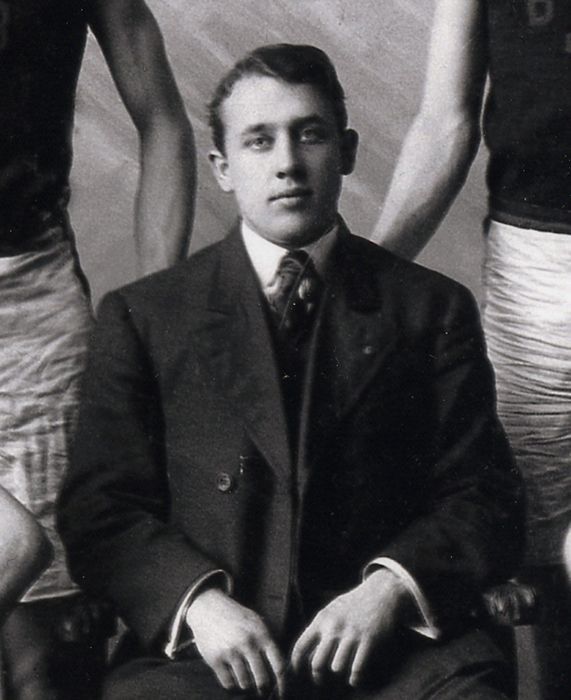
Elwood Brown
Jan. 19, 2024
Though records aren’t conclusive, Elwood Brown might well be the only coach in Big Ten Conference history to coach a league game on the very day he was hired.
One-hundred-eighteen years ago tomorrow - January 20, 1906 – athletics director George Huff appointed the 22-year-old Wheaton College coach and Chicago YMCA employee as the University of Illinois’s first men’s basketball coach. Brown had played for Wheaton but was unable to complete his degree due to financial constraints.
Of the Conference’s seven charter members, Illinois and Chicago were the last two Big Ten schools to add basketball as a varsity sport. Leo Hana, an assistant in the UI gymnasium, was appointed by Huff in December of 1905 to issue a call for candidates for the first team. More than a hundred men came out for the initial practice and that number was eventually reduced to fifteen, nine for the varsity squad and five for a second team. One of those fifteen choices, Roy Riley from Sutton, Nebraska, assisted Hana in drilling his teammates. Then on January 20th, The Illio wrote that “a professional basketball coach (Brown) was employed for the remainder of the season.”
In UI’s very first Big Ten game, Brown started Riley at center, Floyd Talmage and Kays (first name unknown) at the forwards, and Ed Ryan and Hugh Ray at the guards. Talmage scored 16 of Illinois’s 27 points in its three-point victory over visiting Indiana. The balance of the season didn’t fare as well for Brown and his Illini team, winning only four of their last 12 and finishing with a 6-8 record.
After the season, Brown returned to Chicago to take over as the YMCA’s Physical Education Director. He followed that with a similar stint in Salt Lake City (1907-09). Brown moved to the U.S. Philippine Islands in January of 1910 to direct Manila’s YMCA. There, he introduced basketball and volleyball, and soon after set up a sports program for Filipino government employees. Brown also is credited with designing a network of public playgrounds in Manila.
In 1911 Brown became Director of Athletics of the Manila Carnival, a festival that showcased American and Philippine culture and tourism. He then used the Carnival to promote sports in Asia. The event became recognized as the “Far East Olympics”, including teams from China and Japan.
Towards the end of World War I in 1918, American General John Pershing appointed Brown as Director-General of the Inter-Allied Games. Two years later, Brown represented the International Olympic Committee in South America and helped organize the South American Athletic Federation. He became a renowned speaker and addressed the IOC at three different events.
Brown also became the Philippines first Scoutmaster, organizing the Boy Scouts in that country in 1910.
Just three weeks short of his 41st birthday, Brown died of complications from a heart attack in March of 1924 in New Jersey. He’s buried at Little Wood Cemetery in Kane County.
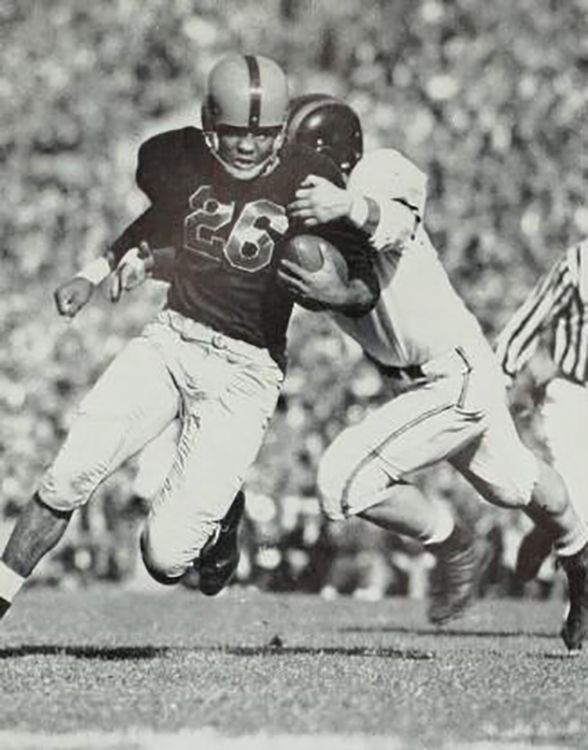
J.C. Caroline
Jan. 17, 2024
Today would have been former Fighting Illini football Hall of Famer J.C. Caroline’s 91st birthday. He died in 2017.
Forty-three years ago (1981), Caroline was inducted into the College Football Hall of Fame. He was joined in the induction class by such former football dignitaries as Ara Parseghian, Sam Huff, Merlin Olsen and Eddie LaBaron.
Other trivia about J.C. Caroline:
• As a sophomore in 1953, Caroline rushed for a Big Ten record 1,256 yards, shattering Red Grange’s Illini single-season record.
• Of the myriad of stars Ray Eliot coached during his 18 years at Illinois, he rated No. 26 at the very top of his list.
• Caroline averaged six yards every time he rushed the ball from scrimmage, totaling 1,696 yards on 287 attempts.
• J.C. dropped out of school before his senior season at the UI to sign with Montreal of the Canadian Football League.
• George Halas of the Chicago Bears signed Caroline as a defensive back in 1956.
• J.C. retired as a pro player in 1965 after 10 seasons, playing with three championship teams.
• Caroline served as assistant coach at Illinois from 1967-76, then coached briefly at Urbana High School.
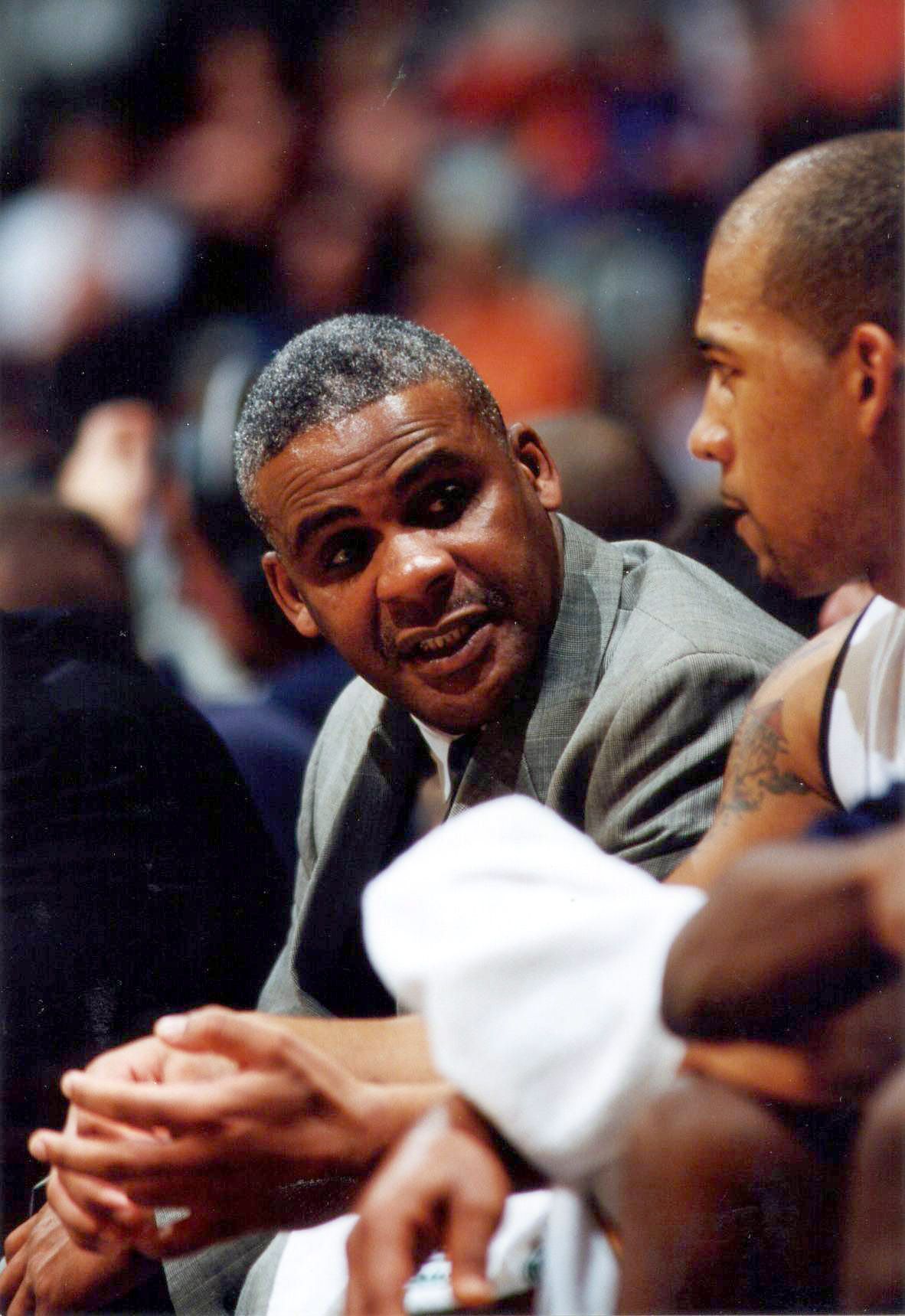
Wayne McClain
Jan. 15, 2024
Today would have been former Fighting Illini assistant basketball coach Wayne McClain’s 69th birthday. He joined Illinois’s staff following a seven-year career at Peoria’s Manual High School where he directed the Rams to Class AA state championships in 1995, ’96 and ’97.
Then Illini coach Bill Self initially hired McClain at Illinois in 2001. He stayed with the Illini when Bruce Weber succeeded Self for the 2003-04 season and continued as Weber’s assistant through the 2011-12 campaign.
During McClain’s 11 seasons on the bench, the Illini won 261 of their 378 games, a winning percentage of .690. He died in October of 2014.
The longest-serving Illini assistant basketball coaches:
31 Howie Braun, 1937-67
17 Dick Nagy, 1980-96
15 Jim Wright, 1958-72
13 Jimmy Collins, 1984-96
13 Wally Roettger, 1937-49
11 Wayne McClain, 2002-12
9 Tony Yates, 1975-83
9 Mark Coomes, 1986-94
9 Jay Price, 2004-12
7 Dick Campbell, 1968-74
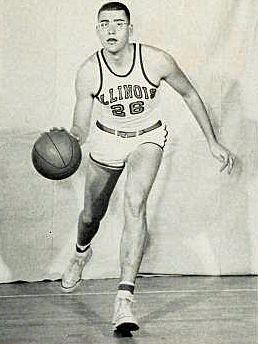
George BonSalle
Jan. 12, 2024
On this date in 1957, the Fighting Illini basketball team won at Wisconsin, 79-63, behind a game-high 21 points by senior center George Bon Salle. A product of Chicago’s Loyola Academy, Bon Salle was an outstanding pivot man for Coach Harry Combes, earning first-team All-Big Ten honors in 1956. Here is Bon Salle’s career story, by the numbers:
1 Illinois’ top scorer during the 1955-56 season, averaging 19.5 points per game
2 Bon Salle’s two children both played college sports: daughter Jackie played volleyball at Florida State and son Andrew played basketball at American University.
3 Number of NBA games he played (for the NBA’s Chicago Packers during the 1961-62 season).
7 Seventh overall pick in the first round of the 1957 NBA Draft (by the Syracuse Nationals).
17.3 Career scoring average for the Illini in 56 games.
22 His jersey number at Illinois.
36 Collegiate-high points he scored against Minnesota in 1956.
225 Pounds he carried on his 6-foot-8-inch frame.
970 Total points he scored at Illinois, good for 49th place all-time at UI.
1959 Year he played with the U.S. Pan American Games team, winning the gold medal.

Simeon Rice
Jan. 10, 2024
Twenty-nine years ago today - Jan. 10, 1995 - Fighting Illini football star Simeon Rice announced that he would return to play his senior year at Illinois.
Rice went on to have a sensational senior season in 1995, being a finalist for the Rotary Lombardi Award. He holds the single-season record for tackles for loss (23) and Illinois’ career mark with 44.5 quarterback sacks. He also recorded five tackles for loss in four different games.
Rice was drafted by the Arizona Cardinals in the 1996 National Football League draft, starting 15 of 16 games during his rookie season. Altogether, he played five seasons with the Cardinals, then moved on to Tampa Bay where he stayed for six seasons.
In his final season (2007), he played briefly for both the Denver Broncos and the Indianapolis Colts.
Rice played 251 career games in the NFL, notching 122 sacks and 25 forced fumbles.
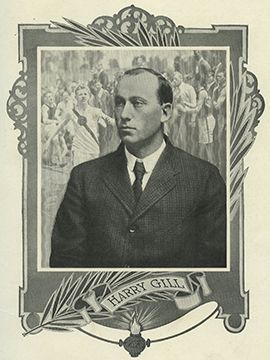
Harry Gill
Jan. 8, 2024
Born Jan. 9, 1876, in Coldwater, Ontario, Canada was Fighting Illini Track and Field Hall of Famer Harry Lovering Gill. During a 29-year coaching career from 1904-29, then again from 1931-33, his University of Illinois teams produced an amazing 22 Big Ten championships.
Today, the week of the 148th anniversary of his birth, we’ll tell Harry Gill’s story, by the numbers:
1 – From 1906 to 1915, Gill’s teams lost only one of 81 dual meets.
2 – His teams won NCAA championships in 1921 and 1927.
6 – Illini track and field squads swept all six indoor and outdoor Big Ten championship meets during the 1920, ’21 and ’22 seasons.
35 – Points scored by Gill’s Illini track athletes at the 1924 Olympic Games, more than any other nation.
79 -- Gill’s Illini teams won 79 percent of their Big Ten dual meets, compiling a record of 81 victories against only 22 losses and two ties. Including non-conference competition, the Illini had a success rate of 82 percent (111-24-2).
80 – He died on Aug. 31, 1956, at the age of 80 in Orilla, Ont. Gill had suffered a two years earlier.
1901 -- Became track and field coach at the University of Iowa, then served the following two seasons at Beloit College before joining George Huff’s Illini staff in 1904.
1903 – Won America’s professional all-around championship, clearing 6-feet-2-inches in the high jump, throwing 145 feet in the hammer, 45-8 in the shot, 30 feet in the 56-pound weight, and running 16.8 seconds in the high hurdles.
1907 – Gill’s 1907 Illini squad won its first of 22 Big Ten championships during his tenure.
1918 – He founded his own track and field equipment company 105 years ago. By 1955, Harry Gill Company manufactured 90 percent of the equipment used in the United States.
1932 -- Gill was invited to coach the Canadian Olympic Team in 1932 but declined the offer.
1977 -- When Drake University established its Relays Hall of Fame 46 years ago, Gill and fellow Illini coach Leo Johnson were among the six coaches included in his charter class.
2017 – He was one of 28 men and women selected in the charter class of the Illini Hall of Fame.

Stephen Steinhaus
Jan. 5, 2024
Though he lettered for the Fighting Illini as a walk-on in 1994, that worthy achievement is a long way from being Stephen Steinhaus’s pinnacle career milestone. The former Addison Trail Scholar-Athlete of the Year, who celebrates his 51st birthday today, has transformed his four-year experience at the University of Illinois into becoming one of the United Kingdom’s most unique educators. He currently serves as Principal at the Solihull Academy in Coventry, an institution that serves high school level students at risk.
A 6-3, 260-pound offensive lineman who wore jersey No. 61 for Coach Lou Tepper’s Illini, Steinhaus may not have matched the athletic talent of linemates Tim Simpson and Brad Hopkins, but his brilliance in the classroom was second to none.
“I walked on as an 18-year-old with a mullet and was practicing—and getting my backside handed to me—against future pros like John Holecek, Brad Hopkins, Kevin Hardy, and Dana Howard,” Steinhaus said. “A lot of people might have walked away, but I didn’t. On a daily basis, I got to see what hard work and professional preparation looked like.”
After graduating from the U of I with a Bachelor of Arts degree in English/Language Arts Teacher Education (1995), Steinhaus earned a Master of Philosophy degree (1996) from the UK’s University of Birmingham’s Shakespeare Institute, and a Master’s in English (1998) from the University of Hawaii at Manoa.
Steinhaus has subsidized his education through a wide variety of jobs. Among his experiences, he’s been a nightclub bouncer, a performer and artistic director for an eight-piece rhythm and blues musical group called The Doctor Teeth Big Band, trained to be a professional wrestler, worked as a college counselor, taught English, and served as a drama instructor.
Steinhaus’s career path to Solihull Academy has included positions at numerous UK institutions, including Stratford-Upon-Avon College, the Alcester Grammar School, Trinity Catholic School, the Ipsley Academy, and the Whitley Academy. He’s also led three international tours for 15-18 year olds with The Comedy of the Physical project, a combination of slapstick, improv, clowning, stage combat/wrestling, and live music.
Steinhaus, his wife (Lynsey) and two sons (Isaac and Saul) currently reside in Leamington Spa, England.
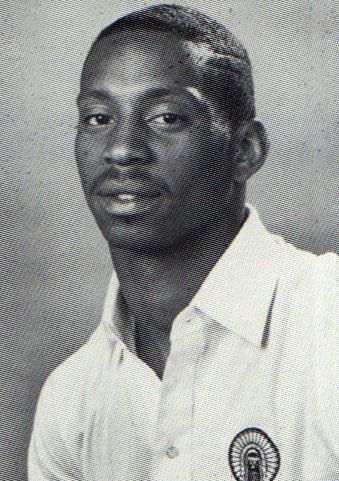
Darryl Usher
Jan. 3, 2024
Today would have been former Fighting Illini receiver Darryl Usher’s 59th birthday.
He died on Feb. 24, 1990 in a double homicide in Phoenix, Ariz. at the age of 26.
Recruited by Coach White to the University of Illinois in 1983 from San Mateo, Calif., the 5-8, 168-pound speed-burner starred in both football and as a sprinter on the track team.
Usher played sparingly on UI’s ’83 Big Ten champs, but his strong work ethic helped him attain second-team All-Big Ten honors as a senior in 1987. That season, he led the Illini in receiving (43 for 723 yards and four touchdowns), kickoff returns (15 for 445 yards, 29.7 yards per return) and punt returns (37 for 308 yards, 8.3 ypr). His production earned him Illini Most Valuable Player honors.
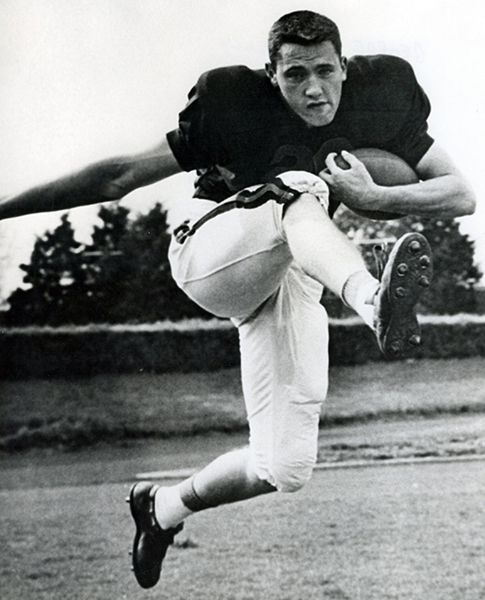
George Donnelly
Jan. 1, 2024
Sixty years ago today - Jan. 1, 1964 - Illinois defensive back George Donnelly picked off two interceptions as the Fighting Illini topped the Washington Huskies in the 1964 Rose Bowl, 17-7.
The 6-2, 191-pound defensive safety from DeKalb had three interceptions during Illinois’ 1963 championship season. In 1964 Donnelly won first-team All-America honors from the Football News, Time Magazine, The Sporting News and the New York Daily News. He also played in numerous all-star games, including the East-West Shrine Bowl, the Hula Bowl, the Senior Bowl and the College All-Star Game. Illini teammates Dick Butkus and Jim Grabowski also won All-America acclaim that season.
Donnelly had 13 career interceptions, including eight his senior year. He served in the Air Force prior to attending college. His sister was Illinois’ representative in the 1961 Miss Universe competition. Donnelly played three seasons (1965-67) for the NFL’s San Francisco 49ers, starting 18 of the 33 games in which he played. His son, Patrick Donnelly, and his nephew, Tyler Donnelly, also played for the Illini.
Donnelly in the 1965 NFL Draft:
1. Tucker Frederickson (Auburn), New York Giants
2. Ken Willard (North Carolina), San Francisco 49ers
3. Dick Butkus (Illinois), Chicago Bears
4. Gale Sayers (Kansas), Chicago Bears
5. Craig Morton (California), Dallas Cowboys
6. Steve DeLong (Tennessee), Chicago Bears
7. Donnie Anderson (Texas Tech), Green Bay Packers
8. Jack Snow (Notre Dame), Minnesota Vikings
9. Clancy Williams (Washington State), Los Angeles Rams
10. Lawrence Elkins (Baylor), Green Bay Packers
11. Tom Nowatzke (Indiana), Detroit Lions
12. Joe Namath (Alabama), St. Louis Cardinals
13. GEORGE DONNELLY (ILLINOIS), SAN FRANCISCO 49ERS
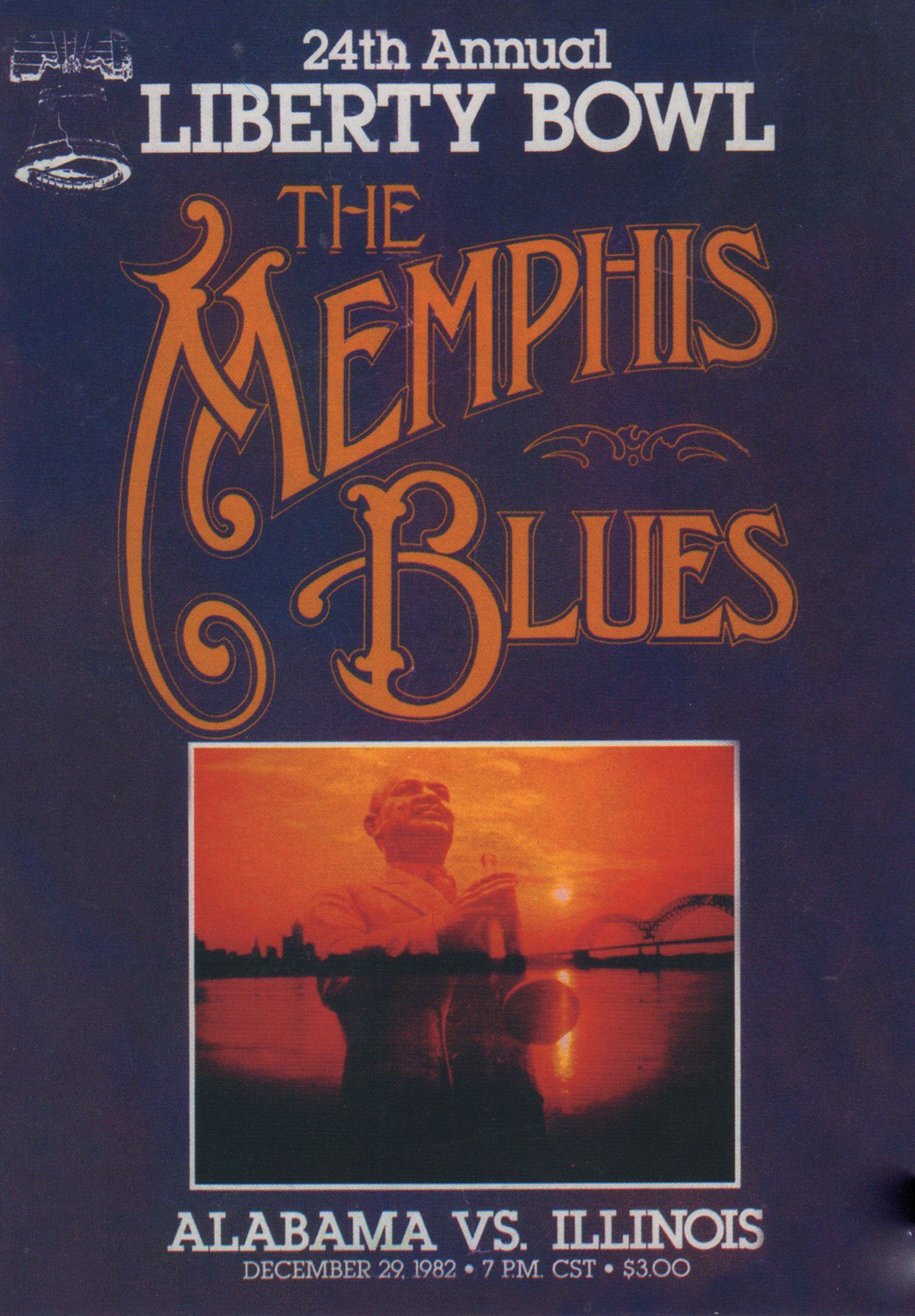
1982 Liberty Bowl
Dec. 29, 2023
The 1982 Fighting Illini football season will be remembered for many reasons.
The year began with a highly successful “Tailgreat” promotion and a big win over Northwestern in Memorial Stadium’s first-ever night game.
It was the season Tony Eason established an all-time record for passing proficiency.
And it was the year that Illinois went “Bowling” for the first time in 19 years.
Forty-one years ago today, Coach Mike White’s Fighting Illini were pitted against Alabama in the Liberty Bowl. It was a game that would turn out to be the final one for the Crimson Tide’s legendary Paul “Bear” Bryant. Bryant, who won more games than any other coach in college football, announced his retirement two weeks before, making the bowl game one of the season’s top attractions.
The night was clear and the 34-degree weather favored Alabama’s wishbone attack. Illinois trailed the Tide, 7-6, at the half, as Alabama defenders repeatedly pummeled Eason with a ferocious pass rush. On three occasions, crushing Alabama tackles forced Eason from the game.
Despite a record 423 yards passing by Eason, Illinois dropped a 21-15 decision, giving the Bear his 323rd and final collegiate victory.
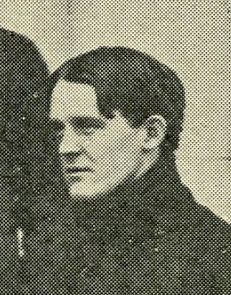
Fred Smith
Dec. 26, 2023
Christened with one of the world’s most common names, today’s University of Illinois football fans are excused for not recognizing the name of Frederick Smith. He was hand-picked by George Huff to become the Fighting Illini’s sixth head football coach, but only stayed in Champaign-Urbana for one season before becoming head football and baseball coach at Fordham.
Smith’s 1900 roster included several athletes who would become Illinois legends, including future Illini coach Arthur Hall, future UI Hall of Famers Jake Stahl and Carl Lundgren, and longtime assistant coach Justin Lindgren. Compiling a 7-3-2 overall record, Smith’s squad posted seven consecutive shutouts to begin the campaign. An eighth shutout followed a few weeks later when Illinois battled Indiana to a 0-0 tie in Indianapolis.
A native of New York City, Smith was an exceptional athlete at Princeton University. The 1897 Princeton graduate earned scattered All-America honors for his play as a quarterback for the football team and all-star accolades as a second baseman and catcher for the Tigers’ baseball squad. Major League Baseball’s Boston Red Caps (later known as the Braves) offered him a contract to play, but for unknown reasons he declined to sign.
Following his single year at Illinois, Smith was hired by Fordham University in his hometown to become the Rams head football and baseball coach. In his four seasons with the football team, Fordham had a cumulative record of 17-6-3, while in five seasons as the baseball coach the Rams had a mark of 213-66. One of his Fordham players, Ed Walsh, pitched for the Chicago White Sox for 15 seasons, twice leading the American League in strikeouts. Walsh was inducted into the Baseball Hall of Fame in 1946.
While he was coaching, Smith concurrently served as an engineer for New York City. He died in February of 1923, shortly after his 50th birthday, and is buried in Woodlawn Cemetery in the Bronx.

1988 Illinois-LSU Game
Dec. 22, 2023
Thirty-five years ago today—December 22, 1988—Illinois’ Flying Illini basketball team put on a Pete Maravich-type performance, scoring a school-record 127 points in a 27-point victory against the LSU Tigers at the Maravich Assembly Center.
Coach Lou Henson’s fifth-ranked club entered the game on a scoring rampage, having averaged 96.3 points per game over its first eight contests, including 100-plus point games vs. Duquesne, Arkansas-Little Rock and Tennessee Tech.
Running Henson’s motion offense, Illinois shot 73 percent from the field in the first 20 minutes, jumping off to a 61-51 lead at halftime. The Illini onslaught continued in the second half, hitting 13 of its first 16 points and reaching the 100-point mark (100-76) with 8:52 remaining. When Tigers freshman star Chris Jackson fouled out, Henson began to substitute liberally. In fact, no Illini player got more than 25 minutes of action.
Illinois starters scored at will, led by 27 from Kendall Gill, 24 from Lowell Hamilton and 21 from Stephen Bardo. Altogether, six Illini players tallied in double figures.
Wrote Bardo in his book “The Flying Illini”, “It wasn’t that LSU was bad, we were just starting to understand how good we really could be and it was one of those games when everything seemed to come together at the right time. Dale Brown, LSU’s head coach, thanked Coach Henson for not running the score up on them because we could have easily scored 150 that night.”
After the game, Brown told the media, “I think Illinois is the finest group of athletes I’ve ever seen in this gym. Lou has some wonderful thoroughbreds.”
The Illini would tally 100 points or more four additional times in 1988-89, including a 118-point gem on Senior Night at the Assembly Hall against 15th-ranked Iowa.

